This comprehensive annual report details the activities and achievements of the Ministry of Personnel, Public Grievances and Pensions for the fiscal year 2015-16. It covers a wide range of initiatives focused on improving governance, public service delivery, and employee welfare. Key highlights include advancements in e-governance, reforms in personnel policies, training programs for government functionaries, initiatives for promoting the use of Hindi in official work, and efforts to enhance transparency and accountability. The report also details the structure and functions of various departments within the Ministry, including the Department of Personnel and Training, the Department of Administrative Reforms and Public Grievances, and the Department of Pensions and Pensioners’ Welfare. It further elaborates on international cooperation efforts, crime investigation statistics by the CBI, the functioning of joint consultative machinery and administrative tribunals, and the ministry’s financial management and audit observations. The report underscores the Ministry’s commitment to citizen-centric governance and continuous improvement in public service delivery.
SOURCE PDF LINK :
Click to access AR2015_2016%28Eng%29.pdf
Click to view full document content
ANNUAL REPORT 2015-16
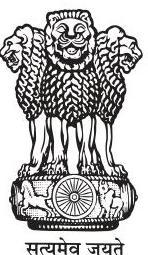
Ministry of Personnel, Public Grievances and Pensions
Government of India
.
| List of chapters | Page Nos. | |
|---|---|---|
| Vision and Mission | ||
| Executive Summary | ||
| DEPARTMENT OF PERSONNEL AND TRAINING | ||
| 1 | Overview | 1 |
| 2 | Major initiatives during the year | 7 |
| 3 | Personnel Policies | 17 |
| 4 | Reservation in the Central Government services | 37 |
| 5 | Cadre Management | 44 |
| a) Indian Administrative Service (IAS) | 44 | |
| b) Central Secretariat Service (CSS) | 50 | |
| c) Central Secretariat Stenographer Service (CSSS) | 54 | |
| d) State Reorganization | 56 | |
| 6 | Senior Appointments under Government of India | 59 |
| 7 | Training Policy and Programmes | 65 |
| 8 | Training Institutions | 75 |
| 9 | Administrative Vigilance Division | 98 |
| 10 | International Cooperation | 107 |
| 11 | Central Bureau of Investigation | 110 |
| 12 | Joint Consultative Machinery | 124 |
| 13 | Administrative Tribunals | 125 |
| 14 | Staff Welfare | 129 |
| 15 | Right to Information | 137 |
| 16 | Grievance Redressal Mechanism & Citizens’ Charter | 142 |
| 17 | Progressive Use of Hindi in Official Works | 144 |
| 18 | Financial Management | 147 |
| 19 | DEPARTMENT OF ADMINISTRATIVE REFORMS AND PUBLIC GRIEVANCES | 156 |
| 20 | Administrative Reforms | 167 |
| 21 | Public Grievances | 173 |
| 22 | Organisation and Methods Division | 181 |
| 23 | E-Governance | 183 |
| 24 | International Exchange \& Cooperation (IE\&C) | 190 |
| 25 | Documentation and Dissemination Division (D&D) | 197 |
|---|---|---|
| 26 | Hindi Section | 203 |
| 27 | DEPARTMENT OF PENSIONS AND PENSIONSERS’ WELFARE | 204 |
| ANNEXURES | 215 | |
| 28 | Department of Personnel and Training Annexure I – Incumbency Position of Under Secretary level Officers and above in DoPT |
216 |
| 29 | Department of Administrative Reforms and Public Grievances (DARPG) | 220 |
| Annexure II – Organisational Chart of DARPG | 220 | |
| Annexure III – Incumbency position of Under Secretary level officers and above in DARPG | 221 | |
| Annexure IV – Prevention of Sexual Harassment of Women at Workplace | 222 | |
| Annexure V – Welfare of SC, ST, OBC and Person with Disability(PWD) | 223 | |
| Annexure VI – Newspaper clippings of various events of DARPG | 224 | |
| Annexure VII – Newspaper clippings of various events of DARPG | 225 | |
| Annexure VIII – Newspaper clippings of various events of DARPG | 226 | |
| 30 | Department of Pensions and Pensioners’ Welfare | 227 |
| Annexure IX – Organisation Chart | 227 | |
| Annexure X – Incumbency Position of Group ‘A’ officers in D/o PPW | 228 |
Ministry of Personnel, Public Grievances and Pensions Department of Personnel & Training
Vision
To create an enabling environment for the development and management of Human Resources of the Government for efficient, effective, accountable, responsive and transparent and ethical governance.
Mission
Development and management of government personnel by attracting the best talent, providing excellent career advancement opportunities, encouraging competence and innovation, adopting a dynamic framework of personnel policies and procedures, ensuring capacity building at all levels, inculcating and supporting a culture of transparency, accountability and zero tolerance of corruption in public affairs, and institutionalizing a system of continuous and constructive engagement with stake-holders to make the public services in India more efficient, effective, accountable and responsive.
.
EXECUTIVE SUMMARY
The Ministry of Personnel, Public Grievances and Pensions is the nodal Ministry responsible for personnel matters, especially in respect of issues concerning recruitment, training, career development, staff welfare and the post retirement dispensation. The Ministry also works towards promotion of responsive, people-oriented and modern administration.
The Ministry comprises three Departments:
(i) Department of Personnel and Training (DoP&T)
(ii) Department of Administrative Reforms and Public Grievances (DARPG)
(iii) Department of Pensions and Pensioners’ Welfare (DPPW)
DEPARTMENT OF PERSONNEL \& TRAINING
Various wings of DoP\&T are as under:
- Establishment Officer’s (EO) Wing
- Services \& Vigilance (S\&V) Wing
- Establishment (Estt.) Wing
- Training (Trg.) Wing
- Administration Wing
The Establishment Officer’s Wing deals with the matter relating to senior appointments under the Government of India requiring approval of the ACC.
The Services \& Vigilance Wing handles matters relating to Cadre Management of All India Services and acts as the nodal agency in the arena of vigilance and anti-corruption. This wing in addition to governing the implementation of RTI Act, also handles the administrative matters relating to the Administrative Tribunals, Central Information Commission and Welfare Activities for benefit of the employees of the Government.
The Establishment Wing is responsible for framing the revising rules and regulations regarding service conditions of the employees and personnel policies of the Central Government employees other than All India Service Officers. This wing also handles the work related to Cadre Restructuring in respect of the other Central Services.
The Training Wing acts as the nodal agency for training of Government functionaries and is primarily responsible for formulating policies with regard to training.
Administration Wing deals with the matters related to Cadre Management of the Central Secretariat Service, Central Secretariat Stenographers Service and the Central Secretariat Clerical Service. This wing, also handles the administrative matters relating to the State Reogranization and Reservation Policy of the Government.
The Department of Personnel & Training also handles the administrative work relating to the following Institutions: –
- Union Public Service Commission
- Central Vigilance Commission
- Lokpal
- Central Administrative Tribunals
- Central Information Commission
- Central Bureau of Investigation
- Staff Selection Commission
- Public Enterprises Selection Board
- Lal Bahadur Shastri National Academy of Administration
- Institute of Secretariat Training \& Management
DEPARTMENT OF ADMINISTRATIVE REFORMS \& PUBLIC GRIEVANCES
The Department of Administrative Reforms and Public Grievances is the nodal agency of the Government of India for administrative reforms as well as redressal of public grievances relating to the States in general and those pertaining to the Central Government agencies in particular. The Department endeavours to document and disseminate successful governance practices by way of audio-visual media and publications. The Department also undertakes activities in the field of international exchange and cooperation to promote public service reforms. There are 7 Divisions in the Department namely Administrative Reforms, Organization \& Methods, E-Governance, Documentation \& Dissemination, International Cooperation, Administration \& Coordination and Public Grievances.
DEPARTMENT OF PENSIONS AND PENSIONERS’ WELFARE
The Department of Pension \& Pensioners’ Welfare was set up in 1985 as part of the Ministry of Personnel, Public Grievances and Pensions to formulate policy and coordination of matters relating to retirement benefits of Central Government employees (Civil, Defence and Railway Pensioners).
Chapter
OVERVIEW
1.0 The Ministry of Personnel, Public Grievances and Pensions acts as the formulator of policies pertaining to recruitment, regulation of service conditions, and deputation of personnel besides advising all organizations of the Central Government on issues pertaining to personnel management. The Organizational chart of the Department is at next page.
Major Initiatives/Achievements (Chapter 2)
Major Initiatives/Achievements during the period April 2015 – March, 2016 have been brought out in Chapter 2.
Personnel Policies (Chapter 3)
1.2 The Department is responsible for framing rules and regulations governing service conditions including recruitment rules, promotions and seniority, Flexible Complementing Scheme, Leave Travel Concession, deputation and Child Care Leave of employees. Personnel are recruited for the Central Government by the Union Public Service Commission through competitive examinations conducted by them for appointments to higher civil services and through the Staff Selection Commission of non-gazetted staff in Group ‘B’ & ‘C’ categories.
Reservation (Chapter 4)
1.3 In order to achieve the objective of upliftment and welfare of the Scheduled Castes and Scheduled Tribes, Other Backward Classes
and Persons with Disabilities; the Department frames policies to provide reservation to these groups in various Central Government services and for monitoring its implementation.
Cadre Management (Chapter 5)
1.4 This Department is responsible for management of the cadres of All India Services (AIS) (IAS, IPS and IFS) and all three Secretariat Services namely Central Secretariat Services (CSS), Central Secretariat Stenographers’ Services (CSSS) and Central Secretariat Clerical Services (CSCS). In addition, this Department frames and also revises Rules and Regulations regarding conditions of the All India Services, such as Indian Police Service (IPS) and Indian Forest Service (IFS), in consultation with the Ministry of Home Affairs and Ministry of Environment, Forest and Climate Change respectively. This Department is also responsible for cadre review of 59 Central Group ‘A’ Services on a periodic basis.
Senior Appointments under the Government of India (Chapter 6)
1.5 The Department deals with appointments at senior level and personnel policies of the Government of India. All proposals for senior appointments under the Government of India, which require the approval of the Appointments Committee of the Cabinet (ACC), are processed by the Department. These include board level appointments to Central Public Sector
Undertakings and appointments under the Central Staffing Scheme for posts of Joint Secretaries, Directors and Deputy Secretaries in Ministries
/Departments. In addition, all appointments by promotion, which require the approval of the ACC, are also processed by the Department.
Organisation Chart for Department of Personnel & Training
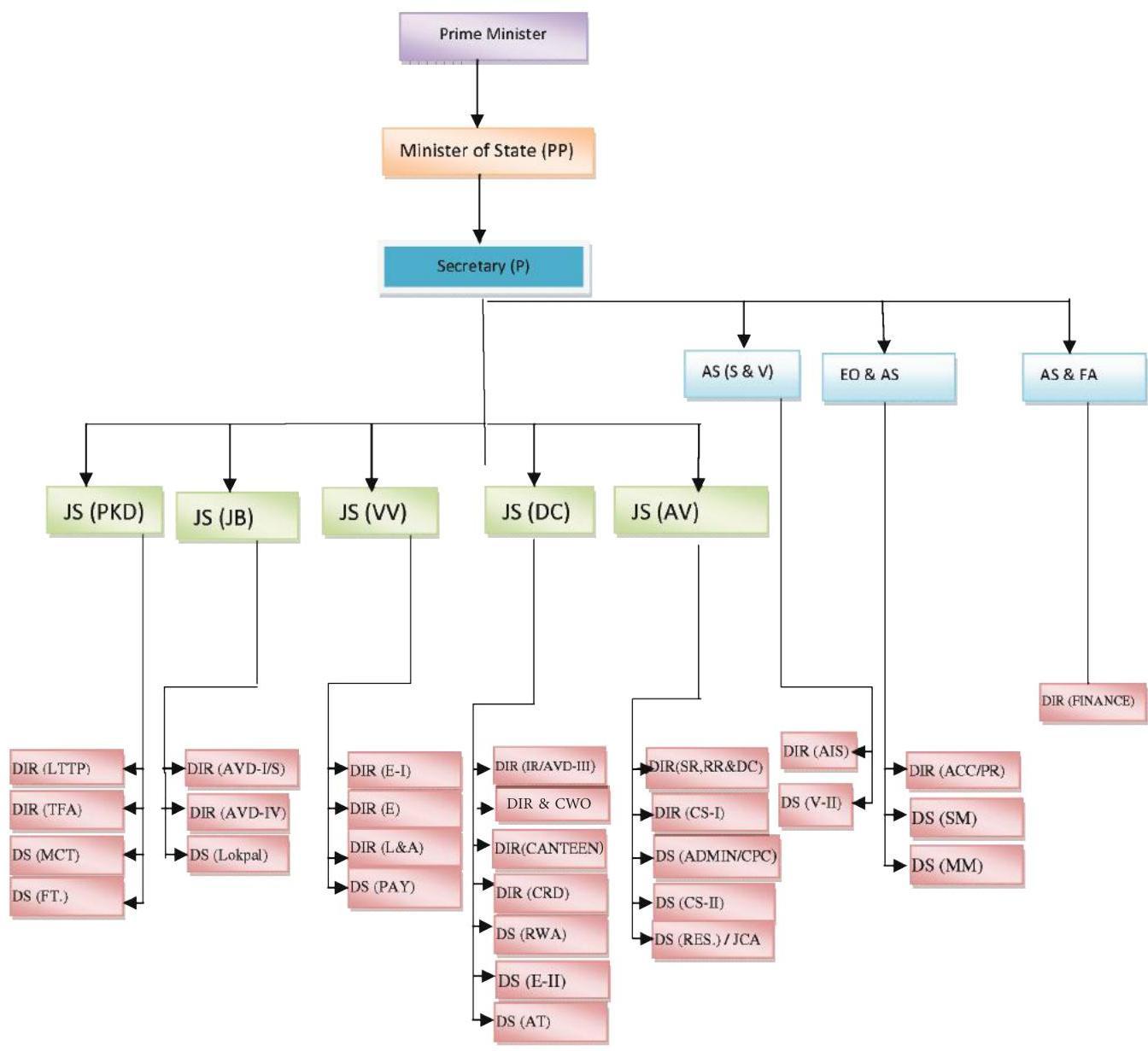
| Abbreviations Used in the Organization Chart | |
|---|---|
| ACC | Appointments Committee of Cabinet |
| AVD | Administrative Vigilance Division |
| ADMIN | Administration |
| AIS | All India Services |
| AS | Additional Secretary |
| CS | Central Secretariat |
| CPC | Central Pay Commission |
| CRD | Cadre Review Division |
| CWO | Chief Welfare Officer |
| DFFT | Domestic Funding of Foreign Training |
| DS | Deputy Secretary |
| DIR | Director |
| E | Establishment |
| EO | Establishment Officer |
| IR | Information Rights |
| JS | Joint Secretary |
| JCA | Joint Consultative Machinery and Arbitration |
| LTTP | Long Term Training Programme |
| L&A | Leave Allowances |
| MOS | Minister of State |
| MM | Middle Management |
| PR | Personal Records |
| PIIA | Pathways for an Inclusive India Administration |
| PESB | Public Enterprises Selection Board |
| PP | Personnel \& Pension |
| RES | Reservation |
| RR\&DC | Redeployments \& Retraining \& Departmental Council |
| S\&V | Services \& Vigilance |
| S | Services |
| SM | Senior Management |
| SR | State Reorganization |
| TRG | Training |
| V | Vigilance |
| TFA | Training for All |
| FT | Foreign Training |
| MCT | Mid Career Training |
Training Policy and Programmes (Chapter 7)
1.6 The Department is the nodal Department to impart training to the government functionaries. The Training Wing of the Department formulates policies and implements its training programmes by identifying areas of training, designing training programmes, development of trainers and training capabilities and administering policies in training. Major training activities undertaken during the year are (i) In-service training of IAS officers (ii) Mid-Career Training of IAS Officers (iii) Domestic Funding of Foreign Training (iv) Post Graduate Programmes in Public Policy (v) Training Support, (vi) Intensive Training Programme, (vii) Augmentation of the Capacity of training institutions (viii) Capacity Building for poverty reduction (ix) Distance and e-learning initiatives and (x) e-governance initiatives.
Training Institutions (Chapter 8)
1.7 Lal Bahadur Shastri National Academy of Administration (LBSNAA), Mussourie, Uttarakhand and Institute of Secretariat Training and Management (ISTM), Delhi are two premier training institutions, attached to this Department. These institutes cater to the needs of human resource development by imparting training to all officers of Central Government at frequent intervals for their career progression. The Department also supports the Indian Institute of Public Administration (IIPA) which is an autonomous organisation, in undertaking advance training programmes for administrators as well as researchers on issues relating to public administration.
Administrative Vigilance Division (Chapter 9)
1.8 The Department is the nodal agency responsible for formulation and implementation of vigilance and anti-corruption policies of the Government. Administrative Vigilance Wing in the Department oversees government programme for maintenance of discipline and eradication of corruption from public service. The Central Vigilance Commission (CVC) advises the Central Government on all vigilance matters. The jurisdiction of the Commission extends to all the organisations to which the executive powers of the Union of India extend.
International Cooperation (Chapter 10)
1.9 The Department of Personnel and Training is the nodal Department for anti corruption. To deal with international cooperation on these aspects an International Cooperation Cell was created in this Department. The primary tasks of this Cell emanate from the follow up to the ratification of the United Nations Convention Against Corruption (UNCAC) and the other consequential international collaborative efforts, on global platforms. This Cell acts in conjunction with specialized agencies like the Central Bureau of Investigation, the Enforcement Directorate and the other line Ministries entrusted with the specific ancillary tasks within their respective administrative domain, viz. corporate governance, extradition matters, prevention of money laundering, mutual legal assistance treaties etc.
Central Bureau of Investigation (Chapter 11)
1.10 Central Bureau of Investigation (CBI) was set up by the Government of India by a Resolution dated April 1, 1963 to not only investigate cases of bribery and corruption, but
also violation of central fiscal laws, major frauds relating to Government of India Departments, Public Joint Stock Companies, passport frauds and serious crimes committed by organized gangs and professional criminals. CBI was further strengthened by the addition of Economic Offences Wing by the Government of India by Resolution dated February 2, 1964.
Joint Consultative Machinery (Chapter 12)
1.11 The Government provides for a Joint Consultative Machinery for joint consultation at three levels between the Central Government and its employees for promoting harmonious relations and securing optimum level of cooperation between the Central Government and its employees in matters of common concern. The objective is to increase the efficiency of public services along with the well-being of the employees. The three tiers are:
a) National Council – at the apex level, functioning under the Department of Personnel and Training.
b) Department Councils – functioning at the level of the Ministries / Departments.
c) Office Councils – functioning at offices/ organisations under various Ministries / Departments.
1.12 The Scheme has proved to be an effective forum for amicable settlement of grievances of the Central Government employees relating to their service matters etc.
Administrative Tribunal (Chapter 13)
1.13 In order to provide speedy and inexpensive justice delivery system to the employees who feel aggrieved by Government decisions, the Government set up the Central Administrative
Tribunal (CAT) in 1985, which now deals with all cases relating to service matters. The CAT has 17 regular benches, 15 of which operate at the Principal seats of High Courts and the remaining two are at Jaipur and Lucknow.
Staff Welfare (Chapter 14)
1.14 The Central Government being the largest single employer in the country discharges its responsibility for looking after the welfare of employees through various welfare measures. The Department also extends support to various staff welfare measures. The DoPT is the nodal Department for four registered societies set up for the welfare of the Government employees and their families. In addition, the Department lays down policies for Departmental Canteens and supports the Resident Welfare Associations.
Right to Information (Chapter 15)
1.15 The Department has brought out a comprehensive law in order to ensure right to information to the citizens of India in almost entire matters of governance at all levels from Central Government to the local self-government. The Law (RTI Act, 2005) has provided a mechanism where the Central Information Commission, being the apex body at the Centre, facilitates its citizenry in accessing information in a time bound, hassle free and affordable manner.
Grievance Redressal Mechanism & Citizens’ Charter (Chapter 16)
1.16 DOP\&T has identified some of the core services being offered by its various divisions and their standards for the purpose in its first charter. This has been undertaken by a Task Force in consultation with the Stakeholders. While identifying the services the focus has been on measurable and verifiable services and their
standards. The charter contains Grievance Redress Mechanism related to the services mentioned in the Citizens’/Clients’ Charter. The Charter also provides links for other grievances which are not related to the Citizens’/Clients’ Charter. Time lines have been prescribed for final disposal of the complaint arising out of the Citizens’/Client’s Charter.
Progressive Use of Hindi (Chapter 17)
1.17 The Department is fully committed to promote the use of Hindi as the official language, in official matters and motivate compliance of the provisions of the Official Language Act, 1963, the rules framed there under. The Department also ensures that the spirit of various orders and guidelines issued by the Department of Official Language are appropriately enforced for implementation of the official language policy of the Union. The Department has an Official Language Division which monitors the implementation of the policy in the Department.
Financial Management (Chapter 18)
1.18 In order to promote the various programmes administered by Ministry of Personnel, Public Grievances and Pensions, an annual allocation of Rs. 229.34 crores was made in the annual plan outlay for the year 2015-16 (RE 2015-16) and Rs. 905.25 crores under non-plan allocation for the year 2015-16 (RE 2015-16). The corresponding figures for 2016-17 are Rs. 250.00 crore as Annual Plan Outlay and Rs. 1200.00 crore under nonplan allocation. The requirements and priorities of its attached and subordinate offices were kept in view while making budgetary allocations to them by this Department. No PAC para is pending in respect of this Department. However, two C&AG Paras pertaining to UPSC and ISTM are pending in this Ministry. The Final ATN in both the cases has already been forwarded to Monitoring Cell, O/o the Controller General of Accounts, Department of Expenditure, M/o Finance and the same has also been uploaded in APMS Portal.
Chapter
Major Initiatives/Achievements during the year
Discontinuation of Interview from January 1, 2016 in Central Government for Group ‘B’ & Group ‘C’ posts.
2.1 After the announcement by the Hon’ble Prime Minister on Independence Day, the Committee of Secretaries (CoS) in the meeting held on 14.09.2015 decided to dispense with the Interviews for all Group ‘B’ (non-gazetted) and also for Group ‘C’ posts (which includes Group ‘D’ posts) at the Junior Level posts in Govt. of India subject to amendment in Recruitment Rules, wherever applicable. Necessary instructions in this regard were issued to SSC vide Letter No -39020/01/2013-Estt (B) dated $5^{\text {th }}$ October, 2015. The Central Ministries/ Departments were also informed vide O.M. dated $9^{\text {th }}$ October, 2015 and $29^{\text {th }}$ December, 2015. The discontinuation of interviews will not only be in larger public interest but would also offer a level playing field for even those of the candidates who lack resources and come from lower socio-economic strata.
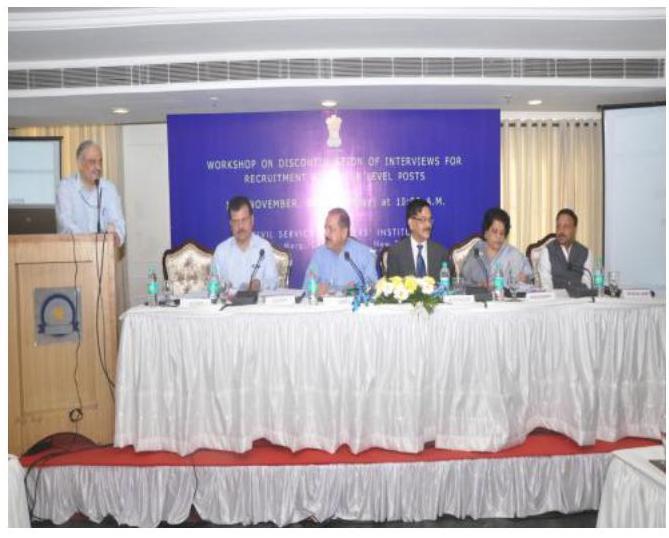
Single page form launched on December 25, 2015 to make it simpler for common man.
2.2 The Department of Personnel \& Training (DoPT), in collaboration with National Centre for Good Governance (NCGG) has launched the initiative of simplification of forms for convenience of citizens and providing trust based efficient public service delivery. Hon’ble Minister of State (Personnel), Dr. Jitendra Singh announced the furthering of the initiative on the Good Governance Day, i.e. $25^{\text {th }}$ December, 2015.
2.3 The overall aim of this initiative is to make the forms as simple and small (a single A4 size page) as possible for the beneficiary and contents of the forms should be easy to understand and complete. The certificates and documents to be attached with the forms should be easy for the beneficiary to obtain.
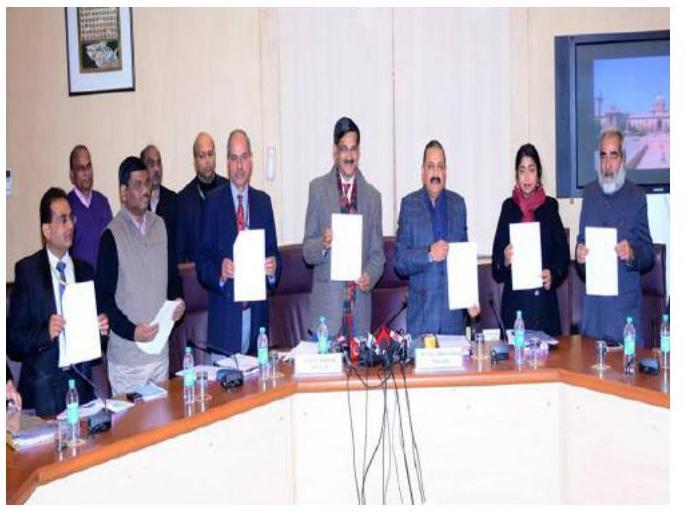
Abolition of affidavit & verification by Gazetted officer is replaced by self attestation.
2.4 To reduce time and efforts on the part of citizens as well as the officials in Government officers, Self-Certification is being encouraged instead of Affidavits. Orders have been issued to 53 Government of India Ministries/Departments and 27 State Governments/UTs in this regard.
Thrust on filling up 15,000 vacancies in Central Government to mainstream ‘Divyaang’.
2.5 In accordance with the commitment given to the Hon’ble Supreme Court, Govt. has instructed concerned Departments/Ministries to fill up the vacancies for persons with disabilities. During April, 2015 to December, 2015, eight meetings with concerned Departments/ Ministries, either at Addl. Secretary or Secretary (P) level, have been held to monitor filling up of such vacancies. More than 15,000 vacancies have been identified for Persons with Disabilities. Out of these, 9,836 vacancies have already been filled up and remaining vacancies being filled up very shortly. Appointment of approximately 15,000 Divyaang employees in Central Govt. Departments, Ministries, banks etc. will help them in joining the mainstream.
Exemption from mandatory transfer of officers having ‘Divyaang’ children.
2.6 DoPT has exempted the parents of differently abled children from the mandatory transfers so that they can take proper care of their differently abled child. Raising disability children with special needs is a daunting and very stressful task. This move will ease the pain of these parents and ensure care and upbringing of these children.
Visit of officers to Schools for nation building
2.7 Consequent to the observations of Hon’ble Prime Minister on the Teachers’ Day (05.09.2014) that the doctors, engineers and officials/civil servants may volunteer to teach and interact with students in a school to share their learning/experience, Department of Personnel and Training has prepared a Concept Paper on the subject. As per this paper, officers would be encouraged to volunteer to visit schools and share their perspective with the students. Special emphasis is to be laid on officers who have done a foreign posting/training/exposure.
2.8 To begin with, senior officers of DoPT have visited the Kendriya Vidyalayas in Delhi during the period between August and October, 2015. The IAS Officers of 2013 batch, who have been attached to various Ministries/Departments as Assistant Secretaries have also been encouraged to visit the schools and share their experiences.
2.9 The officers were unanimous in their opinion that the interaction has been very useful and helped in providing motivation and encouragement to the students. It has been recommended that officers of the Govt. of India need to replicate this exercise in various schools especially run by the Govt.
2.10 Coordination with the Department of School Education and Literacy (Ministry of Human Resource Development) is on to take this scheme to the next level of expanding it to officers of Govt. of India all over the country. The interaction of Senior Officers with School Students will have a long lasting impact on their impressionable minds. They will also get a glimpse of the functioning of the Government.
Yoga & adventure sports introduced for wellbeing of employees and improving performance.
2.11 The Department of Personnel and Training launched a Yoga training scheme w.e.f. 01.04.2015 in association with Morarji Desai National Institute of Yoga, New Delhi and has started Yoga camps for the benefit of Central Govt. employees and their dependents at various locations. The employees would be able to de-stress themselves and also take control over various lifestyle diseases like obesity, hypertension, Hyperglycemias etc. The healthy \& happy employee would be able to perform more effectively in their office work.
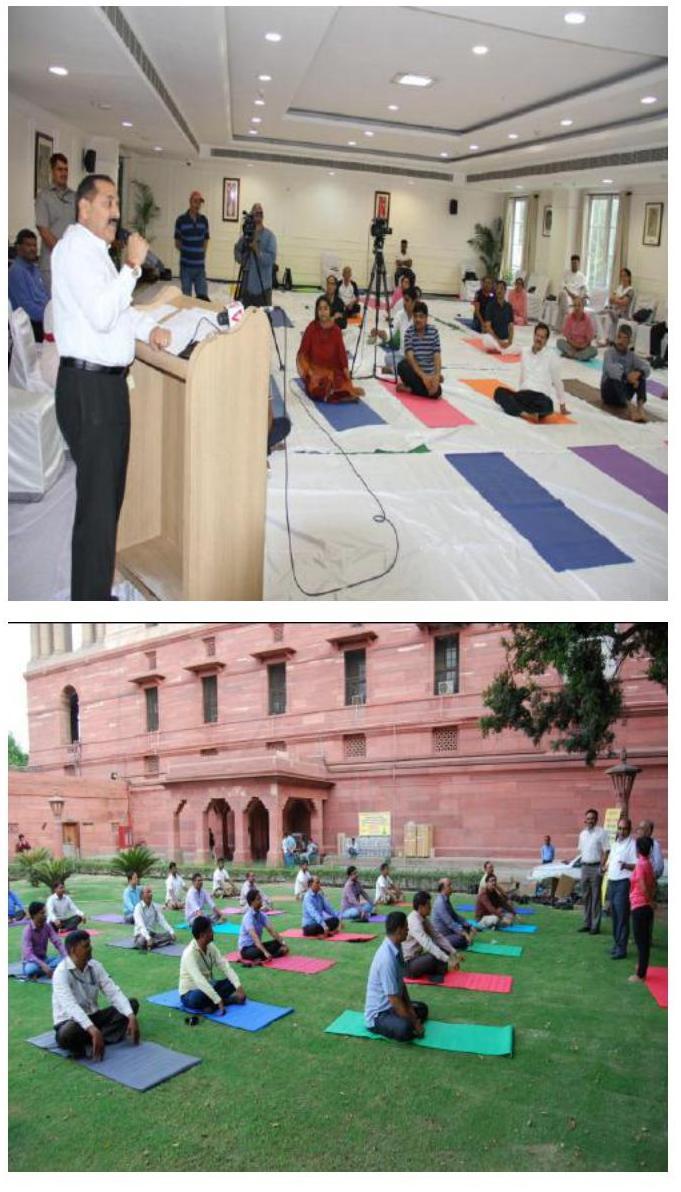
2.12 As a welfare measure, the Department of Personnel and Training has launched a Scheme for promotion of adventure sports and similar activities amongst Central Govt. Employees working in the Ministries/Departments. The 5-7 days’ programme has components of environmental awareness, disaster management, team spirit, capacity building and Swachchh Bharat Campaign. Trekking, Mountaineering, Rock-Climbing, Cycling in a difficult terrain, Skiing, Rafting, Para Sailing, Jungle Safari and Environmental Awareness Camps, etc. are the approved activities which will be conducted by six institutes run/controlled by Central/State Governments. The Department is providing financial assistance of Rs. 20,000/- (maximum) to the eligible Central Govt. Employees. There is also provision of Special Casual Leave for the programme.It is expected that participation by Central Govt. Employees in adventure sports and similar activities will give them a platform where they would learn lessons from nature and use the knowledge acquired for welfare of the society. It would also foster spirit of risk-taking, cooperative team work, capacity of readiness, vital response to challenging situations, endurance and environmental awareness.
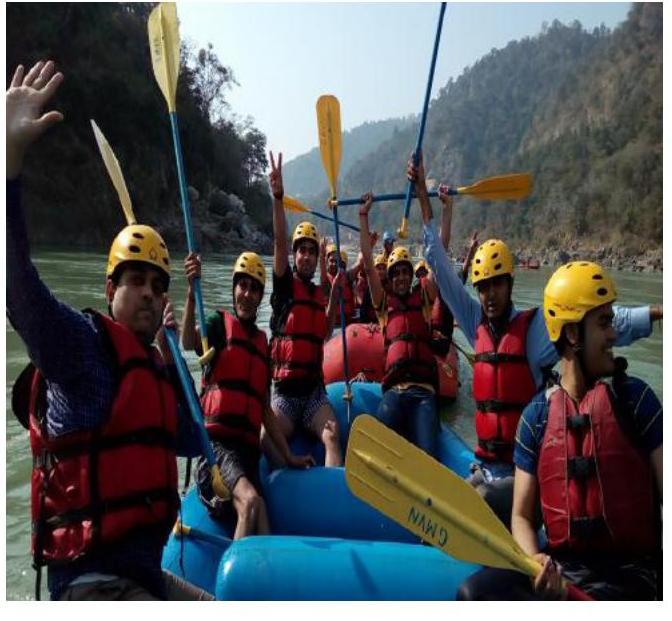
Induction Training at cutting edge level at Centre and States
2.13 The Department of Personnel and Training started an innovative scheme for the training of the cutting edge level employees of the State Governments. In the first phase, master trainers are being trained by the ATIs in collaboration with DoPT. These trainers will impart training to the field level employees. Emphasis of the training will be on citizen centricity. Pilots had been started in Maharashtra, J&K and Tamil Nadu. It has now been extended in other States. The field level employees are face of the Government. The citizens interact with these employees on regular basis. Training will bring an attitudinal change in these employees which in turn will result in increased citizen friendly environment in the field offices.
Visit of Secretaries to their first place of Posting
2.14 Hon’ble Prime Minister in his meeting with the Secretaries to the Government of India on 01.11.2014 desired that the Secretaries should visit their first place of posting and suggest changes in policies or otherwise, if required, for implementation of ongoing programmes.
2.15 Most of the Secretaries visited their first place of posting and submitted reports containing observations, comments and suggestions regarding implementation of various schemes of the Central Government. Almost all Secretaries have appreciated this initiative. Most of the Secretaries have expressed satisfaction over substantial growth in road network and its quality, availability and increase of drinking water and piped water supply, efforts of the government to increase irrigation facilities, increase in cropping area and experimentation in agriculture. Positive change in rural lifestyles
brought about by Mahatma Gandhi National Rural Employment Guarantee Act (MGNREGA) Scheme, growth of urban areas and the economic prosperity it has brought about and increase in toilet usage in both rural and urban areas are some other positive developments highlighted by them. Most Secretaries have however expressed that though a lot has been achieved, much is still desired. The major problem areas pointed out by the Secretaries in their reports are, to name a few, unemployment amongst youth, poor connectivity, inadequate health infrastructure including lack of specialists in district hospitals, poor sanitation (drainage) conditions, lack of industrialization and gaps in public service delivery at cutting edge level. Some of them have also highlighted several issues peculiar to the particular areas visited by them and have brought out certain long-pending issues that need resolution at an inter-ministerial level. Reports of Secretaries after visit to their first place of posting were examined by various working groups and recommendations regarding schemes, both short term and long term, have been made as desired by the Committee of Secretaries (CoS).
2.1662 Secretaries have submitted their reports regarding their visit to their first place of posting. The reports from the working groups have been received and the same has been compiled and is presently under consideration of the Government. It has also been decided that as and when somebody gets appointed as Secretary, he/she too will undertake the visit and submit his/her report. As and when reports of the Secretaries will be received, they will be sent to the concerned working groups for deliberation. The working groups can keep meeting as per their need. The observations/comments of Secretaries in their visit reports are likely to have a positive impact on the efficiency of administration in the country.
Posting of IAS Officers as Assistant Secretary in Govt. of India:
2.17 For the first time in the history of the Indian Administrative Service (IAS), the Officers of 2013 batch of IAS were posted as Assistant Secretaries in the Central Secretariat for a period of three months w.e.f. 31.08 .2015 to 30.11 .2015 . An interactive session of the Assistant Secretaries posted in various Ministries/Departments of the Central Govt. to get the holistic view of on job
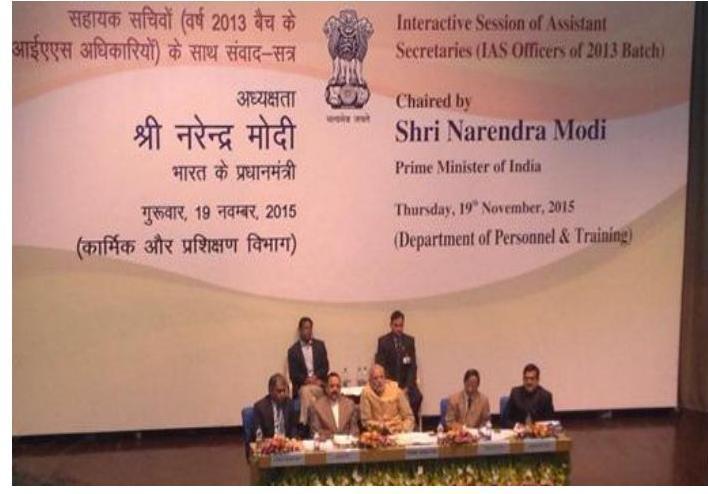
2.18 In the first National Workshop on Citizen Centric Governance held on $12^{\text {th }}$ September, 2015 in association with Department of Industrial Policy and Promotion (DIPP), Govt. of India and the Institute for Development and Communication (IDC), Chandigarh, 20 forms were discussed, simplified and recommended to States for adoption and a draft sample simplified form from Explosive Rules, 2008 was presented and 6 forms were simplified.
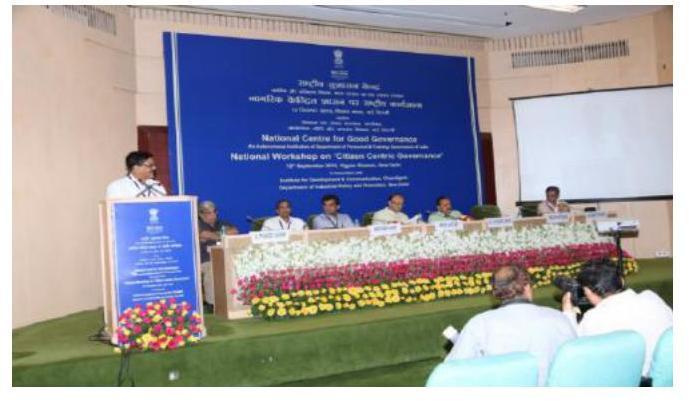
experience for a period of 3 months was held under the Chairmanship of Hon’ble Prime Minister at DRDO Bhawan, New Delhi on 19.11.2015. Exposure of Central Govt. functioning will provide insight into policy formulation at the Centre to these officers. When these Officers will go back for their field posting, they will have a macro picture of such policies which will help them in effective implementation of the schemes keeping citizen at the centre.
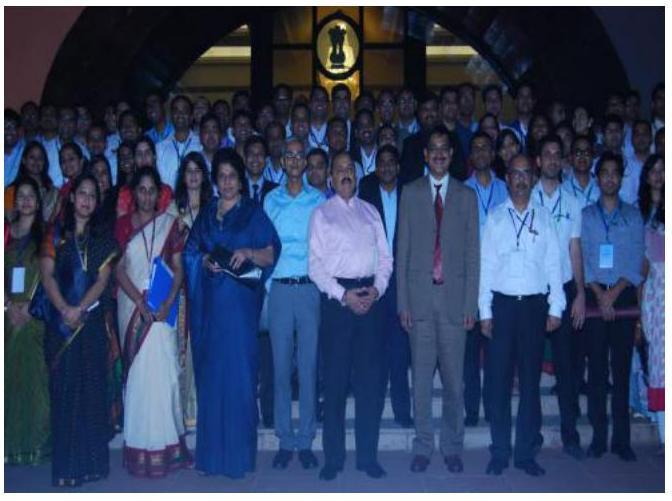
2.19 In continuation of the objective to reduce the gap between the service delivery mechanism and the beneficiaries, the second National Workshop on Citizen Centric Governance was organized on $18^{\text {th }}$ December, 2015 in association with the National Social Assistance Programme (NSAP) of the Ministry of Rural Development, and Employees Provident Fund Organization (EPFO), Employees State Insurance Corporation (ESIC) and Directorate General, Labour Welfare (DGLW) of the Ministry of Labour and Employment.
2.20 The workshop comprised of panel discussions, group work and interactive sessions with the key results in each Department being (i) NSAP simplified 3 forms into single page forms (ii) EPFO simplified procedures for employers, employees and pensioners through online processes (iii) ESIC reviewed 6 certificates and
claim forms which were combined into 3 single page forms (iv) DGLW simplified 20 forms into one page forms.
Blood Donation Camps
2.21 In order to inculcate employees of Central Government for participation in people friendly activities, this Department has started organizing Blood Donation Camps on monthly basis for June 2015 in all major buildings where Government offices are situated. First Camp was held in North Block. 11 Camps have been organized at various locations and 487 units of blood have been collected.
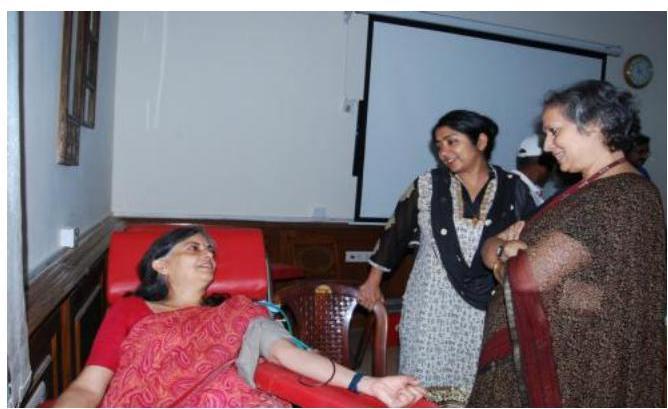
National Symposium on Excellence in Training” (NSET)
2.22 The first National Symposium on Excellence in Training”(NSET) was held on April 11-12, 2015 at Vigyan Bhawan, New Delhi. The Symposium was inaugurated by the Hon’ble Minister for State (PP) Shri Jitendra Singh and attended by over 400 participants. The objective was to provide an annual national platform for experience sharing and exposure to best practices in training to faculty, trainers and administrators of National/ State Training Institutes; Master/Recognized Trainers; and Training Managers of various Ministries/ Departments/ Cadre Controlling Authorities. The NSET exhibited publications by CTIs and ATIs and awarded BEST PRACTICE
AWARDS on 4 thematic areas to individuals/ groups from ATIs and CTIs from all over the country.
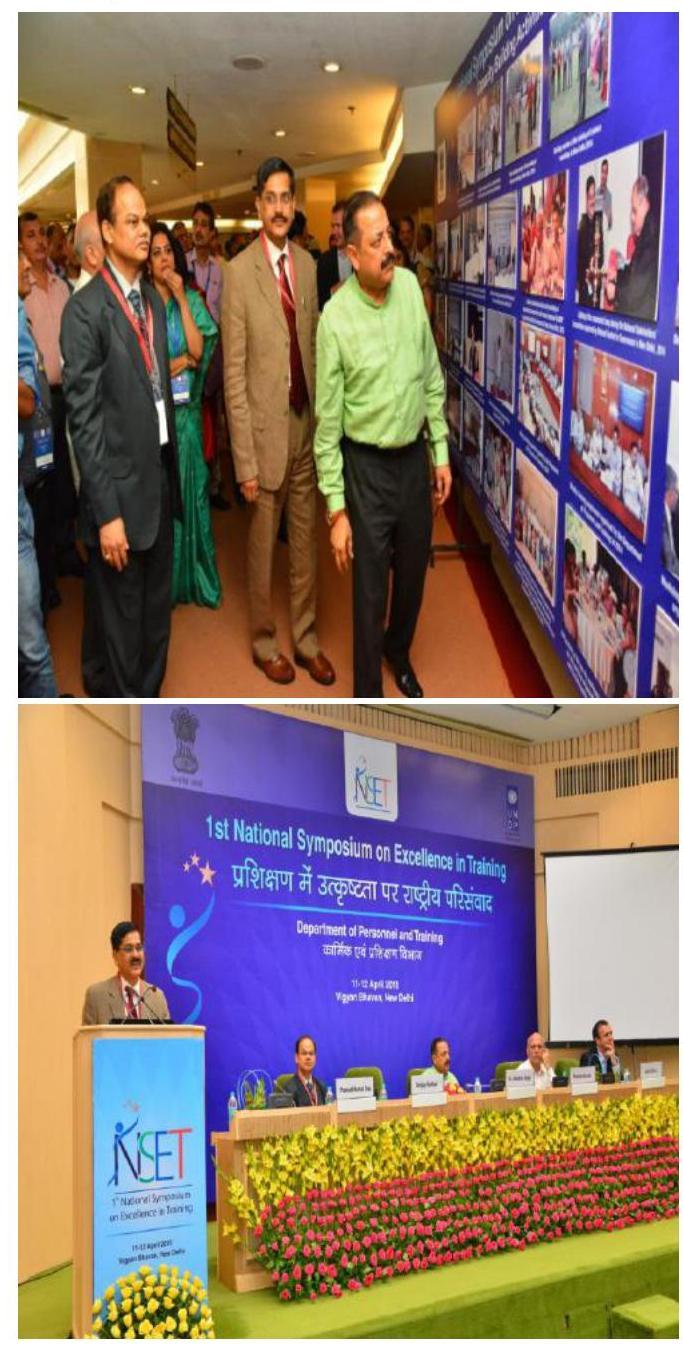
Induction Training Programme (ITP)
2.23 Department of Personnel and Training has launched a new Scheme of Induction Training for newly recruited ( $0-2$ years) frontline State government functionaries with the objective of developing soft skills and domain specific
competencies for strengthening their capabilities to improve the public service delivery mechanism. The 12-Days Induction Training programme has been rolled out in 103 districts of 21 States and would cover new recruits within last three years belonging to departments which have the maximum citizen interaction and are directly involved in the public delivery system. One night stay in a village, attachment with Centres of Excellence and blood donation by the participants are important components of this Programme for sensitizing them towards need of our citizens. Retired AIS officers, State Civil Service Officers, Accounts Officer etc. settled in and around the districts with wealth of experience have been trained to take classes for capacity building of these fresh recruits. This programme will equip the officials for fulfilling their responsibilities towards the Nation and the citizens effectively and efficiently.
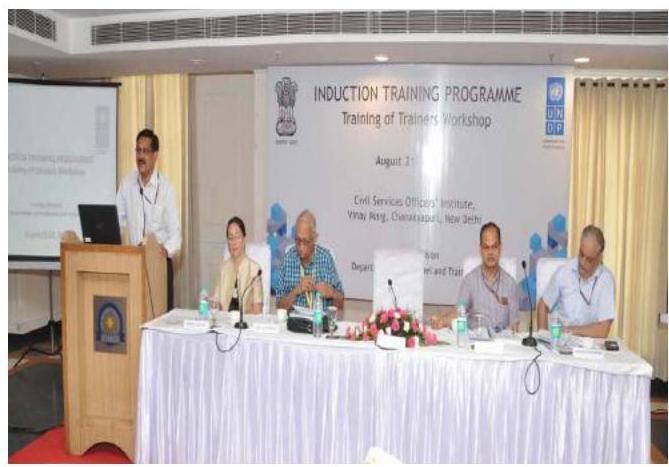
National pool of Trainers on Leadership Skills and Ethics
2.24 Department of Personnel and Training (DoPT) in collaboration with United Nations Development Programme (UNDP) India has developed modules and prepared National Facilitators on two thematic areas of “Leadership Skills” and “Ethics”. The objective is to promote a high quality module developed by reputed
institutes and delivered by scientifically trained National Facilitators on a pan India basis to ensure better learning of the skills. The content and delivery of these modules have sufficient flexibility to account for local and regional variations.
2.25 A total of 53 National Facilitators have been developed. The uniqueness of the pool of National Facilitators is that it brings with it, the skills and experience of retired and serving officers and faculty of ATIs and CTIs. The concept is based on “officer-teach-officer” model where trainees not only learn from the module but also from the personal experiences and sharing of the facilitators. The methodology is extremely participatory and engrossing.
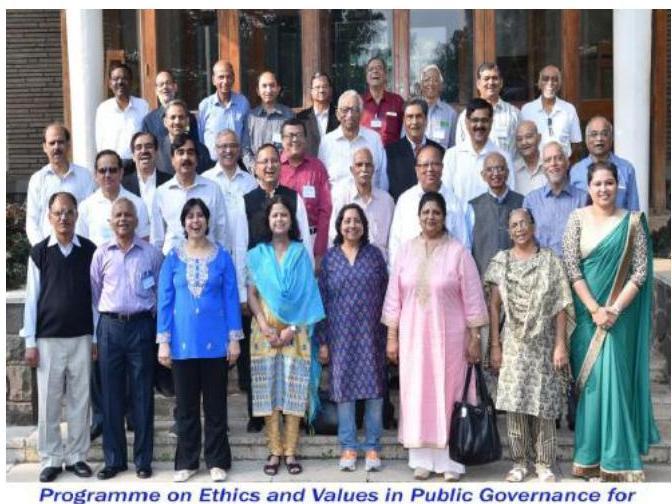
Programme on Ethics and Values in Public Governance for National Pool of Trainers,
Initiatives of change, Asia Plateau, October 05 to 17, 2015
In-house training programme:
2.26 The Department of Personnel and Training started a weekly one hour in-house training programme for its employees. Four modules of the training programme have been completed and the fifth module is currently running. The employees are imparted up-to-date information on various aspects of day to day work in the office. This gives an opportunity to the employees to clear their doubts and the input given in the session is found very useful for them in
discharging their duty more accurately, efficiently and effectively. This has speeded up the rate of disposal of work and the ultimate beneficiary of the same are the citizens.
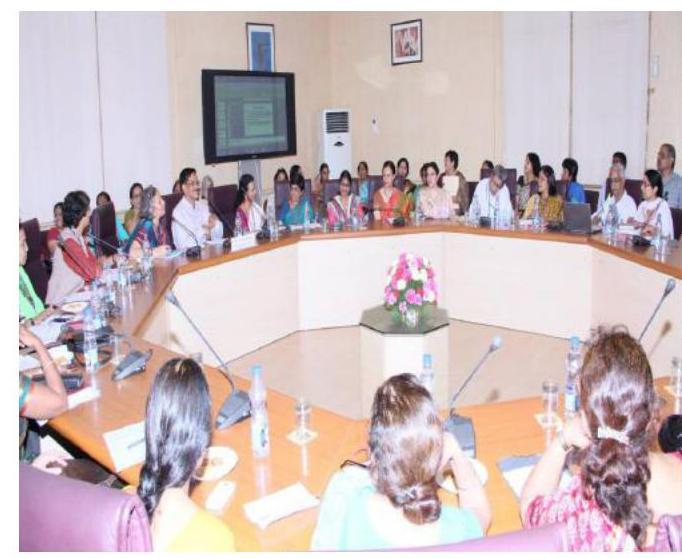
E-Governance Initiatives: SUPREMO
2.27 SUPREMO (Single User Platform Related to Employees Online), a web based application was initiated to integrate the existing applications, using latest technology to reduce redundancy and establish a centralised data base relating to Human Resource Management.
The following systems have been integrated under this:
- Integrated Personnel Information System (IPIS) for IAS and Central Group ‘A’ services officers
- Central Staffing Scheme processing system and Panel processing system
- Empanelment & Appraisal system(EASY) for empanelment of JS level and Equivalent posts in GOI
- ACC vacancy monitoring system (AVMS)
- ACC proposals monitoring system (APMS)
- SPARROW (Smart performance appraisal report recording online window for IAS officers) using WEB services.
- Immovable property returns of IAS officers
- Vigilance information system for IAS officers
This software has been successfully implemented since January, 2016 and a user friendly interface has been designed as a decision support system. The details of standalone applications integrated under SUPREMO are given below:
(A) Integrated Personal Information System (IPIS)
This system was created to maintain e-records of the career profiles of IAS officers and of officers of other services who come on deputation under the Central Staffing Scheme. The records are updated regularly based on orders received from various sources and are available in the public domain. The career profiles of retired IAS officers have also been put in public domain.
(B) Central Staffing System Software
This facilitates online submission of applications by officers for retention of officers under Central Staffing Scheme and their online validation by the Cadre Controlling Authorities. The CSS Software provides a list of officers retained and available, on offer which is published on the public domain.
(C) Empanelment and Appraisal System (EASY)
(i) Under the Central Staffing Scheme, empanelment is a pre-requisite for appointment of a member of an All India Service/Central Group ‘A’ Service to the Joint Secretary/JS equivalent posts at the Centre. Empanelment of eligible officers of all the 37 services participating in CSS is handled batch-wise in EO Division.
An IT-enabled System- Empanelment and Appraisal System (EASY) has been developed with technical support from NIC for generating data electronically by Cadre Controlling Authorities(CCAs) and then transferring it to DOPT for further online processing of the proposal for JS level empanelment. All proposals for JS level empanelment are now received and processed electronically through this software.
(ii) The software includes various other features which help the CCAs in the management of the cadres under their control and at the same time helps EO Division in expediting the empanelment process. The software has three modules viz., Cadre Controlling Authority Module, DOPT Module and Officers’ Interface Module. In pursuance of directions from the PMO, all cadre controlling authorities (of participating services in CSS) were requested to forward batch-wise proposals in EASY for empanelment of officers for Joint Secretary level speedily in a time bound manner up to 1995 batch of services under their control to facilitate empanelment of all services for Joint Secretary level.
(iii) This Department, in response received proposals from various cadre controlling authorities which were processed as and when they were received. Total 17 meeting of various Experts Panels have been convened during the year 2015-2016 for the assessment of officers belonging to various batches of participating services. 114 ACC proposals have been processed and 605 officers have been empanelled so far during the year.
(D) ACC Vacancy Monitoring System(AVMS)
This is web enabled application for getting information from all Ministries/Departments related to all posts, which require ACC approval and for monitoring vacancies and anticipated vacancies of posts under PSUs, Banks, Insurance, Autonomous Organization, Attached Offices, General Central Services, Statutory Body and Export Promotion Councils etc.
(E) ACC Proposal Monitoring System (APMS)
This is an online tool for real-time monitoring of proposals submitted to the Appointments Committee of the Cabinet. It also provides a readily available e-record of orders, directions and back-references made by the ACC Secretariat. Recently, the system has been cleaned and redundancies removed. The system helps in tracking of proposals thereby enabling the effective monitoring and elimination of delays.
(F) Property Related Information System(PRISM)
The PRISM application was launched with effect from 01/08/2014 for IAS officers in order to facilitate online filing of information related to assets and liabilities. The officer is required to authenticate the declaration and information filed by using the Digital Signature (DSC). In case the officer does not have a DSC or is not able to use his DSC for any reason there is a provision to Upload Form enabling the officer to scan & upload the declaration and information relating to assets and liabilities.
(G) Smart Performance Appraisal Report Recording Window (SPARROW)
SPARROW is an online system for performance appraisal of IAS officers. The system aims to bring more transparency in the recording of
performance appraisals, to eliminate loss of PARs during transition, to ensure better monitoring and timely completion of PARs and to provide easy and immediate access to the PARs by authorized stakeholders. The system was launched with effect from 01/04/2014 and was initially linked to the intra-IAS database enabling the PAR form to be pre-populated with the existing information. Subsequently the responsibility to update the requisite details in respect of officers was passed on to the Employee Master Data (EMD) manager of the respective Cadre/Central Ministry or Department.
2.28 Incumbency Position of Group ‘A’ Officers in D/o Personnel and Training as on 01.03.2016 is given at Annexure-I.
Chapter
PERSONNEL POLICIES
- Matters relating to framing and amendment of recruitment rules/service rules for Group “A” and “B” posts
- Framing of policy relating to the procedure for Departmental Promotion Committee(s)
- Policy on seniority
- General policy matters relating to:-
a) Flexible complementing scheme,
b) Modified Assured Career Progression Scheme,
c) Leave travel concession,
d) Deputation,
e) Child care leave,
f) Pay & allowances,
g) Holiday policy,
h) Age relaxation and
i) Other matters concerning service conditions. - Administration of UPSC and SSC including exams except the Civil Service Examination
- Policy matters of PESB
- Policy on Character verification before appointment
- Disagreement cases with UPSC from various Ministries except on appointment cases
- UPSC (Exemption from Consultation) Regulations
- Policy on APAR.
- Commercial employment after retirement
- Policy on
(a) Retirement, extension, re-employment,
(b) Posting and transfers, Conduct and CCA Rules,
c) Sealed Cover procedure,
d) Status of Women in Central Government,
e) Temporary Service Rules, etc.
f) Lien, Probation, confirmation,
g) Daily Wage Casual Labourers
3.0 During the year 2015-16, the Establishment Division has taken some important initiatives with a view to increase transparency and to delegate powers to the Ministries/ Departments to enable quick decision making. In this regard instructions have been issued by this Department on the following issues:-
(i) The Bio-Data proforma for curriculum vitae utilized to call for application for
appointment on deputation/ absorption basis has been revised keeping in view the changes which have taken place upon the implementation of Sixth Pay Commission and also with the objective to reflect complete profile of the candidate.
(ii) The instructions pertaining to constitution of Search Committee/ Search-cumSelection committee have been revised
and instructions have been issued stipulating that the Chairperson of the Committee meeting where the retired Secretary to Government of India are eligible for appointment to a post/ an assignment shall be the Cabinet Secretary.
(iii) The guidelines regarding framing/ amendment/relaxation of Recruitment Rules and Service Rules were revised by incorporating a requirement for putting the draft amendment/revision in the rules on the website of the respective Ministries/Departments for 30 days for inviting comments from the stakeholders. After taking into account the comments received, the proposal is to be sent to DoPT for finalization of RRs.
(iv) Instructions have been issued to all the Ministries and Departments stipulating a time limit of six months for completing entire recruitment process including and starting from advertisement, conducting written examination and holding of interviews.
(v) Besides, the Establishment Division has approved new Recruitment Rules as well as amendments to the existing rules pertaining to posts in various Ministries/ Departments in Government of India.
Timely and advance action in convening of Departmental Promotion Committee meeting in terms of Model Calendarregarding.
3.1 Appointment Committee of Cabinet has viewed seriously that the DPCs are not being convened in time. Delay in promotion affects the manpower planning and impedes the career progression of the employees. The delays in
conduct of DPC negate the very purpose of the Model Calendar for DPCs issued vide Office Memorandum No.22011/9/98-Estt.(D) dated 8th September, 1998 as modified vide OM No. 22011/4/2013-Estt.(D) dated 28/01/2015.
The objective of timely promotions of employees in various Ministries/Departments can be achieved only by granting the promotion in time. All the Ministries/Departments have therefore been again advised to ensure strict compliance of instructions in order to achieve the desired objectives of timely convening of DPCs/ preparation of approved select panels within the prescribed time frame.
(Instructions on the above mentioned subject have been issued vide OM No. 22011/1/2011Estt.(D) dated 23.04.2015)
Review of instructions on appointment to Non Functional Selection Grade of Organized Group A Central Services regarding
3.2 The provisions contained in OM dated 22.11.90 regarding calculation of vacancies in NFSG in respect of officers proceeding on long term deputation (more than one year) have been reviewed and it has been decided that the vacancies arising due to officers proceeding on long term deputations (more than one year) can be considered while calculating the total number of vacancies for grant of NFSG, subject to the following conditions:-
(i) as and when the officers return from deputation, the junior most officer (s) who has/have been granted NFSG will be reverted to JAG level and
(ii) The total number of posts in the cadre in NFSG at any point of time shall not exceed $30 %$ of the Senior Duty Post
(SDP). The OM dated 22.11 .90 shall stand amended to this extent.
The suitability criteria for appointment to NFSG contained in OM dated 9.10 .89 provides that the overall performance of an officer shall be good and he shall have at least two ‘Very Good’ gradings in the last five APARs/ACRs. This criteria has been reviewed and it has been decided that overall performance of an officer for appointment in NFSG shall be “Very good” i.e. 5 Very Good in the last five APARs. The OM dated 9.10 .89 shall stand amended to this extent.
(Instructions on the above mentioned subject have been issued vide OM No. 22038/1/2015Estt.(D) dated 25.06.2015)
Promotion of Govt. Servants exonerated after retirement-Procedure and Guidelines to be followed-regarding.
3.3 Attention is invited to the Department of Personnel and Training Office Memorandum No. 22011/4/91-Estt (A) dated $14^{\text {th }}$ September, 1992 regarding procedure and guidelines to be followed by DPC in respect of Government servants against whom disciplinary/court proceedings are pending or whose conduct is under investigation. In case the Government servant is covered under any of the three conditions as mentioned in Para 2 of OM dated 14.09.1992, the recommendations of the DPC are to be kept in ‘sealed cover’ and subsequent action regarding opening of sealed cover will depend on the outcome of the disciplinary/criminal proceedings.
If on conclusion of disciplinary/criminal proceedings, the Government Servant is exonerated, the procedure prescribed in para 3 of OM dated 14-9-92 is to be followed.
The applicability of above provision in so far as it relates to cases where the Government
servant, who has retired by the time he is exonerated of all the charges has been considered in respect of the following cases:-
(i) Where the promotion order pertaining to the relevant DPC has been issued and the officers empanelled have assumed charge prior to the date of superannuation of the retired Government Servant; and
(ii) The retired Government Servant would have been in service and assumed charge of the post had the disciplinary proceeding not been initiated against him/her.
It has been decided in consultation with the Department of Expenditure, Department of Pension and Pensioners’ Welfare and Department of Legal Affairs that notional promotion and payment of arrears of pay, if any, for the period of notional promotion till the date of retirement, to such a Government servant if found fit on opening of the sealed cover is to be decided by the appointing authority in terms of Para 3 of OM No .22011/4/91 -Estt. (A) dated 14.9.92.
Retired Government employee who is considered for notional promotion from the date of promotion of his next junior after opening of the sealed cover would also be entitled to fixation of pension on the basis of such notional pay on his notional promotion.
(Instructions on the above mentioned subject have been issued vide OM No. 22011/3/2013Estt.(D) dated 25.01.2016)
Processing of files referred to DOP&T for advice/clarification procedure to be followed.
3.4 This Department has from time to time issued instructions prescribing the procedure to be followed for making references to this Department for advice/clarification. These have been further reviewed and revised instructions
on the subject have been issued vide OM F.No.43011/9/2014-Estt.D dated $28^{\text {th }}$ October, 2015 prescribing following provisions:-
i. Administrative Departments shall refer cases to the DoPT only where there is a specific point which is either not covered by prevailing policies/guidelines/rules/ regulations or interpretation of a specific clauses/provisions in the said policies/ guidelines/rules/regulations is involved for a particular case.
ii. When such a reference is made, all facts pertaining to the case may be incorporated in the Self Contained Note.
iii. All the references should be made to DOP&T with the approval of the Secretary of the Administrative Ministry/ Department. These references should be sent atleast two weeks in advance so that it can be properly examined in DoP\&T.
iv. The concerned Ministry/Department, which sends the proposal should indicate the Division within DoPT where it has to be dealt with and also to the concerned Joint Secretary/Director so that there is no delay in processing within DoPT.
v. While sending the proposal, the name, designation of the Joint Secretary/Director (Phone number and e-mail id) who can be contacted for further correspondence may also be indicated.
(Instructions on the above mentioned subject have been issued vide OM No. 43011/9/2014Estt.(D) dated 28.10.2015)
Delegation of powers to Ministries / Departments/Borrowing Organisations to extend deputation tenure upto 7 years in
cases of Deputations covered by DoP\&T’s OM No. 6/8/2009-Estt.(Pay-II) dated $17^{\text {th }}$ June 2010
3.5 As part of simplification process, powers have been delegated vide O.M. No. 2/6/2016-Estt. (Pay-II) dated $17^{\text {th }}$ February,2016 to Ministries/ Departments/ Borrowing organisations to extend deputation tenure upto 7 years in cases of deputations covered by DoP\&T’s OM No. 6/8/2009-Estt(Pay-II) dated 17.6.2010. It has been clarified in para 6 of the O.M. dated $17^{\text {th }}$ February, 2016 that cases which are not covered by the OM dated 17.6.2010, will continue to be decided in terms of the relevant provisions/ rules/instructions etc. governing them. In other words, the delegation does not cover the following cases for whom separate orders exists:-
a) Members of the All India Services and those deputed to posts, whose terms are regulated under specific statutory rules or orders.
b) Officers appointed on deputation to posts under the Central Staffing Scheme (CSS) for whom separate orders as issued from time to time will continue to apply.
c) Deputation to posts operated outside India.
d) Appointments of a specific category of employees to a specified class of posts, such as appointments made in the Personal Staff of Ministers etc., in respect of which special orders are already in existence. However, the terms and conditions set out in this OM will apply to those cases to the extent these are not specifically covered under such special orders.
e) Appointments of the nature of deemed deputation or transfers to ex-cadre posts made in exigencies of service with the
specific condition that no deputation (duty) allowance will be admissible e.g. (i) interim arrangements in the event of conversion of a Government office/ organisation or a portion thereof into a PSU/autonomous body or vice-versa; and (ii) appointments to the same post in another cadre.
Central Civil Services (Leave Travel Concession) Rules, 1988 : Fulfillment of procedural requirement
3.6 A number of references were received regarding the procedural difficulties faced by the Government servant for settlement of the LTC claims. Sometimes, the Govt. servant claims that failure to follow the correct procedure was on account of lack of knowledge of the rules / instructions. In some cases, processing of LTC claims takes unduly long time, particularly when the employee and the sanctioning authorities are located at different stations.
To remove these bottlenecks, the procedure of LTC has been simplified and made time bound. It has also been decided that whenever a Govt. servant will apply for LTC, he/she should be provided with a copy of the guidelines to be followed while availing LTC. DoP&T O.M. No.31011/3/2015-Estt.(A.IV) dated 18.2.2016 issued in this regard.
Casual Labourers with Temporary status: clarification regarding contribution to GPF and Pension under the Old Pension Scheme
3.7 The matter regarding contribution to GPF and pension under the old pension scheme for Casual Labourers has been reviewed in light of the court judgement and in consultation with Department of Expenditure. It has been
decided now that the Casual Labourers who had been granted temporary status under the scheme of 10.9.1993 and have completed 3 years of continuous service after that, are entitled to contribute to the General Provident Fund. $50 %$ of the service rendered by them under temporary status would be counted for the purpose of retirement benefits. DoP\&T O.M. No.49014/2/2014-Estt (C) dated 26.2.2016 issued in this regard.
Establishment (Allowances) Section
3.8 The Establishment (Allowances) Section issued instructions to all Ministries/Departments to switch over to electronic format for maintenance of Service Books of all the employees of the Central Government. The Controller General of Accounts has issued instructions to the Chief Controller of Accounts/Controller of Accounts to treat the electronic format of the Service Book (e-Service Book) as legal for all purposes. The Central Civil Services (Joining Time) Rules, 1979 was also amended to provide for, among others, additional 2 days joining time over and above the normal joining time in cases of transfer to and from North Eastern Region including Sikkim, Andaman and Nicobar Islands, Lakshadweep and Ladakh.
Establishment (Leave) Section
3.9 Establishment (Leave) Section, issued revised package of concessions to the Central Government Employees working in Kashmir Valley in attached/subordinate offices or PSUs falling under the control of Central Government were issued in April, 2015. In the revised package the per diem allowance of Rs. 10/- paid for each day of attendance to compensate for any additional expense in transportation to and from office etc. has been raised to Rs.50/- per day.
Messing allowance of Rs. 15/- & 25.50 has been revised at par with rates of ration money given to CAPFs personnel i.e. Rs. 85.96.
RECRUITMENT AGENCIES
3.10 The Union Public Service Commission (UPSC) and the Staff Selection Commission (SSC) are the two designated recruitment agencies administered by the Department of Personnel and Training. While the UPSC is a Constitutional body set up under Article 315 of the Constitution, the Staff Selection Commission has been set up by Resolution of the Government and it has the status of an attached office of the Department of Personnel and Training. Both these agencies enjoy the reputation for selecting candidates for the Government services in fair, objective and impartial manner. The candidates for the various examinations come from a variety of social environment and having studied in different disciplines.
SET UP AND FUNCTIONS OF UNION PUBLIC SERVICE COMMISSION
3.11 The Union Public Service Commission comprises a Chairman and ten Members. The UPSC makes recruitment for recruitment for All India Service, Group ‘A’ Central Civil Services / posts, and Group ‘B’ Gazetted posts in Ministries/ Departments of the Central Government. The Commission also conducts the examination for recruitment of Commissioned officers in the Defence forces. Some Union Territories (UTs) also avail the services of the Union Public Service Commission for recruitment to the posts under the UT.
3.12 The functions of the Commission are as specified in Article 320 of the Constitution. By exercise of powers conferred by the proviso to Article 320 (3) of the Constitution the President has
made the UPSC (Exemption from Consultation) Regulations, 1958 as amended from time to time, as respects the All India Services and also as respects other services and posts in connection with the affairs of the Union specifying the matters in which it shall not be necessary for the UPSC to be consulted. The latest $65^{\text {th }}$ Annual Report of the Union Public Service Commission for the period 01.04.2014 to 31.03.2015 was laid on the Table of Lok Sabha and Rajya Sabha. The major activities of the Commission during the period from April 1, 2014 to March 31, 2015, as included in the above Annual Report are given below:-
Examination
The Commission conducted a total of 16 examinations under the method of Recruitment by Examinations. Of these, 12 examinations were conducted for selection to Civil Services/Posts and 4 for Defence Services. For these examinations, a total of $32,67,794$ applications were received and processed and 8,947 candidates were interviewed for Civil Services/Posts. The interviews for Defence Services were conducted by the Services Selection Board (SSB) of the Ministry of Defence. A total of 5,969 [5,809+160 (Reserve list)] candidates were recommended for appointment to various posts. A total of 4,465 candidates (including 160 candidates through Reserve List) were recommended for Civil Services/Posts and 1,504 were recommended for Defence Services.
- Of the 2,338 posts reserved for SC, ST and OBC candidates to be filled up under the method of Recruitment by Examinations, the Commission recommended 2,002 SC, ST and OBC candidates. In addition, 148 reserved category candidates were recommended against unreserved posts.
- From the year 2014, the upper age limit for the Civil Services Examination has been increased to 32 years for General candidates, 35 years for OBC candidates and 37 Years for SC/ST candidates, with an additional 10 years’ relaxation for Persons with Disabilities. Further, two additional attempts have been allowed to eligible General and OBC candidates.
- The Geologists Examination has been renamed as the Combined Geo-Scientist and Geologist Examination with the inclusion of two more services in the scheme of the examination from the year 2014. This examination is now conducted for recruitment to the Services/Posts of (i) Geologist (ii) Geophysicist (iii) Chemist and (iv) Junior Hydro Geologist.
- The Commission, for the first time, conducted the Combined Medical Services Examination in the Computer Based Mode, on June 22, 2014. This examination was conducted in a single shot at 41 Centres across the country.
- During the last few years, there has been a significant increase in the number of applications in various examinations conducted by the Commission. The Commission added 14 new Centres for the Civil Services (Preliminary) Examination, 2014, thereby increasing the number of Centres from 45 to 59. For the Civil Services (Main) Examination, 2014, 04 new Centres were added, taking the number of Centres from 19 to 23.
Direct Recruitment by Selection
- For Direct Recruitment by Selection, the Commission received 290 requisitions
for 1,729 posts from various Ministries/ Departments. After adding the cases carried forward from the previous year, a total of 559 requisitions for 4,425 posts were processed during the year. Of these, 55 requisitions for 282 posts were deemed as closed for want of clarifications from the Ministries/Departments concerned, or withdrawn at the pre-advertisement stage by them. - A total of 1,436 posts against 237 requisitions were advertised during the year and 1, 21, 420 applications were received. The recruitment process was cancelled in respect of 17 requisitions for 224 posts and modified in respect of 01 requisition subsequent to the publication of the advertisements.
- During the year, a total of 1, 62, 842 applications were finalized which included applications received in the preceding year; 7, 791 candidates were called for interview and 5,480 candidates were interviewed. The number of candidates recommended for recruitment was 2,303 against 2,544 posts requisitioned in 299 cases. The Applicants to Post Ratio was 64 and the Recommendation to Post Ratio was 0.91 .
- Computer Based Recruitment Tests (CBRTs) were conducted in 10 cases of Direct Recruitment by Selection, where the number of applicants was disproportionately high vis-à-vis the number of vacancies.
- A total of 293 SC, 162 ST and 648 OBC candidates were recommended through Direct Recruitment by Selection. Thus 85.5 percent of the posts for reserved
category were filled up. Furthermore, 42 SC, 08 ST and 159 OBC candidates were recommended for selection against unreserved posts.
- The Commission recommended 43 candidates against 88 posts reserved for Persons with Disabilities to be filled up through Direct Recruitment by Selection.
Appointments
- The Commission made recommendations regarding the suitability of candidates/ officials for promotion, deputation, absorption etc. in respect of 7,055 officers/ posts.
- The Commission considered the service records of 12,064 officers and recommended (a) 6,869 officers for promotion in Central Services and (b) 186 officers for appointment on Deputation/ Absorption.
Visits by Foreign delegations
3.13 The following four foreign Delegations visited the Commission during 2014-15 and held interaction/discussion on various issues of mutual interest:-
a) Eight Members from the Public Service Commission of Nepal.
b) Seven Officers from the Civil Service Training Institute, Government of Maldives.
c) Commissioner, Public Service Commission of Canada.
d) Seven Officers led by the Deputy Permanent Secretary, president’s office, Public Service Management, Government of Tanzania.
Progressive use of Hindi in official work
3.14 The Commission continued to make sincere and concerted efforts to ensure compliance of the provisions of the official Language Act/Rules as also the various orders/instructions issued by the Department of Official Language from time to time regarding the progressive use of Hindi for official purposes.
The details in this regard are as under:-
(a) Implementation of Government’s Language Policy and Programmes
The Commission has an Official Language (OL) Branch under the charge of a Director (OL) which is entrusted with monitoring and implementation of the Official Language Policy and related programmes of the Government. This Branch also performs the work relating to the translation of documents, which are required to be issued in Hindi or bilingually i.e. both in Hindi and English.
(b) The Official Language Implementation Committee
During 2014-15, four meetings of the Official Language Implementation Committee of the Commission were held and necessary followup action was taken to implement its decisions.
(c) Correspondences in Hindi
In pursuance of Section 3(3) of the Official Language Act, 1963, genera orders, resolutions, notifications, press communiqués, administrative reports tender notices, tender forms, etc., were issued bilingually during 2014-15 Correspondence with offices located in ‘A’ and ‘B’ regions were generally carried out in Hindi.
(d) Training in Hindi
During 2014-15, 06 stenographers have received stenography training and 19 officials have received typing training under Hindi Teaching Scheme.
(e) Hindi Workshop
In order to encourage the officers/officials of the Commission to perform their official work in Hindi, 04 workshops were organized during 2014-15.
(f) Cash Awards and Incentive Schemes
In accordance with the Incentive Scheme of the Raj Bhasha Vibhag to encourage the officers/ officials for doing their official work originally in Hindi, the Commission awarded 02 first prizes of 2000/- each, 03 second prizes of 1200/- each, 05 third prizes of 600/- each and 12 consolation prizes of 400/- each to its officers/officials. Similarly, cash prizes and certificates were also given under the Incentives Scheme for Officers for giving dictation in Hindi. In addition to these incentives provided under the Official Language Policy, the Commission is also implementing an Incentive Scheme for rewarding those sections who have performed their maximum official work in Hindi.
(g) Hindi Divas and Hindi Pakhwara
Hindi Pakhwara (Fortnight) was organized from September 01, 2014 to September 15, 2014. The Pakhwara started with an appeal made by the Chairman of the Commission, requesting the officers/officials of the Commission to perform their maximum official work in Hindi. During this period, competitions on Nothing and Drafting in Hindi, Essay writing and Typing in Hindi were held. To conclude the Hindi Pakhwara, the main function was organized on September 15, 2014
under the Chairmanship of the Member of the Commission, Smt. Alka Sirohi, wherein Prizes and certificates were distributed.
(h) Inspections
The use of Hindi is closely monitored through scrutiny and review of Quarterly Progress Reports received from the Sections and also through O&M meeting conducted by the Branch Heads and inspections by Assistant Directors of the Official Language Branch. During 2014-15, a total of 36 Section in the Commission were inspected for compliance with the Official Language Policy and Programmes.
SET UP AND FUNCTIONS OF STAFF SELECTION COMMISSION
3.15 The set up of the Staff Selection Commission (SSC) comprises its Headquarters located in New Delhi and 09 Regional/sub Regional offices located at different parts of the country. The SSC (Hqrs) comprises one Chairperson, two Members, one Secretary cum Controller of Examinations and other supporting officers and staff. The Regional/ Sub-Regional offices are responsible for receipt and processing of applications for various examinations, issue of admit-cards to the candidates and conduct of examinations, interviews and Physical Endurance Tests (wherever required) either at the Regional Headquarters or other major cities in the regions. The role of the Staff Selection Commission is to make recruitment to Group ‘C’ (non-technical) and Group ‘B’ (non-gazetted) posts in Ministries/ Departments of Government of India and its attached and subordinate offices except those for which recruitment is made by the Railway Recruitment Boards and these exempted from the purview of SSC.
3.16 INNOVATIVE MEASURES ADOPTED IN THE EXAMINATION SYSTEM
1. Discontinuation of interviews for junior level posts
In pursuance of the decision taken by the Government, the Commission has dispensed with the provision of interview in all examinations. For selection posts the Commission has devised an alternative arrangement to replace interviews. There will be no clause relating to interview in the Notices to be published in year 2016.
2. Promotion of online examination
The Commission has taken initiative for introducing computer based examination to address issues relating to malpractices, impersonation, reducing time cycle for declaration of results and ensured higher transparency.
3. In order to enhance operational efficiency of the Commission and for conducting smooth and fair examinations during the year 2015-16 various initiatives were taken/mooted. These inter alia include:
(i) Printing Randomised Question Booklets for preventing malpractices during conducting of examinations across the country.
(ii) Proper frisking of candidates before entering the examination hall/centres during conduct of examination.
(iii) Deploying police personnel in different Examination Hall/Centres to maintain law and order during conduct of examination.
4. Introduction of self- attestation of documents:
The Commission continued with the practice of accepting only self-attested copies of documents from candidates for all examinations including selection posts which was introduced vide its order dated $2^{\text {nd }}$ September, 2014.
5. In order to enable more authentic verification of credentials and encourage e-governance the Commission has decided to include AADHAR No. in the application form AADHAR No., however, will not be mandatory.
6. An online dossier tracking system has been put in place to monitor forwarding of dossiers on real time basis. The initiative will facilitate fast tracking candidates joining their Departments after declaration of results.
PROGRESSIVE USE OF HINDI IN COMMISSION’S WORK
3.17 During the period under review, provision of section3(3) of official languages Act,1963 and official language Rule,1976 were duly complied with. All the notices of various examinations published during the period were issued bilingually and the emphasis was laid on increasing the original correspondence in Hindi with three regions namely A, B and C as per targets prescribed by the Department of Official language. Two regional / sub-regional offices of SSC namely Allahabad (Region-A) and Guwahati (Region-C) were awarded Rajbhasha Shield under the scheme of commendable work in official language Hindi for the year 2014-15. In the year 2014-2015 three cash awards were awarded to one officer and two employees under the scheme of Hindi dictation and original work in Hindi for the year 2014-2015 respectively.
In order to encourage the progressive use of Hindi in the official work and to create interest among the Officers/Officials for its usage, Hindi software supported by Unicode compliance is being used. All the Regional/Sub-regional offices of Commission (Hqrs) too are using this Hindi Software/Fonts. A one day Hindi Workshop was also organized on $10^{\text {th }}$ July, 2015 on “Use of Hindi tools in computer”. Twenty five participants
were trained in this workshop. In addition, Hindi Fortnight was organized from $1^{\text {st }}$ to $15^{\text {th }}$ September, 2015. During the fortnight, various competitions like Story writing, Noting and Drafting, Poem recitation, Debate competition, Hindi dictation, translation, painting and drawing competition were organized. Cash awards and certificates were distributed to the winners by Chairman, SSC in the concluding session. In the concluding session a Hindi Kavya Gosthi was also organized. SSC has taken a unique initiative to start a new quarterly literary House magazine “Jharokha” to showcase the versatile literary talent of the officials of SSC. Six editions of this magazine have been published so far.
MAJOR EVENTS DURING 2015-16
I Regional Directors’ Conference at New Delhi on $1^{\text {st }}$ December, 2015
3.18 The Commission organized its Annual Conference at New Delhi on $1^{\text {st }}$ December, 2015. All officers of Commission’s (HQs) and its Regional Directors / Deputy Directors participated in the Conference. The Agenda of the Conference included discussion on important policy matters relating to examinations conducted by the Commission, including Revised Procedure for Recruitment to Selection Posts consequent to the Government’s Decision to dispense with interviews for all Group B' Non-Gazetted and GroupC’ Posts, which were being filled up through interview only.
II Meeting with CFSL, Regional Directors/ Deputy Directors and Officers of Commission’s HQs held on $14^{\text {th }}$ May, 2015 regarding pending Impersonation cases with CFSL
3.19 Considering delay in disposal of impersonation cases at the level of CFSL, a
meeting was organized on $14^{\text {th }}$ May, 2015 with senior officials of CFSL in which Regional Directors / Deputy Directors of Regional Offices and officers of Commission’s HQs at New Delhi participated.
III. Workshop with Regional Directors /
Deputy Directors in the Commission’s HQs held on $9^{\text {th }}$ October, 2015 to review Online Document Verification System and Dossier Checking System
3.20 A Workshop with Regional Directors / Deputy Directors in the Commission’s HQs was held on $9^{\text {th }}$ October, 2015 in which Online Document Verification System and Dossier Tracking System being followed by the regional offices was reviewed. The issues relating to handling of VIP References / Letters from MPs/MLAs and Parliament Assurances were also reviewed in the Workshop. Further, issues relating to timely and quality redressal of public grievances were also reviewed. Standard / format for reply to be given in respect of online public grievances under CPGRAMS during the Workshop was discussed.
3.21 Candidates selected through various Open Examinations during 2015-16
(upto $1^{\text {st }}$ January, 2016)
| S. No. |
Name of Examination | Candidates selected |
|---|---|---|
| 1 | Junior Engineers Exam, 2014 | 2116 |
| 2 | Constable, 2011 (Male)Rev. Result |
1465 |
| 3 | Constable, 2011 (Female) Rev. Result |
7 |
| 4 | Combined Graduate Level Exam, 2014 |
15549 |
| 5 | Combined Higher Secondary Level Exam, 2014 |
2575 |
| TOTAL | 21712 |
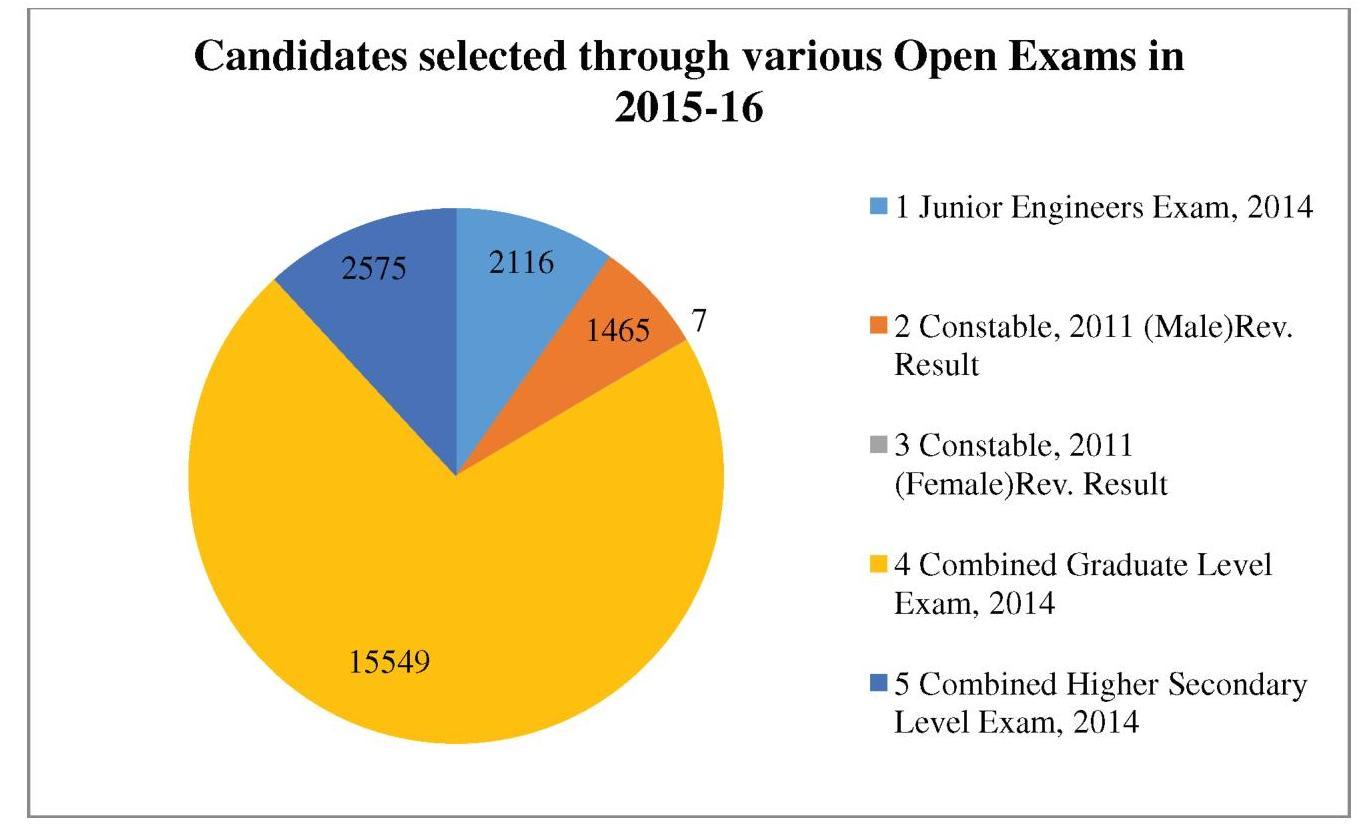
3.22 Information in respect of various examinations conducted during 2015-16 and the total number of candidates registered for these examinations
| S. No. |
Name of Examination | Date of Advt. | Date of Exam | Total No. of candidates registered |
|---|---|---|---|---|
| 1 | SI in Delhi Police, CAPFs and ASI in CISF Examination, 2015 |
27.03 .2015 | 21.06 .2015 | 5506340 |
| 2 | Combined Graduate Level Examination, 2015 | 02.05 .2015 | 09.08 .2015 16.08 .2015 |
2958117 |
| 3 | Combined Higher Secondary Level (10+2) Examination, 2015 |
13.06 .2015 | 01.11 .2015 , 15.11 .2015 806.12 .2015 20.12 .2015 |
6999490 |
| 4 | Junior Engineers(Civil/Mechanical/ Electrical) Examination 2015 |
11.07 .2015 | 17.01 .2016 | 711306 |
| 5 | Stenographers (Gr. C & D) Examination, 2015 | 08.08 .2015 | 24.01 .2016 | 688686 |
| 6 | Special Recruitment Drive for persons with disabilities to the post of MTS (NT) Staff in Different States and UTs 2015 |
24.10 .2015 | 10.01 .2016 | 64235 |
| TOTAL | 16928174 |
Information in respect of various examinations conducted during 2015-16 and the total number of candidates appearing in these examination.
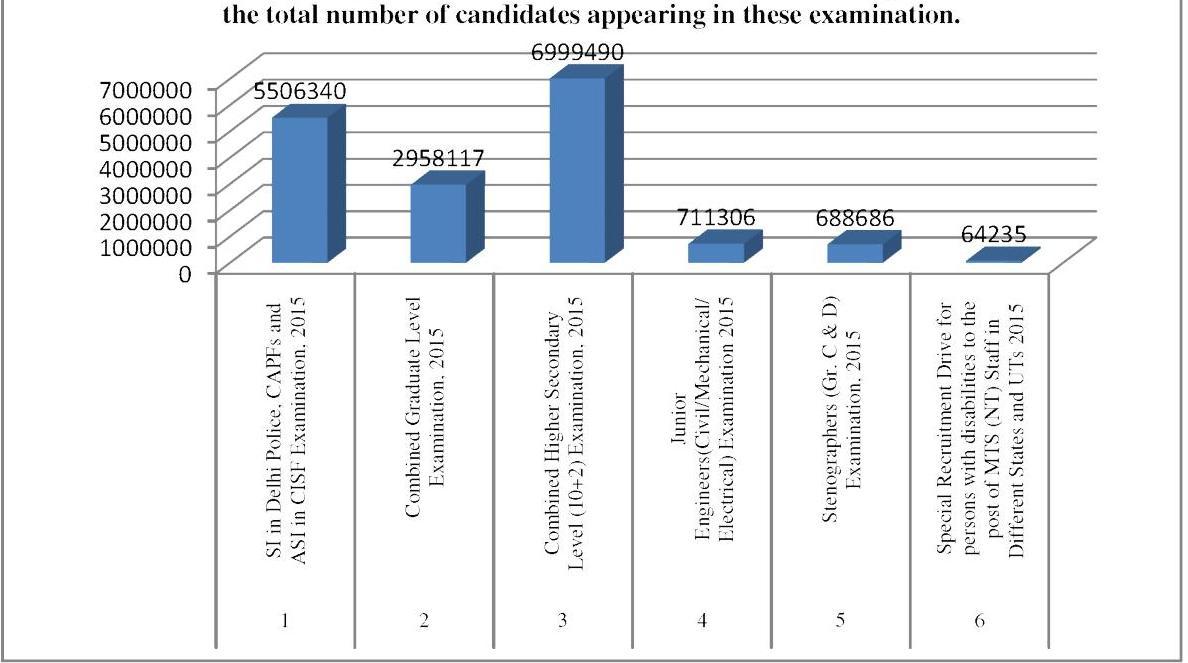
Public Enterprises Selection Board
3.23 The Public Enterprises Selection Board {PESB} is a high powered body constituted by Government of India Resolution dated 3.3.1987 which has been subsequently amended from time-to-time, the latest amendment being on 4.4.08. The PESB has been set up with the objective of evolving a sound managerial policy for the Central Public Sector Enterprises(CPSE) and, in particular to advise Government on appointment to top management posts. The PESB is headed by a full – time Chairman with three Members.
3.24 The specific functions assigned to the PESB include the following:
(i) to be responsible for the selection of personnel for the posts of Chairman, Managing Director or Chairman-cumManaging Director and Functional Director in CPSEs as well as in posts at any other level as may be specified by the government;
(ii) to advise Government on matters
relating to appointments, confirmation or extension of tenure and termination of services of the personnel of the above mentioned levels;
(iii) to advise Government on the desired structures at the Board level, and for senior management personnel, for each PSE or a group of PSEs;
(iv) to advise Government on a suitable performance appraisal system for both the PSEs and the managerial personnel in such enterprises;
(v) to advise Government on formulation and enforcement of a code of conduct and ethics for managerial personnel in PSEs;
(vi) to advise Government on evolving suitable training and development programs for management personnel in PSEs; and
(vii) to build data bank containing data relating to the performance of PSEs and their officers
3.25 Ministries/Departments are required to send proposals to PESB only in cases of nonconfirmation of tenure of Board level incumbents on performance grounds i.e. in cases where the score on the Special Performance Report (SPR) is less then 37.5 .
3.26(a) A CMD/MD/Functional Director would be deemed to be confirmed unless the Ministry/Department sends a proposal to the PESB, to the contrary, within 30 days after the expiry of one year of the executive’s contractual period. Within this stipulated period of one year and thirty days, the Ministry shall issue necessary order for confirmation, if the Ministry fails to send a proposal to the contrary, to the PESB.
(b) Now only proposals of non-extension on performance grounds are required to be sent to PESB by the Administrative Ministries. All cases of extension are to be referred to the ACC.
3.27 The PESB in consultation with DPE has evolved a benchmarking system to be applicable while considering proposals for extension. All proposals in which the incumbent meets the benchmark and the Ministry/Department decides to recommend extension are to be referred to the ACC for approval, not later than two months
before the scheduled expiry of the tenure of the incumbent. No reference would be needed to be made to the PESB in such cases.
3.28 All proposals wherein the incumbent does not meet the benchmark are to be referred to the PESB by the Department/Ministry concerned. This reference has to be made six months before the scheduled expiry of tenure of the incumbent. The recommendation of the PESB would then be submitted to the ACC for orders.
3.29 In view of large number of applications being received for Board level positions in CPSEs, shortlisting of eligible candidates is restricted to only fifteen applicants for a Selection Meeting.
3.30 A Software for inviting online applications for the posts of CMD/MD/Director for various CPSEs is under development in PESB as a part of e-Governance initiated by the Government.
3.31 Under the Swachh Bharat Mission, old records/files have been reviewed and weeded out/ recorded as per the guidelines of record retention schedule. A mass cleanliness drive had also been undertaken under this mission to clear the office spaces of obstacles in fire safety measures and a schedule drawn up to monitor our cleanliness drive.
3.32 POLICY AND PROCEDURES RELATING TO CENTRAL PUBLIC SECTOR ENTERPRISES (CPSEs) FOLLOWED BY PUBLIC ENTERPRISES SELECTION BOARD (PESB)
| Initiation of Selection procedure |
The PESB keeps a close and constant watch on the vacancies that are likely to arise or have arisen and initiates the process of selection 16 months before the occurrence of the vacancies so as to recommend panel six months prior to a vacancy and within four months of a vacancy arising. The Board initiates selection process by sending job description of the post to the concerned Administrative Ministry/Department with a request to update the company profile and the job description within 15 days followed by reminder. In case the Ministries/Departments do not respond within the aforesaid time frame the job description of the post is circulated suo motu. A period of 60/45 days is normally given to receive the applications after circulation of the vacancy for superannuation/unforeseen vacancies respectively. |
|---|---|
| Date of Vacancy | The date of vacancy of a post is reckoned with reference to the date it will fall vacant or has fallen vacant as follows: | ||
|---|---|---|---|
| In the case of post newly created or kept in abeyance. | Date of issue of order creating/reviving the post. | ||
| In the case of panel recommended by PESB but which has been scrapped by the ACC. | Date of issue of order scrapping the panel. | ||
| Circulation of the post | The post is circulated among all Central PSEs, Ministries and state Chief Secretaries, and also uploaded on the Board website. Further no valid application should be withheld by the PSU or the Ministries/Department. | ||
| Shortlist of candidates | Applications, including names from data bank wherever applicable, are considered with reference to the job description and eligibility criteria in the following manner; subject to a maximum of 15 : | ||
| 8 | $:$ | Internal (from the same CPSE or its subsidiary). | |
| 3 | $:$ | Sectoral (from PSEs of the same Administrative Ministry). | |
| 2 | $:$ | External (from any other CPSE). | |
| 2 | $:$ | Government | |
| The shortfall in any particular category is carried forward and distributed between the remaining categories on a pro rata basis. | |||
| Scheduling of selection date | Selection meeting is scheduled in consultation with the Secretary of the Administrative Ministry/Department. | ||
| Assistance by Ministry representative and CMD/MD of the PSE | Secretary is invited to assist the PESB on behalf of the administrative Ministry/ Department. However the concerned Secretary may nominate an officer not below the rank of Additional Secretary to represent him for a Board level post other than CMD of schedule A company. In the case of selection of Functional Directors, the concerned regular Chief Executive of the concerned enterprise is invariably invited to assist the PESB. However, in the case of subsidiaries, the Chairman of the holding Company is invited to assist the Board. |
||
| Joint venture PSE | In the case of Joint Venture enterprises, where the State Government has participation of over $25 %$, the Chief Secretary of the concerned State Government is also invited to assist the Board. |
| Recirculation/ constitution of search committee/ Press Advertisement |
After the first round of Selection Interview, in case no candidate is found suitable and the Board wishes to see some more candidates, the post is re-circulated. The Board may also decide to convert itself into a Search cum Selection Committee and follow the Search Committee mechanism for making selection. The Board may also decide to advertise the post in prominent dailies in which case the eligibility pay scales for the post are in the next below schedule. Selection interviews are held on the basis of the open advertisement. |
|---|---|
| Rule of immediate absorption |
Officers from Organized Services will be considered only on “immediate absorption basis”, unless the posts have been exempted specifically from the rule of immediate absorption with the approval of the Competent Authority. |
| Exemption from the rule of immediate absorption |
Provided if no suitable candidate is found and the Administrative Ministry so desires, the question of granting exemption from the rule of immediate absorption may be recommended by the Board. |
| Vigilance clearance by CVC |
The Board while sending its recommendations to the concerned administrative Ministry/Department also conveys the recommendation to the Central Vigilance Commission to enable them to initiate advance action for processing vigilance clearance. |
| Internal candidate |
Internal candidate is one, who is an employee of an enterprise who has put in a minimum of two years of continuous service in it immediately preceding date of vacancy, and who does not hold a lien in any other PSE/Government. An employee who holds a lien on a post in a CPSE can also be considered as an internal candidate of that enterprise, provided he/she has put in a minimum of two years of continuous service in that enterprise, on the date of acquiring the lien and the period for which he/she is away from the enterprise is not more than 5 years. |
| Age criteria | On the date of occurrence of Vacancy: |
| Schedule of PSE | Age of superannuation 60 years |
|---|---|
| Internal External | |
| Min. Max. Min. Max. | |
| CMD Schedule A/Director Schedule A/ CMD Schedule B |
45 58 45 57 |
| Director Schedule B/CMD Schedule C/ Director Schedule C/CMD Schedule D |
40 58 40 57 |
| Age of superannuation 58 years | |
| Internal External | |
| CMD Schedule A/Director Schedule A/ CMD Schedule B |
45 56 45 55 |
| Director Schedule B/CMD Schedule C/ Director Schedule C/CMD Schedule D |
40 56 40 55 |
ELIGIBILITY PAY SCALES FOR VARIOUS BOARD LEVEL POSTS
| Pay scale of the Board level post | PSE executives | Eligibility for Government officers |
|---|---|---|
| Schedule ‘A’ CMD (in rupees) |
||
| $\begin{aligned} & 27750-31500 \text { (Pre 2007) } \ & 80000-125000 \end{aligned}$ | $\begin{aligned} & \text { 8250-9250(IDA) Pre } 01.01 .92 \ & \text { 11500-13500(IDA)Post } 01.01 .92 \ & \text { 23750-28550(IDA) Post } 01.01 .97 \ & \text { 62000-80000(IDA) Post } 01.01 .07 \ & \text { 22400-24500(CDA) Pre revised } \ & \text { 67000-79000 (CDA) } \end{aligned}$ | Addl. Secretary or equivalent/ Lt. General in the Army or Vice Admiral in Navy or Air Marshal in the Air Force. |
| Schedule ‘A’ Director Schedule ‘B’ CMD |
||
| $\begin{aligned} & 25750-30950 \ & 75000-100000 \ & 75000-90000 \end{aligned}$ | $\begin{aligned} & \text { 7250-8250(IDA) Pre } 01.01 .92 \ & \text { 9500-11500(IDA) Post } 01.01 .92 \ & \text { 20500-26500(IDA) Post } 01.01 .97 \ & \text { 51300-73000(IDA) Post } 01.01 .07 \ & \text { 18400-22400(CDA) Pre revised } \ & \text { 37400-67000+GP 10000(CDA) } \end{aligned}$ | Joint Secretary or equivalent/ Major General in the Army or Rear Admiral in Navy or Air Vice Marshal in the Air Force. |
| Schedule ‘B’ Director Schedule ‘C’ CMD |
||
| $\begin{aligned} & 22500-27300(\text { Pre 2007) } \ & 65000-75000 \end{aligned}$ | $\begin{aligned} & \text { 6250-7475(IDA) Pre } 01.01 .92 \ & \text { 8520-10050(IDA) Post } 01.01 .92 \ & \text { 18500-23900(IDA) Post } 01.01 .97 \ & \text { 43200-66000(IDA) Post } 01.01 .07 \ & \text { 14300-18300(CDA) Pre revised } \ & \text { 37400-67000+GP 8700(CDA) } \end{aligned}$ | Director or equivalent/ Brigadier in the Army or Commodore in Navy or Air Commodore in the Air Force. |
| Schedule ‘C’ Director Schedule ‘D’ CMD |
||
| $\begin{aligned} & 20500-25000 \text { (Pre revised) } \ & 51300-73000 \end{aligned}$ | $\begin{aligned} & \text { 5550-6870 (IDA) } \ & \text { 7500-9900 (IDA)Post } 01.01 .92 \ & \text { 17500-2300(IDA)Post01.01.97 } \ & \text { 36600–62000(IDA)Post01.01.07 } \ & \text { 12000-16500 (CDA) Pre revised } \ & \text { 15600–39100+GP 7600 (CDA) } \end{aligned}$ | Deputy Secretary or equivalent/ Lt. Colonel in the Army or Captain in Navy or Group Captain in the Air Force. |
Period of service in the eligible scale
The minimum length of service required in the eligible scale will be one year for internal candidates, and two years for others as on the date of vacancy.
| Job hopping | 1. For PESB the concept of job hopping is valid only when a candidate has taken a position at the Board level. 2. When a candidate moves from Company A to Company B on a Board level position, he is expected to work for minimum two years in order that restriction of job hopping does not apply to him. If he has put in less than 2 years, the rule of job hopping will apply to him for a position in other companies. 3. If a position falls vacant in the same company at a higher level, the restriction of job hopping will not apply to a Director as ‘vertical hopping’ is permitted in the same Company. For example, if an incumbent has moved from company A to company B he will be eligible for applying for CMD’s position in company B but not in company A even if he holds lien in company A. |
|---|---|
| 4. Job hopping restriction will apply to an incumbent for lateral movement within the company as well as in any other company. 5. There is an embargo of six months for a candidate holding No. 1 position in a panel. |
|
| Candidate recommended earlier not considered for another post for six months | Candidate recommended as No. 1 in the panel for a Board level post is not considered for another Board level post for a period of six months from the date of selection interview or till the approval of the concerned panel, whichever is earlier. |
| Tenure of appointment at board level | The Board level functionary will be considered for appointment for a period of 5 years or till the age of superannuation, whichever is earlier, on contract basis, with a provision that the Government will have the option to terminate the services with three months’ notice. |
| Relaxations in appointment of Chief Executive and functional Directors in sick/ loss making PSE where revival package has been approved | In the case of sick/loss making CPSE for which revival plan has been approved by the Government, the following relaxation could be provided:- In case, any Board level incumbent of such CPSE has contributed exceedingly well in the turnaround of that sick CPSE, his tenure may be extended till he attains the age of 65 years. Since, the selection process to a board level post is being initiated by PESB one year prior to the due date of superannuation of the incumbent, the proposal for extension of tenure beyond the age of superannuation will have to be initiated at least one year prior to the date of superannuation of the incumbent. In case, the balance period of tenure of incumbent is less than one year at the time of approval of revival package by the Government, such proposal for extension of tenure may be initiated immediately after approval of revival package by the Government. The decision on the extension of tenure beyond the normal retirement age will be taken as per the extant procedure for extension of tenure of Board level executives, i.e. joint appraisal by PESB followed by the approval of the competent authority. Further, such extension would be subject to annual review of the performance of the incumbent to be conducted by Secretary of the concerned administrative Ministry. |
| Where fresh appointment of the Chief Executive or any Functional Director is proposed and if the PESB procedure of circulation of vacancy does not ultimately lead to a panel for consideration by the competent authority, then relaxation of cut-off age for applying, to 62 years, with minimum tenure of 3 years, could be considered. In such cases, serving/retired CPSE executives, Government servants and private sector executives could be considered. Chief Executives and Functional Directors of these CPSEs would be considered for a lump-sum incentive up to maximum of Rs. 10 lakh out of the profits of the CPSE besides usual pay, allowances and perks attached to the post. |
|
|---|---|
| Competent Authority |
Appointments Committee of Cabinet is the competent authority for appointment and extension of CMD/MD/Functional Directors of Schedule A and B PSEs, and the Minister in-charge is the competent authority for appointment and extension of Board level posts belonging to schedule C and D CPSEs. |
| Validity of Panel |
As per D.O.No.29 (3) EO/2008(ACC) dated 27th May, 2008 of Cabinet Secretary, the panel of names recommended by PESB is valid for one year and need to be revalidated before submission to ACC. |
| Number of appearance in a year |
A candidate may apply any number of times in a calendar year, but he may be allowed to appear only up to four times in selection meetings, in a calendar year. This restriction in number of appearances has come into effect from 1st January 2013. |
| Incomplete Application |
If any candidate fails to fill up any column in his application, the same will be rejected as incomplete. Applications for Board level posts that are received through proper channel sometimes leave column no -9 (with respect to penalty / enquiry etc.) blank. PESB has decided that henceforth such applications will be treated as incomplete and rejected. |
| Eligibility of incumbent Directors when the schedule of Company is up-graded. |
(i) Pre-upgradation Posts: Vacancies arising for the first time after upgradation- If the date of first time vacancy is within 2 years of the date of upgradation (as notified by DPE), the eligibility criteria for internal candidates (only) will be the same as was applicable prior to upgradation. (ii) Posts created after upgradation- As per norms applicable to the Schedule to which PSU has been upgraded. |
3.33 BUDGET ESTIMATES 2015-2016 (IN THOUSANDS OF RUPEES)
| HEADS | PLAN | NON-PLAN | TOTAL |
|---|---|---|---|
| SALARIES | 0 | 24200 | 24200 |
| WAGES | 0 | 180 | 180 |
| OVER TIME ALLOWANCE | 0 | 120 | 120 |
| MEDICAL TREATMENT | 0 | 500 | 500 |
| HEADS | PLAN | NON-PLAN | TOTAL |
|---|---|---|---|
| DOMESTIC TRAVEL EXPENSES | 0 | 550 | 550 |
| FOREIGN TRAVEL EXPENSES | 0 | 200 | 200 |
| OFFICE EXPENSES | 0 | 5000 | 5000 |
| PUBLICATION | 0 | 200 | 200 |
| MINOR WORKS | 0 | 500 | 500 |
| PROFESSIONAL SERVICES | 0 | 100 | 100 |
| OAE | 0 | 600 | 600 |
| TOTAL | 0 | $\mathbf{3 2 1 5 0}$ | $\mathbf{3 2 1 5 0}$ |
Chapter 4
RESERVATION IN THE CENTRAL GOVERNMENT SERVICES
MANDATE
Policy matters regarding Reservation in Services in Central Government for the following:-
- Scheduled Castes, Scheduled Tribes & Other Backward Classes;
- Persons with Disabilities;
- Ex-servicemen.
The Government has taken several steps for the upliftment and welfare of the Scheduled Castes, the Scheduled Tribes, the Other Backward Classes and the Persons with Disabilities. One such step is to give them reservation in services under the State. Persons with Disabilities and Ex-servicemen also get the benefit of reservation in services.
RESERVATION FOR SCs, STs AND OBCs:
4.1 Clause (4) of Article 16 of the Constitution of India enables the State to make provision for reservation of appointments or posts in favour of any backward class of citizens which, in the opinion of the State, is not adequately represented in the services under the State. Clause (4A) of the same Article enables the State to provide reservation for the members of the Scheduled Castes and Scheduled Tribes in the matter of promotion. Article 335 provides that the claims of the members of the Scheduled Castes and the Scheduled Tribes shall be taken into consideration, consistently with the maintenance of efficiency of administration, in the making of appointments to services and posts in connection with the affairs of the Union or of a State.
4.2 In consonance with the powers given by the Constitution, the Government has issued various instructions from time to time providing for reservation in services for the members of the Scheduled Castes (SCs), the Scheduled Tribes (STs) and the Other Backward Classes (OBCs). Such members of Other Backward Classes who fall in creamy layer, however, do not get the benefit of reservation. The income limit for determining the creamy layer status amongst the OBCs to exclude the socially advanced persons/ sections is presently Rs.6.0 lakh per annum.
4.3 Reservation to SCs, STs and OBCs, in case of direct recruitment, is available in all groups of posts. When direct recruitment is made on all India basis by open competition, reservation for SCs, STs and OBCs is respectively $15 %, 7.5 \%$ and $27 \%$; and when direct recruitment is made on all India basis otherwise than by open competition it is $16.66 \%, 7.5 \%$ and $25.84 \%$ respectively. In case of direct recruitment to Groups C and D posts normally attracting candidates from a locality or a region, percentage of reservation for SCs and STs is generally fixed in proportion to the population of SCs and STs in the respective
States/UTs and reservation for OBCs in such cases is fixed keeping in view their proportion in the population of the State/UT and that it is not more than $27 %$ and total reservation for SCs, STs and OBCs does not exceed the limit of $50 \%$.
4.4 The Government had carved out a subquota of 4.5 per cent for minority communities from within the $27 \%$ reservation for OBCs. However the Hon’ble High Court of Andhra Pradesh quashed the same. An SLP has been filed by Union of India in the Hon’ble Supreme Court against the decision of the High Court of Andhra Pradesh and the matter is sub-judice.
4.5 Reservation in promotion by non-selection method is available to SCs and STs in all groups of services at the rate of $15 \%$ and $7.5 \%$ respectively. In case of promotion by selection method, SCs and STs get the benefit of reservation upto the lowest rung of Group ‘A’. However, no reservation is given in the matter of promotion to the grades of posts or services in which the element of direct recruitment, if any, exceeds 75 percent. There is no reservation for OBCs in the matter of promotion.
4.6 In promotion by selection to posts within Group ‘A’ which carry a Grade Pay of Rs.8700/- or less (in revised pay scale), there is no reservation, but the Scheduled Caste/Scheduled Tribe officers who are senior enough in the zone of consideration for promotion so as to be within the number of vacancies for which the select list is to be drawn up, are included in that list provided they are not considered unfit for promotion.
4.7 Various relaxations and concessions are given to SC and ST candidates so as to improve their representation in services. For example they get relaxation in the upper age limit, unlimited number of chances within the relaxed age limit prescribed for appearing in the competitive
examinations, exemption from payment of examination fee and relaxation in standards of suitability. Likewise, the OBC candidates get concessions like relaxations in the upper age limit upto three years, relaxation in number of chances upto seven within the relaxed age limit for appearing in the Civil Services Examination etc. The SC/ST/OBC candidates appointed on their own merit are adjusted against unreserved vacancies. To ensure that posts reserved for SCs, STs and OBCs are filled by candidates belonging to these categories of persons only, there is general ban on de-reservation of vacancies in case of direct recruitment.
4.8 Provision of reservation has, over the period, helped in increasing the representation of Scheduled Castes and Scheduled Tribes in services of the Government of India. As per available information, there were only $13.17 \%$ Scheduled Castes and 2.25\% Scheduled Tribes in services as on $1^{\text {st }}$ January, 1965, which has increased to $16.99 \%$ and $8.55 \%$, respectively, as on 1.1.2014. Representation of Scheduled Castes and Scheduled Tribes in Group A service has increased from $1.64 \%$ in 1965 to about $12.71 \%$ now. Likewise, the representation of Scheduled Tribes in Group ‘A’ services has increased from $0.27 \%$ in 1965 to about $5.5 \%$ now.
4.9 Representation of Other Backward Classes in services, as per information received from various Ministries/ Departments is now 19.8\%. Reservation for the Other Backward Classes started in the year 1993. Moreover, there are employees of Other Backward Classes who were appointed prior to introduction of reservation for them or who fall within the creamy layer. It is expected that as a result of introduction of reservation, their representation in services would increase in due course of time. 62 Ministries/ Departments have supplied information about
representation of Scheduled Castes, Scheduled Tribes and Other Backward Classes as on $1^{\text {st }}$ January, 2014, which is summarized below:-
| GROUP | Number of persons | ||||||
|---|---|---|---|---|---|---|---|
| Total Number of Employees | SC | ST | OBC | ||||
| Number | % | Number | \% | Number | \% | ||
| A | 63423 | 8062 | 12.71 | 3486 | 5.5 | 6752 | 10.65 |
| B | 173332 | 28586 | 16.49 | 12322 | 7.11 | 20337 | 11.73 |
| C(excluding Safai Karamchari) | 2450150 | 410774 | 16.77 | 214576 | 8.76 | 506890 | 20.69 |
| C(Safai Karamchari) | 45373 | 16761 | 36.94 | 3353 | 7.39 | 5528 | 12.18 |
| Total | 2732278 | 464183 | 16.99 | 233737 | 8.55 | 539507 | 19.75 |
4.10 Number of vacancies reserved in Indian Administrative Service, Indian Foreign Service and Indian Police Service for the year of Examination, 2014 and vacancies filled up are given in the following statement:
| Unreserved | Scheduled Castes | Scheduled Tribes | Other Backward Classes | |||||
|---|---|---|---|---|---|---|---|---|
| Service (s) |
Vacancies earmarked unreserved | Service allocated as unreserved | Vacancies earmarked reserved for SCs Vacancies earmarked/ reserved for SCs |
Service allocated to SCs | Vacancies earmarked/ reserved for STs | Service allocated to STs | Vacancies earmarked/ reserved for OBCs | Service allocated to OBCs |
| I.A.S | 90 | 77 | 26 | 27 | 13 | 13 | 51 | 63 |
| I.F.S. | 16 | 15 | 05 | 06 | 03 | 03 | 08 | 08 |
| I.P.S. | 75 | 74 | 23 | 23 | 10 | 10 | 42 | 43 |
4.11 Quantum of reservation for the SCs, STs and OBCs in any grade/cadre is determined on the basis of number of posts in the grade/cadre. However, in small cadres having less than 14 posts, where it is not possible to give reservation to all the three categories on the basis of this principle, reservation is provided by rotation by way of L-Shaped 14-Point rosters prescribed by Department of Personnel and Training Office
Memorandum No.36012/2/96-Estt.(Res.) dated 2.7.1997.
4.12 While determining reservation, it is ensured that total number of reserved posts for SCs, STs and OBCs in any cadre does not exceed $50 \%$ of the total number of posts in the cadre. At the same time, total number of vacancies earmarked reserved in a year in any cadre should not be more than $50 \%$ of the total vacancies of
the year. However, the backlog reserved vacancies are treated as a separate and distinct group, on which limit of $50 %$ does not apply.
4.13 In each Ministry/Department, the Deputy Secretary in-charge of administration or any other officer at least of the rank of Deputy Secretary is appointed to act as Liaison Officer in respect of matters relating to the representation of Scheduled Castes and Scheduled Tribes in all establishments and services under the administrative control of the Ministry/Department. He is, inter alia, responsible for ensuring due compliance, by the subordinate appointing authorities, of the orders and instructions pertaining to the reservation of vacancies in favour of Scheduled Castes and Scheduled Tribes and other benefits admissible to them. Each Ministry/ Department is supposed to have a Cell within the Ministry/Department under the direct control of the Liaison Officer to assist him to discharge his duties effectively. In offices under the control of Head of Department also, a Liaison Officer is nominated for work relating to representation of Scheduled Castes and Scheduled Tribes. The duties of Liaison Officers for offices under such Heads of Departments are similar to those of Liaison Officer of the Ministry/Department in respect of offices under their charge.
4.14 Orders were issued on 6-3-1997 and reiterated from time to time for appointment of separate Liaison Officers in each Ministry/ Department for looking into the matters concerning reservation for Other Backward Classes.
4.15 In view of the extant instructions, Shri Suresh Kumar, Deputy Secretary has been appointed Liaison Officers for matters relating to representation of SCs, STs & PWDs and Shri A.K.Jain, Deputy Secretary has been appointed Liaison Officer for matters relating
to representation of OBCs on 23.10.2015 by the Department.
4.16 Instructions exist to the effect that a clause providing for reservation should be included in terms and conditions while giving grant to the voluntary agencies employing more than 20 persons on regular basis and meeting at least 50 per cent of their recurring expenditure from grants-in-aid from Central Government.
4.17 Government has been launching Special Recruitment Drives to fulfill the backlog vacancies reserved for SCs and STs from time to time. The last Special Recruitment Drive was launched in November, 2008 to fill up the backlog reserved vacancies of SCs, STs and OBCs. The drive was concluded on 31.03.2012. As per information received from the Ministries/ Departments, there were 75,522 backlog reserved vacancies of which 48,034 were filled up. The Government considered the status of filling up of backlog reserved vacancies and desired that concerted efforts be made to fill up the backlog reserved vacancies at the earliest. General instructions were issued in June, 2013 to all concerned to make concerted efforts to fill up backlog reserved vacancies. As per information received by this Department, 50,397 backlog reserved vacancies of Scheduled Castes, Scheduled Tribes and Other Backward Classes were further filled up after the conclusion of the Drive by some major Ministries/Departments which include their attached/subordinate offices and also banks/financial institutions. Ministries/ Departments have also been requested to constitute a in-house Committee to take various time bound measures including study of the root cause of backlog reserved vacancies, initiation of measures to remove such factors, filling up of backlog reserved vacancies.
4.18 Instructions have been issued on $13^{\text {th }}$ February, 2014 wherever a Selection Committee/ Board exists or has to be constituted for making recruitment to 10 or more vacancies in any level of posts or services, it is mandatory to have one member belonging to SC/ST, one member belong to OBC and one member belonging to Minority Community in such Committees/Boards. One of the members of the Selection Committee/Board, whether from the general category or from the minority community or from SC/ST/OBC, should be a lady failing which a lady member should be co-opted on the Committee/Board. It is also to be ensured that where the number of vacancies against which selection is to be made is less than 10 , no effort should be spared in finding a Scheduled Caste/Scheduled Tribe/Other Backward Class Officer, a Minority Community officer and a lady officer for inclusion in such Committees/Boards.
RESERVATION FOR PERSONS WITH DISABILITIES:
4.19 Section 33 of the Persons with Disabilities (Equal Opportunities, Protection of Rights and Full Participation) Act, 1995 (PWD Act) provides that every appropriate Government shall appoint in every establishment such percentage of vacancies not less than three percent for persons or class of persons with disability of which one percent each shall be reserved for persons suffering from (i) blindness or low vision, (ii) hearing impairment and (iii) locomotor disability or cerebral palsy; in the posts identified for each disability. Section 32 of the Act requires the Government to identify posts in establishments which can be reserved for the persons with disability.
4.20 The PWD Act came into force only in 1996. However, it was much before in November,
1977 that reservation for persons with disabilities was introduced in case of direct recruitment to Groups C and D posts. It was extended to the cases of promotion to Group C and D posts in 1989. Reservation for persons with disabilities is made applicable in Group A and B posts in case of direct recruitment.
4.21 With a view to streamlining the procedure of reservation for persons with disabilities, the Department of Personnel and Training issued consolidated instructions on the subject in December, 2005 superseding all previous instructions. As per these instructions, reservation for persons with disability is now available in all Groups of posts in case of direct recruitment. Three percent of vacancies in case of promotion to Group D and Group C posts in which element of direct recruitment if any does not exceed $75 %$ shall be reserved for persons with disability. As provided in the Act, the benefit of reservation can be availed by persons suffering from (i) blindness or low vision, (ii) hearing impairment and (iii) locomotor disability or cerebral palsy, each category being entitled to $1 \%$ reservation.
4.22 Various concessions are given to persons with disabilities like upper age limit for persons with disabilities is relaxable (a) by ten year ( 15 years for SCs/STs and 13 years for OBCs) in case of direct recruitment to Group ‘ C ‘ and Group ‘D’ posts; (b) by 5 years ( 10 years for SCs/STs and 8 years for OBCs) in case of direct recruitment to Group ‘A’ and Group ‘B’ posts where recruitment is made otherwise than through open competitive examination; and (c) by 10 years ( 15 years for SCs/ STs and 13 years for OBCs) in case of direct recruitment to Group ‘A’ and Group ‘B’ posts through open competitive examination. The relaxation in age limit is given to them irrespective of the fact whether the post is reserved or not, provided the post is identified
suitable for persons with disabilities. Apart from age relaxation, they also get exemption from payment of application fee and examination fee and relaxation in standards of suitability. A separate guidelines for providing certain facilities in respect of persons with disabilities who are already employed in Government for efficient discharge of their duties was issued and is available in the public domain of the Department, namely, permit.nic.in>DOPT>OMs & Orders>Estt. (Reservation)>Persons with Disabilities.
4.23 As per available data received from 62 Ministries/Departments, the representation of persons with disabilities in the Central Government services as on 1.1.2014 was as under:-
| GROUP | Number of Persons with Disabilities |
|||
|---|---|---|---|---|
| VH | HH | OH | Total | |
| A | 20 | 36 | 233 | 289 |
| B | 69 | 100 | 920 | 1089 |
| C | 1291 | 1983 | 8969 | 12243 |
| Total | 1380 | 2119 | 10122 | 13621 |
(Source: Data uploaded on rrcps.nic.in by Departments/Ministries).
4.24 A Special Recruitment Drive was launched to fill up the backlog reserved vacancies for persons with disabilities in November, 2009 which concluded on 31.3.2012. As per information received from Ministries/ Departments, there were a total of 6003 backlog vacancies of Persons with Disabilities (PwD) and out of these 2388 vacancies were filled up by the end of the Drive i.e. 31.03.2012.
4.25 The Hon’ble Supreme Court in Contempt Petition No.499/2014 in Civil Appeal No. 9096/2013 filed by the National Federation of Blind Vs Secretary, DOPT had directed that immediate steps be taken by the Government to expedite the process of filling up of vacancies
already identified for persons with disabilities. A Committee had been constituted on 22.05.2015 with representatives from Departments of Empowerment of Persons with Disabilities, Office of Chief Commissioner for Persons with Disabilities, UPSC, SSC and representatives from major Ministries/Departments namely Ministry of Railways, Department of Financial Services, Department of Defence, Department of Defence Production and Department of Public Enterprises to monitor progress in filling up of more than 15,000 identified vacancies for Persons with Disabilities. An OM dated 22.05.2015 had been issued for conducting Special Recruitment Drive for filling up of vacancies identified for PwDs. Upto first week of February, 2016, ten meetings at Additional Secretary/Secretary level have been held with concerned Departments/ Ministries to monitor and expedite filling up of these vacancies. 9836 vacancies have been filled up and 5220 vacancies are likely to be filled up by end of March 2016 as reported by Departments/ Ministries during meetings.
RESERVATION FOR EX-SERVICEMEN:
4.26 Reservation for ex-servicemen is available in terms of the Ex-servicemen (Re-employment in Central Civil Services and Posts) Rules, 1979 as amended from time to time. As per these Rules, ten percent of the vacancies in the posts upto of the level of Assistant Commandant in para-military forces, ten percent of the vacancies in Group ‘ C ‘ and posts, and twenty per cent of the vacancies in Group ‘D’ posts are reserved for ex-servicemen to be filled by direct recruitment in any year. Ex-servicemen are entitled to get age relaxation for appointment to any vacancy in Central civil services/posts, whether reserved or not. Ex-servicemen who have already secured employment under the Central Government
are entitled to the benefit of age relaxation as prescribed for securing another employment in a higher grade or cadre under the Central Government. There are some provisions regarding relaxation/exemption of educational qualifications for the ex-servicemen.
4.27 The DG (Resettlement), Ministry of Defence monitors the implementation of these orders in the Central Government Agencies. A compendium of instructions on reservation for ex-servicemen was issued on 25.2.2014 and is now available in the public domain of this Department namely persmin.gov.in > DOPT > OMs & Orders > Estt.(Reservation) > Ex-servicemen. As per Office Memorandum dated 14.08.2014, if an ex-servicemen applies for various vacancies before joining any civil employment, (s)he can avail of the benefit of reservation as ex-servicemen for any subsequent employment, which are filled through
direct recruitment and wherever reservation is applicable to the ex-servicemen. However, to avail of this benefit, an ex-servicemen as soon as (s)he joins any civil employment, should give self-declaration/undertaking to the concerned employer about date-wise details of application for various vacancies for which (s)he had applied for before joining the initial civil employment. These Orders take effect from the date of issuance of the Office Memorandum.
4.28 Reservation for ex-servicemen and physically handicapped persons is termed as “horizontal” reservation and reservation for SCs, STs and OBCs is termed as “vertical” reservation. Guidelines have been issued which are available on the website of this Department explaining how the “horizontal” reservation is to be adjusted against the “vertical” reservation.
Chapter
CADRE MANAGEMENT
MANDATE
The Services Division is responsible for Cadre Management of All India Services (IAS, IPS and IFS) which includes framing and revising rules and regulations regarding service conditions of the employees, in consultation with the Ministry of Home Affairs and Ministry of Environment and Forests. Matters relating to framing and amendment of recruitment rules, clarification related to rules etc., are examined and processed in this Division. Some of the important issues/initiatives taken during the year include:
5.0 Amendments in AIS Rules
(i) Amendment in AIS (Conduct) Rules, 1968 related to gift was notified on 10.04.2015.
(ii) Amendment in IPS (Probation) Rules, 1954 related to training was notified on 27.08.2015.
(iii) Amendment in AIS (D&A) Rules, 1969 related to arbitrary suspension was notified on 21.12.2015.
Cadre strength of IAS
5.1 The Total Authorized Cadre Strength of the IAS as on 01.01.2015 was $\mathbf{6 3 7 5}$ and the number of officers in position was 4802 . The corresponding figures are 6396 and 4926 as on 01.01.2016 respectively. The authorized cadre strength and the number of officers in position in different years since 1951 are as given below:
| Year | Authorized cadre strength |
Number of officers in position (As on $1^{\text {st }}$ January) |
|---|---|---|
| 1951 (At the time of initial constitution of the service) |
1232 | 957 (Including 336 officers of the Indian Civil Service) |
| 1961 | 1862 | 1722 (Including 215 officers of the Indian Civil Service) |
| 1971 | 3203 | 2754 (Including 88 officers of the Indian Civil Service) |
| 1981 | 4599 | 3883 |
|---|---|---|
| 1991 | 5334 | 4881 |
| 2001 | 5159 | 5118 |
| 2002 | 5159 | 5051 |
| 2003 | 5159 | 4871 |
| 2004 | 5159 | 4791 |
| 2005 | 5261 | 4788 |
| 2006 | 5337 | 4790 |
| 2007 | 5422 | 4731 |
| 2008 | 5460 | 4761 |
| 2009 | 5671 | 4572 |
| 2010 | 5689 | 4534 |
| 2011 | 6077 | 4456 |
| 2012 | 6154 | 4377 |
| 2013 | 6217 | 4737 |
| 2014 | 6270 | 4619 |
| 2015 | 6375 | 4802 |
| 2016 | 6396 | 4926 |
5.2 There is a provision for quinquennial cadre review in respect of every cadre of the three All India Services under the relevant Cadre Rules.
5.3 In the year 2015, notifications have been issued revising the strength and composition of the following cadres participating in the All India Services:
| Indian Administrative Service | |
|---|---|
| 1. | Maharashtra |
| 2. | Sikkim |
| 3. | Jharkhand |
| 4. | Nagaland |
| 5. | Uttarakhand |
| Indian Police Service | |
| 1. | Madhya Pradesh |
| 2. | Jharkhand |
| 3. | Karnataka |
| 4. | Rajasthan |
| Indian Forest Service | |
|---|---|
| 1. | Bihar |
| 2. | Kerala |
| 3. | Madhya Pradesh |
| 4. | Punjab |
Commercial Employment
5.6 As per Rule 26 of the All India Services (Death-Cum-Retirement Benefits) Rules, 1958 a pensioner shall not accept any commercial employment before the expiry of one year from the date of his retirement, except with the previous sanction of the Central Government. During the year 2015, permission of the Central Government were granted to 6 (Six) retired IAS officers for accepting commercial employment (post retirement) under this rule.
Resignation of AIS Officers
5.7 The issue of resignation of AIS officers is
governed by Rule 5 of AIS (DCRB) Rules, 1958. Rule 5(1) of AIS (DCRB) Rules, 1958 provides that no retirement benefits may be granted to a person who has been dismissed or removed from the service or who has resigned from service. During the current year i.e. 2015, four cases of resignation of IAS officer was examined/accepted by the Central Government.
5.8 In 2015, the Union Public Service Commission conducted the Civil Services Examination 2015 for recruitment to the following 24 services out of which 19 are Group ‘A’ Services and the remaining 5 are Group ‘B’ Services.
i. The Indian Administrative Service.
ii. The Indian Foreign Service.
iii. The Indian Police Service.
iv. The Indian P&T Accounts and Finance Services, Group ‘A’
v. The Indian Audit and Accounts Service, Group ‘A’
vi. Indian Revenue Service (Customs \& Central Excise) Gr. ‘A’
vii. The Indian Defence Accounts Service, Group ‘A’
viii. The Indian revenue Service, (I.T) Group ‘A’
ix. The Indian Ordnance Factories Service, Group ‘A’ (Asstt. Works Manager-Non $\neg$ technical).
x. The Indian Postal service, Group ‘A’
xi. The Indian Civil Accounts Service, Group ‘A’
xii. The Indian Railway Traffic Service, Group ‘A’
xiii. The Indian Railway Accounts Service, Group ‘A’
xiv. The Indian Railway Personnel Service, Group ‘A’
xv. Post of Assistant Security Officer, Group ‘A’ in Railway Protection Force.
xvi. The Indian Defence Estates Service, Group ‘A’
xvii. The Indian Information Service, Junior Grade Group ‘A’
xviii. The Indian Trade Service, Group ‘A’ (Gr. III)
xix. The Indian Corporate Law Service, Group ‘A’.
xx. The Armed Forces Headquarters Civil Service, Group ‘B’ (Section Officer’s Grade).
xxi. The Delhi, Andaman and Nicobar Islands, Lakshadweep, Daman \& Diu and Dadra \& Nagar Haveli Civil Service, Group ‘B’
xxii. The Delhi, Andaman and Nicobar Islands, Laskhadweep, Daman \& Diu and Dadra \& Nagar Haveli Police Service, Group ‘B’
xxiii. Pondicherry Civil Service, Group ‘B’
xxiv. Pondicherry Police Service, Group ‘B’
Data regarding service allocation on the basis of CSE 2014.
5.9 During the year 2015 (Jan 2015 to Dec 2015), service allocation to 1081 candidates out of 1236 candidates recommended by UPSC on the basis of Civil Service Examination-2014 (Main List) and service allocation to 100 candidates out of 105 candidates recommended by UPSC on the basis of Civil Service Examination-2013 (Reserve List) have been done.
Issues relating to the Civil Services Examination (CSE)
5.10 The Government has decided that the candidates, who appeared in Civil Services Examination (CSE), 2011, and had exhausted their chances for the reasons they had already availed all the attempts available to them or had attained the maximum age limit prescribed for their category, will be given one additional attempt
in CSE 2015. The Government has decided that Paper-II in Civil Services (Preliminary) Examination, 2015will be a qualifying paper with minimum $33 %$ marks.
Digitization of communication with candidates regarding medical examination and service allocation
5.11 The Government has decided to upload the medical examination reports of the candidates on their dedicated login page. Functionality for the candidates to prefer appeal against the findings of the medical examination has also been provided. Facility to inform the candidates through email has also been initiated for timely communication to the candidates.
Frequently Asked Questions (FAQ) relating to Civil Services Examination
5.12 For the prospective candidates of Civil Services Examination, FAQ and Answers relating to CSE have been prepared and uploaded on the website of this Department.
ISO 9001:2008 certification of Service Allocation on the basis of Civil Services Examination.
5.13 Service Allocation on the basis of Civil Services Examination has been identified by the Department for ISO 9001:2008 certification. After successful Audit in March, 2015, the Division has continued ISO 9001:2008 certification for 20152016.
5.14 An Expert Committee has been constituted by Union Public Service Commission (UPSC) under the chairmanship of Shri B.S.Baswan to comprehensively examine the various issues, raised from time to time regarding the Civil Services Examination, with respect to the eligibility, syllabus, scheme and pattern of the
Examination vide notice dated 12.08.2015. The Commission has been given extension of time till August 2016 to submit is report.
Appointment by Promotion/ Selection
5.15 Filling up of the posts in IAS through Appointment by Promotion/ Selection is important to achieve the objective of bridging up the shortage of officers in the service. During 2015, this Department made some concerted efforts to make appointment from SCS/Non-SCS category to the IAS. As a first step towards that, all the proposals regarding determination of vacancies received from cadres/segments were finalized. As regards appointment from SCS/ Non-SCS to IAS during the period from 01.04 .2015 till date, in all 198 officers have been appointed in various cadres.
IAS Regulation of Seniority
5.16 Seniority /Year of Allotment is determined by seniority desk in accordance with the provision contained in IAS (Regulation of Seniority) Rules, 1987 as amended from time to time. During 2015, seniority/year of allotment of pertaining to 16 cadres/States on receipt of proposal from them, have been determined, and orders have been issued.
INTER-CADRE DEPUTATION/ TRANSFER DURING 2015
Inter-Cadre deputation
5.17 Inter-cadre deputation is permissible to All India Service officers on completion of their nine years of service and before attaining promotion to super-time scale in his/her own home cadre. Such deputation is considered in view of the personal difficulties of the officers concerned and is permissible for a maximum period of 5 years in the entire service career of the officers.
Inter-cadre Transfer
5.18 Inter-cadre transfer is normally permissible to an All India Service officer on the ground of his/her marriage to another officer of the All India Service. Other grounds for cadre transfer of All India service officers is ‘extreme hardship’ which includes (a) threat to the life of the officer or his immediate family and (b) severe health problems to the officer or his immediate due to the climate or environment of the state to which he is allotted. In the case of lady officers borne on North Eastern cadres marries officer borne on another cadre, the lady officer is mandatorily transferred to her spouse’s cadre if she so request except her home cadre. All India Service officers belonging to North Eastern cadre may be allowed transfer of cadre to any other cadre in the North East in relaxation of the existing conditions subject to availability of deficit in the insider quota.
Data Regarding Inter Cadre Deputation/ Deputation
5.19 During the year 2015 (January 2015 to December 2015) ACC approval has been obtained on Inter cadre transfer, Inter cadre deputation, Regularization of overstay and Extension on inter cadre deputation, in the following number of cases:-
| TYPE OF CASE | NUMBER |
|---|---|
| Inter cadre transfer | 31 |
| Inter cadre deputation | 19 |
| Extension on inter cadre deputation |
5 |
| Premature repatriation | 4 |
Cadre Review of Group ‘A’ Services
5.20 The Department is undertaking following responsibilities with reference to Group ‘A’ Central Services:
I. Policy and Guidelines of cadre review of regularly constituted Central Civil Service / Cadres.
II. Monitoring of periodical review of regularly constituted Group ‘A’ Central Civil Services.
III. Secretariat functions of the Cadre Review Committee in respect of Group ‘A’ Central Civil Services.
IV. Policy and general orders regarding NonFunctional Selection Grade in Organized Group ‘A’ Central Civil Services.
V. Compilation of Half yearly statistical information about grade wise cadre strength and structural ratio of Group ‘A’ Central Civil Service and the threshold profile of the members of these Services.
VI. Analysis based on Statistical Profile and follow up on stagnation / incongruencies with the concerned Cadres/Services.
5.21 Cadre Review Division facilitates the review of 60 existing Central Group ‘A’ Services. The cadre review proposals are scrutinised in this Division keeping in view the broad factors like functional requirements, sustainability of cadre structure, career progression, stagnation at various levels, financial implications, changing role of organisation etc. The proposals are then referred to the Department of Expenditure for financial concurrence and placed before the Cadre Review Committee headed by Cabinet Secretary for its approval. Thereafter the approval of the MOS(PP) and FM is obtained and then the department concerned takes the approval of the Cabinet. The Division also acts as the Secretariat for Cadre Review Committee constituted for review of individual service/cadre. The procedure for Cadre Review has been streamlined and in order to complete expeditious examination of the
proposal, the Cadre Review Division prepares Note and presentation for the Cadre Review Committee.
Target/Achievements
5.22 The cadre review of Indian Civil Accounts Service, Border Road Engineering Service, Defence Aeronautical Quality Assurance Service, Indian Trade Service, Indian Statistical Service and formation of new service named “Indian Skill Development Service (ISDS)” has been completed with the approval of Cabinet.
The proposals for cadre review of Indian Naval Material Management Service, Railway Protection Force, Indian P & T Accounts \& Finance Service have been recommended by the Cadre Review Committee and the approval of MOS (PP) and Finance Minister has also been obtained and the proposals are to be placed before the Cabinet by the department concerned.
5.23 The proposals of Central Engineering Service (Roads), Indian Information Service, Indian Railways Personnel Service, Indian Railways Accounts Service, Indian Railways
Stores Service, Indian Railways Service of Signal Engineers, Indian Railways Service of Electrical Engineers, Indian Railways Traffic Service, Indian Railways Service of Mechanical Engineers, Indian P\&T Building Works, Indian Defence Accounts Service, Indian Railways Service of Engineers and Indian Telecom Service are under process at various stages. In addition, three proposals of Indian Postal Service, Central Reserve Police Force and MSME have been placed for consideration of Cadre Review Committee. It is relevant to mention here that the proposal of MSME to form a new Group ‘A’ Central Service namely ‘Indian Enterprise Development Service’ was processed by this Division to make the Govt’s dream project ‘Make in India’ successful.
5.24 On the basis of the information provided by the Cadre Authorities, the data regarding statistical information of all the Central Group ‘A’ Services as on January 1, 2015 has been compiled and uploaded on the Website of the DOPT. For dissemination of information and for increasing transparency, this division updates status of cadre review proposals on monthly basis on the website of DOPT.
CENTRAL SECRETARIAT SERVICE (CSS)
Mandate of CS-I Division
5.25 CS-I Division is responsible for the cadre management of the Central Secretariat Service (CSS) comprising the grades, starting from the entry grade of Assistant, Section Officer, Grade-I (Under Secretary), Selection Grade (Deputy Secretary) and Senior Selection Grade (Director). The responsibility involves, inter alia, policy making, framing CSS Rules and Regulations, encadrement of posts in CSS & CSSS and managing the human resources of the service viz. recruitment, posting and transfer.
5.26 The details of the grades comprising CSS are as under:-
| Grade and Classifcation | Pay Scale and Grade Pay | Sanctioned Strength as on 03.12.2015 |
|---|---|---|
| Senior Selection Grade (Director);Group ‘A’ (Gazetted) |
37400-67000 (PB-4) + GP 8700 | $614^{*}$ |
| Selection Grade (Deputy Secretary); (Group ‘A’ Gazetted) |
15600-39100 (PB-3) + GP 7600 | |
| Grade-I (Under Secretary); Group ‘A’ (Gazetted) |
15600-39100 (PB-3) + GP 6600 | 1601 |
| Section Officers’ Grade Group ‘B’ (Gazetted) |
9300-34800 (PB-2) + GP 4800 15600-39100 (PB-3) + GP 5400 (after 4 years of approved service) |
3162 |
| Assistants’ Grade Group ‘B’ (Non-Gazetted) |
9300-34800 (PB-2) + GP 4600 | 6680 |
- The strength of Deputy Secretary/Director is operated on combined basis with inter se flexibility. CSS officers empanelled as Joint Secretaries under Central Staffing Scheme are also given in situ promotion as Joint Secretary in SAG grade at their current places of posting till they are placed under the Central Staffing Scheme, with such in-situ promotions restricted to 40 in number. In the combined strength the ceiling for Director grade is 220 . Any unfilled post at Dir/ JS (in-situ) is operated at the level of DS.
5.27 Cadre management of the grades of Under Secretary and above of CSS is centrally administered in the CS-I Division and that of the grades of Assistant and Section Officer is partly centralized. Functions such as conduct of DPC
for promotions, cadre clearance for deputations, acceptance of resignation, voluntary retirement, disciplinary powers etc. are carried out by the respective Ministries/Departments (also known as cadre units) in so far as the grades of Assistant
and SO are concerned. However, issue of zone of consideration for promotions, calculation of vacancies, maintenance of reservation roster etc. for these grades are, however, done centrally by the CS.I Division.
Major developments during the year
5.28 Promotions/appointments
5.28.1 Joint Secretary (in-situ): Orders of appointment of Joint Secretary (in- situ) in respect of 37 CSS officers were issued.
5.28.2 Director: 54 CSS officers were promoted as Director on regular basis against Select List year 2015.
5.28.3 Deputy Secretary: 160 CSS officers were promoted as Deputy Secretary (DS) on regular basis against Select List year 2010 & 2011. 47 officers were promoted as Deputy Secretary (DS) on ad-hoc basis.
5.28.4 Under Secretary: (a) Under Secretary Select List for the year 2014 was issued on 14.09.2015 in consultation with Union Public Service Commission for regular promotion of 287 officers to the grade of Under Secretary grade. In addition 100 officers were promoted to the grade of Under Secretary on adhoc basis with a view to fill up the vacancies pending regular promotion.
(b) Select list of Under Secretary grade for the year 2003 was reviewed in consultation with Union Public Service Commission to remove mistakes in the originally drawn Select List in the year 2009 and also to implement the order of CAT dated 09.05.2010 in the Garima Singh case. It was a major exercise.
(c) Civil List of Grade- I (Under Secretary) and above of the CSS for the year 2015 has been issued which contains all the basic data of the officers.
Section Officer: The zone for Seniority List of Section officers’ grade under seniority quota for the year 2015 was issued on 31.08.2015 for regular promotion of 326 officers.
5.28.5 Assistants’ Grade: $75 %$ in this grade are filled by direct recruitment through Combined Graduate Level Examination (CGLE) conducted by the Staff Selection Commission (SSC). On the basis of nominations received from SSC against CGLE 2013 and 2014, around 1600 successful candidates have been appointed.
5.29 Encadrement of posts in CSS
Newly created posts in the Ministries/Departments are encadred in relevant grades of CSS as per laid down policy, thus raising the strength of each grade in CSS. On the basis of proposals received from the Ministries/Departments, 25 posts were encadred in CSS/CSSS.
5.30 Annual Property Returns of CSS Officers
Immovable Property Returns of CSS officers of Under Secretary and above levels are maintained in CS-I Division. Out of 2372 Officers of these levels, 2091 have submitted the Immovable Property Returns for the year 2014 which was due on 31.01.2015.
5.31 Annual Performance Appraisal Report of CSS officers
CS-I Division is entrusted with the task of maintenance and upkeep of the APARs of Under Secretary and above level officers of CSS. The position regarding availability and completion of APARs of the officers are regularly published in the website of the Department and also being monitored through Web Based Cadre Management System. The scanned APARs are also being linked to the web based cadre management system.
5.32 Web based cadre management of CSS
A web-based cadre management system has been developed for effective and efficient cadre management of CSS to facilitate timely and better quality of decision making for activities such as postings, training, promotions etc. The system has been operational for the past two years and a number of cadre management activities are being done through the system. The system is also continuously improved. New forms for submission of property details under the Lokpal Act have been added to the system and operationalized.
5.33 Cadre Training Plan for CSS
A comprehensive Cadre Training Plan (CTP) is in place for CSS officers. The training programmes under CSS (CTP) are mandatory and promotion linked.
5.34 ISTM is the nodal agency for training of CSS officers, including foundational training for Direct Recruit Assistants. During the year 2015-16, ISTM has so far conducted 53 training programmes under the CSS-CTP. The table below gives the level-wise details:
| Sl. No. |
Training Programme |
Eligible officers | Duration | Number of training courses held |
Officers nominated during the year |
|---|---|---|---|---|---|
| 1. | Assistant DR | Direct Recruit Assistants on joining |
8 weeks | 17 | 1600 |
| 2. | Level A | UDCs with eight years of approved service. |
4 weeks | 6 | 280 |
| 3. | Level B | Assistants with six years of approved service. |
5 weeks | 6 | 271 |
| 4. | Level D | Section Officers with six years of approved service. |
8 weeks | 7 | 333 |
| 5. | Level E | Under Secretaries with four years of approved service. |
6 weeks | 3 | 136 |
5.35 Cadre Review of CSS: Recommendations of the Committee on Cadre Restructuring of the CSS ( $3^{\text {rd }}$ Cadre Restructuring) were examined and decisions taken. A proposal for creation of posts as recommended by the Committee is also under consideration of the Government.
5.36 Rotational Transfer Policy: 31 officers of the grade of JS (in-situ)/Director/Deputy Secretary were transferred under Rotational Transfer Policy in May, 2015. A revised Rotational Transfer Policy for CSS was finalized after an elaborate exercise and in consultation with stake holders
and it was notified on 16.07.2015. Rotational Transfer of 64 Under Secretaries were carried out in the month of August 2015 in terms of the revised rotational transfer policy.
5.37 Review of Officers under FR56 (j) : Review of officers under FR 56(j) has been revived after long time. In the first phase, 100 CSS Officers of Director grade were reviewed under FR 56(j) in the month of October 2015 for their further retention in Government service. The other grades will be taken up one after another.
5.38 MANDATE OF CS-II DIVISION
(i) Matters pertaining to Central Secretariat Stenographers’ Service (CSSS) including:
(a) General policy and framing and interpretation of CSSS Rules.
(b) Open competitive / departmental examinations, recruitment and allocation of candidates to different grades of CSSS.
(c) Advice to Cadre Authorities on individual cases of promotion, confirmation, seniority and other related service matters.
(d) Preparation of panels of Senior Principal Private Secretary (Sr. PPS) and Principal Private Secretary (PPS) of CSSS.
(e) Cadre clearance in respect of PPS and Sr. PPS / Principal Staff Officer (PSO) of CSSS.
(f) Fixation of Zones of promotions for various grades in CSSS.
(g) Allocation and transfers of personnel to other Ministries / Departments.
(h) Policy regarding training courses for officers of CSSS cadre on various subjects including mandatory training programmes.
(i) Direct Recruitment of candidates to Stenographers Grade ‘D’ through competitive examination conducted by Staff Selection Commission (SSC).
(j) Matters relating to compassionate appointment in Steno Grade. ‘D’ of CSSS.
(ii) All matters pertaining to Central Secretariat Clerical Service (CSCS) including:
(a) General policy and framing and interpretation of CSCS Rules.
(b) Open competitive / departmental examinations, recruitment and allocation of candidates to different grades of CSCS.
(c) Advice to Cadre Authorities on individual cases of promotion, confirmation, seniority and other related service matters.
(d) Fixation of Zones of promotions for various grades in CSCS/ CSS (UDC/Asstt.).
(e) Allocation and transfers of personnel to other cadres under the zoning schemes and inter-cadre transfers.
(f) Policy regarding training courses for LDCs of CSCS.
(g) Matters relating to appointment of eligible employees in the LDC Grade of CSCS.
(iii) Matters relating to personal staff of the members of the Union Council of Ministers.
CENTRAL SECRETARIAT STENOGRAPHERS’ SERVICE (CSSS):
5.39 The Central Secretariat Stenographer’ Service (CSSS) is one of the three services in the Central Secretariat. CS-II Division is the cadre controlling authority in respect of the CSSS.
CSSS comprises of the following grades:-
| Grade | Classification | Pay Scales (Rs.) | Grade (Pay Band) (Rs.) |
Sanctioned Strength |
|---|---|---|---|---|
| Principal Staff Officer (PSO) | Group ‘A’ (Gazetted) | $\begin{aligned} & 37400-67000 \ & (\text { PB-IV }) \end{aligned}$ | 8700 | 138 |
| Senior Principal Private Secretary (Sr. PPS) | Group ‘A’ (Gazetted) | $\begin{aligned} & 15600-39100 \ & (\text { PB-III }) \end{aligned}$ | 7600 | |
| Principal Private Secretary (PPS) |
Group ‘A’ (Gazetted) | $\begin{aligned} & 15600-39100 \ & (\text { PB-III }) \end{aligned}$ | 6600 | 773 |
| Private Secretary (PS) (after 4 years service) | Group ‘B’ (Gazetted) | $\begin{aligned} & 15600-39100 \ & (\text { PB-III }) \end{aligned}$ | 5400 | 2095 |
| Private Secretary (PS) (entry grade for 4 years) | $\begin{aligned} & 9300-34800 \ & (\text { PB-II }) \end{aligned}$ | 4800 | ||
| Personal Assistant (PA) | Group ‘B’ (NonGazetted) | $\begin{aligned} & 9300-34800 \ & (\text { PB-II }) \end{aligned}$ | 4600 | 2637 |
| Stenographer Grade ‘D’ | Group ‘C’ (NonGazetted) | $\begin{aligned} & 5200-20200 \quad(\mathrm{PB}- \ & \text { I }) \end{aligned}$ | 2400 | 1326 |
| TOTAL | 6969 |
5.39.1 Consequent upon the cadre review, sanctioned strength of CSSS was revised w.e.f. 20/01/2011. However, the cadre strength is subject to variation in view of the further encadrement / decadrement in various grades from time to time.
5.39.2 The grades of PSO, Sr.PPS and PPS are centrally administered by Department of Personnel & Training and all matters relating to cadre management to these grades are directly dealt with by CS-II Division of the Department.
5.39.3 The other three grades viz. PS, PA \& Steno Grade D are decentralized into 45 cadre units (Ministry of Animal Husbandry, Dairying and Fisheries is the latest addition to the list
of cadre units). This Division coordinates the process of filling up the vacancies in these grades. Accordingly, as provided in CSSS Rules, 2010 and CSSS Regulations, 2010, the CS-II Division prescribes the zone of promotion in respect of vacancies to be filled up through seniority quota on the basis of seniority-cum-fitness. In respect of vacancies to be filled up through direct recruitment in Stenographers Grade ‘D’ as well as Limited Departmental Competitive examinations in the grades of PSs and PAs, the vacancies are reported by this Division to the recruiting agency, namely, Union Public Service Commission (UPSC) \& Staff Selection Commission (SSC) respectively.
5.40 During the year under report, several panels were prepared and issued in all grades of CSSS. The grade wise details of these panels are as follows:
(a) Principal Staff Officer: Select List for the year 2015 for Principal Staff Officers (PSO) Grade of CSSS has been issued and all the eligible Sr. PPSs have been promoted as PSO.
(b) Senior Principal Private Secretary (Sr. PPS): Select list of Sr.PPS of CSSS for the year 2015 has been issued. All eligible PPSs have been promoted as Sr. PPS.
(c) Principal Private Secretary (PPS): Select list of PPS of CSSS for the Year 2014(part) & 2015 promoting all the eligible PSs respectively have been issued.
(d) Private Secretary (PS): Select List of PS Grade – both for seniority quota and LDCE quota – for SLY 2014 have been issued.
(e) Personal Assistants (PA): Select List of PA Grade for seniority quota for SLY has been issued.
(f) Stenographers Grade ‘D’:129 candidates were declared successful
for the Stenographers Grade ‘C’ \& ‘D’ Examination, 2014 by the SSC. On completion of pre-appointment formalities, 111 willing candidates have been nominated to various Departments / Ministries.
Cadre Training Plan:
5.41 With a view to ensure that the officials are suitably trained before they are promoted to the next higher grade, officials have been regularly nominated to the various training programmes under CTP as per the calendar of ISTM.
Cadre Review of CSSS:
5.42 The Committee constituted to review the structure of CSSS vide order dated 29.12.2014 submitted its report on 27.02.2015. The recommendations of the Committee are under consideration of the Government for acceptance.
CENTRAL SECRETARIAT CLERICAL SERVICE (CSCS):
5.43 The Central Secretariat Clerical Service (CSCS) is one of the three services in the Central Secretariat. CS-II Division is the cadre controlling authority in respect of the service.
CSCS comprises the following grades:-
| Grade | Classification | Pay Scales (Rs.) | Grade (Pay Band) (Rs.) |
|---|---|---|---|
| Upper (UDC) |
Division Clerk | Group ‘C’ (Non- Gazetted) |
$5200-20200$ (PB-I) | 2400 |
| Lower (LDC) |
Division Clerk (Non- Gazetted) |
$5200-20200$ (PB-I) | 1900 |
5.44 The Central Secretariat Clerical Service (CSCS) is decentralized into 41 cadre units. This Division coordinates the process of filling up the vacancies in the grade of UDC as reported by the
cadre units. Accordingly, as provided in CSCS Rules and extant instructions, the CS-II Division prescribes the zone of promotion in respect of vacancies to be filled up in UDC grade through
seniority quota on the basis of seniority-cumfitness. In respect of vacancies to be filled up through Limited Departmental Competitive Examination, the vacancies are reported, after compiling the inputs received from participating Ministries / Department, to the recruiting agency namely, Staff Selection Commission (SSC). In addition, CS-II Division also prescribes the range of seniority for promotion under Seniority Quota to the Assistant Grade of CSS.
5.45 CS-II Division also coordinates the filling up of vacancies in the LDC grade of CSCS through Limited Departmental Examination for eligible Group C staff (Grade Pay of Rs 1800/-). Successful candidates of LDC grade of LDCE, 2015 have been nominated to the various cadre units. During the year, Common Seniority List, 2003 (extended) in the grade of UDCs was issued. Thereafter, zone of promotion for conducting DPC for SLY 2004-2014 in UDC grade was issued. DPCs have since been conducted by all the cadre units. Zone of promotion for SLY 2012 in the grade of Assistant has been issued.
STATE REORGANISATION DIVISION
5.46 The State Reorganisation Acts enacted by the Parliament in the year 2000 for Reorganisation of UP, MP and Bihar solely authorizes the Central Government to allocate the employees of the Reorganised States between the successor State of UP/Uttarakhand, MP/Chhattisgarh and Bihar/ Jharkhand.
5.47 The State Reorganisation (SR) Division in the Department of Personnel & Training is entrusted with the task of allocation of the State Governments’ employees (other than All India Services) between the successor States.
5.48 The Strength of employees/vacancies existing as on the “Appointed Day” is the basis of allocation of posts between the Successor States.
The appointed days for Uttar Pradesh, Madhya Pradesh and Bihar were 09.11.2000, 01.11.2000 and 15.11.2000 respectively.
Status of Allocation
5.49 As substantial allocation work has been completed, State Advisory Committees have been discontinued and the residual, deferred allocation and matters relating to revision of allocation are being considered by the respective Advisory Committees headed by Joint Secretary (AV), who is in-charge of SR Division in the Ministry. A major part of the allocations being revised is on the basis of SC/ST policy. Allocations revised during the period under report, in brief, are as under:
| Uttar Pradesh/ Uttarakhand | |
|---|---|
| No. of meeting of State Advisory Committee |
5 |
| Total cases discussed in the meeting |
5073 |
| Total cases disposed of | 2180 |
| Court cases disposed of | 356 |
| Pending court cases in the various High Courts/Supreme Court |
266 |
| Madhya Pradesh/Chhattisgarh | |
|---|---|
| No. of the meeting of the Advisory Committee |
1 |
| Total representations considered in the meeting |
83 |
| Total representations disposed of | 56 |
| Total No. of Court cases in various High Courts as on 01.04.2015 |
178 |
| Court Cases disposed of | 36 |
| Court Cases filed during the year 2015-16 |
9 |
| Total No. of Court cases in various High Courts as on date |
151 |
| Bihar/Jharkhand | |
|---|---|
| No. of the meeting of the Advisory Committee |
1 |
| Total representations considered in the meeting |
12 |
| Total representations disposed of | 11 |
| Total No. of Court cases in various High Courts as on 01.04.2015 |
31 |
| Court Cases disposed of | 6 |
| Court Cases filed during the year 2015-16 |
1 |
| Total No. of Court cases in various High Courts as on date |
26 |
5.50 A large number of Court Cases have been filed by the employees of these States, who were allocated to a successor State against their option/domicile. Many of these cases are still pending in the High Courts of these states.
5.51 During the year two important judgments related to the allocation of employees between the successor states of UP and Uttarakhand were implemented. In the first case the Hon’ble Supreme Court vide order dated 12.02.2015 in SLPs No.24079-24081 & 24085 and linked SLPs upheld the judgment dated 11.12.2003 passed by the Hon’ble Allahabad High Court’s in CMWP Nos. 47287 of 2002 and linked cases wherein the Hon’ble Court had refused to interfere in the allocation process. The Government of India, in compliance of the order, issued allocation of 23 PCS officers to Uttarakhand. In another case the Hon’ble High Court of Allahabad vide order dated 22.05.2015 in WP No. 3636/2005 and linked cases disposed of about 350 WPs allowing the central government to implement revised guidelines for re-allocation of those class III \& IV employees who could not join the allocated state due to legal or administrative hindrances.
In compliance of the aforementioned judgment re-allocation orders in respect of more than 1700 employees have already been issued as per deliberations made in the Advisory Committee meetings.
Allocation of State Cadre Employees of Andhra Pradesh (other than AIS) between the Successor States of Andhra Pradesh and Telangana
5.52 Consequent upon the enactment of the Andhra Pradesh Reorganization Act, 2014, an Advisory Committee was constituted under Section 80(1) of the Act under the Chairmanship of Shri C.R. Kamalanathan (IAS: Retd. 1965: AP). On recommendations of the Advisory Committee, guidelines for Final Allocation of the State Cadre employees (other than AIS) of the erstwhile State of Andhra Pradesh between the Successor States of Andhra Pradesh and Telangana were issued by the Government of India on 29.10.2014.
5.53 A total of 90 Departments were identified, for bifurcation of State Cadre employees between the Successor States of Andhra Pradesh and Telangana. As on $1^{\text {st }}$ February 2016, out of the 90 departments, the Advisory Committee has submitted its recommendations for final allocation of employees in respect of 79 departments and Final Allocation orders have been issued in respect of 77 departments.
REDEPLOYMENT OF SURPLUS STAFF
5.54 Central Government employees rendered surplus as a result of reorganization etc. are taken on surplus rolls and redeployed in suitable vacancies by this Department. The scheme for redeployment of personnel declared surplus has been in operation since 1966 and has undergone various modifications and
improvements. Salient Provisions of the revised Scheme are:-
- Surplus employees enjoy first priority for absorption against the vacancies meant for direct recruitment;
- Such appointment is not subject to any test, interview, fresh medical examination or age limit;
- Prescribed educational qualifications may also be relaxed by DoPT, if necessary for redeployment;
- The provisions of relevant recruitment rules would be deemed to have been amended to the extent required for redeployment;
- A redeployed surplus employee enjoys protection of pay;
- Past service, however, does not count for seniority and promotion;
- There is no time limit for redeployment and a surplus employee can remain on surplus roll until he is redeployed or retired.
5.55 In order to make the Scheme of redeployment of surplus staff more effective, pro-active measures have been adopted to ensure that the prior claim of surplus staff is considered before any action for fresh recruitment is initiated by the Ministries/ Departments/offices of the Government of India covered under the scheme.
5.56 Details of activities from 01.04.2015 to 29.01.2016 in respect of surplus employees are listed below:-
| Sl. No. |
Details of Activities | No. of Surplus Employee(s) |
|---|---|---|
| 1. | Surplus employees taken on surplus roll |
20 |
| 2. | Surplus employees nominated for redeployment |
15 |
| 3. | Surplus employees retired on superannuation |
23 |
| 4. | Surplus employees available for redeployment as on date |
261 |
Departmental Council
5.57 Functioning of the Departmental Council which is a vital part of Joint Consultative Machinery formed with the very important purpose of promotion of harmonious relations and ensuring cooperation between Government and its employees.
5.58 The present Council is headed by Secretary (Personnel) with Senior Officers of this Department, Ministry of Home Affairs, Department of Expenditure, Ministry of External Affairs, Ministry of Railways and Ministry of Defence as members of Official Side.
5.59 Recognition/Reverification of Service Associations under CSS (RSA) Rules, 1990 is also under process. These associations were given time upto 31.12.2015 to prove their membership strength as required under the Rules.
Chapter
SENIOR APPOINTMENTS UNDER THE GOVERNMENT OF INDIA
6.0 The Department of Personnel & Training (DOPT) is not only responsible for the personnel policy of the Government of India but also looks after appointments at senior levels in the Government. For this purpose, the Establishment Officer in the Department is the Secretary to the Appointments Committee of the Cabinet (ACC). All proposals for senior appointments under the Government of India requiring approval of the ACC, as per the Government of India (Transaction of Business Rules, 1961) are processed through the Establishment Officer. These include Board level appointments in Public Sector Undertakings and appointment to posts at the level of Joint Secretary. In addition, all appointments by promotion, which require approval of the ACC, are also processed through the Establishment Officer.
6.1 The Establishment Officer is the ex-officio Member Secretary of the Civil Services Board, which is chaired by the Cabinet Secretary. This Board makes recommendations for appointments in respect of posts at the level of Deputy Secretary, Director and Joint Secretary under the Central Staffing Scheme. In addition, the Board also makes recommendations to the ACC for inclusion of officers in the Joint Secretaries’ suitability list.
6.2 The Establishment Officer is also Member Secretary of the Central Establishment Board (CEB), which is chaired by the Secretary (Personnel). This Board inter-alia makes assessment of Central Secretariat Service officers for appointment to posts at the level of Deputy
Secretary and Director in the Ministries/ Departments.
6.3 A Screening Committee chaired by the Cabinet Secretary comprising Secretary (P) and Finance Secretary has been constituted for approval of cases of Foreign Assignments for AIS officers under Rule 6 (2) (ii) of the AIS (Cadre) Rules 1954 and para 2.1 of the CDG for members of the organized Group A and the Group B Services of the Central Government (Officers of JS level \& above). Approval of the PM is taken on the recommendations of the Committee for Joint Secretary level officers and above.
THE CENTRAL STAFFING SCHEME
6.4 The Central Staffing Scheme provides a systematic arrangement for the selection and appointment of officers to senior administrative posts at the Centre, excluding posts which are specifically encadred for the organized Group ‘A’ services or filled by recruitment through the Union Public Service Commission. Appointments to posts of the rank of Deputy Secretary (excluding the posts encadred for the Central Secretariat Service) and above in the Government of India are filled under the Central Staffing Scheme by borrowing officers from the All India Services and participating Group ‘A’ services, the cardinal principle being that all officers who are so borrowed will serve the Government of India for a stipulated tenure on deputation and thereafter, return to their parent cadre. Their growth, development and career prospects will be mainly in their own Service.
6.5 The raison dêtre of such a scheme is the Centre’s need for fresh inputs at senior levels in policy formulation and programme implementation from diverse sources viz. the All India Services and the participating organized Group ‘A’ Services. The services of scientific and technical personnel and professionals in the fields of economics, statistics, law and medicine are, similarly, obtained from officers serving for specified periods on deputation who return to their respective cadres at the end of their tenure. This two-way movement is of mutual benefit to the service cadres and the Government of India.
PLACEMENT AT MIDDLE & SENIOR MANAGEMENT LEVELS
6.6 A total of 557 Officers, 107 at Secretary/ Equivalent level, 95 at Additional Secretary/ Equivalent level, 163 at Joint Secretary/Equivalent level and 192 at Director and below levels were appointed under the Central Staffing Scheme during the period 01/01/2015 to 31/12/2015. Out of these, 320 belong to the IAS and 237 are from the organized Group ‘A’ Services. This includes 104 women.
NUMBER OF APPOINTMENTS MADE UNDER CENTRAL STAFFING SCHEME DURING THE LAST FIVE YEARS
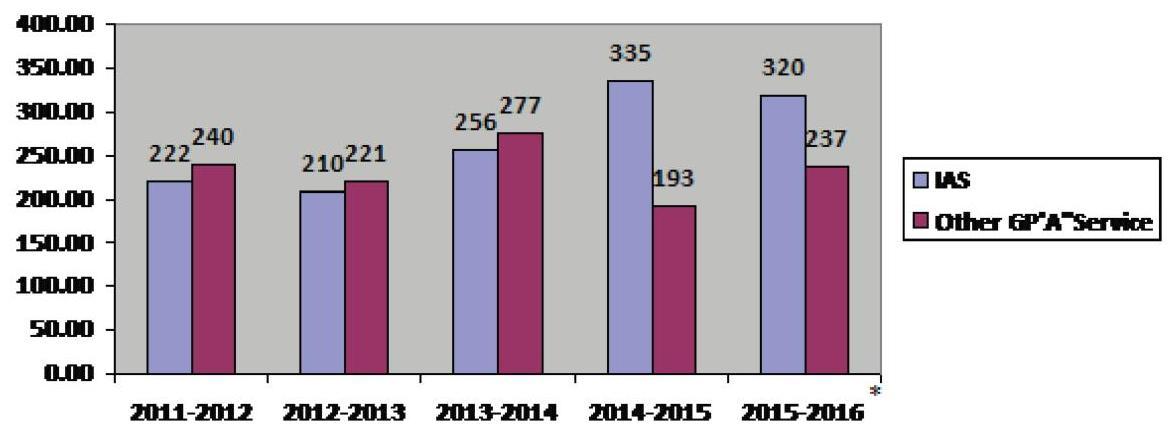
- (Up to 31-12-15)
CENTRAL DEPUTATION RESERVE
6.7 The office of the Establishment Officer in the Department of Personnel \& Training maintains an electronic database of the IAS officers \& Group ‘A’ officers working at the Centre under the Central Staffing Scheme. These records are maintained on the basis of orders/ letters/notifications issued by the DOPT, various Central Ministries/Departments and the State Governments. The maintenance/updation of this database is significant, as it helps in providing readily available digitized information in respect of all officers and also processing of cases for
foreign appointments/assignments and training etc. This database is being used for culling out names of officers possessing domain experience in a particular sector in order to make appointments at the Centre.
The Central Deputation Reserve statement in respect of Indian Administrative Service summarizes the state wise number of officers that are on central deputation vis a vis the sanctioned strength as well as the actual strength. It also gives out the level wise number of officers presently on central deputation from each cadre.
CENTRAL DEPUTATION RESERVE FIGURES AS ON 01/01/2016
| Sl. No. |
Cadre | Total Authorized Strength |
Central Deputation Reserve |
Actual Strength |
Proportionate CDR (4)x(5)/ (3) |
No. of Officers at Centre |
Percentage of Proportionate CDR utilization |
Col. 7 as Percentage of Col. 4 |
Col. 7 X 100 Col. 8 |
|---|---|---|---|---|---|---|---|---|---|
| 1 | 2 | 3 | 4 | 5 | 6 | 7 | 8 | 9 | 10 |
| 1 | AGMUT | 337 | 73 | 284 | 61 | 41 | 67 | 56 | 61 |
| 2 | Andhra Pradesh | 211 | 46 | 177 | 38 | 19 | 50 | 41 | 38 |
| 3 | Assam Meghalaya | 263 | 57 | 216 | 46 | 37 | 80 | 64 | 46 |
| 4 | Bihar | 342 | 74 | 217 | 46 | 44 | 95 | 59 | 46 |
| 5 | Chhattisgarh | 78 | 38 | 137 | 29 | 5 | 17 | 13 | 29 |
| 6 | Gujarat | 297 | 64 | 214 | 46 | 19 | 41 | 29 | 46 |
| 7 | Haryana | 205 | 44 | 159 | 34 | 20 | 58 | 45 | 34 |
| 8 | Himachal Pradesh |
147 | 32 | 110 | 23 | 24 | 104 | 75 | 23 |
| 9 | Jammu & Kashmir | 137 | 30 | 101 | 22 | 11 | 50 | 36 | 22 |
| 10 | Jharkhand | 208 | 45 | 151 | 32 | 10 | 31 | 22 | 32 |
| 11 | Karnataka | 314 | 68 | 224 | 48 | 22 | 45 | 32 | 48 |
| 12 | Kerala | 231 | 50 | 161 | 34 | 45 | 132 | 90 | 34 |
| 13 | Madhya Pradesh | 417 | 90 | 329 | 71 | 30 | 42 | 33 | 71 |
| 14 | Maharashtra | 361 | 78 | 295 | 63 | 23 | 36 | 29 | 63 |
| 15 | Manipur | 206 | 45 | 84 | 18 | 15 | 83 | 33 | 18 |
| 16 | Nagaland | 91 | 20 | 65 | 14 | 8 | 57 | 40 | 14 |
| 17 | Orissa | 237 | 51 | 187 | 40 | 28 | 70 | 54 | 40 |
| 18 | Punjab | 221 | 48 | 183 | 39 | 22 | 56 | 45 | 39 |
| 19 | Rajasthan | 296 | 64 | 218 | 47 | 26 | 55 | 40 | 47 |
| 20 | Sikkim | 48 | 10 | 35 | 7 | 5 | 71 | 50 | 7 |
| 21 | Tamil Nadu | 376 | 81 | 286 | 61 | 32 | 52 | 39 | 61 |
| 22 | Telangana | 163 | 35 | 129 | 27 | 14 | 51 | 40 | 27 |
| 23 | Tripura | 206 | 45 | 72 | 15 | 12 | 80 | 26 | 15 |
| 24 | Uttar Pradesh | 621 | 134 | 487 | 105 | 77 | 73 | 57 | 105 |
| 25 | Uttarakhand | 120 | 26 | 92 | 19 | 12 | 63 | 46 | 19 |
| 26 | West Bengal | 359 | 78 | 255 | 55 | 16 | 29 | 20 | 55 |
| Total | 6592 | 1426 | 4868 | 1040 | 617 | 61 | 43 | 39 |
Figures in Column $3 \& 4$ as per AIS Division
# Adjusted percentage of Utilization in relation to the ratio of CDR with the number of officers in position.
6.9 In addition to the appointments under the Central Staffing Scheme, a total number of 287 appointments as Chairman/ CMDs/MDs/ Deputy Governor/Chairman/Vice Chairman/ Members/Executive Directors/Officers Employee Directors/Workmen Employee Directors/ Functional Directors/ Non Official Director were made on the Boards of Public Sector
Undertakings and Banks/Financial Institutions during the period 1.01.2015 to 31.12.2015. During the same period, 154 appointments were made at the level of Chairman/Financial Commissioner/General Managers equivalent/ Members/Additional Members/ Director General in the Railway Board/Zonal Railways/RCT and Promotion/empanelment was carried out for
appointments to Higher Administrative Grade in Rs. 67,000-79,000/- and Rs. 75,500-80,000/-to various Group ‘A’ Services under the Ministry of Railways.
NUMBER OF APPOINTMENTS OF CHAIRMAN-CUM-MANAGING DIRECTOR/ MANAGING DIRECTOR ETC IN PSUs/BANKs
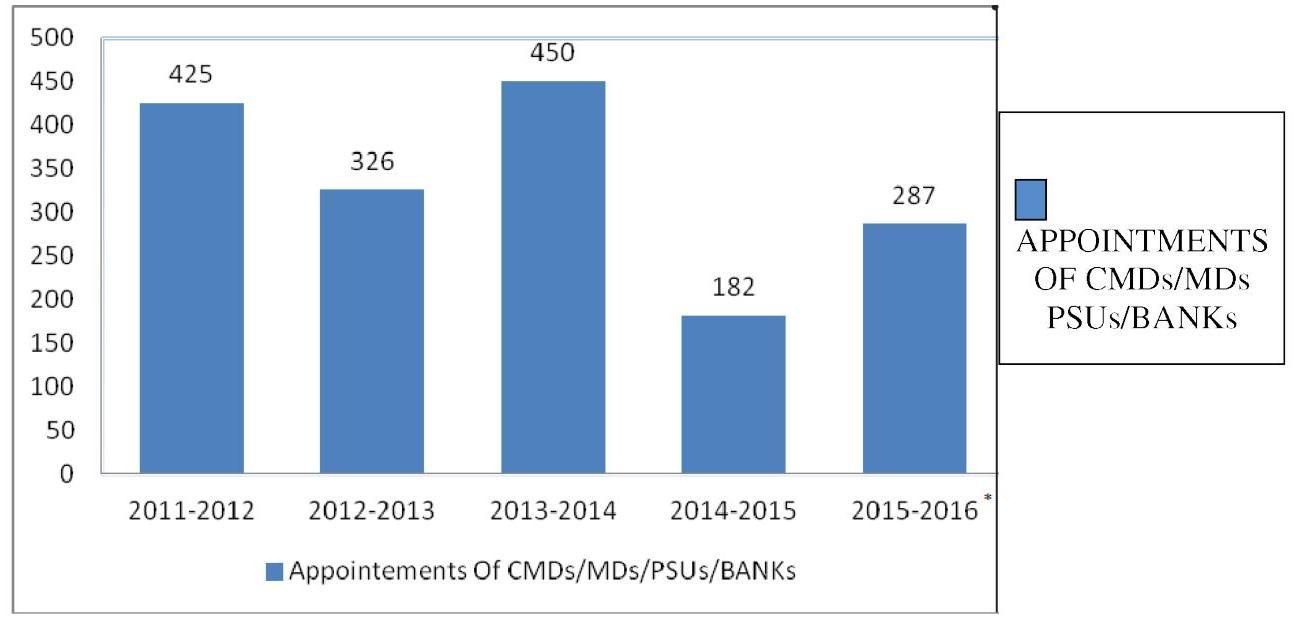
*(Up to 31/12/2015)
6.10 Besides, 296 Officers were also approved during the above period for additional charge/ current charge/extension of tenure/non-extension of tenure/ad-hoc/rejection/termination of service of GM/DG/VC/CMDs/MDs, Functional Directors, Non-Official Directors in PSUs/ Banks/Financial Institutions, and the Ministry of Railways.
6.11 During this period 224 Member/Chairman/ Chief Executive Officer/Advisor were approved in various Autonomous Bodies, Administrative Tribunals, Labour Courts, Regulatory Bodies.
6.12 A total of 2252 officers were approved for appointment, promotion, empanelment, deputation etc. to posts of and above the level of Joint Secretary in various organized Central Services which are not included in the Central Staffing Scheme. Out of these161 are women.
NUMBER OF OFFICERS ON CENTRAL DEPUTATION AS ON 01/01/2016
| Designation | Number of Officers |
|---|---|
| Secretary level and equivalent |
111 |
| Additional Secretary level and equivalent |
109 |
| Joint Secretary level and equivalent |
452 |
| Director level and equivalent |
509 |
| Deputy Secretary level and equivalent |
122 |
6.13 During the year 2015 (i.e. from 01/01/2015 to 31/12/2015), the Election Commission of India has asked for nomination of 500 IAS officers for appointment as General Observers for Elections
to the State Legislative Assembly of Bihar and number of bye-elections in various States during the second half of calendar year 2015. Accordingly, nomination of 492 officers were sent to Election Commission of India (ECI) for appointment as Observers during the year 2015.
GENDER ISSUES
6.14 To ensure that women officers get adequate representation in the higher echelons of management, attention is paid to their cases during empanelment of officers to JS rank to include women officers.
6.15 A total of 104 women officers were appointed under Central Staffing Scheme during
the period from 1/1/2015 to 31/12/2015. A total of 161 women officers were appointed at Secretary/ Addl Secy/ Joint Secy level in various organized Central Services, which are not included in the Central Staffing Scheme. Out of these 21 women officers were appointed as Member/Chairperson/ Vice Chairperson.
6.16 A total of 34 female officers were approved during the above period for appointments/ holding additional current charge/Extension of tenure /service as CMDs/MDs, Executive Directors, Functional Directors, Non-official Directors in PSUs/Banks, Financial Institutions, Railway Claim Tribunal (Indian Railways).
6.17 Details of appointments approved by the ACC
| Month | Member/ Chairman/ CEO/ Advisor |
JS level $(37,400-$ $67,000)$ |
Additional Secretary & above level $(67,000-$ $79,000)$ |
Secretary Level $(80,000 /-)$ |
Total Number of Officers Approved |
Women Officers out Of Col (E) |
Women Member/ Chairman/ Vice Chairperson out Of Col (E) |
|---|---|---|---|---|---|---|---|
| (A) | (B) | (C) | (D) | (E) | (F) | (G) | |
| Jan, 15 | 3 | 21 | 353 | 8 | 385 | 11 | 0 |
| Feb, 15 | 24 | 43 | 25 | 4 | 96 | 3 | 1 |
| Mar, 15 | 28 | 220 | 17 | 2 | 267 | 6 | 2 |
| Apr, 15 | 39 | 8 | 76 | 0 | 123 | 10 | 5 |
| May, 15 | 13 | 69 | 59 | 6 | 147 | 17 | 4 |
| June, 15 | 6 | 61 | 25 | 36 | 128 | 13 | 0 |
| July, 15 | 30 | 221 | 14 | 1 | 266 | 24 | 3 |
| Aug, 15 | 16 | 76 | 44 | 12 | 148 | 19 | 1 |
| Sep, 15 | 2 | 294 | 18 | 12 | 326 | 34 | 0 |
| Oct, 15 | 23 | 65 | 75 | 13 | 176 | 10 | 1 |
| Nov, 15 | 17 | 52 | 22 | 0 | 91 | 5 | 1 |
| Dec, 15 | 23 | 60 | 14 | 2 | 99 | 9 | 3 |
| Total | 224 | 1190 | 742 | 96 | 2252 | 161 | 21 |
ELECTION OBSERVERS
6.18 During the year 2015 (i.e. from 01.01.2015 to 31.12.2015), the Election Commission of India had asked for nomination of 500 IAS officers for appointment as General Observers for Elections to the State Legislative Assembly of Bihar and a number of bye-elections in various states during the second half of calendar year 2015. Accordingly, nomination of 492 officers were sent to Election Commission of India for appointment as Observers during the year 2015.
| PSUs/Banks | Indian Railways | Proposals other than regular appointments | Total |
|---|---|---|---|
| Appointments as Chairman/ CMDs/ MDs/Deputy Governor/ Chairman/ Vice Chairman/Members/ Executive Directors/Officers Employee Directors/ Workmen Employee Directors/Functional Directors/Non-Official Director made on the Boards of Public Sector Undertakings and Banks/ Financial Institutions | Chairman / Financial Commissioner / General Managers / equivalent Members/Additional Members/ Director General in the Railway Board / Zonal Railways / RCT and promotion/ empanelment was carried out for appointments to Higher Administrative Grade in Rs.67,000-79,000/- and Rs.75,500-80,000/- to various Group ‘A’ Services under the Ministry of Railways | Additional charge / current charge / extension of tenure / non-extension of tenure / ad-hoc / rejection / termination of services of GM/ DG/VC/CMDs/MDs, Functional Directors, Non-official Directors in the PSUs/Banks/ Financial Institutions and the Ministry of Railways | |
| 287 | 154 | 296 | $737^{a}$ |
Chapter
TRAINING POLICY AND PROGRAMMES
Mandate
7.0 The Training Division of the Department of Personnel and Training is the nodal agency for training of government functionaries and is primarily responsible for formulating policies with regard to training. It also implements certain components of training directly. In the implementation of its mandate, the Division has set the following objectives:
- Administering Policy matters in training
- Identification of functional areas of training
- Designing and implementing training programs for officers involved in the priority development sectors
- Development of trainers and training capability
7.1 The ultimate goal of the Training Division is to attain “Training for All” which means that training would be imparted to all rungs of Civil Services starting from the lowest and cuttingedge to the highest in policy making.
Major Activities
1) In-service Training of IAS Officers
2) Mid Career Training of IAS Officers
3) Domestic Funding of Foreign Training
4) Post Graduate Programmes in Public Policy
5) Training Support
6) Intensive Training Programme
7) Augmentation of the Capacity of training institutions
8) Distance/E-learning Initiatives in Training.
9) E-governance initiatives.
Long-Term Domestic Post Graduate programmes in Public Policy and Management
7.2 These programmes were envisaged to enhance the competence of Mid-Career Civil Servants in Public Policy and Management by –
(i) Broadening awareness of the latest trends in policy approaches,
(ii) Developing technical, analytical and leadership skills for public policy,
(iii) Providing opportunity in specialization and
(iv) Exposing them to alternative systems of public management in other countries.
7.3 At present, IIM Bangalore, MDI Gurgaon and TERI University, New Delhi are offering these programmes. In order to provide international policy perspective to the participants, each programme has incorporated an international component of 2 weeks in association with reputed international institutes. In addition to the above programmes, one year “Management Programme in Public Policy” at ISB’s Hyderabad/ Mohali campuses was launched during the current financial year. This programme is entirely a domestic long term programme without any international component. As per policy decision, it has been decided from current year onwards that the nominated Officers of the Long term Domestic Programmes would develop a Policy Paper on the issue to be identified in consultation with their Ministries/Department/ State Government etc. where they are presently working. This policy paper would be submitted by the officer to their respective Ministries/ Department/State Government etc. at the end of the programme for implementation.
Mid-Career Interaction between Armed Forces and Civil Services Officers
7.4 Mid-Career interactions between Armed Forces and Civil Services Officers are being organized at the Central Training Institutes/State Administrative Training Institutes and Defence Institutions in various parts of the country with an objective to benefit both the Armed Forces and Civil Services Officers by way of mutual learning from each other’s strength and also by imbibing the best points of each other’s work culture, ethos and customs. This, in the long run, is expected to help the participating officers to combat future challenges to national security in a better manner.
During the current financial year 2015-16, 6 programmes have been planned on themes like Infrastructure development in border areas, Internal Security Challenges before India-Left Wing Extremism and the Bureaucracy-Security interface, Drug Trafficking, Challenges to National Security Synergizing Efforts of Various Agencies at op level, Low Intensity Conflict Operations; Employment of Air Power and Coastal Security of the Western Seaboard.
Capacity Building Programmes for State Civil/Secretariat Service Officers of North Eastern Region
7.5 DoP&T has proposed to hold one Capacity Building Training Programme of two weeks’ duration for the State Civil Services Officers of North Eastern Region at HCM RIPA-Jaipur. Another Capacity Building Training Programme for State Secretariat Service Officers of Assam was organised at ISTM New Delhi during 07 December to 18 December, 2015 which was attended by 25 Participants. The objectives of these programmes are capacity building, personality development and sensitization to national and developmental
issues. The programme also covers inputs on Good Governance, Public Service Delivery, Project Appraisal & Management and Public Private Partnership.
Training Support
Thematic Training Programmes: STATE CATEGORY TRAINING PROGRAMME
7.6 Under the scheme of “Training for All”, support is provided to State Administrative Training Institutions (ATIs) by way of sponsoring training programmes in the areas accorded priority by the Central Government. The Training Programmes conducted by the State ATIs are designed to develop management skills and knowledge in different areas for senior and middle level officers of State Govt./ State Public Sector Undertakings and State autonomous bodies. These training courses are also meant to sensitize the officers to new and important issues facing our society. The courses are also being conducted at District and Sub District Centres of the State ATIs. These courses cover a large variety of subjects under broad thematic groups.
During the year 2015-16, about 778 such shortterm courses have been sponsored at various State ATIs on subjects such as Computer \& IT, Human Rights, Leadership \& Team Building, Court Procedures, Office Procedures, Audit \& Budget, Women Empowerment, Child Development, Consumer Rights, Role of NGOs, Public Private Partnership, Labour Law, Panchayati Raj, Road Safety, Right to Information, Establishment Rules, Gender Issues, Disability Issues, Minority Issues, Ethics \& Values in Governance, Decentralized Planning, Disaster Management, Financial Management, E-Governance, Cyber Security, Environment Issues etc. As on January 31, 2016, out of 778 sponsored courses, 624 courses have
actually been conducted and more than 16469 participants have been trained under this Scheme.
TRAINER DEVELOPMENT PROGRAMME
7.7 Recognizing the importance of trainers in the training function, Training Division started the Trainer Development Programme in the early 1990s. Initially, faculty members of various training institutions were developed as Master Trainers and Recognized Trainers of various “Training of Trainers (ToT)” packages in collaboration with the Thames Valley University of U.K. Over a period of time, indigenous mechanisms were evolved for developing a cadre of professional trainers and resource persons in the country to create a cascading and multiplier effect. The programme has gone a long way in embedding the Systematic Approach to Training (SAT) into the process of designing and imparting effective training to government officials.
7.8 Currently, the following ToT programmes are sponsored under Trainer Development Programme at various training institutions across the country:
- Training Needs Analysis (TNA)
- Design of Training (DOT)
- Direct Trainer Skills (DTS)
- Evaluation of Training (EoT)
- Management of Training (MoT)
- Experiential Learning Tools (ELT)
- Mentoring Skills
- Facilitation Skills
- Introduction to SAT courses
- National Training Policy
7.9 The Department has developed a pool of 57 Master Trainers and 326 Recognized Trainers in different packages under this Scheme, who are called upon to conduct TDP courses. DOPT has sponsored 105 TDP courses on various packages during the current financial year 2015-16.
INDUCTION TRAINING PROGRAMME
7.10 A new scheme of Induction Training Programme for the newly recruited cutting edge level State Government functionaries was launched by the Department of Personnel & Training (DOPT) on pilot basis in 15 districts in the three states of Jammu \& Kashmir, Maharashtra and Tamil Nadu during financial year 2014-15. The objective of the induction training programme is to develop generic and domain specific competencies in cutting edge level functionaries for strengthening capabilities to improve the public service delivery mechanism. This training programme will play a very important role in preparing the new entrants in the Government for fulfilling their responsibilities towards the nation and the citizens effectively and efficiently.
After successful implementation of the pilot phase, the Scheme has been launched in the 103 districts of 21 states covering 7010 newly recruited State Government frontline functionaries. To validate and familiarize the trainers with the design and content of the module of 12 days Induction Training Programme, Six ToT workshops of 2 day duration was held for the selected trainers regionwise at various State ATIs. After that, scheme is rolling out successfully in various states.
DoPT-UNDP Project ‘Strengthening Human Resource Management of Civil Service’ (SHRM)
7.11 SHRM project is a five year partnership between UNDP and Ministry of Personnel, Public Grievances and Pensions. The main Outcomes of the project are shift towards competency-based human resource management of civil services; strengthening capacities of LBSNAA, NCGG, State ATIs and other Govt. Training Institutions; and development and piloting of Innovative training tools and methodologies.
7.12 After the development of Competency Dictionary for Civil Services in 2013, as a further step towards competency-based approach, DoPT had conducted a pilot on Competency Mapping in two Departments, namely DoPT and the Ministry of Corporate Affairs (MCA) and one cadre i.e. Central Secretarial Services (CSS). In 2015 the pilot has moved further to its next step of Assessment and Development Centres for a select group of 80 officers from DoPT and CSS. The idea is to use the Assessment and Development centres for identifying training needs of the select officers.
As an effort to build capacities of civil servants through the initiative on National Pool of Trainers has been taken further in 2015. The initiative focuses on developing modules and National Pool of Trainers on four thematic areas of Leadership Skills, Ethics, Gender and Urban Planning and Management. The objective is to promote a high quality module developed by reputed institutes and delivered by scientifically trained National Facilitators on a pan India basis to ensure better learning of the skills.
7.13 A total of 53 National facilitators have been developed; 19 in Ethics and 27 in Leadership Skills. The uniqueness of the pool of National Facilitators is that it brings with it the skills and experience of retired and serving officers and faculty of ATIs and CTIs. The concept is based on officer teach officer model where trainees don’t only learn from the module but also from the personal experiences and sharing of the facilitators. The methodology is extremely participatory and engrossing so that there is deep impact on the trainees.
These National Facilitators have started conducting training programs at various ATIs and CTIs and the response is very encouraging.
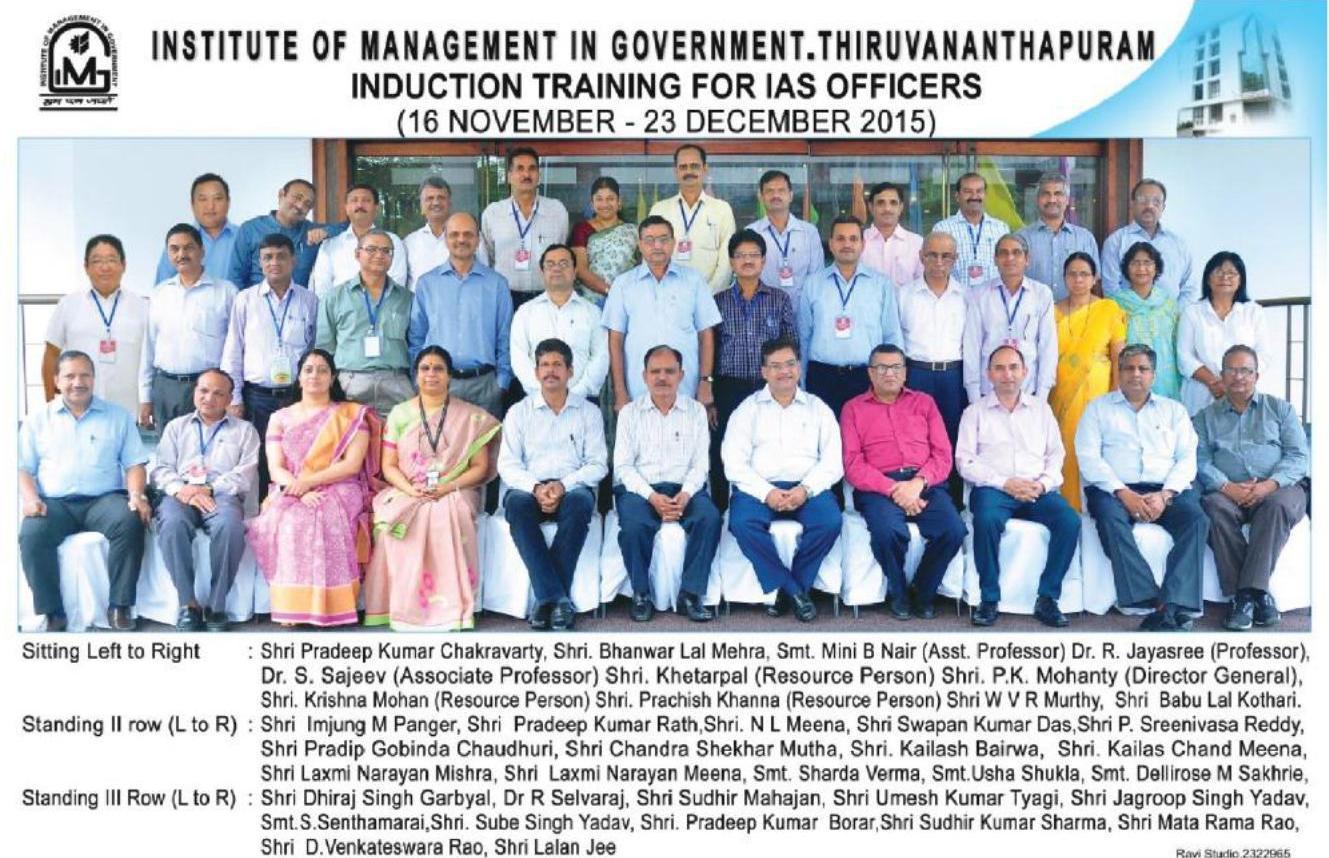
7.14 Effort has also been made to streamline implementation of NTP by creating a Functional Manual for Training Managers. The purpose of this work is to develop competencies of Training Managers in the Ministries/Departments so that they are able to establish training function in the department as envisaged in the National Training Policy; adopt training function to effectively support government initiatives and programmes; provide support and guidance to Ministries in the design and implementation of capacity building schemes; and become facilitators in competency based human resource management.
Learning Resource Center
7.15 National Training Policy- 2012 recommended setting up of a Learning Resource Centre (LRC) for identifying and adapting the leading national and international practices in
the field of training and strengthening of Trainers Development Programme (TDP).
LRC reviewed the existing TDP packages, conducted Focused Group Discussions (FGDs) and workshops for stakeholder consultation and upgraded the Training Need Analysis (TNA) as a blended package. In continuation LRC has reviewed and conducted a stakeholder workshop to upgrade the Design of Training (DOT) module. A core group was set up to review and develope and blended modules on National Training Policy (NTP) and Systematic Approach to Training (SAT). LRC has reviewed and will subsequently undertake strengthening and upgrade of all the TDP packages namely DTS, DTS II/ELT, facilitation, Mentoring, EOT and MOT.
LRC have been actively involved in supporting DoPT on various initiatives related to training and development. The content module and
Training of Trainer programme was designed for the Induction Training Programme (ITP) and 10 regional workshops were conducted for master Trainers of 21 states. LRC has also been instrumental in creating a resource bank of NGOs by visiting State ATI recommended NGOs, which can offer immersion programmes for government functionaries.
LRC has actively supported DoPT in i) developing the concept note, workshop framework, website content, planning and implementation of the National Symposium on Excellence in training; ii) Organizing and conducting NCGG workshops for simplification of forms and processes by various ministries /departments.
LRC also assisted DoPT to design and conduct the Retreat for Senior DoPT officials at Panchgani.
National Centre for Good Governance
7.16 National Centre for Good Governance (NCGG) was set up by Government of India in February, 2014. It was formally inaugurated by the then Minister of State in the Ministry of Personnel, Public Grievances and Pensions and Prime Minister’s Office on $24^{\text {th }}$ February 2014.
Mandate of NCGG
7.17 National Centre for Good Governance NCGG to be the apex think tank of the country in guiding and implementing good Governance reforms. It is a high level institute for research and training to deal with the entire gamut of governance issues-from national to state to the local level and in sectors across the Government. The NCGG will be a national level multi-disciplinary institute devoted to action research and analytical studies for supporting good governance strategy, action plan and their implementation with country wide jurisdiction.
It is envisaged that NCGG would be an institute of excellence that works with the Government and facilitates exchange of ideas between India and other countries.
The NCGG would work towards resolution of key issues in Governance, analyse policy and programme implementation, develop action plans, support governance reforms and help in developing synergy across various sectors and Ministries/Departments. The expected outcome of NCGG would be in the form of research papers, best practices on Governance reforms, policy analysis and options would provide the necessary direction, guidance and capacity building inputs on Governance and management issues to the Central and State Government organizations, Central Training Institutes and State Administrative Training Institutes.
Governing Structure of NCGG
7.18 NCGG is an autonomous institution registered as a Society under the Societies Registration Act 1860. A Governing Body with Cabinet Secretary as the Chairman has been constituted for NCGG. The affairs of the Society are managed under the overall superintendence, direction and control of the Governing Body, having 21 Members. NCGG also have 12 members Management Committee with Secretary, Department of Personnel & Training (DOPT) as the Chairperson. NCGG will have a 3 tier structure. The first tier will consist of the internal faculty and Staff, the second of outside domestic experts and the third of international consultants. Dr. Gyanendra D. Badgaiyan has been appointed as Director General of NCGG.
NCGG is headquartered at New Delhi with a branch office in Mussoorie.
Activities of NCGG
7.19 The National Centre for Good Governance (NCGG) along with the IBA-CLE Chair, National Law School of India University (NLSIU), Bengaluru, Menon Institute of Legal Advocacy Training, Trivandrum and National Law University (NLU), Delhi organized Two Day National Colloquium on ‘Combating Corruption and Promoting Good Governance’ on $21^{\text {st }}$ and $22^{\text {nd }}$ March, 2015 at the National Law University, Delhi. The aim of this colloquium was to 1) understand the impact of corruption on Constitutional Governance, Rule of Law, and Socio-Economic Development; 2) evaluate the existing legal and administrative framework for fighting corruption; 3) examine the prospects of strategies for prevention of corruption; 4) strengthen the anti-corruption machinery by mounting an effective training programme for
civil servants, police, prosecution, judiciary and others; 5) suggest reforms and establish a network of institutions and individuals interested in promoting good governance practices.
The National Centre for Good Governance (NCGG) also organized a National Workshop on Citizen Centric Governance on 12th September, 2015 at Vigyan Bhawan, New Delhi in association with Institute of Development & Communication, Chandigarh and the Department of Industrial Policy and Promotion, Government of India, New Delhi.
Another one-day National workshop was organized by NCGG in association with Ministry of Labour \& Employment, Govt. of India and Ministry of Rural Development, Govt. of India on18th December, 2015 in Vigyan Bhawan Annexe, New Delhi on simplification of forms and processes.
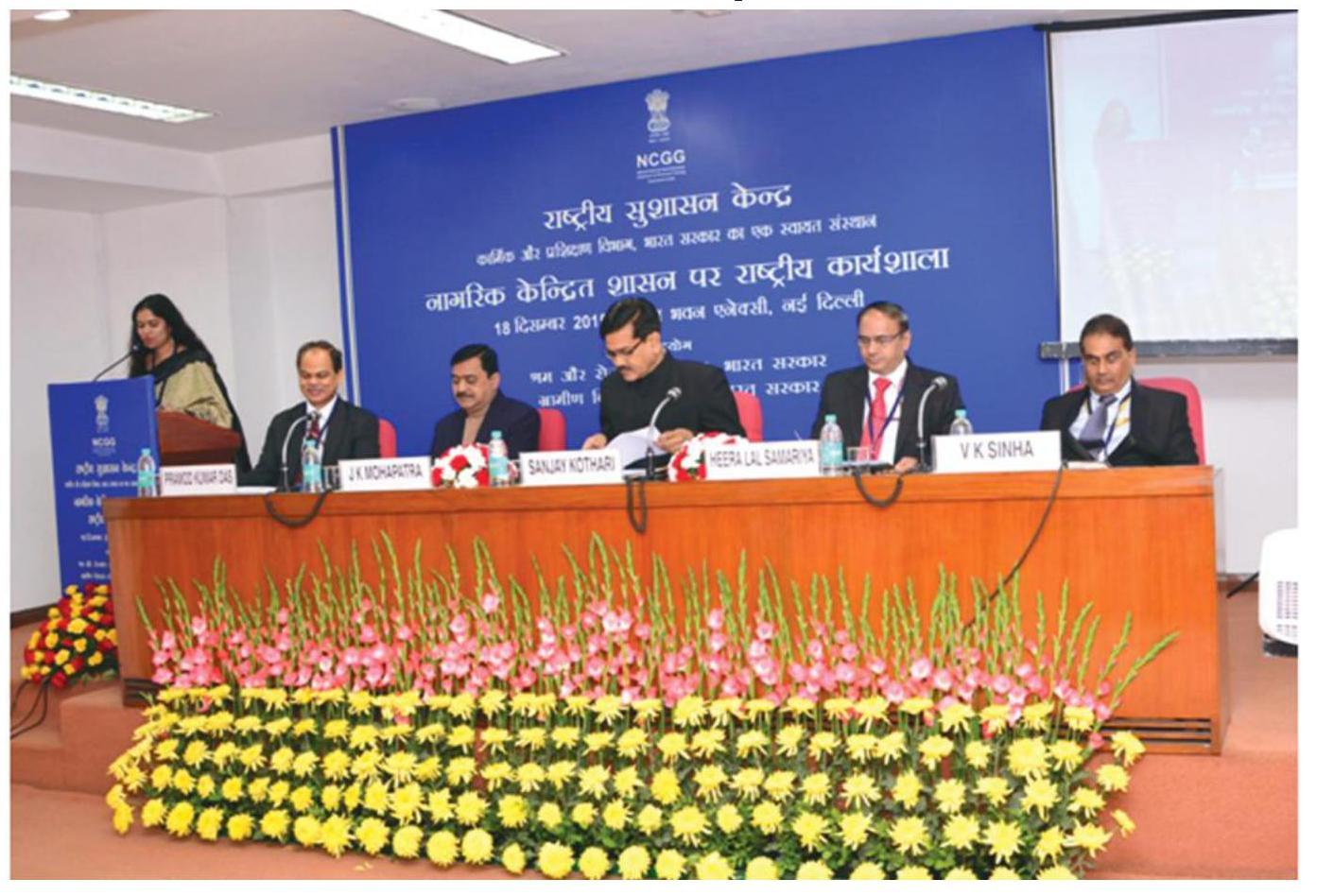
7.20 Secretary, DoPT along with team of officers visited ASH Center for Democratic Governance and Innovation at Harvard Kennedy School, Harvard University. This Center fosters creative and effective problems solving in government and focuses attention on many of the most pressing public needs. It focuses on collaborative research, education and public discussion to advance excellence and innovation in governance and public policy. National Centre for Good Governance (NCGG) is considering ways of collaborating with the ASH Centre in many areas for achieving its objective.
Training Programmes
Overseas Training Programmes
7.21 Department of Personnel and Training has been nominating officers for training programs abroad. In the past, these programs were funded by bilateral or multilateral assistance. However, over the years, this assistance had come down. Keeping in view the importance and benefits of providing international exposure to the officers, a scheme of Domestic Funding of Foreign Training (DFFT) was started in 2001. This covers both long term and short-term training in various universities/institutes in several countries. A scheme of “Partial Funding of Foreign Study” was also started in 2002-03 as another component of the scheme of DFFT. Under this scheme, Government of India provides limited financial assistance to such officers who secure admission on their own in reputed universities and in programs relevant to their present or future job context.
During the financial year (upto 30.11.2015), 35 officers were nominated for under long term foreign training programmes, 228 officers were nominated under short term foreign training programmes. Further, 11 officers have been granted partial funding assistance under the DFFT Scheme.
Scheme of scholarship by Private Foundation Trust
7.22 A scheme for scholarship offered by private foundation/trust in top 10 ranked universities as per THE world university ranking for officers of all the three All India Services has been approved by the Government. Funding under this scheme is available for pursuing programmes in Master in Public Policy/Public Administration/ International Development and Master in Business Administration, subject to the eligibility conditions.
Under this scheme, Desai Sethi Family Foundation, has offered ‘Desai’ Sethi Family Foundation Fellowship. On this, two fellowships/scholarships are available for officers belonging to Indian Administrative Service, Indian Foreign Service, Indian Police Service and Indian Forest Service for pursuing a 2 year Masters programme in Public Policy/Public Administration / International Development at Harvard Kennedy School, Harvard University. The finding is US$ 50,000 per officer per year. The guidelie on the fellowship has been uploadded on the website of this Department
One-week In-Service Training (IST) Programs for Officers of All India Services and for those working under Central Staffing Scheme- Sponsored by Department of Personnel & Training
7.23 The Training Division sponsors ‘InService Training Programmes of one-week duration’ in various ATIs/CTIs/Other Premier Training Institutes in the country by inviting proposals from them on relevant themes. During current year (2015-16), 13 programmes have been offered at 8 selected institutions. These programmes provide select middle to higher management level officers an opportunity to update their skills in area of their own choicein a sector they are currently working in, or in
an area they expect to work in near future, or in a theme they feel they should specialize. These programs also provide a valuable platform for horizontal and vertical knowledge sharing.
7.24 The primary objective of the IST program: to sensitize the participants to national concerns and the values enshrined in the Constitution; to provide for exchange of experience and adequate discussion on issues of values, ethics and attitudes; to make the participants more confident to face problems in their work areas and attempt solutions; and to train the participants to look at problems in an integrated manner and develop a systems approach.
7.25 In past, these programs have been offered in diverse and broad thematic area: such as governance issues; sector specific coverage of agriculture, education, rural development, urban development, social policy; climate change, Natural Resource Management; ethics, corruption; e-governance; fiscal policy and macroeconomic management, WTO and trade issues; PPP, Project Appraisal, Environment Impact Assessment, Project Analysis; Public Policy making, Decision science, and quantitative methods.
In-House Training Progamme
7.26 With a view to build the capacity of employees and as per the direction of Hon’ble Prime Minister, weekly One Hour Training for the officials of DoPT from LDC to Director level on various topics has been started w.e.f. 9.10.2014. Weekly training also includes training of official of CSSS upto the rank of PPS. So far four modules viz. ‘Filing System’, ‘Noting and Drafting’, ‘Gender Sensitization’ and ‘Litigation Management (Handling of Court and CAT Cases)’ have been completed. MTS and Safai Karmachari have also been included for weekly One Training on the module of ‘Gender Sensitization’. Fifth module “Preventive Vigilance” will commence from 10/02/2016.
Training of the DOPT officials on ‘Office Management’ at ISTM / HCM-RIPA, Jaipur
7.27 During 2015-16, DOPT has chalked out five days training programme for the officials of the DOPT from LDC to Under Secretary level. Five days Training programme consists of two days module at ISTM and remaining three days at HCM RIPA, Jaipur or their centre at Udaipur. During the year 125 official in 4 batches ( 1 batch of Under Secretary, 2 batches of Section Officers, 1 batch of LDC to Assistants) have been imparted training on ‘Office Management’ at RIPA, Jaipur.
Advanced Professional Programme in Public Administration (APPPA) At Indian Institute of Public Administration, New Delhi
7.28 The Training Division has been sponsoring a ten-month Advanced Professional Programme in Public Administration (APPPA) at the Indian Institute of Public Administration (IIPA), New Delhi every year since 1975-76.
7.29 The objectives of this programme is to prepare the participants to make a greater contribution to better governance, develop attitudes that focus on citizen services and also to strengthen leadership qualities in the civil service. It provides an opportunity to the participants to analyze major contemporary issues in Governance, learn about recent developments in the social sciences and their application in administration; review their experiences by making a critical analysis of environmental and other factors, apply relevant concepts, skills and techniques relating to policy, behavioral and administrative sciences and to demonstrate their creative and analytical abilities individually and in groups. It also seeks to develop interpersonal skills and sensitiveness to the needs of the people with a view to making administration more responsive and result oriented.
7.30 The course covers classroom studies relating to various facets of administration viz, Social, Political, Economic, Legal and Administrative Systems, Organizational Behavior, Social Science and Research Methods, Operational Research, Information Technology in Management and Financial Management. Participants are also required to conduct rural and urban field studies and prepare a project report and dissertation. They are expected to select an area for specialization relevant to their present and likely future assignments from following fields of study: Advanced Information Technology and MIS, Comparative Development Experience, Project Management, Constitutional Law, Disaster Management, Economics of Regulation,
Inter Governmental Relations, Management Systems, Organizational Needs Analysis, Public Expenditure Management, Public Organizational Theory, TQM, Finance, Personnel, Corporate or Public Sector Management, General Administration, Planning and Rural Development etc.
7.31 This 10 month programme includes three semesters, rural and urban field visits in India and a 10 day foreign study tour. In $40^{\text {th }}$ Programme, the participants visited in two groups to China & Australia and Germany \& Spain. The $41^{\text {st }}$ Programme in the series is being held from July 1, 2015 to April 29, 2016. 43 participants are attending this programme.
Chapter
TRAINING INSTITUTIONS
LAL BAHADUR SHASTRI NATIONAL ACADEMY OF ADMINISTRATION
Introduction
8.0 The Lal Bahadur Shastri National Academy of Administration (LBSNAA), Mussoorie is Government of India’s premier institution for the training of higher civil services in the country. The Academy imparts induction level and inservice training. A common Foundation Course is held for entrants to All India Services and all Group “A” services of the Union. The professional training to regular recruits of the Indian Administrative Service (IAS) and members of the Royal Bhutan Civil Service is conducted after the Foundation Course. The Academy also conducts in-service and Mid-Career Training Program (MCTP) for members of the IAS and Induction Training program for officers promoted to the IAS from State Civil Services, as well as workshops and seminars on various issues in public administration.
8.1 To ensure that the academic curriculum is relevant, it is constantly reviewed and updated through extensive consultations with the representatives of the state governments, the central government and other scholars and practitioners. Given the limitations of conventional classroom lectures, new pedagogical methods have been introduced to deliver training inputs in a more effective manner. Most courses operate on a modular structure whereby relevant themes are
chosen and dealt with in a consolidated fashion to ensure that all aspects relating to them are covered comprehensively.
8.2 In order to promote all-round development of the personality, due emphasis is placed on outdoor and co-curricular events. Physical training, team games and tennis, badminton cross-country running, yoga, horse riding, and adventure sports like river rafting, para-gliding, bungee jumping and rifle shooting are some of the activities that the officer trainees are involved in. Exposure to public speaking, theatre workshops, motor mechanic skills, gardening, photography and music appreciation are some of the co-curricular activities offered to the young administrators.
To nurture the values of integrity, moral courage, empathy and respect for the underprivileged, and freedom from any sectarian prejudices based on religion, region, caste, class or gender, the officer trainees are encouraged to participate in diverse social activities. Various Clubs and Societies have been formed to which the Officer Trainees are elected as office-bearers. They organize and take part in quizzes, debates, poetry competitions and numerous other activities after class hours. This lends a spirit of bonhomie and also promotes esprit de corps.
Induction Training Courses
8.3 The Academy conducts Induction training courses for direct recruits to the IAS and other
senior civil services as well as officers promoted to the IAS.
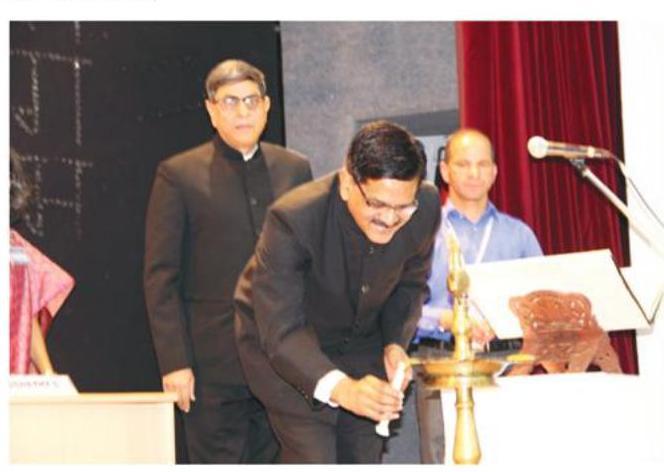
$90^{\text {th }}$ Foundation Course Inauguration by Shri Sanjay Kothari, IAS, Secretary, DoPT
Foundation Course (15 Weeks)
8.4 The Foundation Course is the flagship course of Induction training and is intended for fresh entrant to the All-India Services, i.e. the Indian Administrative Service, the Indian Police Service and the Indian Forest Service, and the various Central Services (Group-A) of the Union. It is a fifteen-week course conducted from September to December every year. The course aims at imparting a basic understanding of the constitutional, political, socio-economic and legal framework of the country; and also fostering greater co-ordination among the members of the different public services by building esprit-de-corps and cultivating an attitude of co-operation and inter-dependence. This year total of 353 Officer Trainees including 12 officers from RBCS/RBFS/ RBPS participated in the Course organised from September 7 to December 18, 2015. The course was inaugurated by the Shri Sanjay Kothari, IAS, Secretary, DoPT and the valedictory programme is graced by Sh . DR Mehta, retired IAS officer and social worker.
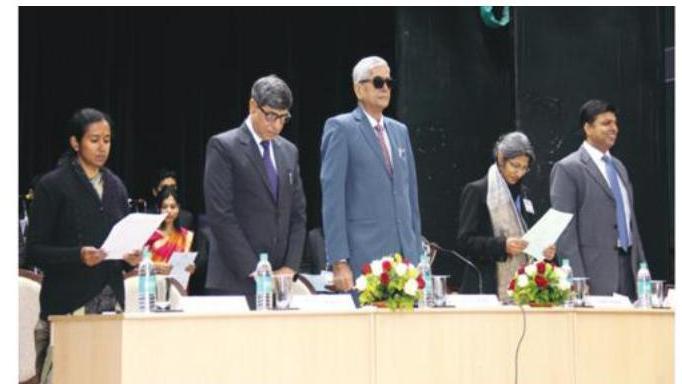
$90^{\text {th }}$ Valedictory programme by Sh. DR Mehta, retired IAS officer and social worker
During the year, two Special Foundation Courses were conducted at MCR HRD Institute, Hyderabad and HIPA, Gurgaon to cater to the backlog of earlier batches.
8.5 The main activities organized during the Foundation Courses were:
- Trekking: The objective of trek is to inculcate the spirit of adventure and to strengthen Esprit de corps in the Officer Trainees. The trek is also a significant learning experience in group dynamics, interpersonal relations, courage, endurance and love and respect for nature.
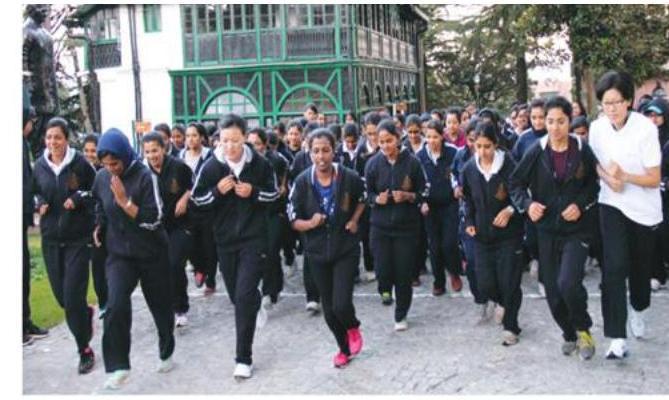
- Village Visit Programme: Officer Trainees spent one week in select villages in Uttar Pradesh and Himachal Pradesh in groups of 4-5. Here they were sensitized to the empirical realities of rural India, through a structured study of a village. A special feature of the village visit this year was organization of “Swachatta Diwas” in each of
the selected villages when the trainees raised awareness about the cleanliness mission of the Government and also undertook cleanliness drives in the villages along with the residents.
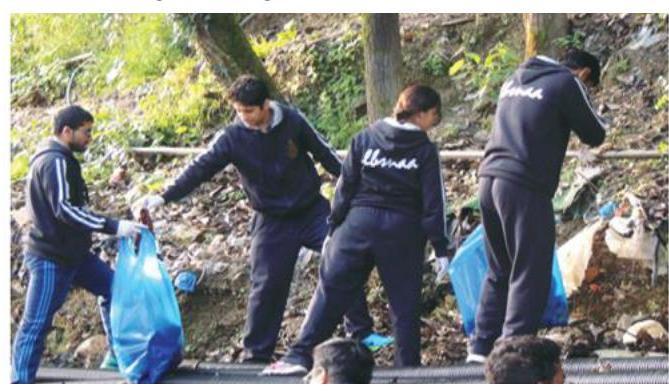
$90^{\text {th }}$ FC Sharamdan
3. Extra-Curricular Activities are conducted in the afternoons and evenings in order to impart skills other than purely academic to the trainees in recognition of the need for an officer to have diverse interests and a well-rounded personality.
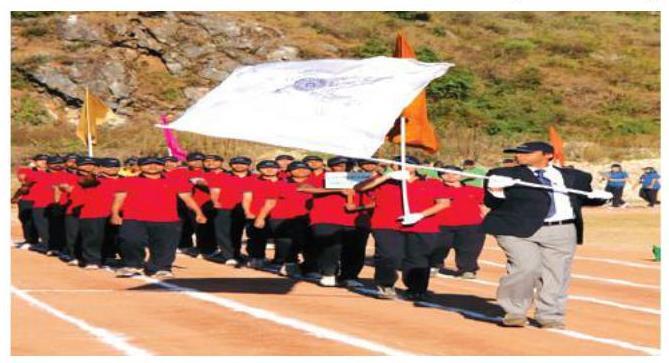
C Atheletic Meet
4. To provide a forum for showcasing the multifarious talents of the officer trainees, various cultural programmes are organized. The A.K. Sinha One Act Play Competition displays the acting skills of the trainees. Apart from these, cultural programmes and India Day were organized to instill in the trainees a sense of the diversity and oneness of the country.
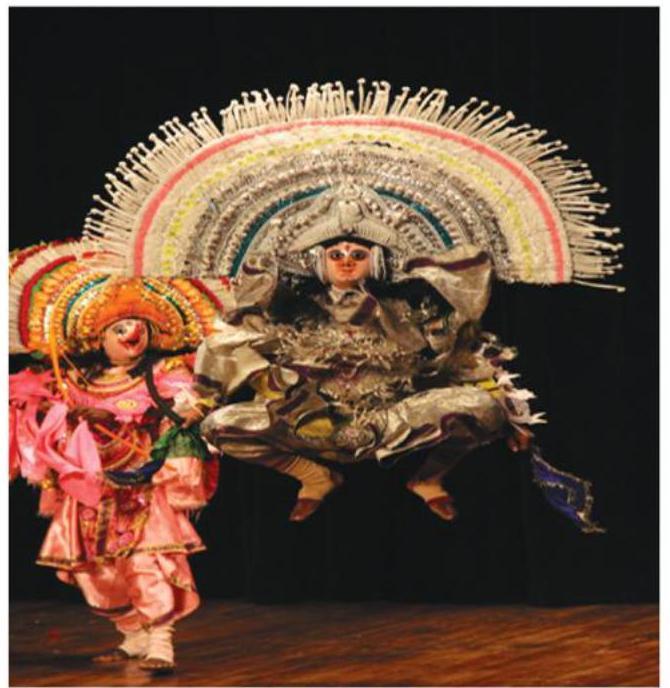
‘Cultural Evening’
5. The trainees themselves highlight the cultural traditions of various parts of the country through exhibitions, cuisine and folk dances, etc.
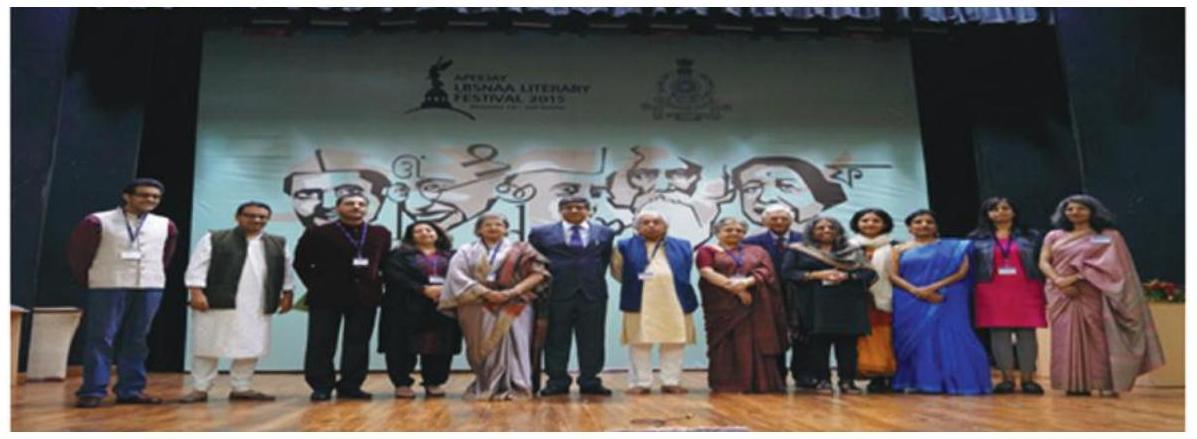
’90 $0^{\text {th }}$ FC Literary Fest’
- A Fete was organized in order to inculcate the spirit of entrepreneurship among the trainees, proceeds of which go to the Society for Social Services.
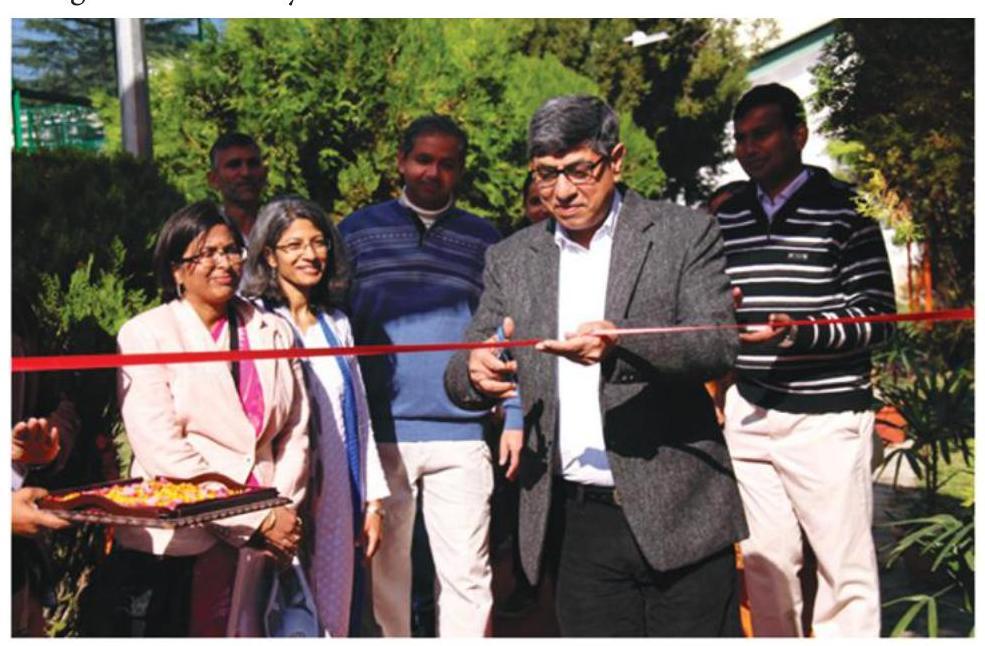
Inaugural $90^{\text {th }}$ FC Fete by Rajeev Kapoor, Director LBSNAA
7. This year several debates were organized under the auspices of the Society for Contemporary Affairs on issues of topical interest.
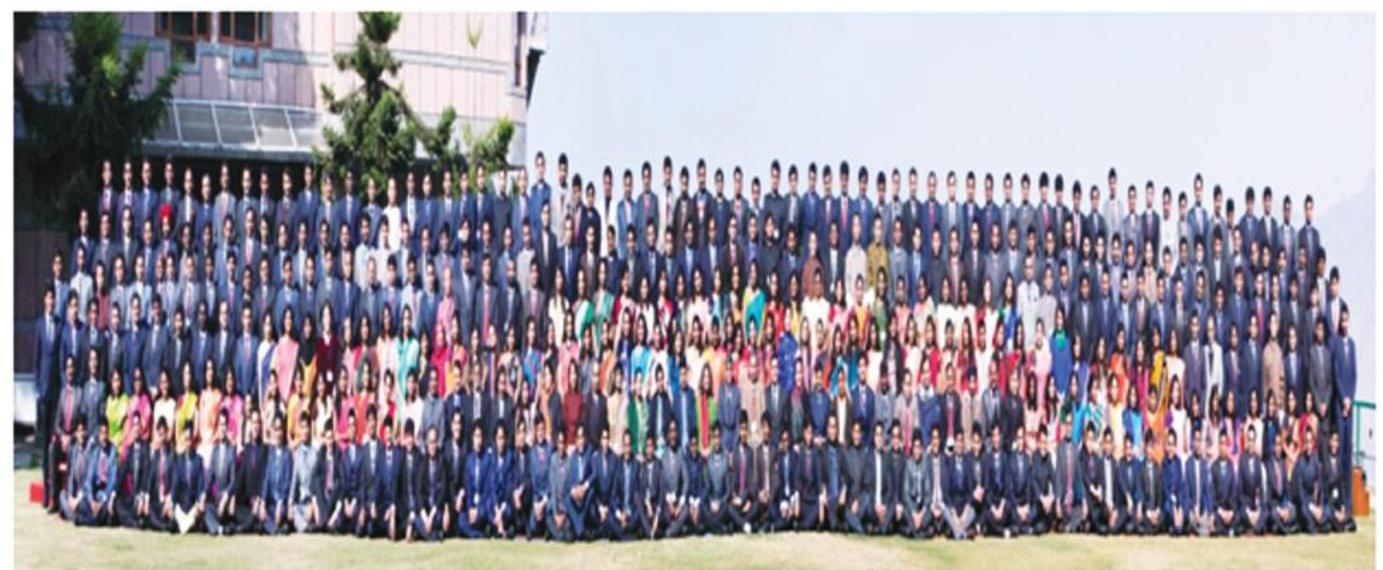
Group Photo $90^{\text {th }}$ Foundation Course 2015
IAS Professional Course Phase-I (26 Weeks)
8.6 The IAS Officer Trainees of the 2014 batch (total 185 including 03 Officers Trainees from Royal Bhutan Civil Service) underwent the IAS Professional Course Phase-I from December 21,
2014 to June 17, 2015. This course aimed at developing professional skills in handling a large range of responsibilities that an officer shoulders within the first ten years of service. Emphasis is laid on understanding public systems and their management, together with a grounding in Public Administration, Law, Economics,
Management and Computer applications. During the first part of Phase-I, the Officer Trainees are sent on a 9 weeks Winter Study Tour (Bharat Darshan) comprising of attachments with the three Armed Forces, Public Sector, Private Sector
Units, Municipal Bodies, Voluntary Agencies, and civil administration in challenging areas, etc. After completion of IAS Phase-I, they were relieved on June 17, 2015 for their District Training of IAS Professional Course Phase-II.
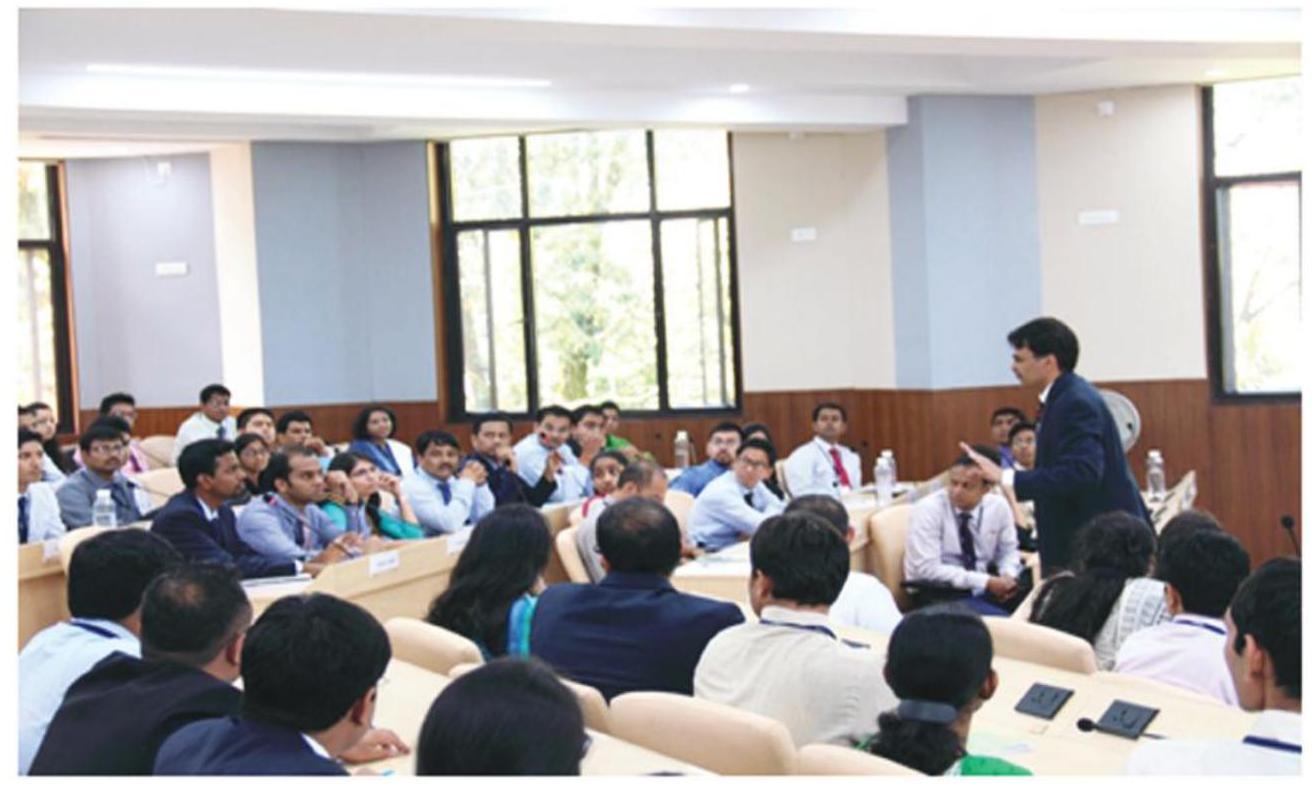
Guest Lecture and interaction at Tagore Hall
District Training (54 Weeks)
8.7 During District Training, the Officer Trainees learn about the various facets of administration at the district level. During this period they are under the direct charge of the District Collector and the State Government. They get an opportunity to obtain first-hand knowledge of the work of the Collector/ District Magistrate and various other institutions in the State government, along with orientation training at the State Administrative Training Institute. Most of the State Governments give them an opportunity of holding independent charge as Tehsildar/ Mamlatdar, Sub Divisional Magistrate, Block Development Officer and/or Executive Officer of a Municipality. The 2014
batch of the IAS will return to the Academy for their second phase of professional training in 2016.
IAS Professional Course Phase-II (8 Weeks)
8.8 While theoretical concepts are sought to be imparted in the Foundation and Phase-I courses, the ground level delivery mechanisms are expected to be imbibed during District Training. Phase-II is a time to debrief and share experience and good practices from the various states of the country. The course content of Phase-II is designed to consolidate the learning and assimilation of the district experience with
the theoretical constructs taught earlier. A total of 176 Officer Trainees of 2013 batch including 03 Officers from Royal Bhutan Civil Services underwent the Phase II course organized from June 29, 2015 to August 22, 2015.
Induction Courses for State Civil Service officers promoted to IAS
8.9 The Academy organizes Induction Training Program for officers promoted to the IAS from the state civil services. The aim of these courses is to update levels of knowledge, skills and information and to provide opportunities for exchange of ideas, views and experiences with people who have developed expertise in different sectors of national development. The underlying focus of the course is to provide the Induction Course participants an all-India perspective. The course, which was earlier of a duration of eight
weeks with about two weeks of exposure visit has now been reduced to six weeks. The $117^{\text {th }}$ edition of the Induction Training Programme had 75 participants from 18 states of India (A.P.; A-M; Bihar; Gujarat; Haryana; H.P.; Karnataka; M.P; Maharashtra; Mizoram; M-T; Orissa; Punjab; Rajasthan; Tamilnadu; U.P.; Uttarakhand; and W.B.) and was held from July 27 to September 4, 2015. The programme aimed at training and sensitizing officers from the state services for the next level of governance and administration. The course included a two-visait Study Tour within India and to Sri Lanka to familiarize participants with successful interventions in various areas of governance. Participants were evaluated by means of a mid-term exam, policy memo and presentations and an overall assessment based upon peer review, discipline and participation in the programme.
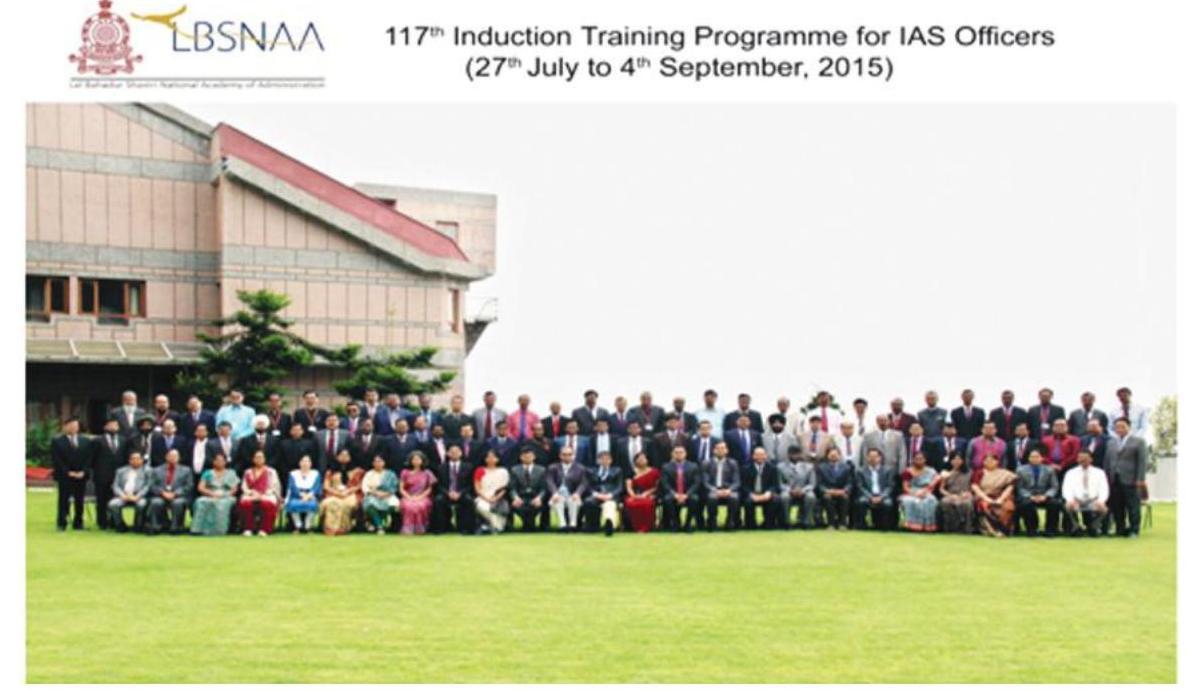
Mid Career Training Programme (MCTP)
8.10 The issue of mandatory and structured mid-career training for IAS Officers was formalized with the introduction of the MidCareer Training Programme (MCTP) in 2007.
The objective of MCTP was to equip officers to handle the next, higher level of responsibilities at certain identified stages of their careers; broadly when they were primarily working in the field
(7-9 years), at the policy formulation stage (1518 years) and inter-sectoral policy formulation and implementation stage (27-28 years). These three stages were named Phase III, IV and V respectively. In the first three-year cycle, these programmes were outsourced by the Ministry to international/ national institutions of repute. However, since 2010, the mandate for the design and delivery of the programme has been devolved by the Government to the Academy. Among the significant highlights of the MCT Programme was the introduction of a structured module in Public Policy in Phase IV delivered in collaboration with the Harvard Kennedy School as part of a Memorandum of Understanding signed with the Evidence for Policy Design, Harvard University. The second novel feature was the introduction of Foreign Study Tour to France and Belgium in collaboration with Sciences Po, a leading international university on social sciences in Paris, France. In Phase V, the Academy introduced the following improvements this year: one, hosting the first week in Delhi to enable interactions with senior leaders of the Government including Hon’ble Prime Minister; two, organizing the Foreign Study Tour thematically to four destinations along with group work on key learnings for India; and three, doing syndicate work on governance issues. The underlying design behind this was to introduce greater rigor in course work and evaluation to
foster better internalization of concepts and practical learning. During the year 2015-16, The Academy conducted the $9^{\text {th }}$ round of Mid-Career Training Programme for the IAS officers for the Seniority batches of 2001 to 2007 for IAS PhaseIII (seven to nine years service) which trained 112 participants, Phase-IV for the seniority batches of 1993 to 2000 (fifteen to twenty years of service) which trained 62 participants and Phase-V for the seniority batches 1984 to 1988 (twenty six to twenty eight years of service) which trained 97 officers. Total number of officers trained in three MCTP courses is 271 , plus 6 residual participants of previous years.
Phase III Course
8.11 Phase III Course aims at preparing IAS Officers of 7-9 years seniority for effectively discharging their roles as implementers of Government programmes in the field as Collectors and Municipal Commissioners and as Heads of Departments or State PSUs. The focus of the program is on Public Service Delivery and Excellence in Execution. The program also includes a short Foreign Study Tour to South Korea in partnership with Korea Development Institute (KDI) to learn their best practices in the field of administration. Originally, Phase-III was organised for 8 weeks but it has been reduced to 7 weeks duration from 2015.
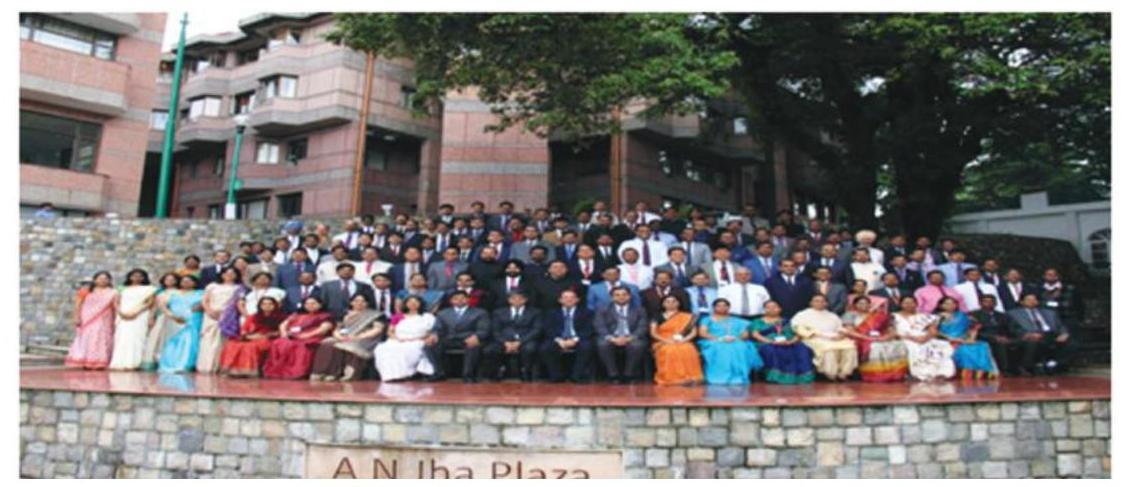
Group Photo Phase III Course
Phase IV Course
8.12 The Phase IV Course targets middle level officers (of 15-18 years seniority) with a thrust on Public policy. Besides enhancing domain knowledge of the participants, especially in the realm of various aspects of public policy, the Course also aims at broadening their perspective
and developing soft skills. Since 2015, the course’s duration has been reduced from 8 to 7 weeks. The Course includes a short Foreign Study Tour to Canada (in partnership with IPAC) and France (in partnership with Sciences Po, Paris) in halfgroups.
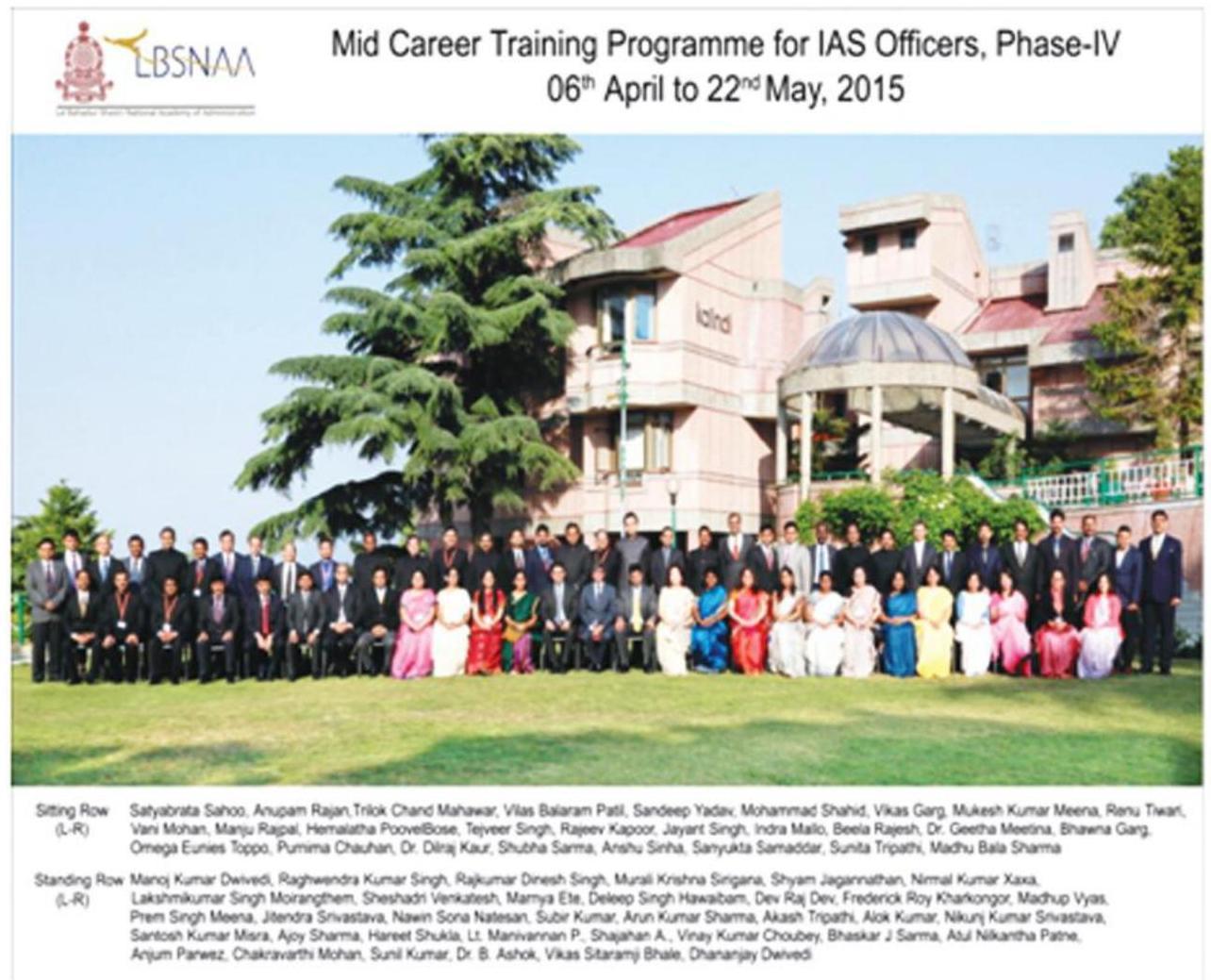
Phase V Course
8.13 The Phase V Course aims at developing strategic leadership skills in senior level IAS Officers (27-28 years seniority) for effective inter-sectoral policy formulation and Strategic Thinking in Government. Like Phase III and IV, its duration has also been reduced this year by
one week, i.e. from 5 to 4 weeks. It includes a one-week Foreign Study Tour in groups of 25 to Australia (on Modernizing Government); China (on Understanding China’s Socio-Economic Development); South Africa (on Urbanization in BRICS); USA (Homeland Security).
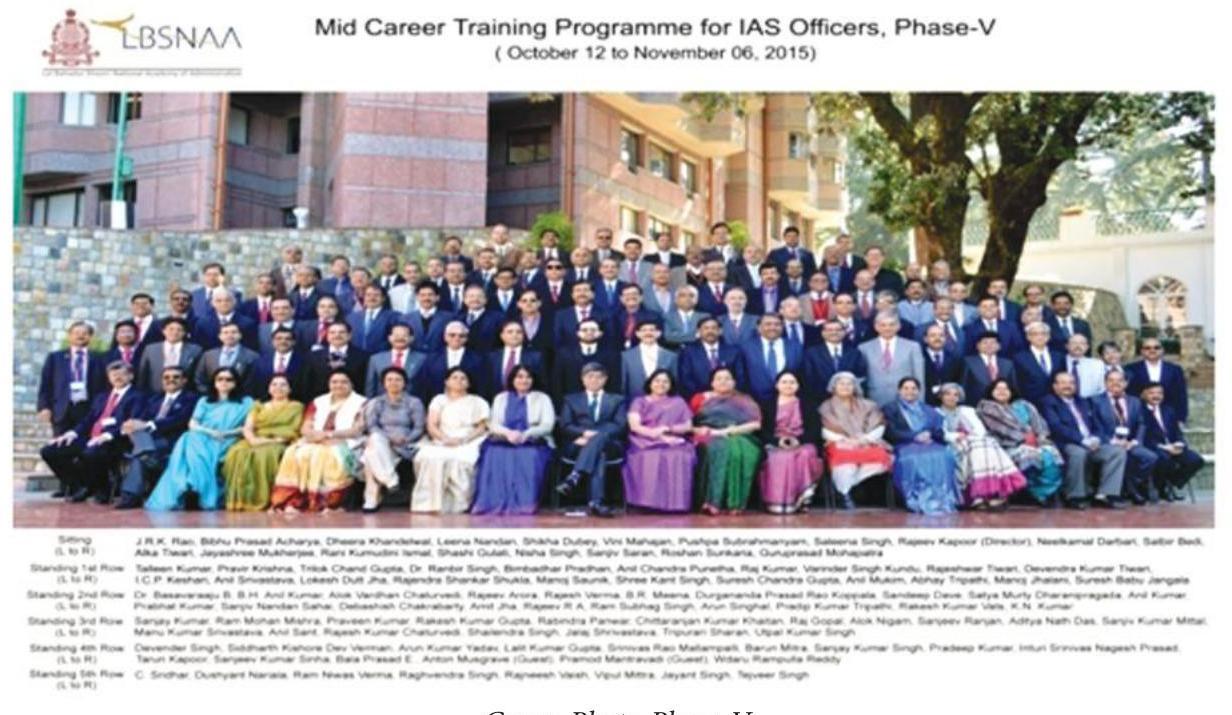
Other in-service Training Courses/ workshop/ seminars:
8.14 The Academy annually conducts short duration courses (ranging from one to two weeks) on a variety of subjects such as Joint CivilMilitary Course, Courses on Gender, Disaster Management, etc.
Golden Jubilee Reunion
8.15 The Academy organizes a reunion every year for Officers who joined the service 50 years back. The first was held in 1997, the Golden Jubilee Year of the new nation, where the ICS and IAS Officers, who were in service at the time of independence, participated. Since then, the retired officers are called every year for a period of two-three days to share their rich experience with the faculty and Officer Trainees.
8.16 The Golden Jubilee Reunion for 88 officers of the 1965 batch (from various civil services who underwent FC at the Academy) was organized from May 25-26, 2015. The Reunion commenced with the inaugural ceremony on May 25 followed
by a group photograph in the A.N. Jha Plaza. The participants were taken for a walk around the Academy campus before lunch and postlunch there was a two hour interaction with the Officer Trainees of the Phase-I 2014. The participants also had a session in small groups wherein they deliberated on issues of importance for the civil services in the present context before the Reunion come to a close with the valedictory ceremony on May 26, 2015.
Research Centres in the Academy
8.17 The centres of the Academy have been established with an aim to provide an avenue for initiating research in key areas of governance both from policy as well as implementation perspectives. The research is supposed to feed into the training curriculum and provide it with fresh insights. These centres are mostly funded either by line ministries, like CRS, or are selfsustaining like the NGC and CDM and collaborate with various national and international funding agencies. Various Research Centres have been set
up for undertaking action-research on domains linked to Academy’s mandate and to feed into training inputs. These are as follows:
Centre for Rural Studies (CRS)
8.18 The Centre coordinated the two week programme on ‘Land Administration and Management’ for the 179 Officer Trainees of IAS2014 batch during their Phase-I training. The Centre also coordinated and evaluated Village Study Assignments (Land Reforms and Socio Economic Reports) for 174 Officer Trainees of IAS-2013 batch during district training. The CRS coordinated the eight-day long Village Visit Programme for 353 Officer Trainees during the $90^{\text {th }}$ Foundation Course. The Officer Trainees were sent to 59 villages across two states to obtain an empirical understanding of rural life. During the Village Visit Programme the OTs organized and took part in ‘Swachh Bharat Abhiyan’ and a financial inclusion & literacy campaign in all the 59 villages.
8.18 The Centre organized two workshops on the themes of ‘The Scheduled Tribes and Other Traditional Forest Dwellers (Recognition of Forest Right) Act, 2006’ from 20-21 April, 2015 and ‘Journey towards Land Titling’ from 23-24 April, 2015. The recommendations of the workshop have been submitted to the Department of Land Resources. The Centre also completed primary studies and brought out five publications namely, ‘Land and Livelihood Initiatives in India: Learning from Andhra Pradesh, Bihar, Karnataka, Odisha and West Bengal States’, ‘Homestead Land and Livelihood Initiatives in India’, ‘Tenancy Laws and Practices: Emerging Issues’, ‘Conclusive Land Titling System: A Need for Reforms in Land Administration’ and ‘Contract Farming: Protecting Interests of Small and Marginal Farmers in India’ during the current year.
The Centre published ‘Identifying Existing Capacities to execute the National Land Records Modernization Programme: An Appraisal in Maharashtra, West Bengal and Madhya Pradesh’ and ‘Best Practices Study on Land Resources Management in India: Karnataka, Maharashtra, Haryana and West Bengal’. The Centre brings out a biannual journal ‘Journal of Land and Rural Studies’ which focuses on issues land administration and rural development.
Centre for Disaster Management
8.19 Ministry of Home Affairs, Government of India assisted the Academy in setting up the Centre for Disaster Management for acting as a nodal institution for imparting training on various aspects of Disaster Management with special focus on Incident Command System. Apart from conducting training programs the centre has been involved in formulation of national strategy for adaptation of the global best practices to suit Indian conditions in the field of disaster management as well as other research projects related to Disaster Management and Climate Change. The Centre is involved in training officers belonging to the IAS and other civil services at induction as well as at in-service level in various aspects of disaster management and climate change, use of IT, GIS applications in Disaster Management, conducting research projects, documentation of best practices, development of case studies, teaching materials etc. Centre has also initiated the publication of an international journal titled “Disaster Response and Management with ISSN number (ISSN: 2347-2553) and an annual book titled “Disaster Governance” with ISBN number (ISBN-.978-$81-928670-1-4$ ) apart from the other research publications
National Gender Centre
8.20 The National Centre for Gender Training, Planning and Research (National Gender Centre) was established in 1993 and registered as a society under the Societies Act, 1860 in 1998. NGC is a capacity building centre which functions as part of the Academy. The main aim of the Centre is to work with a global network of partners and to mainstream gender and child rights issues in policy, programme formulation and implementation in Government so as to establish gender as a priority concern in government and to ensure the equitable development of men, women and children. The Centre is involved in training of civil servants at induction level as well as in service level on gender and child rights issues through courses and sensitization inputs to develop a gender perspective.
8.21 This year the Centre organized a five day Training of Trainers programme on “Violence against Women & Children” in collaboration with UNICEF, New Delhi, from August 2428, 2015 at LBSNAA, Mussoorie. The aim of this programme was to develop a core group of trainers in the States so as to enhance their capacity as trainers on the issue of VAW and children. These trainers were exposed to concepts of gender and VAW, specific provisions in recent legislations for prevention of VAW and children (acts such as POCSO, DV Act, Juvenile Justice Bill, trafficking of women and children) and issues in implementation with examples from the ground. There was participation from sixteen States and the total number of participants was 39 (Male – 14, Female – 25).
8.22 The programme provided a dynamic platform for deliberation and discussion and brought together senior officials belonging to key departments such as Administrative Training Institutes, Women and Child Department and
Police Training Institutes from the states like Maharashtra, Madhya Pradesh, Rajasthan, Chhattisgarh, Uttar Pradesh, Uttarakhand, Tamil Nadu, Himachal Pradesh, Goa, Haryana, Karnataka, Kerala, Assam, Nagaland, Meghalaya, Tripura.
8.23 The sharing of experiences and good practices from other States and practical exposure to various training methodologies in the programme if effectively used by the participants in their own training institutions or workplace would help in meeting our objective of sensitising the work environment and improving implementation of the law, in the year 2015-2016.
National Centre for Sustainable Community Systems
8.24 The National Centre for Sustainable Community Systems (NCSCS) is a research centre of the Lal Bahadur Shastri National Academy of Administration, Mussoorie. The genesis of this centre goes back to September 1995, when the Centre for Co-operatives and Rural Development (CCRD) was established. To fit the additional mandate of the centre, CCRD was renamed as National Centre for Livelihood Management (NCLM) in 2011. Further, to cater to growing demand and complexities of livelihood, agriculture and sustainability of rural poor and smallholder farmers, this centre in March 2014 was assigned a larger mandate of recreating sustainable community systems in the country, rechristened as National Centre for Sustainable Community Systems (NCSCS) and registered as a Society under the Societies Act, 1860.
8.25 The centre’s focus is to improve local governance through the principles of decentralization, convergence, and cooperation at the community level from the perspective
of long term sustainability of our society. The activities of the centre include research, action research, consultancy & handholding support to state livelihood missions and line departments of the government on community based producer organizations and platforms of the poor, develop training modules, policy seminars, prepare policy notes, publish research findings, and most importantly to facilitate the Academy to sensitize and build awareness among the Officer Trainees and officials of the Government on the various perspectives of rebuilding sustainable community systems and sustainable governance at Gram Panchayat and District levels across India.
National Centre for Leadership Development and Competency Assessment (NCLDCA)
8.26 With the aim to strengthen the capacities of civil servants and their enabling environment to achieve an efficient, transparent and accountable public administration at both national and state levels, LBSNAA/NIAR established a Leadership Development Cell (LDC) to take up research on best practices from India \& abroad, to develop training materials and enrich policy recommendations to complement the National Training Policy. In February 2014, the LDC was brought under the fold of LBSNAA and was registered under the Societies Act as NCLDCA. A series of capacity building workshops on leadership skills in the context of public administration were designed and run in collaboration with Center for Creative Leadership Pvt. Ltd. (CCL) and German Society for International Cooperation (GIZ). The outcome of these collaborations has been selection and training of a pool of ‘National Leadership Trainers’ who would be able to deliver leadership inputs according to the requirements of different levels of IAS being trained in the Academy.
8.27 In February 2015, a workshop was held with SDA Bocconi to design a training module on Negotiations Skills for IAS Phase II, III and IV, in which 10 faculty members of LBSNAA and other serving officers were trained as trainers who rolled out the module for Officer Trainees of IAS Phase-II in 2015. Between May-June, 2015 these national pool of trainers rolled out the Negotiations Module for IAS, Phase III and IV. Similarly the national pool of trainers which was created with help of CCL to roll out Leadership Modules, delivered modules of BLS for Phase-I Officer trainees and MLS for participants of Phase III and Phase IV during April-June 2015.
The Academy Spirit
8.28 LBSNAA seeks to imbue civil servants with the required attitude and values expected in public service. The skills and knowledge required by a professional civil servant are relatively easier to impart and these have traditionally been the strength of the Academy. However, to positively influence in the brief period available to us, the attitudes and values of intelligent young persons in their mid-twenties and thirties, coming from diverse backgrounds, is a more challenging task.
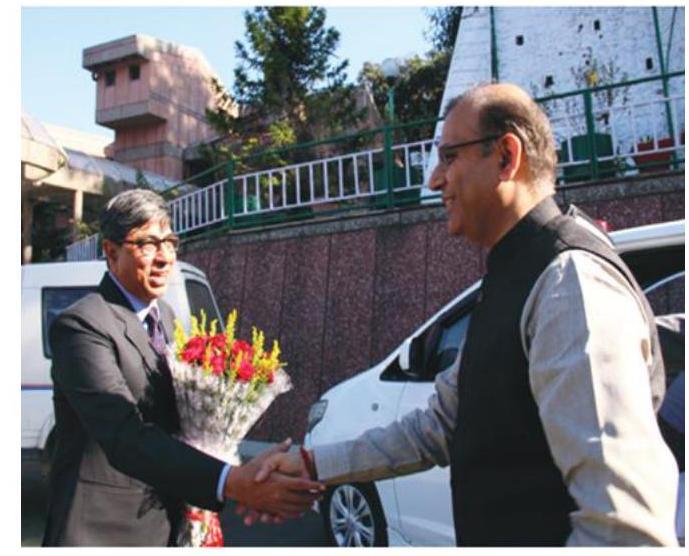
90 $0^{\text {th }}$ FC VIP Visit
8.29 It is generally argued that for public service one needs integrity, moral courage, empathy with and respect for the underprivileged and freedom from any sectarian prejudices based on religion, region, caste, class or gender. But today, it is precisely these very values that are under siege because of turbulent conflicts and upheavals in the recent past. To nurture these values, the officer trainees are encouraged to participate in diverse social activities. They are given responsibilities for improving the Lalita Shastri Balwadi School, where LKG/UKG & Class-I are conducted at a concessional rate for the children of the employees and the public. The problem of solid waste management has also been addressed by them in close coordination with NGOs working in Mussoorie. The officer trainees also do shramdaan to clean their premises and to instill a dignity of labour. Emphasis on caring for the poor, listening to the people, providing safety nets for the vulnerable, and being open and transparent runs as a continuous thread in all the courses and interactions. In addition, OTs are divided into counsellor groups where they are able to articulate their views in an open and frank atmosphere. This forum serves as a great means of eliciting their views and conveying the right messages to them.
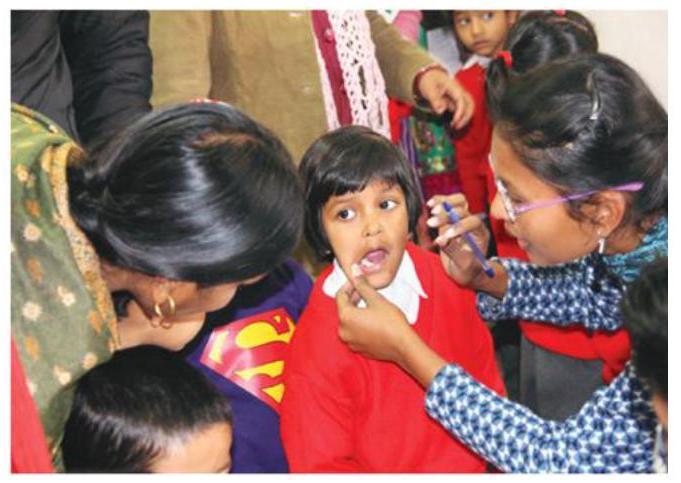
Medical Camp organized for School Children
The Academy as Alma Mater
8.30 All Officer Trainees in the All India Services and Central Services begin their careers from the proverbial “gaumukh” of civil service, the Lal Bahadur Shastri National Academy of Administration at Mussoorie. As a result, this institution provides a foundation that paves the way for lifelong professional and personal associations among officers across different civil services. These officers look back to the Academy with great nostalgia and also draw inspiration from the values and ideals instilled in them during their formative years.
Recent Training Initiatives
8.31 Some of the recent initiatives taken in the field of imparting improved learning inputs by the Academy are as follows:
- Introduction of online learning through delivery of course on Development Economics with the assistance of Jameel Poverty Action Lab, Massachusetts Institute of Technology, Boston (USA)
- Partnership with Harvard University for Evidence-based Policy Design for MidCareer courses
- Development of competency-based Leadership programmes with Centre for Creative Leadership (under DoPT-UNDP scheme) and with GIZ (Germany)
- Development of negotiation module with assistance of SDA Bocconi (Italy)
- Development of Case Study method and flipped classroom
A MoU between LBSNAA and Indian Institute for Human Settlement (IIHS) Banguluru was signed on 14-7-2015. Another MoU between LBSNAA and MISB BOCCONI, Mumbai was signed on 25-8-2015.
Facilities
8.32 The Academy is well-equipped with good training infrastructure in terms of academic buildings, classrooms, hostels and other support infrastructure. Some of the key infrastructure facilities are given below:
- 4 Academic & Administrative Blocks
- Karmashila,
- Dhruvshila,
- Gyanshila and
- Aadharshila – inaugurated on June 29, 2015 by Dr. Jitendra Singh, Hon’ble Minister of State for Personnel
- Gandhi Smriti Library – stocks 1.75 lac books, 300 journals and e-resources
- Officers Mess – can cater to around 500 persons at 3 locations
- Sports – well-equipped Officers Club, Riding Ground and Shooting Range
- Health – well-equipped Medical Centre
- Executive Hostels – 4 executive hostels with 167 rooms
- Officer Trainee Hostels – 3 hostels with 131 rooms
- Wi-Fi campus
Faculty
8.33 The Faculty comprises a healthy blend of senior administrators and academicians and researchers. The administrators combine the richness of their field experience with strong academic achievements to provide a stimulating atmosphere for learning. The Academy is presently headed by the Director Shri Rajeev Kapoor, IAS (UP: 1983). As part of the Development of skills of Faculty, the faculty members were nominated to attend various training programs in India and abroad.
The following Training of Trainers courses were also conducted by the Academy (in-house):
- Training of Trainer program on Public Private Partnership was organised for internal and external faculty on 31-082015 to 02-09-2015.
- A Case Study writing \& teaching workshop was organized in the Academy for faculty members of the Academy from 4-8 January, 2016 in association with UNDP-DoPT.
Induction Courses for State Civil Service officers promoted to IAS
8.34 The Academy organizes Induction Training Program for officers promoted to the IAS from the state civil services. The course, which was earlier of duration of eight weeks with about two weeks of exposure visit, has now been reduced to six weeks. The Induction Training Programme, conducted at LBSNAA in July, 2015, was attended by 75 participants.
In addition to above, to clear the backlog, 6 batches of Induction Training Programme for promotee IAS officers were conducted 2 each at Administrative Training Institute (ATI) West Bengal, ATI Mysore and Institute of Management in Government (IMG) Kerala during August, 2015 to December, 2015 which was attended by total 276 participants.
Additional programmes also being conducted at ATI West Bengal and other ATIs to clear the backlog in the financial year 2015-16.
Crash Foundation Course
8.35 A Crash Foundation Course was conducted to clear the backlog of Foundation Course upto 2011 batch of AIS and Group ‘A’ Central Services at Dr. MCR HRD Institute Hyderabad
during 13.07.2015 to 25.07.2015. The Course was attended by 88 officers (IAS (01), IPS (42), IFoS (02), ITS (17), IPoS (25) and IF&T AFS (02).
Special Foundation Course
8.36 Special Foundation Course was conducted to clear the backlog of Foundation Course upto 2013 batch of AIS and Group ‘A’ Central Services at Dr. MCR HRD Institute, Hyderabad and HIPA, Gurgaon from 07.09.2015 and 13.09.2015 respectively. The details of service wise participation in the course are as under:
| S. No. |
Service | Joined at MCR HRD Institute |
Joined at HIPA Gurgaon |
Total joined |
|---|---|---|---|---|
| 1 | IPS | 18 | 77 | 95 |
| 2 | IFoS | 10 | 0 | 10 |
| 3 | IPoS | 17 | 0 | 17 |
| 4 | ITS | 5 | 0 | 5 |
| 5 | IP\&T AFS | 4 | 0 | 4 |
| Total | $\mathbf{5 4}$ | $\mathbf{7 7}$ | $\mathbf{1 3 1}$ |
Institute of Secretariat Training and Management
8.37 The Institute of Secretariat Training and Management (ISTM) is imparting training to the officers of the Central/State Governments, Public Sector Undertakings \& Autonomous Bodies. Originally set up with the objective of conducting foundational and in-service training programmes for Assistants and Section Officers of the Central Secretariat, the range of the activities of the Institute has increased exponentially over the last six decades. In addition to the in-house training programmes, the Peripatetic Training provided by the Institute to the officials of State governments and Union Territories and training in Behavioral
Skills, Management Techniques, Financial Management and Office Management are of particular significance. On specific request from Central Government Departments, Autonomous Bodies, Public Sector Organisations, the Institute organises special programmes addressed to the specific customer needs in different areas.
8.38 From the year 2007-08, ISTM is also involved in implementation of the Central Secretariat Service Cadre Training Plan (CSS-CTP) and from 2011 onwards Central Secretariat Stenographer’s Service Cadre Training Plan (CSSS-CTP), which envisage mandatory training programmes having linkages with career progression up to Director Level Officers.
8.39 ISTM conducts following programmes in various categories:
(a) Foundational Courses conducted as per new CSS and CSSS Cadre Training Plan
(b) Personnel Administration and Office Management
(c) Financial Management
(d) Management Services
(e) Behavioral Training \& Secretarial Skills
(f) Training of Trainers
(g) Peripatetic Training Programmes
(h) Right to Information
(i) Organization Specific Programmes/ Cadre Specific Programmes
(j) DoPT Sponsored Courses
8.40 Number of Training programme and Training weeks scheduled and conducted during 2015-16
| S.No. | Programme | No. of Courses |
Training weeks |
|---|---|---|---|
| 1. | Number of programme scheduled | 240 | 650 weeks |
| 2. | Programmes Conducted during $01^{\text {st }}$ April, 2015 to $15^{\text {th }}$ February, 2016 (CSS-CTP, CSSS-CTP, Other Calendared Training Programmes (Other than CSS/CSSS-CTP), Other Important Training programmes (Organisation/Cadre Specific Programmes, Training Programmes for DoPT Officers), Peripatetic Training Programme for Union Territories) |
200 | 572 weeks 2.5 days |
| (CSS-CTP, CSSS-CTP, Other Calendared Training Programmes (Other than CSS/CSSS-CTP), Other Important Training programmes (Organisation/Cadre Specific Programmes, Training Programmes for DoPT Officers), Peripatetic Training Programme for Union Territories) |
Total 6562 officials have participated in the training |
||
| 3. | Programme to be conducted $16^{\text {th }}$ February, 2016 to $31^{\text {st }}$ March, 2016 |
40 | 78 weeks |
Additional Courses for training Assistants (Direct Recruit) (ADR) during 2015-16
8.41 During the year 2015-16, six courses for training Assistants (Direct Recruit) were planned. However, on the request of DoPT, additional ADR courses were conducted. Upto 15th February, 2016, 24 ADR training courses have been conducted for 1492 participants. Out of these 24 courses, 12 batches of ADR courses were conducted at six State Administrative Training Institutes in Gurgaon, Chandigarh, Shimla, Hyderabad, Jaipur and Kolkata. Presently, six more batches of ADR courses for 405 participants are being conducted, out of which four batches are being conducted at ISTM and one each at Chandigarh and Hyderabad.
New Initiatives
8.42 ISTM takes up various social activities at regular intervals to promote citizen centric approach among its trainees and faculty/staff which are as follows:-
(i) Blood Donation: During the quarter July, 2015 – $15^{\text {th }}$ February, 2016 eight camps have been organized and nearly 500 participating trainees, members of staff and faculty donated blood.
(ii) Public Service: New initiative of serving people is being taken by ISTM with the perspective to instil a sense of public service in the fresh recruits so that they can continue to serve the people in all their endeavours while discharging official duty. The initiative includes distribution of food, clothes, medicines, taking care of environment issues, relating to differently abled, educating people about cleanliness and participating in the cleaning activities, dissemination of information by way of street play etc. During this year, social activity of distribution of food to patients and their attendants staying in Rain Basera at All India Institute of Medical Sciences (AIIMs), Safdurjung Hospital, counseling of children at Rain Basera in Safdurjung Madarsa area and Sensitizing villagers about the need of sanitation during their visit to Uttarakhand were undertaken.
(iii)Interaction With Eminent Personalities: A new initiative to call reputed sports persons, for interaction with the trainee Direct Recruit Assistants of the CSS, has been started. So far, Olympian Boxer
Shri Vijender Singh, and Shooter Shri Murad Ali Khan have interacted with the trainee participants. Experiences of a mountaineer may teach good lessons in life building – particularly when they come from a celebrity, two time climber of Mt. Everest – Padmashree Ms. Santosh Yadav. Ms. Yadav addressed a large number of trainee audience in ISTM and told them about the advantages of leading a simple life. She urged them all to develop good practices like early rising, doing regular physical exercise and avoiding junk food for better productivity.
Introduction of New Topics in a Number of Other Courses
8.43 In the present time of e-governance and delegation of work at various levels, all officials working for government need to take responsibility of the work they are assigned to do. For this purpose, a module on ‘Basic Leadership Skills’ has been added in various courses.
Visit of Delegations
8.44 A delegation comprising officials of Government of Vietnam visited ISTM on $20^{\text {th }}$ August 2015, to learn about the role of ISTM, in capacity building for better implementation of RTI. Another delegation comprising officials of Government of Malaysia also visited ISTM on $11^{\text {th }}$ December 2015 and interacted with the Director and faculty members to explore areas of cooperation in training.
Special Programmes for Officers of DoPT
8.45 Special Training Programmes for LDCs, UDCs, Assistants, Section Officers and Under Secretaries of DOPT, were conducted during September and October, 2015 at ISTM/ Rajasthan Institute of Public Administration, Jaipur and Udaipur.
Other Training Programmes
8.4664 Organization/Cadre Specific Programmes were conducted for various Central Ministries/ Departments, States, UTs and Autonomous bodies and PSUs upto $15^{\text {th }}$ February 2016. 12 more Organisations/Cadre specific programmes are planned so far upto $31^{\text {st }}$ March 2016. Capacity Building Training Programmes for Secretariat Service officers of Meghalaya has been planned.
Peripatetic Programmes
8.47 Ten programmes for Chandigarh Administration have been conducted. One programme of Dadra & Nagar Haveli, two programmes of Government of Sikkim and One programme of Daman \& Diu Administration have been planned during the year so far.
Consultancy Projects
8.48 ISTM is also engaged in the research and consultancy projects. The following consultancy projects are being handled in the ISTM:-
(i) Preparation of Manual of Office Procedure for Securities and Exchange Board of India (SEBI)
(ii) Audit of Proactive Disclosure under RTI for 12 organisations
(iii) Cadre Review of Coal Mines Provident Fund Organisation (CMPFO)
(iv) Cadre Review of Gandhi Smriti and Darshan Samiti.
Development of Training Management Information System (TMIS)
8.49 TMIS module of Training Management System project was initiated in the year 2011-12 and it has become operational, as far as work relating to co-ordination and administration are concerned. As part of further development under
TMIS, online registration for ADR and SDR training programmes has started during 2015-16. Facility for writing of Daily Diary and filling up of choice of Departments has also been enabled in the system.
Visit of Secretary (P) to ISTM:- Secretary (P) visited ISTM to inaugurate/interact with the participants of Induction training courses for Stenographers (Direct Recruits), Assistants (Direct Recruits) on $18^{\text {th }}$ May 2015; $26^{\text {th }}$ June 2015; $08^{\text {th }}$
July, 2015, $23^{\text {rd }}$ December 2015 & $15^{\text {th }}$ January 2016. He had also interacted with participants of Level E programme on $26^{\text {th }}$ June 2015.
Visit of Additional Principal Secretary to PM Dr. P.K. Mishra:- Additional Principal Secretary to PM visited ISTM on $18^{\text {th }}$ May 2015 to inaugurate/ interact with the Assistants (Direct Recruits) trainees undergoing foundational training at that time.
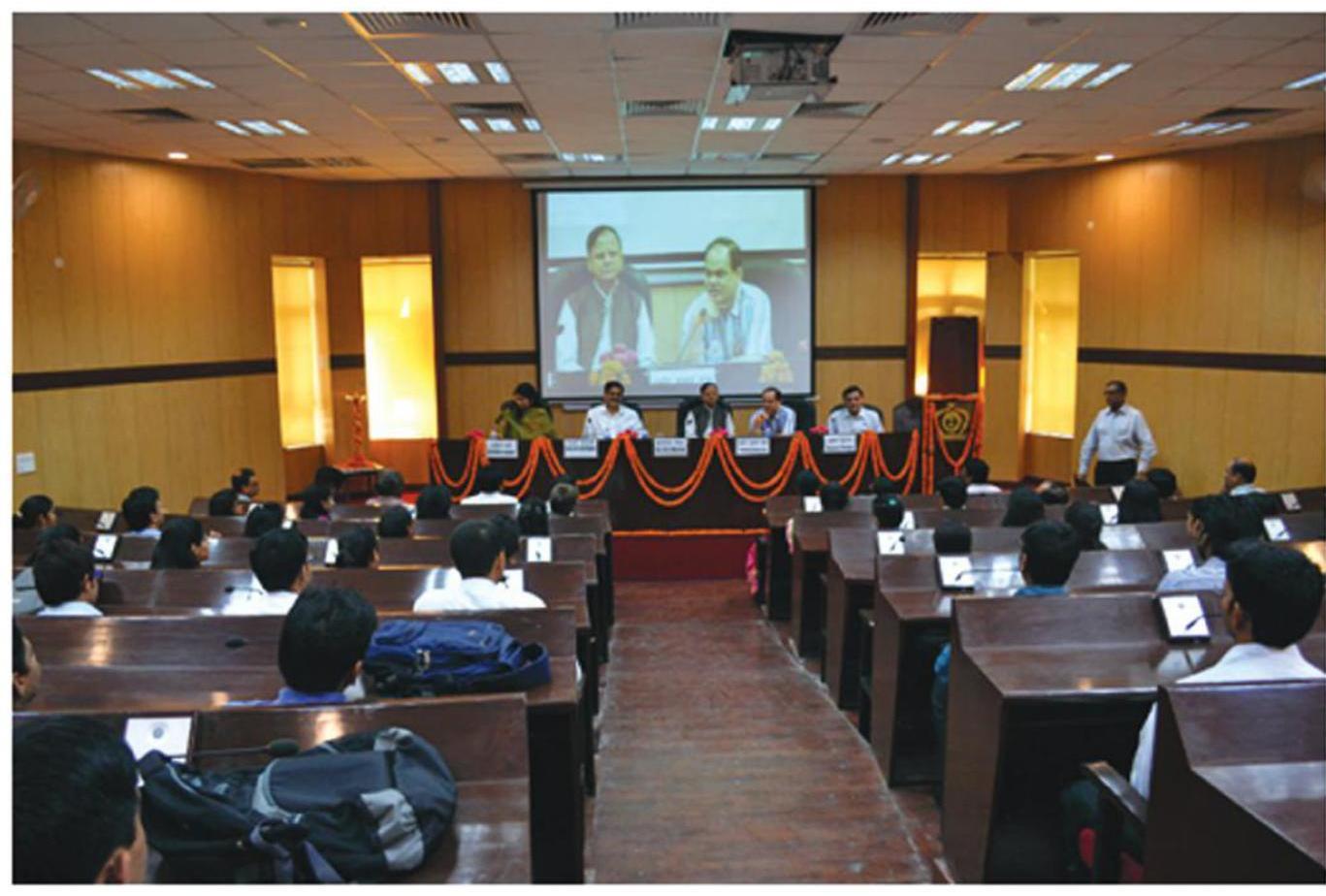
Inauguration of Assistant Direct Recruits (ADR) training programme by Addl. Principal Secretary to Hon’ble PM on $18^{\text {th }}$ May 2015.
MAJOR EVENTS DURING 2015-16
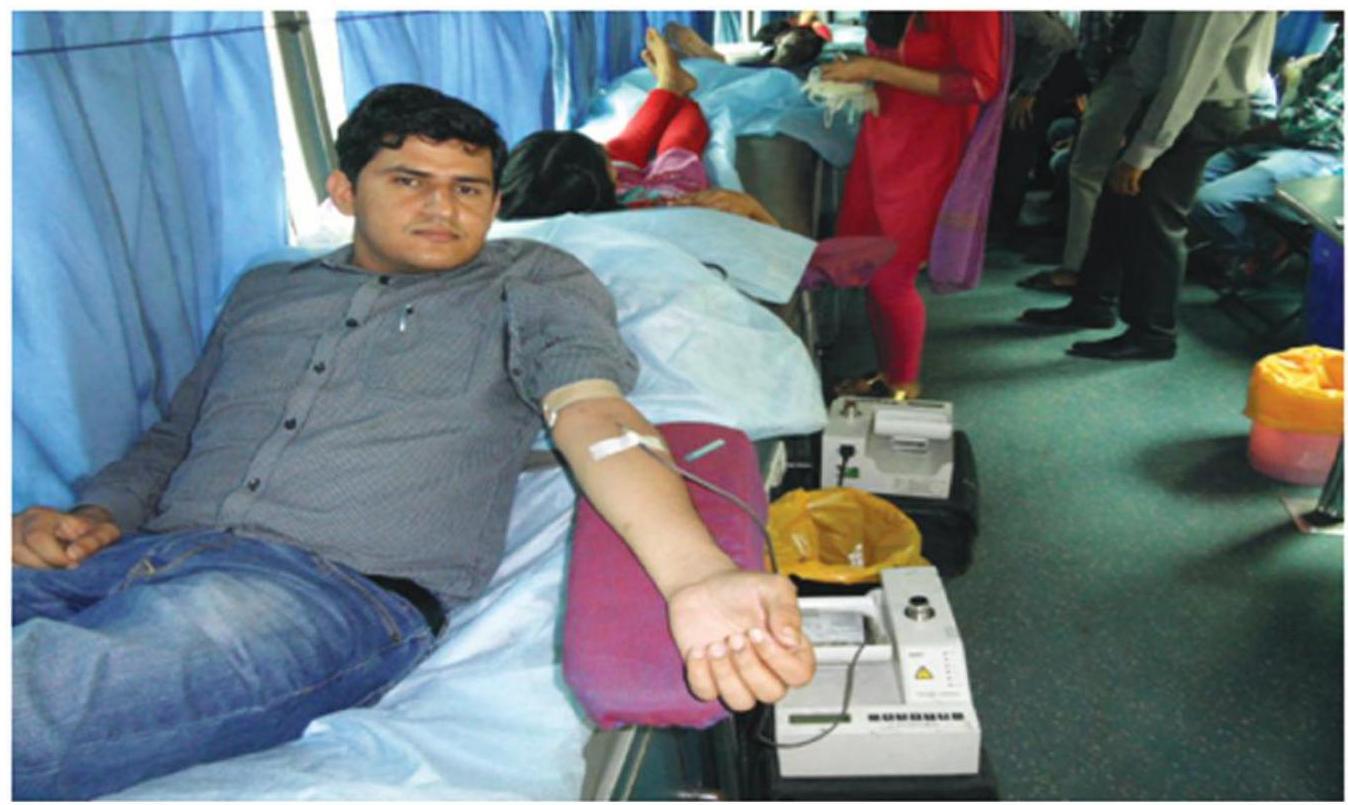
Participants donating blood in Blood Donation Camp on $17^{\text {th }}$ June 2015 at ISTM
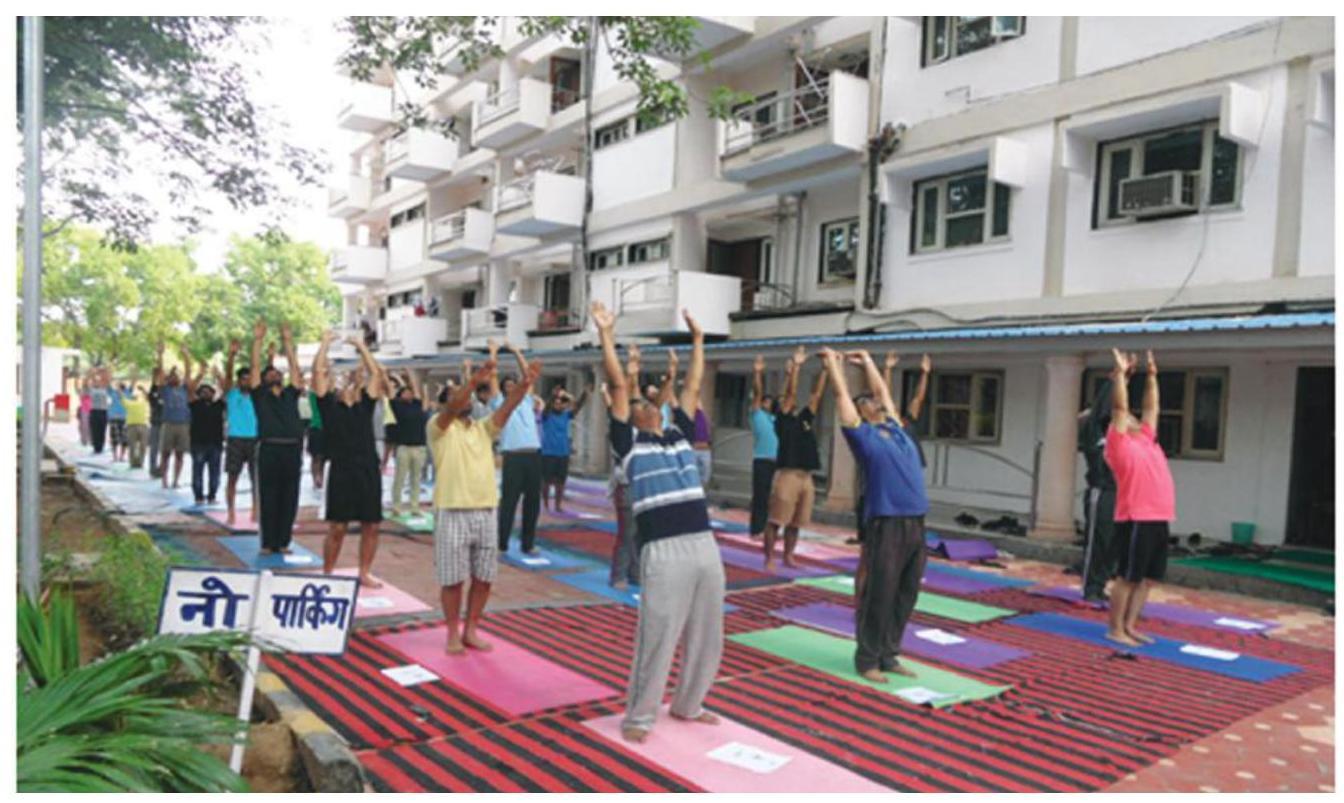
Faculty members, staff and the trainees participating in yoga camp on $21^{\text {st }}$ June 2015
(International Yoga Day)
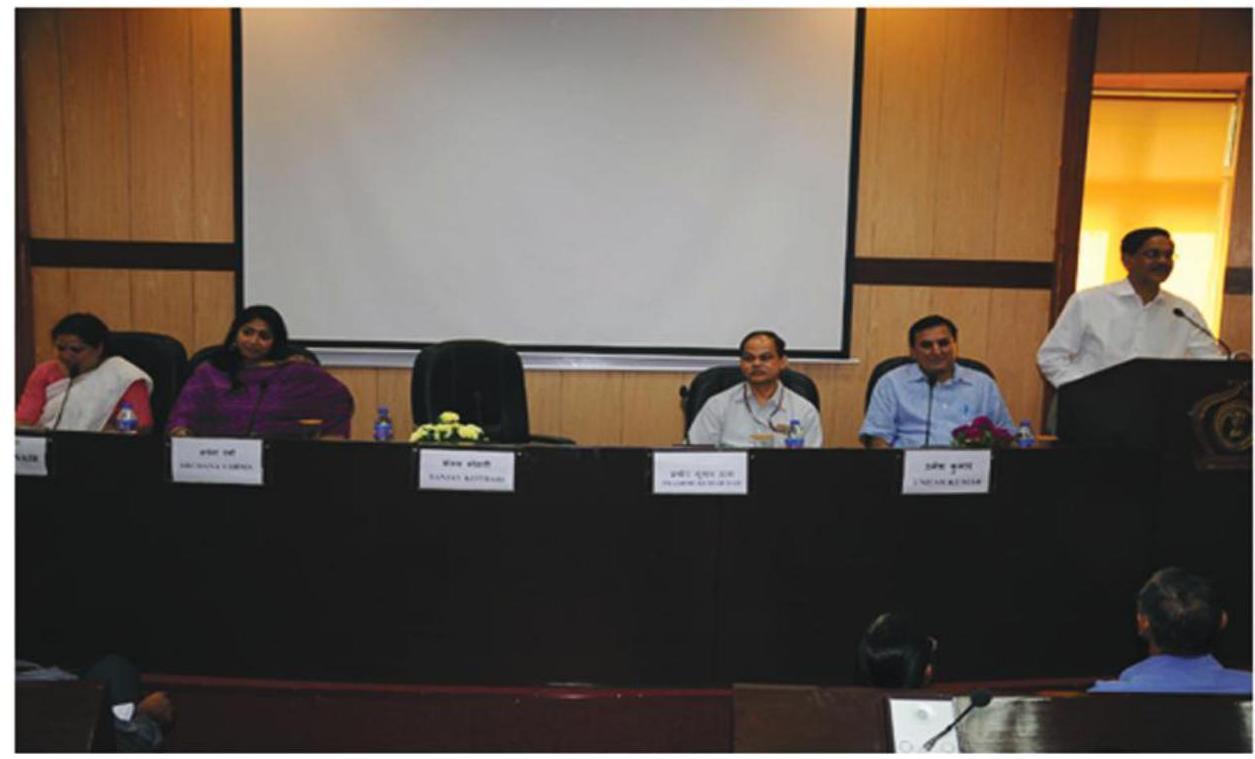
Secretary (P) interacting with the participants of stenographers Direct Recruits (SDRs), Level ‘D’ (Section officers to Under Secretary) and Level ‘E’ (from Under Secretary to Deputy Secretary) training programmes on $26^{\text {th }}$ June 2015
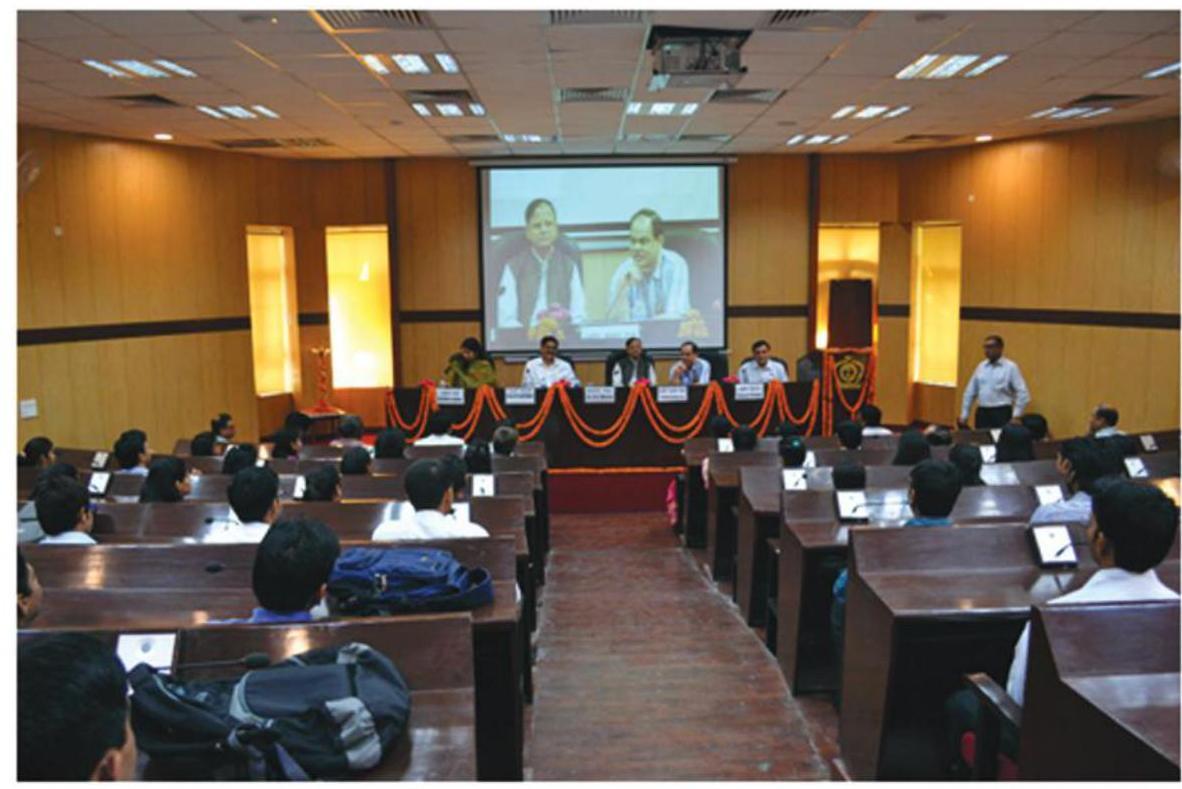
Assistant Direct Recruits (ADR) training programme inaugurated by Addl. Principal Secretary to honorable PM on $18^{\text {th }}$ May 2015 at ISTM
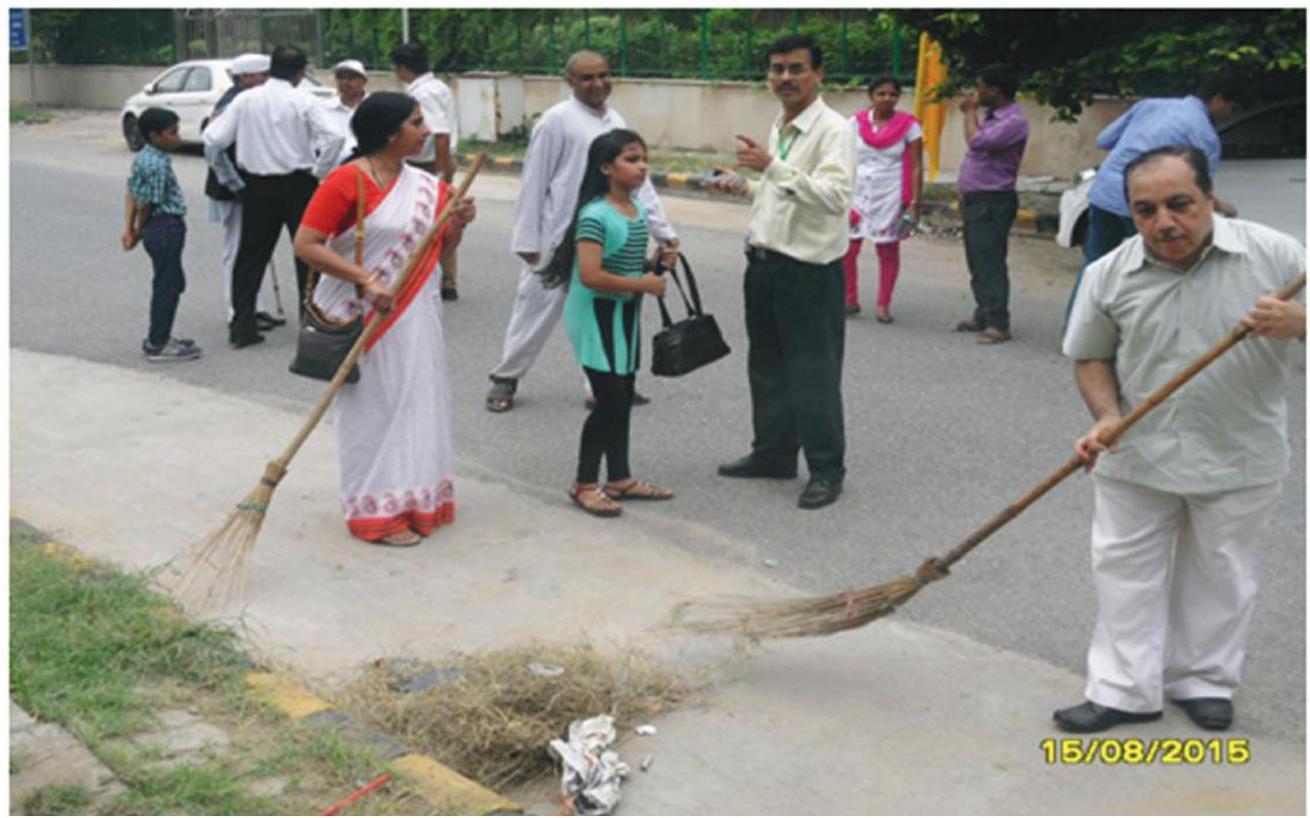
Cleanliness by Officers, Staff & Participants at ISTM on 15.08.2015
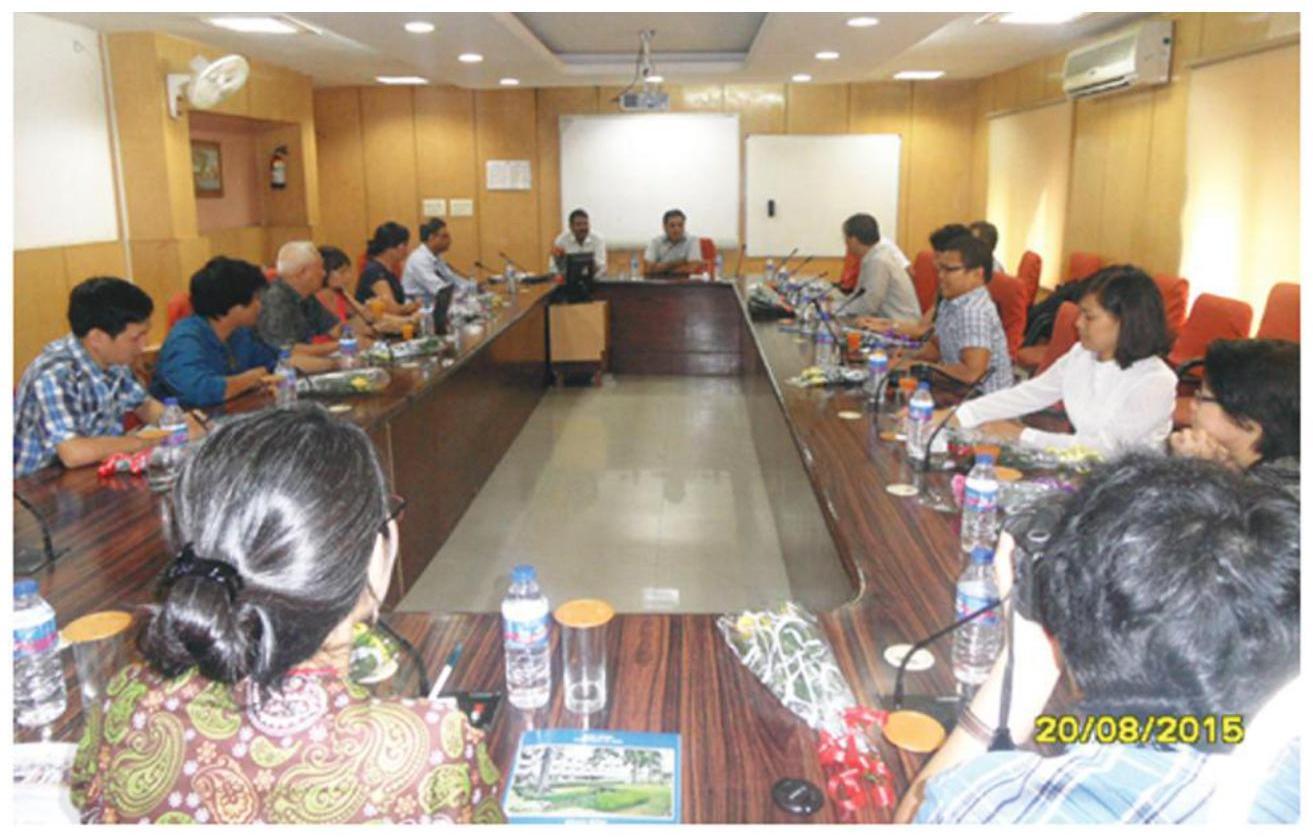
Visit of Vietnam delegation to ISTM on $20^{\text {th }}$ August 2015
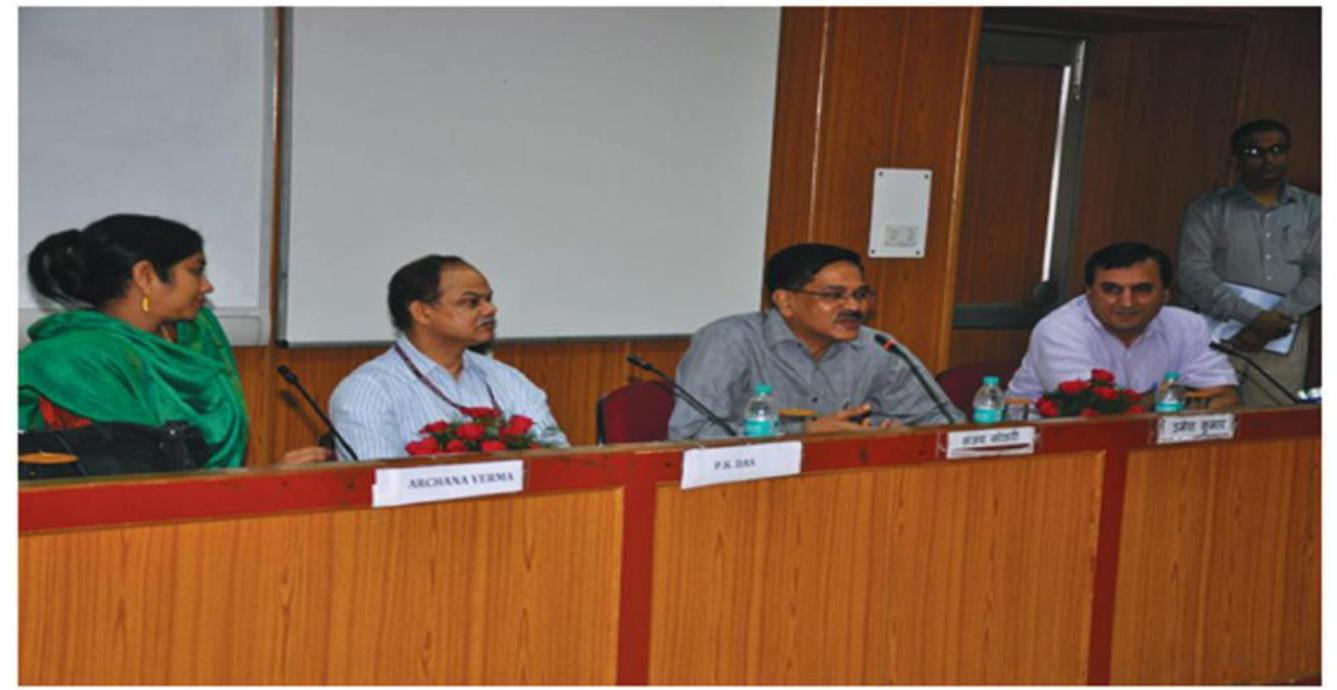
Secretary (P) interacting with CSS – ADR on $08^{\text {th }}$ July 2015
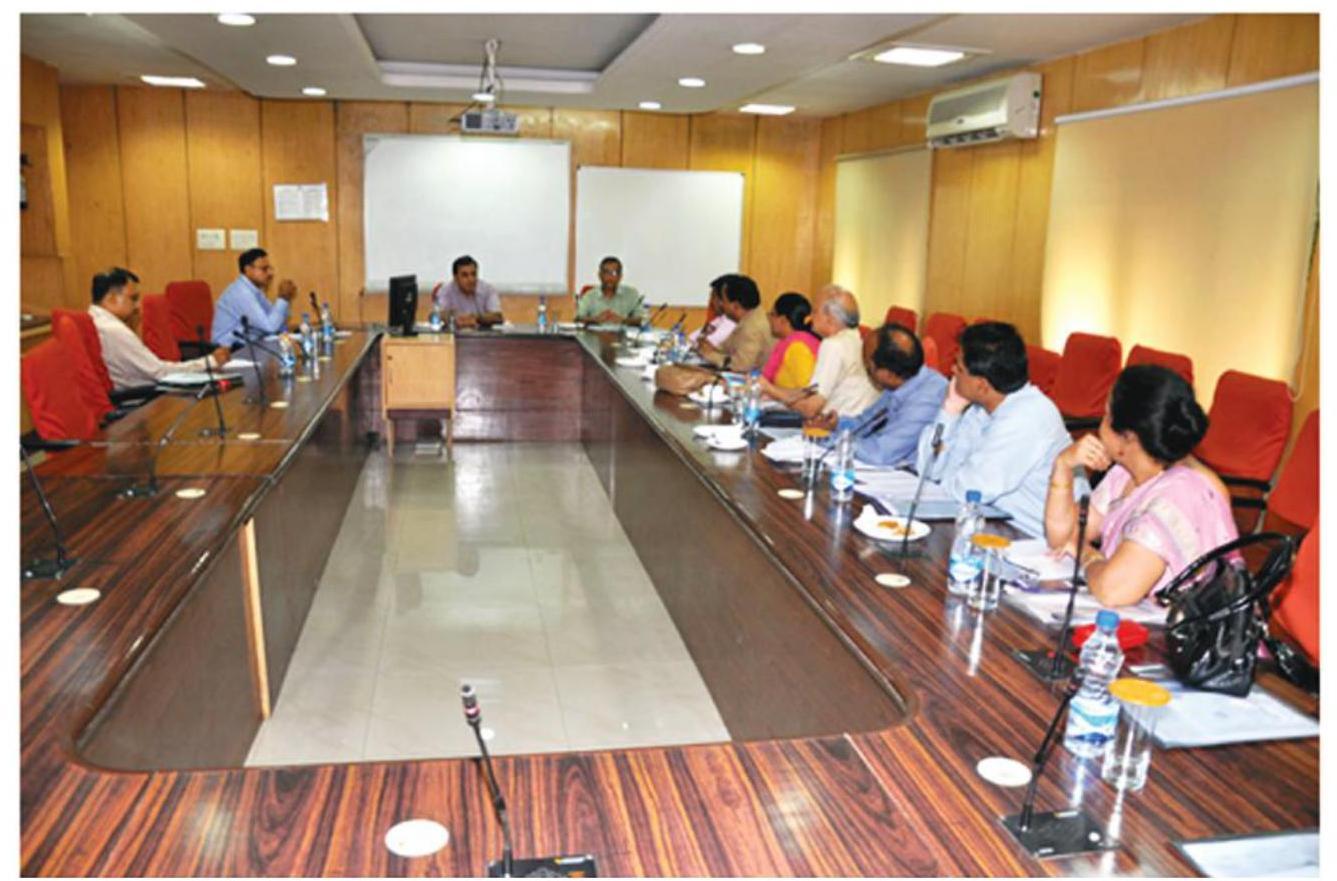
Meeting with Course Directors from different ATIs at ISTM on $23^{\text {rd }}$ July 2015
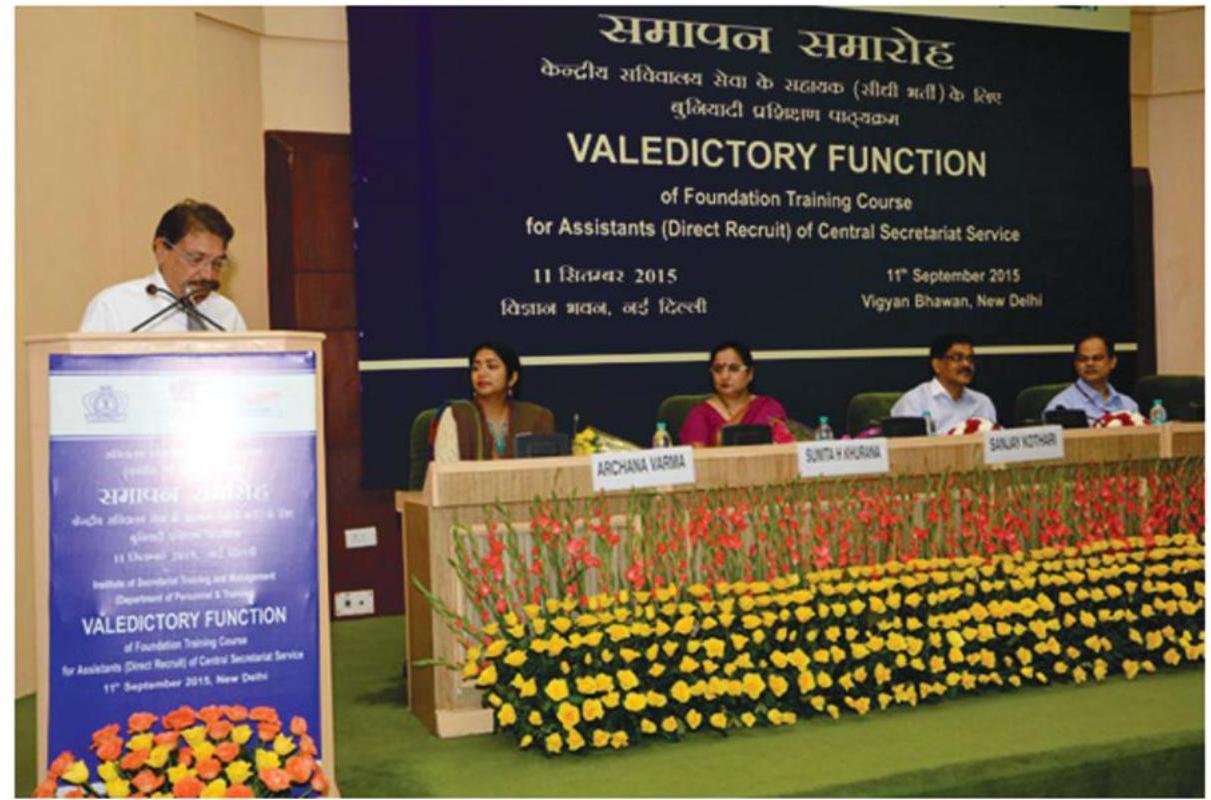
Valedictory Function of ADR-FTP of CSS on $11^{\text {th }}$ September, 2015 at Vigyan Bhawan
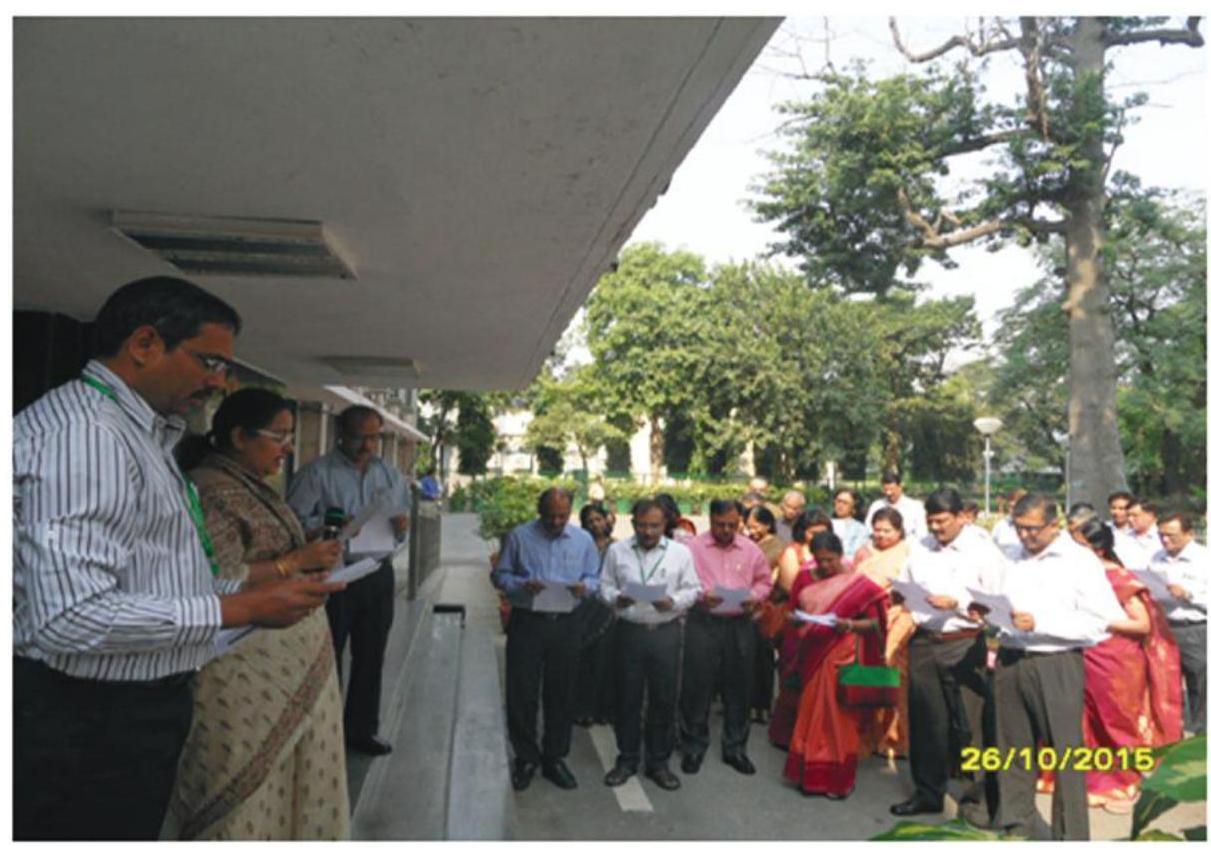
Pledge during the Vigilance Awareness Week 2015 on $26^{\text {th }}$ October, 2015
Chapter
ADMINISTRATIVE VIGILANCE DIVISION
9.0 Administrative vigilance Division – I is responsible for examination of disciplinary cases in respect of IAS officers working under the Central Government. The Division also processes cases referred by the State Governments and Ministries/Departments under Government of India on the following issues:
- Proposals from States seeking to impose major penalty of dismissal/ removal/ compulsory retirement on members of Indian Administrative Service;
- Proposals from States seeking permission under the AIS (DCRB) Rules to initiate action against retired members of IAS;
- Proposals from States for imposing penalty of cut in pension;
- Proposal to initiate disciplinary proceedings/ suspension of IAS officers working under the Government of India;
- Appeal against suspension submitted by IAS officers serving in the States;
- Requests for sanction for prosecution under the Prevention of Corruption Act, 1988 against the above categories of officers;
- Advice / clarification to the State Governments / Departments on the procedural aspects of disciplinary proceedings;
- Provides information regarding vigilance status of IAS officers at the time of their
empanelment / training / posting on deputation etc. To facilitate this function, a Computerized Vigilance Information System is in operation with a central data base which can be accessed by the requisitioning Divisions of this Department concerned. - Handling of Privilege Notices and Complaints from Members of Parliament against IAS officers received from the Lok Sabha / Rajya Sabha Secretariat.
Disciplinary Proceedings & Sanction for Prosecution
9.1 Final orders in disciplinary proceedings were issued in five cases during the period from 01.4.2015 to 29.02.2016. In 01 (one) case, decision on the request of the State Government regarding grant of permission to initiate disciplinary proceedings against retired IAS Officers under the provisions of All India Service (Death cum Retirement Benefits) Rules was conveyed.
Complaints against IAS officers to 29.02.2016
9.2 During the period from 1.4.2015 to 29.02.2016, 342 complaints were received, 290 were processed and 88 complaints were finally disposed of with the approval of the competent authority.
Privilege Notices and Complaints from Members of Parliament against IAS officers
9.3 During the period 1.4.2015 to 29.02.2016, 07 new notices were received from the Lok Sabha / Rajya Sabha Secretariat and processed and 04 were finally disposed of.
Monitoring of Proposals of Sanction for Prosecution under provisions of Prevention of Corruption Act, 1988.
9.4 In terms of para 2(ix) of DOP&T O.M. No. 399/33/2006-AVD.III dated 06.11.2006, the delayed cases of sanction for prosecution were reviewed by the Committee chaired by the Secretary (Personnel) on 05.10 .2015 and 06.01.2016.
Disagreement cases in disciplinary matters
9.5 In order to bring about greater uniformity in existing disciplinary cases on behalf of the President, in cases where the President is the disciplinary authority and there is a difference of opinion between the CVC and the concerned Department, the Departments are required to consult the DoPT before taking a decision on not to accept the CVC’s advice. Similarly, disciplinary cases where Central Vigilance Commission advises major penalty and the UPSC favours a minor penalty or recommends exoneration, before the Disciplinary Authority takes a final view, the matter is to be referred to this Department for resolving the disagreement. This Division has disposed of 6 such cases, till February, 2016.
Disagreement in the matter of Prosecution Sanction cases
9.6 Similarly, the cases of disagreement between the CVC/CBI and Sanctioning/Disciplinary Authority in the matter of Prosecution sanction cases are required to be referred to DoP\&T for a
final decision in terms of this Department’s OM dated $6^{\text {th }}$ November, 2006. This has been modified vide DoP\&T’s OM No. 372/19/2012-AVD-III dated $3^{\text {rd }}$ May, 2012 providing that final decision for grant or denial of sanction for prosecution shall be taken by the Competent Authorities concerned even in cases they decide to differ with CVC’s advice after obtaining views of DoPT. Accordingly, the views of DoP\&T may be taken into account while passing final speaking order.
Chief Vigilance Officer
9.7 The AVD has been responsible for the appointment of Chief Vigilance Officers (CVOs) in Central Public Sector Undertakings etc. It also deals with the matters relating to extension of tenure of the CVOs, their pre-mature repatriation and debarment of officers who fail to take up their assignments as CVO consequent upon their selection. During the year 2015-16, (Upto February, 2016) 42 panels were sent to various Ministries/Departments for finalizing selection of appointment of CVO in PSUs under their respective administrative control. Out of these, 14 officers have been appointed as CVOs in various CPSUs etc. During the same period, 18 CVOs have been granted extension of tenure after completion of initial tenure, 3 officers have been debarred from central deputation for not joining the post after their selection and $\underline{\mathbf{6}}$ cases of premature repatriation have been finalized.
Central Vigilance Commission
9.8 The Central Vigilance Commission (CVC) was set up by the Government of India through a Resolution vide No. 54/7/64 dated 11.02.1964 and was accorded statutory status by the Central Vigilance Commission Act, 2003 (No. 45 of 2003), notified in the Gazette of India Extraordinary on 12.09.2003.
9.9 The jurisdiction of the Commission extends to all the organisations to which the executive powers of the Union of India extend. In terms of clause (b) of sub Section (2) of Section 8 of the Central Vigilance Commission Act, 2003 (45 of 2003), the Government has notified vide Notification No. 418/2/2004-AVD-IV dated $18^{\text {th }}$ March 2004 and $12^{\text {th }}$ September 2007, the level of officers in the public sector banks and corporations established by or under any Central Act, the Government companies, societies and other local authorities owned or controlled by the Central Government.
9.10 The Commission, on its part, has been taking steps to ensure accountability & transparency in decision-making by Government organisations. It has taken several measures to promote proactive anti-corruption efforts and has continuously emphasized on leveraging technology like e-payment, reverse auction etc. for reducing scope for corruption and improving transparency.
9.11 The Commission has been advocating transparency, equity and competitiveness in public procurement also. Integrity Pact (IP) is an effort in this direction. The Commission had observed that major procurement activities are increasing in Public Sector Banks/Insurance Companies/ Financial Institutions and therefore Commission has directed to implement Integrity Pact in all Public Sector Banks, Insurance Companies and Financial Institutions vide circular No. 02/02/2015 dated 25.02.2015. The Commission has approved names for appointment of Independent External Monitors (IEMs) in more than 114 Ministries/ Departments/ Organisations so far. Vide OM No. 14(12)/2008-E-II(A) dated $19^{\text {th }}$ July, 2011 issued by D/o Expenditure implementation of Integrity Pact has become mandatory for all Ministries/ Departments/Organizations of Central Government.
9.12 The Commission observes Vigilance Awareness Week every year as an outreach measure. In the year 2015, Vigilance Awareness Week was observed from 26.10.2015 to 31.10.2015 on the theme ‘Preventive Vigilance as a tool of Good Governance’. Ministries / Organizations / Departments / CPSUs / PSBs observed Vigilance Awareness Week and various activities/ programmes like lectures/debates elocution were also organized in various schools/colleges across the country. The outreach activities of the week covered over 1000 organizations across the country including 60 lakh public servants, as well as other stake-holders like vendors/contractors etc. Towards the objective that the youth must be conscious and aware of the need to have a clean, vibrant and corruption free India, over 100 cities and towns across the country with population more than 2 lakhs were identified as a thrust area for engaging the students of schools and colleges this year. The response was overwhelming and eventually more than 3 lakh students participated in debates, elocution, lectures, panel discussions, essay writing organised in about 1000 colleges and 2500 schools.
9.13 The Commission has been laying stress on the importance of preventive vigilance in curbing corruption. Preventive vigilance is broadly a package of measures to improve systems and procedures in a way so as to reduce scope for discretion and eliminate corruption. Corruption is one of the factors inhibiting governance and preventive vigilance can play a big role in reducing the scope of corruption. Preventive vigilance facilitates the process for making good decisions and their effective implementation towards Good Governance, which plays a vital role in promoting economic development of the country. The Commission believes that preventive vigilance measures will lead to better management and
governance resulting in improved deliverance of services and operational results.
9.14 The Central Vigilance Commission has been designated as the agency to receive and act on complaints or disclosure on any allegation of corruption or misuse of office from whistle blowers under the “Public Interest Disclosure and Protection of Informers’ Resolution” (PIDPI), which is popularly known as “Whistle Blowers” Resolution. The Commission is also empowered as the only designated agency to take action against complainants making motivated or vexatious complaints. The limitation of jurisdiction of the Commission under the CVC Act, 2003 to inquire or cause inquiry or investigation largely to Group ‘A’ officers and such level of officers is not applicable in case of Public Interest Disclosure and Protection of Informers’ Resolution 2004.
9.15 During the year 2015, a training course for newly inducted CVOs was conducted by the Commission in February, April and November, 2015, in which a total number of 73 CVOs participated.
9.16 A two day’s training course for vigilance officers/officials of Ministry of Human Resource Development and autonomous bodies under its control was organized from $25^{\text {th }}-26^{\text {th }}$ February, 2015. A total of 40 officials from CBSE, Kendriya Vidyalaya Sangathan, University Grants Commission, Indian Institute of Technology, Delhi etc., attended the program.
9.17 A one day workshop for CVOs of Banking & Insurance Sector was conducted by the Commission on $7^{\text {th }}$ August, 2015. The Commission dwelt on the need for strengthening the Preventive Vigilance mechanism to address the challenges being faced by financial sector. During the course of the meeting, various suggestions have emanated to strengthen the Vigilance Administration in
the organizations. Dr. Hasmukh Adhia, the then Secretary, Department of Financial Services, Smt. Arundhati Bhattacharya, Chairperson, State Bank of India and Shri R.K. Dutta, Spl. Director, CBI in their guest lecture gave a perspective from their side, viz., Government, Bank management \& CBI respectively and dwelt on the challenges being faced by the Financial Sector and also the measures required to be initiated to address the concerns.
9.18 The Commission conducts its activities concerning inquiry or causing inquiry through the Chief Vigilance Officers (CVOs), who are the extended arms of the Commission. There are 207 posts of full time CVOs and 500 posts of part time CVOs. Vigilance activities in Ministries / Departments and other organisations are looked into by part-time CVOs, who are working in the concerned Ministry / Department / Organisations at sufficient seniority level. During the year 2015, the Commission considered the suitability of 64 officers recommended by the administrative authorities for appointment to the post of CVOs in different organizations. Names of 33 officers for appointment as full time CVOs and 114 officers for appointment as part time CVOs in various Departments/Ministries/Autonomous Bodies were also approved by the Commission.
9.19 As per Section 14 of the CVC Act, 2003, the Commission submits an Annual Report of its activities to the President within six months of the close of the year under report. The report also contains a separate part on the functioning of the Delhi Special Police Establishment (DSPE) in so far as it relates to sub-section (1) of section 4 of the DSPE Act, 1946 (25 of 1946).
Lokpal \& Lokayuktas Act, 2013 (No. 1 of 2014) \& Rules there under
9.20 In order to meet a long standing demand to
establish a mechanism for dealing complaints on corruption against certain public functionaries, including corruption at high places, the Government had constituted a Joint Drafting Committee on 08.04.2011, consisting of five nominee Ministers from Government of India and five nominees of Shri Anna Hazare (including Shri Hazare himself), to prepare a draft of the Lokpal Bill. Based on the deliberations of the Committee, and on the basis of inputs from Chief Ministers of States and political parties, a draft Lokpal Bill was prepared. The Cabinet at its meeting held on 28.07.2011 considered the draft Lokpal Bill, 2011 and upon approval by the Cabinet, the Lokpal Bill 2011 was introduced in Lok Sabha on 04.08.2011. The said Bill was referred to the Department Related Parliamentary Standing Committee on Personnel, Public Grievances, Law and Justice on the 8th August, 2011 for examination and report.
9.21 The Department Related Parliamentary Standing Committee after extensive discussion with all the Stakeholders, in its 48th Report, made a number of recommendations suggesting major amendments in the Bill both as regards the scope and content of the Bill, including that necessary provisions be made, in the Union legislation, for establishment of Lokayuktas in the States, so as to provide leverage to the States where no such institution exists and to bring in uniformity in the laws relating to State Lokayuktas which are already in existence in a number of States. The Committee also recommended that Lokpal and Lokayuktas should be conferred Constitutional status.
9.22 Upon consideration of the recommendations of the Standing Committee, the Government withdrew the Lokpal Bill, 2011 pending in the Lok Sabha and introduced a new comprehensive Lokpal and Lokayuktas Bill, 2011 in the Lok Sabha on 22.12.2011 providing for Establishment
of Lokpal at Centre and Lokayuktas in States. Also, keeping in mind the recommendations of the Standing Committee that the Lokpal and Lokayuktas may be made Constitutional bodies, the Government also introduced 116th Constitutional Amendment Bill, 2011 to provide for Constitutional status to these bodies.
9.23 These Bills were taken up for consideration by the Lok Sabha on 27.12.2011. The Lokpal and Lokayuktas Bill, 2011 was passed with certain amendments whereas the 116th Constitutional Amendment Bill, 2011 could not be passed with the requisite majority. The Lokpal and Lokayuktas Bill, 2011 was taken up for discussion and passing in the Rajya Sabha on 29.12.2011 but the discussion remained inconclusive. Subsequently, the Rajya Sabha adopted a motion on 21.05.2012 and referred the Bill to a Select Committee of the Rajya Sabha for examination and report. The Select Committee of Rajya Sabha submitted its report to the Rajya Sabha on 23.11.2012. The recommendations of the Select Committee were examined and a proposal for moving official amendments to the Bill as reported by the Select Committee was considered and approved by the Cabinet in its meeting held on 31st January, 2013. The Bill has been finally passed by Rajya Sabha with amendments on 17.12.2013 and the Lok Sabha has agreed to the amendments made by Rajya Sabha on 18.12.2013. The Bill as passed by both Houses has received the assent of the President on 01.01.2014. The Act has been brought into force with effect from 16th January, 2014. The Lokpal and Lokayuktas Act, 2013 requires some amendments, interalia, so as to provide for situations where the composition of the Selection Committee is deficient/incomplete due to absence of Leader of Opposition in the Lok Sabha, etc. Accordingly, Lokpal & Lokayuktas and other related law
(amendment) Bill 2014 was introduced in Lok Sabha on 18.12.2014. The same was referred to the Standing Committee of Personnel, Public Grievances, Law & Justice for examination \& report. The Committee has submitted its report on the Bill in the Parliament on $7^{\text {th }}$ December, 2015 which is under examination.
Rules and Orders made under the Act
9.24 The Central Government, in exercise of powers conferred by sub-section (1) read with clause (b) of sub-section (2) of section 59 of the Lokpal and Lokayuktas Act, 2013, notified the Search Committee (Constitution, Terms and Conditions of appointment of members and the manner of selection of Panel of Names for appointment of Chairperson and Members of Lokpal) Rules, 2014 on 17th January, 2014. A writ petition has been filed by Common Cause, a Registered Society, before the Supreme Court wherein, inter alia, challenge has been made to the validity of the said Search Committee Rules. During the course of hearing of the case by the Supreme Court on 5th May, 2014, the Court was informed that the Government will re-examine the issue and make formal amendments in the Rules and only thereafter proceed further in the matter. Accordingly, Government examined the matter and necessary amendments in the Search Committee Rules have since been notified in the official Gazette on 27th August, 2014.
9.25 A number of writ petitions were filed in various High Courts, challenging, inter alia, certain provisions of the Act and the Search Committee Rules. On Transfer Applications filed by the Government, the Supreme Court transferred these writ petitions to the Supreme Court from various High Courts. The purpose of the Transfer Petitions was to get authoritative pronouncement on all these issues, so that the
institution of Lokpal can be made functional at the earliest. Two Writ Petitions filed in Madras High Court were withdrawn by the Petitioner.
9.26 Section 44 of the Act requires making of a declaration of assets and liabilities by the public servant to the competent authority in the manner provided under the said Act. The section requires furnishing of information relating to assets and liabilities, (i) by the public servant on the occasion of entering upon office within thirty days from the date of assumption of office, and (ii) by a public servant holding his office as such within a period of thirty days from the date of coming into force of the said Act. It also requires the filing of annual return of such assets and liabilities with the competent authority, on or before the 31st day of July every year; and the competent authority in respect of each Ministry or Department shall ensure such statements are published on the website of such Ministry or Department by the 31st day of August of that year. Sub-section (5) of section 44 mandates that the information and annual returns are to be filed by public servants in such form and in such manner as may be prescribed by rules made by Government. Since there are different set of rules such as —
(i) The Central Civil Services (Conduct) Rules, 1964;
(ii) The All-India Services (Conduct) Rules, 1968;
(iii) The Railway Services (Conduct) Rules, 1966,
with respect to public servants on filing of property returns and making of declaration of assets by every public servant which have been framed by the President or the Central Government in exercise of powers under the Constitution or the relevant Acts of Parliament and are being complied
with by each and every Government servant and necessary modifications or amendments of the above said rules and other relevant rules in consonance with the provisions of section 44 of the said Act will need some time keeping the constitutional and other statutory requirements which are to be followed while modifying or amending of such rules which are in force and since the amendments to the Central Civil Services (Conduct) Rules, 1964 shall require consultation with the Comptroller and Auditor-General of India as per the constitutional provisions, and in case of the All-India Services (Conduct) Rules, 1968, the amendment or modification of the said rules shall require consultation with the Governments of the States concerned in terms of section 3 of the All-India Services Act, 1951 (61 of 1951), it was not possible to complete the process of harmonising the provisions of section 44 of the said Act with other relevant Acts and the Constitutional provisions within the timeframe provided in section 44 of the said Act. Therefore, difficulties had arisen in giving effect to the provisions of section 44 of the said Act and harmonising its requirement with the above referred Constitutional provisions, Acts and the rules made thereunder before the rules are made by the Central Government for prescribing the form and manner of furnishing information and filing of annual returns by public servants under the said section 44. Accordingly, the Central Government, in exercise of the powers conferred by sub-section (1) of section 62 of the Lokpal and Lokayuktas Act, 2013 (1 of 2014), notified the Lokpal and Lokayuktas (Removal of Difficulties) Order, 2014 on 15.02.2014, providing that the modification or amendment to the relevant rules referred to in this Order shall be carried out within a period not exceeding one hundred and eighty days from the date on which the provisions of the said Act came into force. This time limit
was extended by subsequent amendments to the Order to twenty seven months from the date on which the provisions of the said Act came into force.
9.27 Subsequently, in exercise of the powers conferred by sub-section (1) read with clause (k) and clause (l) of sub-section (2) of section 59 of the Lokpal and Lokayuktas Act, 2013 (1 of 2014), read with section 44 and section 45 of the said Act, the Central Government has notified the Public Servants (Furnishing of Information and Annual Return of Assets and Liabilities and the Limits for Exemption of Assets in Filing Returns) Rules, 2014 on 14th July, 2014. These rules, inter alia, contain the forms in which such information/return is required to be filed by public servants. Subsequently, concerns and apprehensions were raised by several Ministries/ Departments and other stakeholders, inter alia, about the complexity involved in furnishing the desired details in the forms prescribed under the Rules. Accordingly, the Government of India, vide its order dated 28.08.2014, constituted a Committee to simplify the forms and the process in which public servants shall make declaration of assets and liabilities. The provision in the said rules, which required filing of such information by the public servants by 15th September, 2014 was also amended by a notification dated 8th September, 2014, by which the time limit, for furnishing of such information/return by public servants, was extended till 31st December, 2014. The said Committee has submitted its First Report on 01.10.2014, recommending simplified formats for declaration of movable property and for declaration of debts and other liabilities by public servants. On the basis of the recommendations made by the said Committee, the Public Servants (Furnishing of Information and Annual Return of Assets and Liabilities and the limits for
Exemption of Assets in Filing Returns) Second Amendment Rules, 2014 have been notified by the Government on 26th December, 2014, by which, inter-alia, revised formats have been prescribed for declaration of movable assets and for declaration of liabilities.
9.28 The Government is also considering a proposal for amendments to the existing provisions of the Lokpal and Lokayuktas Act, 2013 to remove certain deficiencies as noticed in some of its provisions and some provisions in the Delhi Special Police Establishment Act, 1946 (DSPE Act) as amended by the Lokpal and Lokayuktas Act, 2013. The Lokpal and Lokayuktas and other related law (Amendment) Bill, 2014 for this purpose was introduced in the Parliament on 18th December, 2014. The proposed amendments would, inter alia, ensure the participation of the Leader of the single largest Opposition Party in the Lok Sabha as a member of the Selection Committee for making selections for appointment of Chairperson and Members of the Lokpal, where there is no Leader of Opposition recognised as such in that House. The proposed amendments will also bring the provisions of section 44 of the Act relating to declaration of assets by public servants in harmony with the provisions of the relevant laws, rules or regulations, as applicable to each category of public servants, such as the Representation of the People Act, the All India Services Act, etc. The proposed amendments in the Delhi Special Police Establishment Act, 1946 would promote the independence of the Director of Prosecution in the Delhi Special Police Establishment and also lay down the qualifications for being considered for appointment as the Director of Prosecution in the Delhi Special Police Establishment. The Lokpal and Lokayuktas and other related law (Amendment) Bill, 2014 was referred to the
Department Related Parliamentary Standing Committee on Personnel, Public Grievances, Law and Justice for examination & report. The Committee has submitted its report on the Bill in the Parliament on $7^{\text {th }}$ December, 2015 which is under examination.
The Whistle Blowers Act, 2011
9.29 In order to establish a mechanism to receive complaints relating to disclosure on any allegation of corruption or willful misuse of power of discretion against any public servant and to inquire or cause an inquiry into such disclosures and to provide adequate safeguards against victimization of the persons making such complaint and for matters connected therewith or incidental thereto, the Government introduced “The Public Interest Disclosure and Protection to Persons Making the Disclosure Bill, 2010” in the Lok Sabha on 26.08.2010. The Bill was referred to the Department Related Parliamentary Standing Committee. The recommendations of the Parliamentary Standing Committee were considered and the Cabinet in its meeting held on 13.12.2011 approved official amendments to the Bill which included renaming it as “The Whistle Blowers Protection Bill, 2011”. The Lok Sabha considered the Bill along with the Officials Amendments and passed it on 27.12.2011 and transmitted it to the Rajya Sabha for discussion \& passing. The Bill was listed for consideration on 28th \& 29th December, 2011 but could not be taken up for discussion and passing in Rajya Sabha. The Whistle Blowers Protection Bill, 2011 came up for consideration in the Rajya Sabha on 14.08.2012 during the Monsoon Session, 2012. The Bill was listed on a number of days subsequently, but the same could not be taken up during the said Monsoon Session. Notices for moving motion for consideration and passing of the Bill and for moving official amendments
were also given to the Rajya Sabha Secretariat during the Winter Session, 2012, Budget Session, 2013 and Monsoon Session, 2013 of Parliament, respectively, but the Bill could not be taken up. Notices for moving official amendments as well as for consideration and passing of the Bill were again sent to the Rajya Sabha during the Winter Session, 2013 of Parliament. The Bill as passed by Lok Sabha was finally passed by Rajya Sabha on 21st February, 2014 and received the assent of the President on 9th May, 2014. As the Bill was taken up on the last day of the last Session of the 15th Lok Sabha, the official amendments to the Bill (aimed at safeguarding against disclosures affecting sovereignty and integrity of India, security of State, etc.) were not moved. The proposed amendments are of crucial nature and, therefore, the Act and can be brought into force only after necessary amendments are carried out. The Government is considering a proposal for amendments to the Whistle Blowers Protection Act, 2011 so as to incorporate necessary provisions aimed at strengthening the safeguards against disclosures which may prejudicially affect the sovereignty and integrity of the country, security of the State, etc.
Prevention of Bribery of Foreign Public Officials and Officials of Public International Organisations Bill, 2011
9.30 The Government has introduced the Prevention of Bribery of Foreign Public Officials and Officials of Public International Organizations Bill, 2011 in Lok Sabha on 25.3.2011 in order to comply with Article 16 of United Nations Convention Against Corruption. The said Bill was referred to the Department Related Parliamentary Standing Committee. The Parliamentary Standing Committee submitted its report on the Bill on 29.3.2012. The Committee in its report made a number of recommendations, inter alia, for
widening the scope of certain terms used in the original Bill and for comprehensively defining the term ‘undue advantage’, providing for uniform punishment in line with the domestic bribery law, etc. The majority of the recommendations of the Committee have been accepted and the Cabinet, in its meeting held on 17.08.2012, approved the proposal to move official amendments to the original bill. Subsequently, some additional consequential amendments were necessitated due to amendments in the Prevention of Money Laundering Act, 2002 and the proposal in this respect was approved by the Cabinet in March 2013. A consolidated notice for moving official amendments along with a notice for consideration and passing of the Bill were sent to Lok Sabha during Budget Session, 2013 and Monsoon Session, 2013 of the Parliament respectively, but the Bill did not come up for consideration. Necessary notices were again sent to Lok Sabha Secretariat for consideration and passing of the Bill during the Winter Session of Parliament, but the Bill could not be taken up during the extended Winter Session also and the Bill has ultimately lapsed with the dissolution of the 15th Lok Sabha.
9.31 In order to meet India’s obligations under Article 16 of the UNCAC, it is necessary to put in place necessary legislation to criminalise foreign bribery and, for that purpose, it is necessary to introduce a fresh Bill. A proposal for introduction of a fresh Bill in Parliament for this purpose is under consideration of the Government.
Chapter 10
INTERNATIONAL COOPERATION
MANDATE
10.0 The Department of Personnel and Training is the nodal Department for anti corruption. The primary tasks of this Division emanate from the follow up to the ratification of the United Nations Convention Against Corruption (UNCAC) and the other consequential International collaborative efforts, on global platforms. This Division acts in conjunction with specialized agencies like the Central Bureau of Investigation, the Enforcement Directorate and other line Ministries entrusted with the specific ancillary tasks within their respective administrative domain, viz. corporate governance, extradition matters, prevention of money laundering, mutual legal assistance treaties etc.
10.1 The United Nations Convention Against Corruption (UNCAC) is a universally binding international legal Instrument to fight corruption at both domestic and global level and was adopted by the United Nations General Assembly in October 2003. The convention through its prescription aims to bring in rationalization and uniformity in legal frameworks and in the approaches in the fight against corruption. The prescriptions contain both mandatory and non mandatory obligations. India signed the Convention in December 2005 and ratified the same in May 2011, after being satisfied of substantial compliance status of its domestic laws with the tenets of the Convention.
10.2 The Convention provides for a detailed mechanism for peer review of the status of implementation of its provisions by the Member States. Under this mechanism, the review of the state of implementation is undertaken by governmental experts from two other Member States. The self assessment report of compliance of
domestic laws with the provisions of the UNCAC was concluded by a core group consisting of officers drawn from different departments concerned with the domestic law/acts connected to the various provisions of the Convention, including the CBI. The self assessment report for India was prepared by the IC Division of DOPT and submitted to the United Nations Office on Drugs and Crime (UNODC) which acts as Secretariat for the UNCAC. Based on the self assessment report, India was reviewed for compliance status of domestic laws with the provisions contained in Chapters III (Criminalization and Law Enforcement) and IV (International Cooperation) of the Convention by reviewing team i.e. Uganda and Kazakhstan along with UN Delegates from 12-15 th October 2015. This Country visit involved interactions of the visiting team with Experts from various Ministries/Departments /Organizations like M/o Home Affairs, M/o Corporate Affairs, M/o External Affairs, Central Bureau of Investigation, Department of Legal Affairs, Enforcement
Directorate and Constitutional bodies like CVC and UPSC. India is expecting a report from the UNODC Secretariat based on the Country Visit.
10.3 The interaction on various global platforms specific to UNCAC related issues during the year included India’s participation as indicated below:
| S. No. |
Description | Period | Organized by |
Venue |
|---|---|---|---|---|
| 1. | 6th Session of Implementation Review Group Meeting (IRG) |
$1-5^{\text {th }}$ June 2015 | UNODC | Vienna, Austria |
| 2. | 6th Open Ended Intergovernmental Working Group Meeting on Prevention of Corruption by UNODC & 9th Working Group Meeting on Asset Recovery |
$31^{\text {st }} \quad$ August 2015 $-4^{\text {th }} \quad$ September 2015 |
UNODC | Vienna, Austria |
| 3. | 6th Conference of State Parties (CoSP) |
$2-6^{\text {th }} \quad$ November | UNODC | St. Petersburg, Russia |
10.4 India is also a Member of G-20 Anti Corruption Working Group for review of implementation of UNCAC provisions. This Group has evolved an action plan which inter alia requires the members of G-20 Group of countries to lead by example. The focus of this Group is towards the global financial system, particularly from the point of view of denial of entry or visa to corrupt officials, providing measures to protect whistle blowers, promote effective functioning
of anti corruption bodies and association of private and business sector in combating corruption. India has been participating in Anti Corruption Working Group (ACWG) meetings. In the Leader’s Summit of G20 held on 15-16 November 2015 at Antalya, Turkey, India, along with other Members of the G20, has endorsed its ACWG Annual Action Plan of Year 2015-16. India’s participation in this forum is as follows:
| S. No. |
Description | Period | Organised by |
Venue |
|---|---|---|---|---|
| 1. | 2nd 20 Anti Corruption Working Group Meeting 2015 |
16 -17 June 2015 |
G20 | Washington, D.C, USA |
| 2. | $3^{\text {rd }}$ G20 Anti Corruption Working Group Meeting 2015 and 4th G20-FATF Experts |
$15-17^{\text {th }}$ October 2015 |
G20 | Paris, France |
| 3. | $1^{\text {st }}$ G20 Anti Corruption Working Group Meeting 2016 |
$26-27^{\text {th }}$ January 2016 |
G20 | Beijing, China |
10.5 The Organization for Economic Cooperation and Development Convention (OECD) on Combating Bribery of Foreign Officials in International Business Transactions (OECD Anti Bribery Convention) is a multilateral international convention which contains prescriptions for
criminalizing the supply side of the bribery of Foreign Public Officials in International Business Transactions. This Convention entered into force from 15th Feb 1999. India is not a signatory to the said Convention but has been a regular participant on this forum and its
Working Groups as an Observer, so as to avoid multiplicity of similar activities as are covered under the UNCAC umbrella. However, India is a founding member of Asian Development Bank (ADB)-OECD Anti Corruption Initiative and hosted the 16th Steering Group Meeting and 7th Regional Conference of the Initiative in New Delhi in September, 2011.The sole objective of such participation is to enhance capacity building and to stay in tune with the developments on the international level with respect to Foreign Public Officials.
10.6 As part of the capacity building exercise and so as to keep pace with the world on anti corruption issues, India at the initiative of the then President, in 2011 conveyed its commitment of active and continued association with International Anti Corruption Academy (IACA) to foster exchange of information, research and training of Anti Corruption personnel. Further, the Chapter VI of the UNCAC in general and article 60(3) of the Convention, which India has ratified mandates that the State Parties shall to the extent possible strengthen, to the extent necessary, efforts to maximize operational and training activities in international and regional organizations and in the framework of relevant bilateral and multilateral agreements or arrangements.
10.7 International Anti Corruption Academy is a joint initiative of United Nations Office on Drugs and Crime, the Republic of Austria and European Anti Fraud Office. The parties to the Agreement of the Academy, enjoy participation
in Assembly of Parties and also participate in the shaping of Academy’s curriculum and that there are no long term obligations or contributions, which are purely on voluntary basis. After considering Article XVIII of the agreement for establishment of IACA, it was observed that India could associate itself with the Academy only through accession to the Convention. The Training Division has also included for DFFT Programme the courses of IACA. Institutions like CBI, CVC, ED and FIU could benefit in capacity building exercise of experts and policy makers in the area of anti corruption efforts while ensuring compliance of obligations under the UNCAC as regards requirements relating to association in areas of training and research with international organizations.
10.8 The instrument of accession was deposited with the Austrian Foreign Ministry on $29^{\text {th }}$ May, 2013. India participated in the third Session of the Assembly of Parties (AoP) Meeting of IACA at Baku, Azerbaijan from 19 – $21^{\text {st }}$ November, 2014.
10.9 Apart from the direct interactions by the Department of Personnel and Training there are other specialized areas for which the line Ministries are representing the Government of India in respect of specialized areas and the role of this Department in such cases is specific to providing overarching support and inputs and such association on global platforms include participation in BRICS, FATF, SAARC, Stolen Asset Recovery (StAR) initiative etc.
Chapter 11
CENTRAL BUREAU OF INVESTIGATION
CBI – AN OVERVIEW
11.0 In the early stages of the World WarII, the Government of India realised that the vast increase in expenditure for war efforts had provided opportunities to unscrupulous and antisocial persons, both officials and nonofficials, for indulging in bribery and corruption. In order to tackle the problem, the Government set up Special Police Establishment (SPE) under a DIG in the then Department of War, through an executive order in 1941, with mandate to investigate cases of bribery and corruption in transactions with which the War and Supply Department was concerned. At the end of 1942, the activities of the SPE were extended to include cases of corruption in Railways also, which was vitally concerned with the movement and supply of war materials.
11.1 In 1943, an Ordinance was issued by the Government, constituting a Special Police Force vested with powers for investigation of certain offences committed by officials of Central Government. As a need for a Central Government Agency to investigate cases of bribery and corruption was felt even after the end of the war, the Ordinance which lapsed on September 30, 1946, was replaced by Delhi Special Police Establishment Ordinance of 1946. Subsequently, the same year, Delhi Special Police Establishment Act, 1946 (DSPE Act) was enacted.
11.2 After promulgation of the Act, superintendence of SPE was transferred to the
Home Department and its functions were enlarged to cover all departments of the Government of India. The jurisdiction of SPE was extended to all the Union Territories and the Act provided for its extension to the States with the consent of the State Government. The Headquarters of SPE was shifted to Delhi and the organisation was put under the charge of Director, Intelligence Bureau. However, in 1948, a post of Inspector-General of Police, SPE was created and the organisation was placed under his charge.
11.3 In 1953, an Enforcement Wing was added to the SPE to deal with offences under the Import and Export Control Act. With the passage of time, more and more cases under various laws other than Prevention of Corruption Act and violations of Import and Export Control Act also came to be entrusted to the SPE. In fact, by 1963, SPE was authorised to investigate offences under 91 different sections of Indian Penal Code and 16 other Central Acts, besides offences under the Prevention of Corruption Act, 1947.
11.4 A growing need was felt for a Central Police Agency at the disposal of the Central Government, which could investigate not only cases of bribery and corruption, but also violation of Central fiscal laws, major frauds relating to Government of India Departments, Public Joint Stock Companies, Passport frauds, crimes on the High Seas, crimes on the Airlines and serious crimes committed by organised gangs and professional criminals. Therefore, the Government of India set up Central Bureau of
Investigation by a Resolution dated $1^{\text {st }}$ April, 1963 with the following Divisions:
(i) Investigation & Anti-Corruption Division (Delhi Special Police Establishment).
(ii) Technical Division.
(iii) Crime Records and Statistics Division.
(iv) Research Division.
(v) Legal and General Division.
(vi) Administration Division.
11.5 The Investigation \& Anti-Corruption Division (Delhi Special Police Establishment) was entrusted with the following mandate in the Resolution although it continued to derive its jurisdiction and powers from DSPE Act, 1946:
- Cases in which public servants under the control of the Central Government are involved either by themselves or along with State Government servants and/or other persons.
- Cases in which the interests of the Central Government or of any public sector project or undertaking, or any statutory corporation or body set up and financed by the Government of India are involved.
- Cases relating to breaches of Central Laws with the enforcement of which the Government of India is particularly concerned, e.g.:
(a) Breaches of Import and Export Control Orders.
(b) Serious breaches of Foreign Exchange Regulation Act.
(c) Passport frauds.
(d) Cases under the Official Secrets Act pertaining to the affairs of the Central Government.
(e) Cases of certain specified categories under the Defence of India Act or Rules with which the Central Government is particularly concerned. - Serious cases of cheating or fraud relating to the Railways, or Posts \& Telegraphs Department, particularly those involving professional criminals operating in several States.
- Crime on the High Seas.
- Crime on the Airlines.
- Important and serious cases in Union Territories, particularly those by professional criminals.
- Serious cases of fraud, cheating and embezzlement relating to Public Joint Stock Companies.
- Other cases of a serious nature, when committed by organised gangs or professional criminals, or cases having ramifications in several States, including Union Territories, serious cases of spurious drugs, important cases of kidnapping of children by professional interstate gangs, etc. These cases will be taken up only at the request of or with the concurrence of the State Governments/ Union Territories Administrations concerned.
- Prosecution of cases investigated by this Division.
11.6 CBI was further strengthened by addition of an Economic Offences Wing by a Government of India Resolution dated February 2, 1964. At this time, CBI had two Investigation Wings; one called the General Offences Wing, which dealt with cases of bribery and corruption involving employees of Central Government/PSUs and the
other Economic Offences Wing, which dealt with cases of violation of fiscal laws.
11.7 In September 1964, a Food Offences Wing was formed to collect intelligence regarding hoarding, black marketing, smuggling and profiteering in foodgrains and take up such cases having interstate ramifications in view of the situation prevailing at that time. It was merged in the Economic Offences Wing in 1968.
11.8 Over a period of time, some of the work originally allotted to the CBI was transferred to other organisations. Part of the work relating to Crime Records and Statistics Division was transferred to National Crime Records Bureau (NCRB) and that relating to Research Division was transferred to Bureau of Police Research &Development (BPR\&D).
11.9 With the passage of time, requests were made by various quarters for CBI to take up investigation even in conventional crimes like assassinations, kidnappings, hijackings, crimes committed by extremists, violation of Official Secrets Act, large scale Banks and Insurance Frauds, etc. and others complicated cases like Bhagalpur Blinding, Bhopal Gas Tragedy, etc. Since early 1980’s, Constitutional Courts also started referring cases to CBI for enquiry/ investigation on the basis of petitions filed by the aggrieved persons in cases of murders, dowry deaths, rape, etc. In view of these developments, it was decided in 1987 to have two Investigation Divisions in CBI, namely, Anti-Corruption Division and Special Crimes Division, the latter dealing with cases of conventional crimes as well as economic offences. Banking Frauds and Securities Cell was created in 1992 to investigate cases related to Banking Frauds \& Securities Scams.
11.10 Even after the establishment of Special Crimes Division, Special Cells were created to take up investigation in important \& sensational cases of conventional nature, e.g. Special Investigation Team (SIT) was constituted in 1991 to investigate case relating to the assassination of Shri Rajiv Gandhi, Special Investigation Cell-IV was created in 1992 to investigate cases relating to the demolition of Babri Masjid in Ayodhya and Special Task Force was created in 1993 to take up investigation relating to bomb blast in Bombay.
11.11 Due to increased workload relating to Securities Scam cases and rise in economic offences with the liberalisation of Indian economy, a separate Economic Offences Wing was established in 1994. Accordingly, three Investigation Divisions were created in CBI:
(a) Anti-Corruption Division – To deal with cases of corruption and fraud committed by public servants of all Central Government Departments, Central Public Sector Undertakings and Central Financial Institutions.
(b) Economic Crimes Division-To deal with bank frauds, financial frauds, Import Export \& Foreign Exchange Violations, large-scale smuggling of narcotics, antiques, cultural property and smuggling of other contraband items, etc.
(c) Special Crimes Division – To deal with cases of terrorism, bomb blasts, sensational homicides, kidnapping for ransom and crimes committed by the mafia/underworld.
11.12 Pursuant to the direction of Hon’ble Supreme Court in VineetNarain and Others vs. Union of India, the then Legal Division was reconstituted as the Directorate of Prosecution in July 2001.
11.13 CBI of today continues to derive its power to investigate from DSPE Act, 1946. Section 2 of the Act vests DSPE with jurisdiction to investigate offences notified under section 3 of the Act in the Union Territories only. However, the jurisdiction of the DSPE Act can be extended by the Central Government to other areas, including Railway areas and States under Section 5(1) of the Act, provided a State Government accords consent under Section 6 of the Act. The Executive Officers of CBI of the rank of Sub-Inspector and above exercise all powers of a Station Officer-in-charge of the Police Station for the concerned area for the purpose of investigation. As per Section 3 of the Act, Special Police Establishment is authorised to investigate only those cases, which are notified by the Central Government from time to time.
11.14 Over the years, the Central Bureau of Investigation has emerged as a Premier Investigating Agency of the country, which enjoys the trust of the people, Parliament, Judiciary and the Government. In the last 74 years, the organisation has evolved from an AntiCorruption Agency to a Multifaceted, MultiDisciplinary Central Police – Law Enforcement Agency with capability, credibility and legal mandate to investigate and prosecute offences anywhere in India. As on date, offences under existing 91 Central Acts, 34 State Acts and 273 offences under the Indian Penal Code have been notified by the Central Government under Section 3 of the DSPE Act.
11.15 With enactment of CVC Act, 2003, the superintendence of Delhi Special Police Establishment vests with the Central Government save investigations of offences under the Prevention of Corruption Act, 1988, in which, the superintendence vests with the Central Vigilance Commission. Director, CBI as Inspector-General
of Police, Delhi Special Police Establishment, is responsible for the administration of the organisation. Director, CBI has been provided security of two year tenure in CBI by the CVC Act, 2003. The CVC Act also provides mechanism for selection of Director, CBI and other Officers of the rank of SP and above in CBI.
11.16 The Parliament has passed Lokpal and Lokayuktas Act, 2013 (Act No. 1 of year 2014) and amended the Delhi Special Police Establishment Act, 1946 to provide for selection of Director, CBI on the recommendation of a Committee consisting of the Prime Minister – Chairperson, the Leader of Opposition recognized as such in the House of the People or where there is no such Leader of Opposition, then, the Leader of the single largest Opposition party in that House – Member and the Chief Justice of India or Judge of the Supreme Court nominated by him – Member.
11.17 In order to improve the organisational efficiency, the organization was restructured with effect from 1.1.2009. A new zone namely “Technical Forensic & Coordination Zone” (TFC) headed by IG / DIG was created at CBI Head Quarters, New Delhi with effect from $14^{\text {th }}$ January, 2010. This zone is not only responsible for Technological up-gradation of CBI including functioning of Technological and Forensic Support Units (TAFSU) but also strengthening interbranch, inter-state and international cooperation and coordination. The CBI has 17 investigative Zones and 63 investigative Branches under these Zones, besides three support Divisions/Zones viz. Policy, Administration and TFC. It has been ensured that each State is covered by at least one Branch / Unit of CBI.
11.18 A Sport Integrity Unit has been established in CBI in the year 2014 having all
India jurisdiction for investigation/enquiry of matters concerning corruption in sports including sports bodies, match fixing, doping, illegal betting and any other offences related to sports by individual sportsmen or/their agents or /and the role of organized crime syndicates.
HUMAN RESOURCES
11.19 The total sanctioned strength of CBI as on December 31, 2015 was 7274 against which 5581 officers were in position with 1693 posts lying vacant. The vacancies existed in the ranks of Special/Additional Director (2), Joint Director (4),
Deputy Inspector-General of Police (17), Senior Superintendent of Police (7), Superintendent of Police (47), Additional Superintendent of Police (31), Deputy Superintendent of Police (49), Inspector (247), Sub-Inspector (282), Assistant Sub- Inspector (8), Head Constable (32), Constable (423). The posts of 173 Law Officers (excluding 23 Law Officers working on contract basis), 94 Technical Officers (excluding 29 Technical Officers working on contract basis), 251 Ministerial Staff and 26 Canteen staff at various levels were also lying vacant. A Comparative Manpower Chart for the last three years is given below:
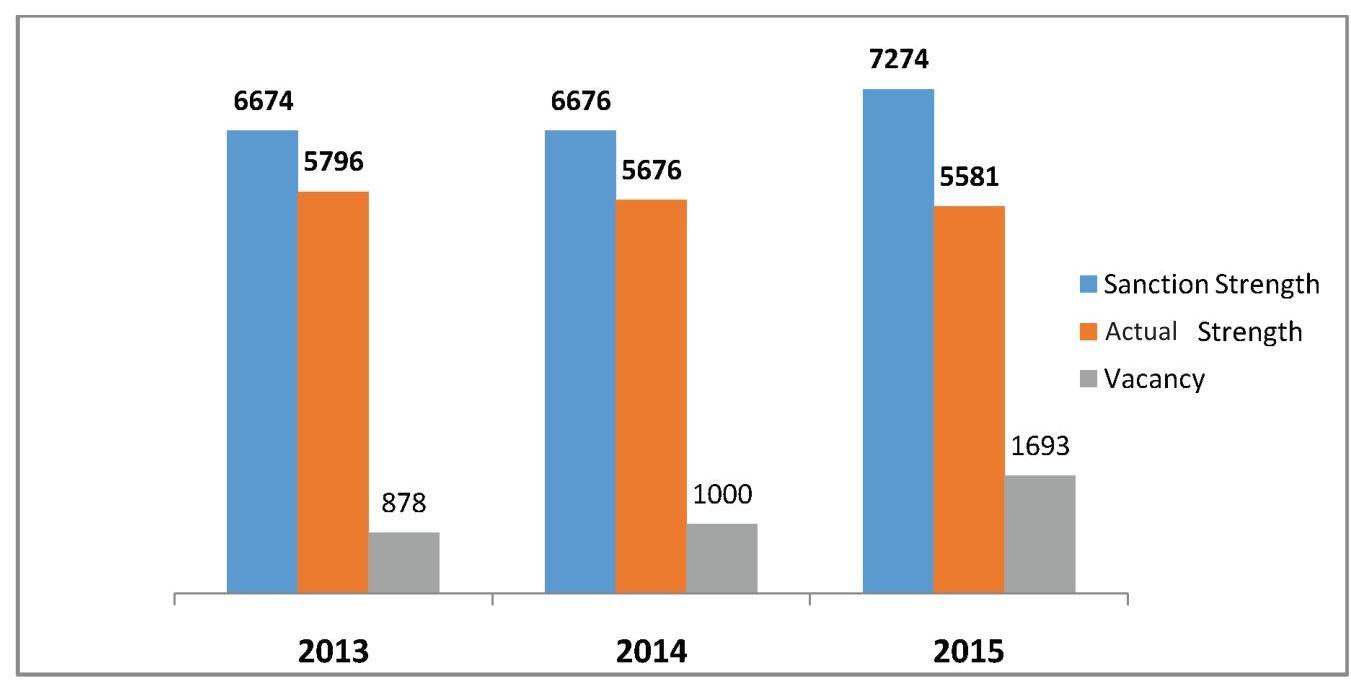
CRIME INVESTIGATION WORK
11.20 During 2015, 1135 Regular Cases / Preliminary Enquiries were registered. 34 of these were taken up on the requests of States Governments / Union Territories and 292 on the directions of the Constitutional Courts. 831 Regular Cases and 198 Preliminary Enquiries were finalised during the year. At the end of year, 1113 cases (RC/PE) were pending Investigation / Enquiry. During the year, 1044 Prosecution were
launched and judgements were received in 932 Court Cases. The Conviction Rate for 2015 was $65.1 %$. There were as many as 9449Court Cases pending in various Courts at the end of year.
REGISTRATION
11.21 The 1135 cases registered during 2015 comprised 971 Regular Cases (RCs) and 164 Preliminary Enquiries (PEs). Out of these, 185 cases were registered for demand of bribe
by public servants for showing official favours and 67 cases were registered for possession of Disproportionate Assets to known sources of their income. The comparative figures of registration of cases /enquiries during the last three years are depicted in the Bar Chart below:
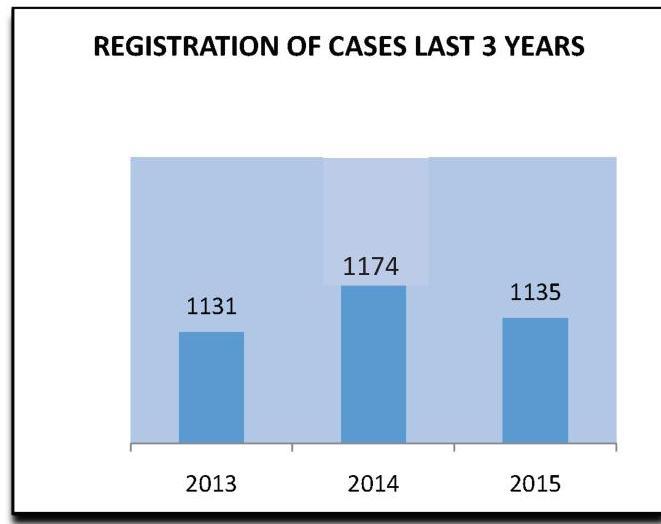
INVESTIGATION
11.22 During 2015, investigation was completed in 831 Regular Cases (RCs) and 198 Preliminary Enquiries (PEs).The following Bar Chart indicate the disposal of cases (RC/PE) enquiries from Investigation/Enquires during the last three years:
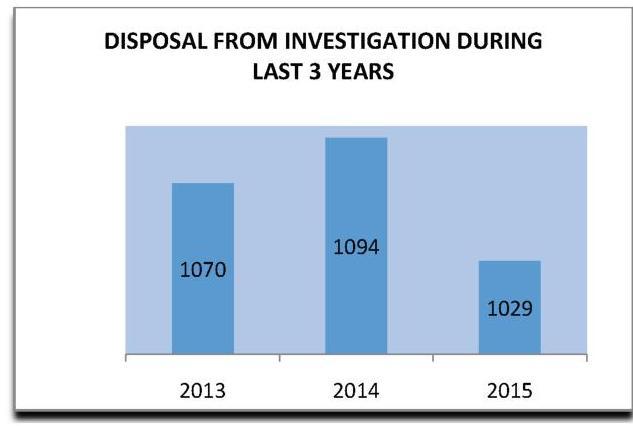
11.23 The following Pie Chart gives the mode of the disposal of cases [RCs/PEs] from investigation/Enquiry during 2015:
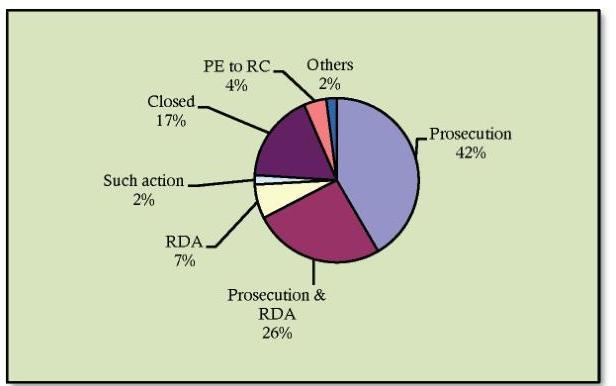
11.24 A total of 1113 cases [RCs/ PEs] were under Investigation/ Enquiry at the end of the year as against 1004 RCs/PEs under investigation/ enquiry at the end of 2014. The following Bar Chart show the comparative figures for the last three years:
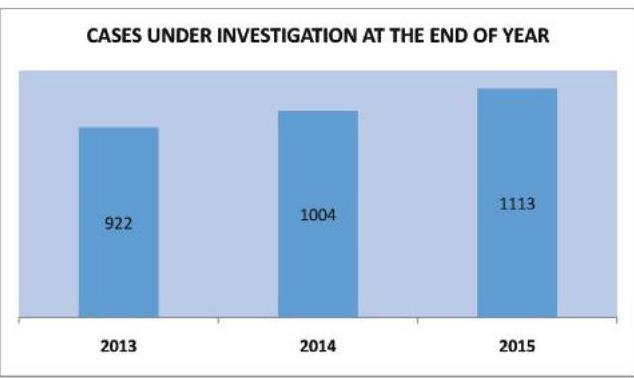
11.25 There were 317 cases under investigation for more than one year as on December 31, 2015. The following Bar Chart show pendency of such cases at the end of 2013, 2014 and 2015:
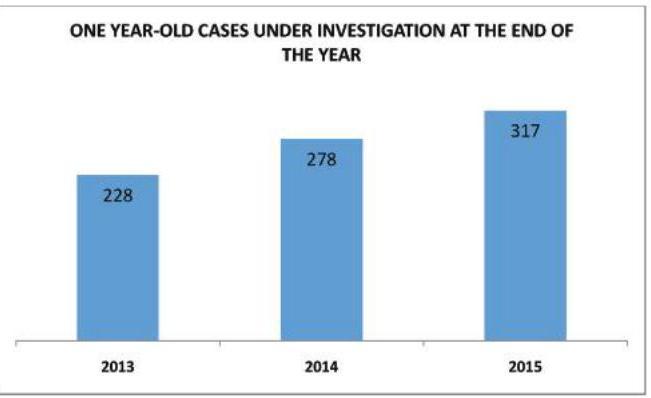
TRIAL
11.26 During the year 2015, 1044 Prosecution were launched and Courts delivered Judgements in 932 Court Cases. Out of these, 556 cases resulted in Conviction, 262 in Acquittal, 36 in Discharge and 78 cases were disposed of for other reasons. The conviction rate was $65.1 %$. The Bar Chart below show the disposal by courts during the last three years:
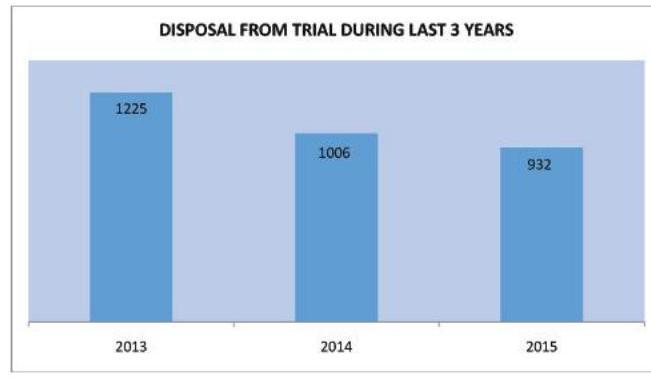
11.27 The following Bar Chart shows breakup of cases decided by the courts during the year 2015 :
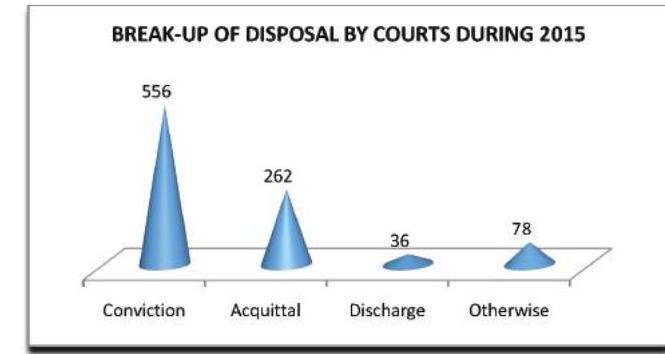
11.28 9449 trials were pending in various courts as on December 31, 2015. The Bar Chart below show the number of pending under trial cases during last three years:
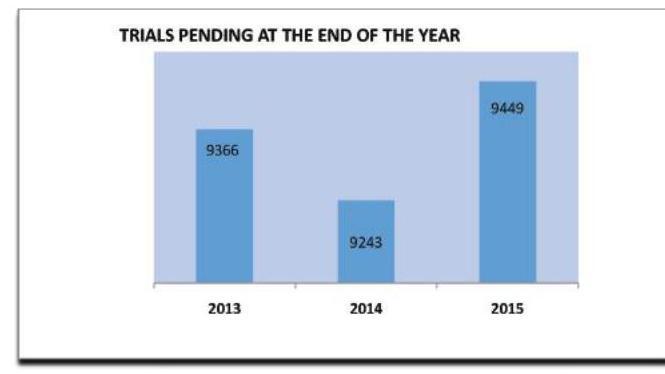
INTERNATIONAL INVESTIGATION AND COORDINATION
11.29 India joined INTERPOL in the year 1949. The Ministry of Home Affairs, Government of India by a circular dated $18^{\text {th }}$ March, 1949 issued to all State Governments and Union Territories, designated the Intelligence Bureau as the ICPO-INTERPOL, the National Central Bureau for India. After the formation of CBI in the year 1963, vide its circular dated 17.10.1966, the Government of India, conveyed its decision that the Central Bureau of Investigation will henceforth be the representative of this country for the purposes of correspondence with the International Criminal Police Organisation(ICPO, popularly known as INTERPOL, its call sign for radio and wireless communication). Accordingly, the INTERPOL work was transferred from Intelligence Bureau to the Central Bureau of Investigation, an investigating agency under the administrative control of Department of Personnel and Training. All matters relating to the NCB India are, however, dealt with by the Ministry of Home Affairs, Government of India. The NCB India functions as an integral part of CBI, with Director, CBI being its ex-officio Head.
11.30 The mandate of NCB-India is to secure greater cooperation and share information amongst law enforcement organizations throughout the world. Pursuant to its delegated authority, NCB-India’s primary functions are:
- To facilitate international law enforcement cooperation;
- To transmit information of a criminal justice, humanitarian, or other law enforcement related nature between domestic and foreign law enforcement agencies in INTERPOL member countries, and
- To coordinate and integrate information in investigations of an international nature.
11.31 As the National Central Bureau for India, CBI is authorized unrestricted access to INTERPOL’s secure, encrypted communications network, as well as its entire array of investigative databases. Populated with millions of records contributed by INTERPOL’s 190 member countries, these databases contain vital investigative information on international fugitives; stolen and lost travel documents; missing persons; unidentified bodies; images of child sexual abuse and other matters of investigative interest. This capability facilitates law enforcement interaction in real time on investigative matters ranging from simple criminal history checks to the sharing of sensitive criminal intelligence and investigative leads targeting transnational organized crime groups.
11.32 In addition, NCB, India is exclusively responsible for securing the publication of INTERPOL Notices – a system of international lookouts or advisories used to assist law enforcement authorities in locating fugitives, identifying suspects and other investigative purposes on behalf of Indian law enforcement agencies and for ensuring that such notices published on behalf of other member countries are entered and maintained. NCB, India also supports the exchange of international humanitarian assistance requests involving such matters as death notifications and health & welfare checks on Indians overseas, as well as foreign nationals in India.
11.33 NCB, India, part of International Police Cooperation Unit (IPCU), of CBI functions around the year on 24×7 basis. It is solely dedicated and equipped to assist the Indian law enforcement
agencies and their foreign counterparts in overcoming the very real cultural, linguistic and legal barriers that hinder the exchange of criminal investigative information and support across national administrations and boundaries including situations where diplomatic relations may not exist. Even for Indian law enforcement agencies, with a well-developed international criminal investigative presence, NCB-India’s services are complementary, not competitive or duplicative.
11.34 In all instances, NCB India serves to coordinate Indian law enforcement actions and responses, ensuring that it is consistent with Indian interests and law, as well as INTERPOL policies, procedures, and regulations. This includes strict adherence to Article 3 of the INTERPOL Constitution, which expressly forbids the Organization to “…undertake any intervention or activities of a political, military, religious or racial character.”
11.35 The mission of NCB-India, IPCU, CBI, encompasses a broad spectrum of activities and responsibilities that support the effective administration of justice and security of the nation by effectively combating transnational criminal threats. In carrying out these wideranging responsibilities, NCB-India utilizes the services of State Police by creating a network of INTERPOL Liaison Offices (ILOs), generally State CID/Crime Branch, Central Police and law enforcement Organizations, among others.
CONFERENCES/WORKSHOPS ORGANIZED DURING 2015
$6^{\text {th }}$ Global Focal Point Conference on Asset Recovery and $21^{\text {st }}$ Conference of CBI & State ACB/Vigilance Bureau 19.11.2015
11.36 The $6^{\text {th }}$ Global Focal Point Conference-2015 was held during 17-19
November, 2015 at ITC Maurya Hotel, New Delhi. Shri Narendra Modi, the Hon’ble Prime Minister of India, inaugurated the event in the distinguished presence of NSA and Secretary General, INTERPOL on 18.11.2015 at Vigyan Bhawan. More than 120 delegates from 50 countries participated in the meeting organized by Central Bureau of Investigation (CBI), INTERPOL and the StAR (Stolen Asset Recovery)an Initiative of World Bank and United Nations Office on Drugs and Crime (UNODC). During the same time, $21^{\text {st }}$ Conference of CBI \& State ACB/Vigilance Bureau was also held at Vigyan Bhawan.
US DOJ Workshop at CBI Headquarters:-
11.37 A three-day workshop was jointly organized by CBI, Ministry of Home Affairs, Ministry of External Affairs (Government of India) and the US Department of Justice (USDOJ) from 4-6 February 2015 at CBI Headquarters, Lodhi Road, New Delhi. The key theme of the workshop was ‘Obtaining Evidence Located in USA’. The workshop focused on procedures adopted by both the countries to seek and provide Mutual Legal Assistance, the provisions of IndiaUSA Mutual Assistance Treaty including Asset Recovery/Forfeiture and Extradition procedures. The workshop also discussed ways to obtain information related to Bank Accounts and Digital Evidence from USA and the related laws of USA and cyber crime issues, which are transnational in nature.
Workshop on Counterfeit Medicines in Collaboration with France:-
11.38 A two day Advanced Training Programme and Seminar on “Tackling the issue of Counterfeit Medicines” was organized at CBI HQ, New Delhi from 23-24 June, 2015 in collaboration with the French Embassy and International
Institute of Research against Counterfeit Medicines (IRACM), Government of France.The workshop was inaugurated by Director, CBI and participants included officers from CBI, Central Drugs Standard Control Organization, Customs and Law Enforcement officers from some States and UTs. This operations oriented seminar was inaugurated by the Ambassador of France in India, Mr. François Richier, the Director of CBI, Shri Anil Sinha and the Head of the Central Drugs Standard Control Organization, Shri G.N. Singh.
VISIT OF DELEGATIONS TO CBI HEADQUARTERS:-
Delegation to Review Implementation of UNCAC: 13.10.2015
11.39 A delegation consisting of governmental experts from Kazakhstan, Uganda and UNODC Secretariat visited India/CBI HQ during their country visit to review the Implementation of the United Nations Convention against Corruption (Chapter III and IV).
Delegation from Bangladesh at CBI, Headquarters, New Delhi – dated: 14.09.2015
11.40 A six-member delegation from AntiCorruption Commission of Bangladesh, headed by Mr. Mohammad Badiuzzaman, Chairman, ACC also visited CBI HQ on 14.09.2015 and CBI Academy, Ghaziabad on 15.09.2015.
Delegation from Mauritius High Commission, New Delhi dated: 27.05.2015
11.41 A delegation from Mauritius headed by Mr. JoykerNayeck, Charge-d-Affaires, Mauritius High Commission, New Delhi visited CBI, Headquarters, New Delhi on 27.05.2015 and the delegation interacted with Director CBI and other senior officers of CBI.
Israeli delegation to CBI HQ, New Delhi on 24.03.2015
11.42 A delegation headed by Deputy Director General, Mr. Eliezer Rosenbaum from Israel Ministry of Public Security visited CBI HQ on 24.03.2015 and interacted with Director CBI and other senior officers in respect of issues of capacity building.
German delegation to CBI HQ, New Delhi on 20.03.2015
11.43 A 15 member Bavarian Parliamentary Committee on Municipal Affairs, Internal Security and Sports from Bavaria, Germany, headed by Dr Herrmann Floran, Chairman, visiting India to strengthen the existing ties between the State of Bavaria and India, visited CBI HQ on 20.03.2015. They interacted with Director CBI and other senior officers.
Delegation from the Republic of Yemen at CBI HQ, New Delhi on 20.01.2015
11.44 A delegation of Supreme National Authority for Combating Corruption (SNACC) from the Republic of Yemen visited CBI HQ on 20.01.2015 and interacted with senior officers of CBI. The delegation was headed by Ms. Afrah Saleh Mohammed Badwilan, Chairperson of SNACC.
FOREIGN VISITS OF CBI OFFICERS
11.45 During the year 2015, a total number of 58 CBI officers attended various international Capacity Building Programmes/training courses, investigations, etc. as against 67 in 2014.
11.46 LETTERS ROGATORY (OUTGOING)
- During the year 2015, a total of 81 LRs were sent abroad out of which 48 LRs pertain to CBI cases and 33 pertain to
State Law Enforcement and Central Law Enforcement agencies.
- During the year 2015, 66 Execution reports (relating to 58LRs) have been received from Foreign Law Enforcement Agencies.
- It was confirmed by Indian Law Enforcement Agencies including CBI that 21 LRs are fully executed in the year 2015. These 21 LRs include 19 LRs of CBI and 2 of State Police and other Law Enforcement Agencies.
- Further during 2015, 08 LRs were either returned/withdrawn or disposed off. These include 2 LRs of CBI and 6 LRs of State Police Agencies.
- As on 31.12.2015, a total of 343 LRs are pending with other countries out of which 229 pertain to CBI cases and 114 pertain to State Police and other Central Law Enforcement Agencies.
LETTERS ROGATORY (INCOMING)
11.47 During the year 2015, as many as 76 Letters Rogatory (LRs)/Treaty Based Requests were received from various countries requesting to provide assistance in investigation of criminal matters. Execution Reports in 64 cases were sent to MEA after receiving the same from the various INTERPOL Liaison Offices (generally State CID/Crime Branch/CBI Branches) for onward transmission to the law enforcement agencies of the requesting countries. Besides these, 2 cases were closed and 2 were withdrawn by requesting countries. As on 31.12.2015, 84 LRs are pending for execution.
ASSISTANCE IN FORMULATION/ NEGOTIATION OF TREATIES AND
EXTRADITION/DEPORTATION
11.48 IPCU has participated in the negotiation of MLAT/Extradition treaties/Joint Working Group meetings with the following country during the year 2015:-
Sultanate of Oman
11.49 India and Sultanate of Oman signed a treaty on Mutual Legal Assistance in criminal matters which will help improve effectiveness in investigation of transnational crimes including terrorism. Mutual Legal Assistance Treaty was one of the significant legal instruments to improve effectiveness of the contracting states in investigation and prosecution of transnational crime including terrorism by providing the necessary framework for assistance.
EXTRADITION/DEPORTATION
11.50 The data pertaining to Red Notices published, Red Notice subjects arrested in India/ abroad and Red Notice subject extradited to India during the year 2015 is as under :-
| Red Notices published by NCB-India | 79 |
|---|---|
| Fugitives wanted by India, arrested in India |
22 |
| Fugitives wanted by India, arrested/ located in foreign countries |
42 |
| Fugitives wanted by other countries, arrested/located in India |
08 |
| Fugitives extradited/deported to India from foreign countries |
11 |
| Fugitives extradited/deported from India to foreign countries |
03 |
Details of the fugitives deported/extradited to India in 2015
Vitta Vila Antony Das, Red Notice No.
A-7990/10-2014 Wanted by NIA-New Delhi
11.51 The Authorities of UAE extradited Antony Das Vitta Vila, wanted by National Investigation Agency for the offences pertaining to the counterfeiting of currency notes and other charges on 27.01.2015 and NIA, New Delhi took the fugitive under custody.
Jagtar Singh @ Tara, Red Notice No.A-7067/92014, Wanted by ILO-Punjab
11.52 The Authorities of Thailand deported Jagtar Singh @ Tara, wanted by Punjab Police for the offence charged for Murder and other crimes on 17.01.2015.
Yusuf MohsinPoonawala, Red Notice No. A-2384/3-2012
11.53 Yusuf MohsinPoonawala, wanted by Mumbai Police for the charges of criminal conspiracy for cheating and forgery, was arrested in UAE and deported to India on 06.08.2015.
VashishthaPrakar, Red Notice No.A-5547/72015, Wanted by Delhi Police
11.54 The fugitive, VashishthaPrakar, wanted by Delhi Police for the charges against criminal breach of trust, cheating, forgery and criminal conspiracy, was deported to Delhi from Abu Dhabi on 16.08.2015.
KondiyaraVelayudhan Suresh, Red Notice No. A-7816/10-2014, Wanted by CBI/SCB/ Thiruananthapuram
11.55 The subject, KondiyaraVelayudhan Suresh, wanted by CBI, Thiruvananthapuram for the various charges like criminal conspiracy, wrongful restraint, kidnapping was extradited to India from UAE on 10.10.2015.
Marshu Bin Majed, Red Notice No.A-7096/92015, Wanted by CBI/ACB/Cochin
11.56 Marshu Bin Majed, wanted by CBI, Cochin for the charges of criminal conspiracy and cheating was deported to New Delhi from UAE on 01.11.2015
Bannanje Rajendra @ Raja, Red Notice No. A-3997/10-2009 Wanted by Karnataka Police
11.57 A notorious gangster, Bannanje Rajendra @ Raja, wanted by Karnataka Police in about 30 cases for the charges of murder, extortion, attempt to murder in the State of Karnataka, was located at Morocco on 10.02.2015. He was successfully extradited to India from Morocco on 13.08.2015.
NikaljeRajendraSadashiv @ ChhotaRajan @ Vijai Nana Khelkar@ RajanNikalje @ Nikhalje (Red Notice No. A-360/7-1995), Wanted by: Maharashtra Police, CBI & Delhi Police
11.58 A notorious fugitive, NikaljeRajendra Sadashiv @ ChhotaRajan was arrested by the authorities of Indonesia in Bali on October 25, 2015. He was deported to New Delhi on 06.11.2015. The fugitive, ChhotaRajan is wanted in connection with more than 75 criminal cases.
GolapBaruah @ AnupChetia @ SunilBaruah, @ Bhaijan @ Ahmed, Red Notice No.A-341/71997 Wanted by Assam Police
11.59 The fugitive, GolapBaruah, wanted by CBI and Assam Police for the charges of terrorist activities and being a member of terrorist organization, was arrested in Bangladesh. He was extradited to India on 11.11.2015.
Reddy Kollam Gangi @ Kollam Gangi Reddy, Red Notice No. A-7243/9-2014 Wanted by Andhra Pradesh Police
11.60 The notorious red sanders smuggler, Kollam Gangi Reddy, wanted by the Andhra Pradesh Police, was deported from Mauritius on 15.11.2015.
Willy Naruenariwanich@ Willy Narue, Red Notice No.A-4138/7-2011 wanted by NIA, New Delhi
11.61 The subject, Willy Naruenariwanich, wanted by NIA, New Delhi for the charges of criminal conspiracy, waging war against country, punishment for terrorist act, being member of terrorist gang/organization. He was arrested in Thailand and extradited to India on 09.12.2015.
LOCAL PROSECUTION OF FUGITIVES WANTED BY OTHER COUNTRIES
11.62 During 2015 a total of 31 fugitives wanted by UAE & Saudi Arabia were located in India. As the said fugitives are Indian Nationals, they will be dealt with local prosecution in India in lieu of Extradition.
11.63 Matter relating to issue of notification under DSPE Act, 1946 to investigate and prosecute the offences as described under section 4 of IPC, i.e., the offences committed outside territorial jurisdiction of India referred by Central Government and to designate CBI as nodal authority to deal with and obtain sanction for prosecution from Ministry of Home Affairs under section 188 Cr.PC has been pending with DoPT.
FUGITIVES WANTED BY OTHER COUNTRIES DEPORTED / EXTRADITED FROM INDIA
SabooniShahin, Red Notice No.A-4537/11-2009 Wanted by USA
11.64 SabooniShahin, wanted by USA for the charges of conspiracy to defraud the U.S. Government and violate the International Emergency Economic Power Act (AECA), conspiracy to commit money laundering etc. She was extradited to USA on 16.02.2015 from India.
Amit Muddamalle Livingston @ Andy, Red Notice No.A-519/3-2008 Wanted by USA
11.65 Amit Muddamalle Livingston was wanted by USA for the charges of murdering his girlfriend, Ms. HermiliaHernander on 13.02.2007. He was extradited to USA on 13.07.2015 from India.
Simardeep Singh Red Notice No.A-6006/8-2014 Wanted by Australia
11.66 Simardeep Singh, wanted by Australia for the offences of Sexual Assault, was extradited to Australia on 12.08.2015 from India.
INTERPOL Stolen and Lost Travel Documents (SLTD) Database:
11.67 NCB, India has uploaded data relating to lost/fake/stolen/revoked Indian passports into the INTERPOL SLTD Database being maintained by IPCU Branch. During the year 2015, a total of 201 cases of use of fake/lost/stolen passports were reported by foreign NCBs.
INTERPOL Global Communication System [IGCS] messages received during 2015:-
11.68 The four Regional Desks have received as many as 8032 requests / IGCS message/ letters from January 2015 to December 2015 regarding identity check, arrest message, conviction details, driving license check, identification of finger prints, missing persons, deportation, drug trafficking, searches and registration of thefts of antiquities stolen from India etc. from various NCBs, PLOs and Indian Law Enforcement agencies/ authorities. During the period under review, the four regional desks of NCB-India also worked in close coordination with other NCBs and rendered necessary guidance to them on various issues.
TRAINING
11.69 In the year 2015, CBI Academy and the three RTCs conducted a total of 108 courses and trained 3020 Officers/Officials.
| No. of Courses | No. of Participants | Total | ||
|---|---|---|---|---|
| CBI | Non-CBI | |||
| CBI Academy | 75 | 1277 | 1143 | 2420 |
| RTC, Kolkata | 12 | 139 | – | 139 |
| RTC, Mumbai | 09 | 119 | – | 119 |
| RTC, Chennai | 12 | 342 | – | 342 |
| Total | 108 | 1877 | 1143 | 3020 |
Chapter 12
JOINT CONSULTATIVE MACHINERY
12.0 The Scheme for Joint Consultative and Compulsory Arbitration for the Central Government Employees was introduced in the year 1966 on the lines of the Whitely Councils in the U.K. The scheme provides a platform for constructive dialogue & discussion between the representatives of the staff side and the official side for peaceful resolution of all disputes between the Government as employer and the employees. The scheme was introduced with the objectives of promoting harmonious relations and securing the greatest measure of cooperation between the Central Government as the employer and the employees in matters of common concern and with the object of further increasing the efficiency of the public service combined with the well being of those employed.
12.1 The JCM Scheme provides for three tier machinery:
(i) the National Council as the apex body; (chaired by the Cabinet Secretary);
(ii)Departmental Councils at the level of individual Ministries / Departments including their attached and subordinate offices and (chaired by respective Secretaries); and
(iii) Regional / Office Councils to deal with mainly the local problems at the level of each individual office, depending on its structure. (chaired by Head of office of respective organizations).
12.2 The scope of the JCM Scheme includes all matters relating to:
- conditions of service and work;
- welfare of the employees; and
- improvement of efficiency and standards of work,
Provided, however, that
(i) In regard to recruitment, promotion and discipline, consultation is limited to matters of general principles; and
(ii) Individual cases are not considered.
12.3 Under the JCM Scheme, there have been continuous interactions with staff unions at the National level as well as at the Departmental level and a number of important issues have been resolved amicably through mutual discussions.
Standing Committee Meeting
12.4 Meeting of Standing Committee of National Council (JCM) Staff side was held on $9^{\text {th }}$ October, 2015 under the joint Chairmanship of JS(AV), DOP\&T to discuss the issues raised in the Charter of Demands by the Staff Side.
National Anomaly Committee
12.5 As per the request of Staff Side to discuss the pending anomalies arising out of $6^{\text {th }} \mathrm{CPC}$, a meeting was held on 29.5.2015, with the representatives of the Staff Side under the Chairpersonship of Joint Secretary (Establishment), DoPT.
In continuation of meeting held on 29.05.2015, another meeting of the National Anomaly Committee (NAC) was held on 09.06.2015 under the Chairpersonship of Joint Secretary (Establishment), Deptt. of Personnel \& Training.
Chapter 13
ADMINISTRATIVE TRIBUNALS
13.0 The Administrative Tribunals Act owes its origin to Article 323-A of the Constitution of India which empowers Central Government to set up by an Act of Parliament Administrative Tribunals for adjudication of grievances and disputes arising out of the conditions of service of an employee appointed to the public services and posts in connection with the affairs of the Union and the States. In pursuance of the provisions contained in the Administrative Tribunals Act, 1985, the Administrative Tribunals, set up under it, exercise original jurisdiction in respect of service matters of employees covered by the Act. As a result of the judgment dated $18^{\text {th }}$ March, 1997 of the Supreme Court in the case of L. Chandra Kumar & Others. Vs. UOI, the appeals against the orders of an Administrative Tribunal shall lie before the Division Bench of the concerned High Court.
13.1. The Administrative Tribunals are distinguishable from the ordinary courts with regard to their jurisdiction and procedure. They exercise jurisdiction only in relation to the service matters of the Original Applicants covered by the Act. They are also free from many of the procedural technicalities of the ordinary courts. The procedural simplicity of the Act can be appreciated from the fact that the aggrieved person can also appear before the Tribunal personally. Government can also present its cases through its departmental officers or legal practitioners. Further, only an affordable and nominal fee of Rs.50/- is to be paid by the
Applicants for filing the original applications before the Tribunal. Thus, the objective of the Tribunal is to provide speedy and affordable redress to the aggrieved applicants arising out of employment or conditions of service.
13.2. The Central Administrative Tribunal (CAT) was set up on $1^{\text {st }}$ November 1985. At present, it has 17 regular Benches, 15 of which operate at the principal seats of High Courts and the remaining two at Jaipur and Lucknow. These Benches also hold Circuit sittings at other seats of High Courts. A statement showing the location of Central Administrative Tribunal Benches, the dates of their establishment and the number of courts in each of these Benches along with a list of places where they hold circuit sittings is given in Appendix-I.
13.3 The Tribunal consists of a Chairman and Members. It has also been the constant endeavour of this Ministry that the posts of Chairman and Members are filled up well in time and no post remains vacant for long time. The Members of Central Administrative Tribunal (CAT) and State Administrative Tribunals (SAT) are drawn from judicial as well as administrative streams, so as to give the Tribunal the benefit of domain expertise, both in legal and service matters. The sanctioned strength of the Chairman is one and sanctioned strength of the Members of Central Administrative Tribunal is 65 out of which 32Judicial Members and 33 are Administrative Members. The appointment of Members in CAT is made on the basis of recommendations of a
high powered Selection Committee chaired by a sitting Judge of Supreme Court who is nominated by the Hon’ble Chief Justice of India. After obtaining the concurrence of Chief Justice of India, appointments are made with the approval of Appointments Committee of the Cabinet (ACC).
13.4. State Administrative Tribunals were also set up in the following States –
(i.) Andhra Pradesh
(ii.) Orissa
(iii.) Karnataka
(iv.) Madhya Pradesh
(v.) Maharashtra
(vi.) Tamil Nadu
(vii.) West Bengal
(viii.) Kerala and
(ix.) Himachal Pradesh
However, the SATs in Madhya Pradesh, Himachal Pradesh and Tamil Nadu Administrative Tribunals were abolished on the request of the concerned State Governments. But subsequently Himachal Pradesh re-established the SAT and the state of Tamil Nadu has also requested now to re-establish the same.
13.5 The appointments to the vacancies in State Administrative Tribunals are made on the basis of proposals sent by the State Governments with the approval of the Governor. Thereafter, their appointments undergo the same process as the one in respect of Central Administrative Tribunal.
13.6 Since its inception in 1985 and upto $31^{\text {st }}$ December, 2015, the Central Administrative Tribunal received 7,08,131 cases for adjudication (including those transferred from High Courts), out of which $6,66,914$ cases have been disposed of leaving a pendency of 41,217 cases. On an average more than $90 %$ of the cases instituted during the year are disposed off. A statement indicating the
institution, disposal and pendency of cases since inception of CAT is at Appendix-II.
13.7 Section 14(2) of the Administrative Tribunals Act, 1985 empowers the Central Government to extend the provisions of the Act to local or other authorities within the territory of India or under the control of Government of India and to Corporations or Societies owned or controlled by Government of India. In exercise of these powers, the Central Government had extended the provisions of the Act to 208 organizations so far.
13.8 In order to familiarize the newly appointed Members of CAT with the functioning of the Tribunal, a short Orientation Programme / Training is held once in a year. So far four such Orientation Programme / Training have been held and the last such Training was organized in February, 2014 at the National Judicial Academy, Bhopal.
13.9 Further, for maintaining absolute integrity and promoting fair practices in the professional court dealings and keeping in view the general directions of the Hon’ble Supreme Court, the designated Selection Committee, on its meeting held on $19^{\text {th }}$ February, 2016 has decided that a Judicial Member of CAT, who earlier practiced as Advocate in a Court in that station, should not normally be considered for posting in the CAT Bench of the same station.
13.10 Justice Shri Syed Rafat Alam was appointed as Chairman, CAT with effect from 08.08.2012. However, he has tendered resignation and the competent authority has accepted his resignation with effect from 11.04.2016 or assumption of charge by his successor, whichever is earlier. The process to appoint his successor is under way. Before his appointment as the Chairman, CAT, Justice Shri Alam was the Chief Justice of Allahabad High Court.
NAME, DATE OF SETTING, NO. OF COURTS AND ADDRESS ES OF VARIOUS BENCHES OF CENTRAL ADMINISTRATIVE TRIBUNAL
| S.No. | Name of the Bench | Date of setting | No. of courts | Address |
|---|---|---|---|---|
| 1. | PRINCIPAL | 01.11.1985 | 6 | NEW DELHI |
| 2. | AHMEDABAD | 30.06.1986 | 1 | AHMEDABAD |
| 3. | ALLAHABAD | 01.11.1985 | 4 | ALLAHABAD |
| 4. | BANGALORE | 03.03.1986 | 2 | BANGALORE |
| 5. | CHANDIGARH | 03.03.1986 | 2 | CHANDIGARH |
| 6. | MADRAS | 01.11.1985 | 2 | CHENNAI |
| 7. | CUTTACK | 30.06.1986 | 1 | CUTTACK |
| 8. | ERNAKULAM | 01.09.1988 | 2 | ERNAKULAM |
| 9. | GUWAHATI | 03.03.1986 | 1 | GUWAHATI |
| 10. | HYDERABAD | 03.06.1986 | 2 | HYDERABAD |
| 11. | JABALPUR | 30.06.1986 | 1 | JABALPUR |
| 12. | JAIPUR | 15.10.1991 | 1 | JAIPUR |
| 13. | JODHPUR | 30.06.1986 | 1 | JODHPUR |
| 14. | CALCUTTA | 01.11.1985 | 2 | KOLKATA |
| 15. | LUCKNOW | 15.10.1991 | 1 | LUCKNOW |
| 16. | MUMBAI | 01.11.1985 | 2 | MUMBAI |
| 17. | PATNA | 30.06.1986 | 2 | PATNA |
STATEMENT SHOWING THE NAME OF BENCH AND PLACES WHERE CIRCUIT SITTINGS ARE HELD
BENCHES
- ALLAHABAD BENCH
- CALCUTTA BENCH
- CHANDIGARH BENCH
- MADRAS BENCH
- GUWAHATI BENCH
- JABALPUR BENCH
- BOMBAY BENCH
- PATNA BENCH
- ERNAKULAM BENCH
PLACES
Nainital
Port Blair, Gangtok
Shimla, Jammu, Srinagar
Pondicherry
Shillong, Itanagar, Kohima,
Agartala, Imphal, Aizwal
Indore, Gwalior, Bilaspur
Nagpur, Aurangabad, Panaji
Ranchi
Lakshadweep
APPENDIX-II
STATEMENT SHOWING THE POSITION OF INSTITUTION, DISPOSAL AND PENDENCY OF CASES IN THE CENTRAL ADMINISTRATIVE TRIBUNAL SINCE INCEPTION UPTO Nov.’2015.
(As provided by Central Administrative Tribunal, Principal Bench from time to time)
| S.NO. | PERIOD (Year) |
INSTITUTION | DISPOSAL | PENDENCY AT THE END OF THE PERIOD |
|---|---|---|---|---|
| 1. | 1985 | 2963 | 30 | 2933 |
| 2. | 1986 | 23177 | 8934 | 17176 |
| 3. | 1987 | 19410 | 15084 | 21502 |
| 4. | 1988 | 19425 | 13769 | 27158 |
| 5. | 1989 | 18602 | 13986 | 31774 |
| 6. | 1990 | 19283 | 15495 | 35562 |
| 7. | 1991 | 21623 | 17552 | 39633 |
| 8. | 1992 | 25184 | 23782 | 41035 |
| 9. | 1993 | 27067 | 28074 | 40028 |
| 10. | 1994 | 26230 | 26409 | 39849 |
| 11. | 1995 | 25789 | 23668 | 41970 |
| 12. | 1996 | 23584 | 20667 | 44887 |
| 13 | 1997 | 23098 | 21981 | 46004 |
| 14. | 1998 | 21911 | 18394 | 49521 |
| 15. | 1999 | 22944 | 24566 | 47899 |
| 16. | 2000 | 25146 | 31398 | 41647 |
| 17. | 2001 | 25977 | 31953 | 35671 |
| 18. | 2002 | 25398 | 29514 | 31555 |
| 19. | 2003 | 25089 | 28076 | 28568 |
| 20. | 2004 | 23825 | 27735 | 24658 |
| 21. | 2005 | 21528 | 22408 | 23778 |
| 22. | 2006 | 18722 | 17774 | 24726 |
| 23. | 2007 | 17725 | 18674 | 23777 |
| 24. | 2008 | 18287 | 20352 | 21712 |
| 25 | 2009 | 24496 | 23681 | 22527 |
| 26. | 2010 | 26620 | 25477 | 23670 |
| 27 | 2011 | 25869 | 24750 | 24789 |
| 28 | 2012 | 27786 | 24259 | 28316 |
| 29 | 2013 | 27442 | 21654 | 34104 |
| 30 | 2014 | 27872 | 23767 | 38209 |
| 31 | 2015 | 26059 | 23051 | 41217 |
| Total | 7,08,131 | 6,66,914 | 41217 |
Chapter 14
STAFF WELFARE
14.0 The Central Government is the largest single employer in the country and bears the major responsibility for looking after the welfare of a large number of employees spread all over the country. Realizing that improvement in the working and living conditions of the employees and their families leads to efficiency and high morale, the Department of Personnel and Training supports various staff welfare measures. A brief account of various welfare measures dealt with by Welfare Division is given below.
Welfare Measures
RESIDENTS’ WELFARE ASSOCIATION
14.1 In order to foster a spirit of mutual help and goodwill among residents of Government colonies and to promote social, cultural and recreational activities, Department of Personnel & Training (DOPT) has been encouraging formation of Central Government Employees Residents Welfare Associations (CGERWA). Every CGERWA seeking reorganization and grants-in-aid from Government is required to adopt Model Constitution prescribed by DOPT. At present, there are 75 recognized Associations. The members of the Managing Committees of these Associations are elected every two years under the provisions of a Model Constitution framed by the Department of Personnel and Training. This Department sanctions grants-inaid only to recognized Associations, subject to a maximum of Rs.10,000/- per annum for an Association.
AREA WELFARE OFFICERS
14.2 The Area Welfare Officers (AWOs) are nominated in residential colonies having a large number of Central Government employees. The AWOs serve as a link between the Government and residents in matters relating to the welfare of Government employees living in various colonies. They also work as field officers in coordinating and maintaining liaison with various agencies of Government such as CPWD, CGHS, Police etc. Applications are invited from Gazetted Officers working in various Ministries/Departments for being nominated as Area Welfare Officers for a period of two years. Officers desirous of being nominated as AWOs on voluntary and honorary basis are required to apply through their respective Ministries/Departments.
CENTRAL GOVERNMENT EMPLOYEES WELFARE COORDINATION COMMITTEES (CGEWCCs)
14.3 The Central Government Employees Welfare Coordination Committees (CGEWCCs) have been formed outside Delhi, at places where there are at least five Central Government Offices and the total number of Central Government Employees is not less than 1000. These Committees are responsible for coordinating the welfare activities of the Central Government employees serving within their jurisdiction. The senior most officer at the station functions as the Chairman of the Committee. The quantum of grant based on the staff strength is sanctioned
by the Department of Personnel and Training to the CGEWCCs.
CENTRAL CIVIL SERVICES CULTURAL AND SPORTS BOARD
14.4 The Central Civil Services, Cultural & Sports Board, a society registered under the Societies Registration Act, 1860 is the Central agency for promotion of Cultural \& Sports activities amongst the Central Government employees in the country. The Board was set up in 1964 as Central Secretariat Club in the Ministry of Home Affairs. Initially the objective of the Board was to promote cultural and sports activities amongst the Central Government Employees located in Delhi only. Subsequently, Regional Sports Boards were set up in various cities. Financial grants-in-aid are sanctioned every year by the Board to the Regional Boards.
ACTIVITIES OF THE BOARD
INTER MINISTRY TOURNAMENTS 2015-16
14.5 The Board organized Inter-Ministry Tournaments in 18 Disciplines of Sports during the year 2015-16.
ALL INDIA CIVIL SERVICES TOURNAMENTS HELD DURING THE YEAR 2015-16.
14.6 These tournaments, which are open to Central and State Government employees aim to give an opportunity to the civil servants to meet and interact with each other and compete. In 2015-16 such tournaments were held in 11 disciplines namely Athletics, Aquatic, Badminton, Basketball, Carom, Chess, Kabaddi, Lawn Tennis, Table Tennis, Volleyball, and Wrestling.
SCHEME FOR PROMOTION OF ADVENTURE SPORTS \& SIMILAR
ACTIVITIES AMONGST CENTRAL GOVERNMENT EMPLOYEES
14.7 As welfare measure, the Department of Personnel and Training launched a Scheme for promotion of adventure sports and similar activities amongst Central Government Employees working in the Ministries/ Departments. The 5-7 days programme is having components of environmental awareness, disaster management, team spirit, capacity building, and Swachh Bharat Campaign and activities like Trekking, Mountaineering, Rock-Climbing, Cycling in a difficult terrain, Skiing, Rafting, Para Sailing, Jungle Safari and Environmental Awareness Camps etc.
14.8 It is expected that participation by Central Government Employees in adventure sports and similar activities will give them a platform where they would learn lessons from nature and use the knowledge acquired for welfare of the society. It would also foster spirit of risk-taking, cooperative team work, capacity of readiness, vital response to challenging situations, endurance and environmental awareness.
BOARD’S AFFILIATION TO NATIONAL FEDERATION
14.9 The Board is affiliated to a number of sports associations/federations at the National level. Board’s team participates in the National Tournaments organized by these Associations/ Federations.
TREKKING
14.10 The Board sponsors trekking programme for Central Government Employees in collaboration with the Youth Hostels Association of India. A part of expenditure on this programme is met by the Board.
SPORTS FACILITIES IN DELHI
14.11 The Board has a sports complex at Vinay Marg, New Delhi which has facilities for Football, Hockey, Cricket, Athletics, Lawn Tennis, Basketball, Volleyball and practice pitches for Cricket. The Board also maintains Lawn Tennis Courts at Brassy Avenue, Bharti Nagar and R.K.Puram Sector -13, New Delhi. Brassy Avenue, New Delhi has facilities for Volleyball and Cricket practice pitches also. There is facility for indoor games such as Table Tennis, Carrom and Chess at Nirman Bhawan, New Delhi.
COACHING CAMP FOR CHILDREN/ DEPENDENTS OF GOVERNMENT EMPLOYEES
14.12 The Board also conducts regular coaching in Cricket and Lawn Tennis for the children/dependents of Government employees at Vinay Marg Sports Complex, New Delhi. Coaching in Lawn Tennis is also available at Bharti Nagar and R.K. Puram Sector-13, New Delhi. Board also organizes Summer Coaching camp in Basketball, Cricket, Football, Self-defence and Lawn Tennis for children/dependents of government employees.
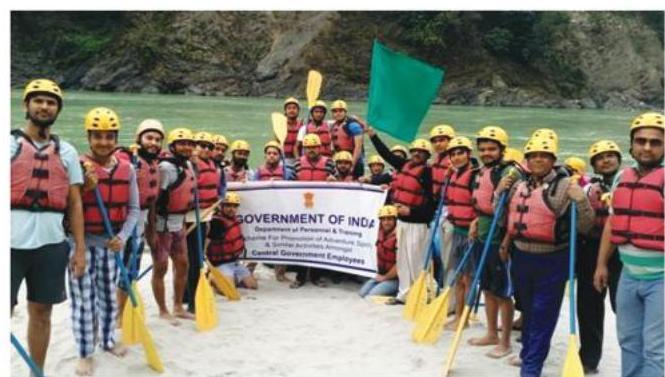
First Programme under the Scheme for Promotion of Adventure Sports and Similar Activities Amongst Central Government Employees
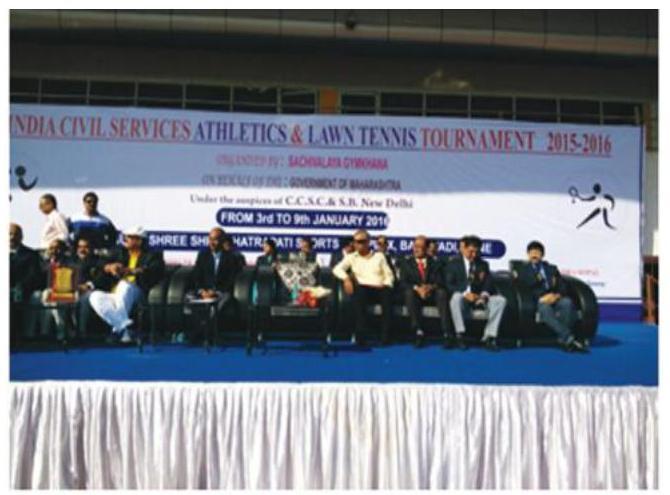
Inaugural Ceremony of All India Civil Services Athletics & Lawn Tennis Tournaments 2015-16 organized by Government of Maharashtra at Pune.
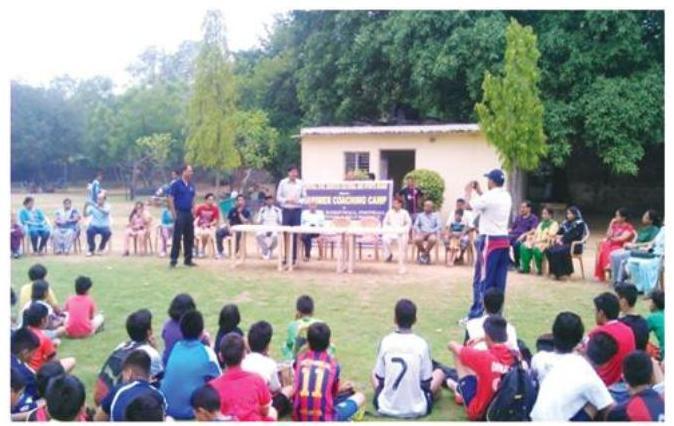
Summer Camp 2015 at Vinay Marg Sports Complex, New Delhi
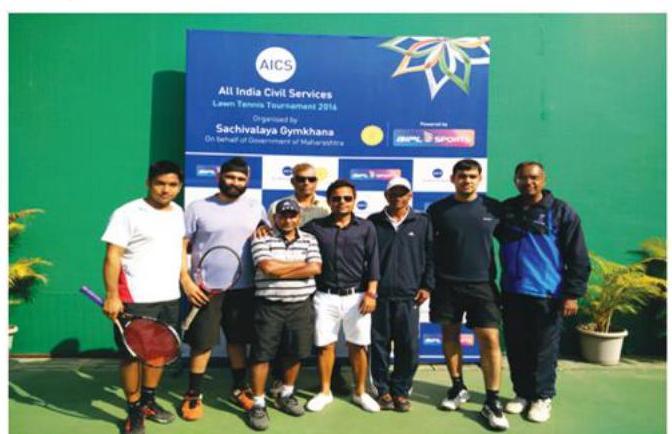
Runners-up Central Secretariat Team in All India Civil Services Lawn Tennis Tournament 2015-16
GRIH KALYAN KENDRA
14.13 The Grih Kalyan Kendra (GKK) is a registered Society under the Societies Registration Act, 1860 and functioning under the aegis of Ministry of Personnel, Public Grievances & Pensions.
14.14 The basic objectives of the Kendra, in brief are: –
a) To promote social, economic, cultural and educational activities for the welfare of Central Government Employees and their families.
b) To impart technical and vocational training in home crafts and other household arts for useful utilization of leisure time and for better and efficient housekeeping.
c) To organize and promote economic activities that may provide opportunities for gainful employment to families of Central Government employees for supplementing family income.
14.15 The GKK is administered by GKK Board. The Board is responsible for the organization and administration of GKK, Additional Secretary (S\&V), DOPT, is the President of the GKK Board.
14.16 In pursuance of its objectives, GKK has been conducting the following activities :
a) Training classes in cutting, tailoring and embroidery for the housewives and grown up girls during their leisure hours.
b) Nursery education for children in the age group of 3 to 5 years.
c) Creches or Day Care Centres for children between the age of 90 days to 10 years.
d) Recreational facilities like Health Club/ Gym, badminton and tennis, etc.
e) Coaching classes in Martial Arts, Yoga, Music, Dance, English Speaking Course, Computer, Brain Development, Fine Arts, Lawn Tennis etc.
14.17 The welfare activities run by Grih Kalyan Kendra are indicated in the table given below:
| Place | Number of Samaj Sadans/ Centres |
Craft Centres | Nursery Schools |
Creche Centres |
Health Clubs/ Gyms |
|---|---|---|---|---|---|
| Delhi | 37 | 9 | 15 | 10 | 9 |
| Mumbai | 7 | 4 | 4 | – | 1 |
| Chennai | 5 | 7 | 2 | 2 | 1 |
| Jaipur | 2 | 1 | – | 1 | – |
| Dehradun | 2 | 1 | 2 | – | – |
| Nagpur | 2 | – | – | – | 1 |
| Bangalore | 3 | – | – | – | 1 |
| Faridabad | 1 | 1 | 1 | 1 | – |
| Kolkata | 1 | – | – | – | – |
| Ghaziabad | 1 | – | – | – | – |
| Total | $\mathbf{6 1}$ | $\mathbf{2 3}$ | $\mathbf{2 4}$ | $\mathbf{1 4}$ | $\mathbf{1 3}$ |
14.18 The Grih Kalyan Kendra has undertaken the following activities during 2015-16.
i) 1800 children in Nursery Schools, 1450 Students in Craft Centres, 1010 Children in Creches, 2000 Users in Health Clubs/ Fitness Centres, 5000 in Outsourced Activities and 36000 in Yoga Activity have been availing the facilities.
ii) DOPT launched a Yoga training scheme w.e.f. 01.04 .2015 in association with Morarji Desai National Institute of Yoga, New Delhi for the benefit of Central Government employees and their dependants free of cost. The training sessions are conducted in 28 locations in Delhi and 12 Samaj Sadans of Grih Kalyan Kendra outside Delhi.Yoga Trainers have been selected by Morarji Desai National Institute of Yoga (MDNIY), New Delhi. These trainers have been engaged by Grih Kalyan Kendra, on contract basis for a period of one year. Government has allocated Rs. 2 crores for the scheme of Yoga Training sessions under the NonPlan Head in 2015-16.
(iii) 734 participants of Yoga Training Session at various Samaj Sadans in Delhi attended the International Yoga Day held on 21.06.2015. International Yoga Day was celebrated at the Samaj Sadans located outside Delhi namely, Kolkata, Chennai, Mumbai, Nagpur and Dehradun.
(iv) Free Medical and Eye check up camps are being conducted at different Samaj Sadans of Grih Kalyan Kendra (GKK) in Delhi for the benefit of Central Government and their dependants in association with M/s Rockland Hospital and M/s Sharp Sight Centre.
KENDRIYA BHANDAR
OBJECTS OF THE ORGANISATION
14.19 The Central Government Employees Consumer Cooperative Society Ltd., New Delhi, operating in the name of KENDRIYA BHANDAR was set up in 1963 in pursuance of Cabinet decision as a Welfare Project for the benefit of the Central Government Employees. The society endeavors to serve the Central Government Employees and general public at large by providing quality goods of daily needs at reasonable prices and consumer items through its retail stores. The range of items which Kendriya Bhandar provides includes consumer goods, grocery items, stationery and medicines etc.
MULTI STATE COOPERATIVE SOCIETY
14.20 The Society is registered under MSCS Act 2002, as a Multi State Co-operative Society and operates in Delhi and other States of the country.
At present there are 122 outlets of Kendriya Bhandar. Out of the 122 outlets, 102 retail stores in Delhi, 3 Jan Aushadi Generic Drug Shops and 2 Chemist Shops in Delhi besides 20 Regional Offices in some State Capitals. The Regional Offices are mainly into supply of Stationery and other items to the Government Offices.
SHARE CAPITAL
14.21 As on $31^{\text {st }}$ March 2015 Kendriya Bhandar had a paid-up capital of Rs. 97.14 lakhs of which Rs.68.18 lakhs have been subscribed by the Central Government and the rest by individual members.
MODERNISATION/AUTOMATION EFFORTS
14.22 Kendriya Bhandar has also undertaken the modernization of its retail stores including renovation, computerization etc. in order to provide a pleasant shopping experience to the customers and accordingly over 10 stores have been modernized over the last one year. This has also resulted in increase in customer’s footfall and significant increase in retail sales.
14.23 Debit/Credit Card swapping machines have been installed in 17 stores of Kendriya Bhandar for the convenience of customers.
SALES AND FINANCIAL PERFORMANCE
14.24 Kendriya Bhandar has registered significant growth in the recent past. Total sales during the year 2014-15 was Rs. 825.16 crores and the Net Profit after tax was Rs.3.53 crores respectively. Kendriya Bhandar has declared a dividend of $10 %$ for the year 2014-15.
BENEFITS TO CUSTOMERS
14.25 The Society has been able to maintain competitive prices for various products sold by it as compared to those prevailing in the market. In fact, selling prices prevailing in Kendriya Bhandar now are deemed as the bench mark in the market.
14.26 For better quality control, pre-testing of grocery items before distribution to stores has been introduced and testing of random samples picked from shelves of stores is also being continued. These steps ensure that the quality of goods sold is maintained for better consumer satisfaction.
14.27 It is pertinent to mention that the Society has been involved in welfare activities and has always assisted the Central Government and the Govt. of NCT of Delhi in arresting the price rise at the time of crisis. Recently, under the
directions from Ministry of Consumer Affairs, Govt. of India, Kendriya Bhandar has sold Tur/ Arhar Dal @ Rs.120/- per kg against prevailing market prices of Rs.200/- approx.
The Civil Service Society (Sanskriti School)
Introduction
14.28 The Civil Services Society is a society registered under the Societies Registration Act. The Society was set up in February 1995, by the wives of the officers of the All India and Allied Civil Services. The wife of serving Cabinet Secretary is the Chairperson of the Civil Services Society. The office of the Society is on Dr. S. Radhakrishnan Marg, Chanakyapuri, New Delhi – 110021.
Aims and Objectives
14.29 The aims and objectives of the society, interalia, are as under: –
- To establish progressive schools or other educational institutions in Delhi or outside Delhi, open to the children of officers of the All India and Central Services. Depending on the availability of seats, children of officers of the Public sector of non – government servants may also be admitted, at the discretion of the Governing Body.
- To impart sound and liberal education to boys and girls during their impressionable years – a type of education that will lay stress on character building, team work, esprit de corps, physical development and will infuse in school children a spirit of adventure, fair play and justice.
- To develop among its students a feeling of pride in Indian culture and to produce
citizens who will truly be global and rise above social, communal, religious and provincial prejudices.
14.30 The Society started its first school with the strength of 32 students, the Sanskriti School, in New Delhi, in the year 1998. The Chairperson of the Society is also the Chairperson of the School. Sanskriti School is a recognized integrated coeducational school, affiliated to the CBSE, offering education from Nursery through Class XII.
14.31 The Society believes that every child can and must realize his/her full potential, and towards this end, must be enabled through appropriate means. With this in mind, the School has a Learning Centre with Special Educators and Counselors guiding children who have special needs, through an Individual Education Program (IEP).
14.32 Likewise, for those from the relatively less privileged sections of society, the Society runs a parallel school Umang in the afternoon. Efforts are also made to mainstream some of the children. These children from the economically weaker sections are admitted through the admission process under the Delhi Education Act.
14.33 The Civil Services Society has set up a Centre for Excellence to promote teacher training initiatives. It has instituted the Sanskriti Lecture Series to motivate students by exposing them to thought processes of eminent persons.
Management
14.34 The general management of the affairs of the Society is vested in its Executive Committee.
14.35 The general management of the affairs of Sanskriti School is also guided by the Managing Committee.
Activities
14.36 As on $31^{\text {st }}$ March, 2015, Sanskriti School
has 2834 students on its rolls from Nursery to Class XII. It has well stocked libraries, smart classrooms, laboratories, a gymnasium, a football field and a swimming pool. Apart from the prescribed curriculum, Sanskriti School offers its students a choice of sports and games, like cricket, football, basketball, table tennis, swimming and wide ranging co-curricular activities like yoga, chess, theatre, music, dance, quiz, public speaking, paper craft, etc.
Finance
14.37 The Society has no income of its own other than the annual subscription of the members. For Sanskriti School the source of income is the fees collected from the students.
CIVIL SERVICES OFFICERS INSTITUTE (CSOI)
INTRODUCTION
14.38 The Civil Services Officers’ Institute is a registered society under the Societies Registration Act and was set up in February 1998. CSOI was allotted a building at K.G. Marg, M.S. Apartments complex in 1998 which was later re-appropriated by CPWD to provide facilities of an Institute. Subsequently land was allotted to CSOI in 2002 at Vinay Marg, Chanakyapuri measuring 4.23 acres by Ministry of Urban Development, GOI. The new building was constructed by NBCC at a cost of Rs. 44.33 cr and it became operational with effect from December 2012. The Governing Council of CSOI took a decision to run both the Institute at their respective locations in view of increased membership.
AIMS AND OBJECTIVES
14.39 The aims and objectives of the CSOI inter alia include:-
(i) To promote welfare of the officers of the Civil Services and bring them together
under one umbrella to secure complete integration of the services and to build a corps of officers imbibed with the spirit of co-operation in all aspects of Civil Services.
(ii) To hold, organize, arrange and conduct seminars, symposiums, talks, debates, workshops, lectures and other means of dispensing education to meet the needs and challenges of modern day Civil Administration.
(iii) To print and publish journals, periodicals and manuals to keep the civil servants abreast with modern day developments in Civil Administration.
(iv) To acquire and promote modern skills of Civil Administration and harmonize between different fields of Civil Administration by disseminating or exchanging knowledge thereof and by providing such other facilities as would lead to their Universal application.
(v) To establish and maintain libraries and information system to facilitate study of Civil Administration at International level and spreading information in regard thereto.
(vi) To organize and maintain, on no-profit-no-loss basis, limited residential accommodation for the members of the Society coming to participate in the activities of the Association and of other bodies with cognate objectives, as well as non-members, invited to participate in the activities of the Association.
MANAGEMENT
14.40 CSOI is managed by a Governing Council headed by Cabinet Secretary, an Executive Committee headed by Secretary (DOPT), and a Working Committee headed by Additional Secretary (DOPT).
DEPARTMENTAL CANTEENS
14.41 As a measure of Staff Welfare, Departmental Canteens/Tiffin Rooms have been set up in the Central Government Offices/Establishments to make available beverages, snacks and meals prepared in hygienic conditions, to the employees at reasonable rates. At present about 1000 Departmental Canteens/Tiffin rooms are functioning in various offices of the Central Government. With a view to bring about improvement in functioning of canteen, quality of service etc. detailed instructions are issued from time to time including orders on policy matters. Detailed instructions on functioning of Departmental Canteen are contained in Administrative Instructions on Departmental Canteens in Government Offices and Industrial Establishments.
14.42 Important Instructions/Orders issued during 2015-16:-
i. Organisation of Training Programme for Cook category at various Institute of Hotel Management.
ii. Scholarship is granted to eligible wards of canteen employees from the Discretionary Fund of Director(Canteens).
iii. Scheme initiated for Grant of funds for modernization of Non-Statutory Departmental Canteens.
iv. Discontinuation of interview for Direct Recruitment to various Group ‘B’ and ‘C’ posts in Non-Statutory Departmental Canteens located in Central Government Offices.
v. Introduction of new and healthy food items in the Departmental Canteens located in Central Government Offices.
vi. Directory of Non-Statutory Departmental Canteens/Tiffin Rooms located in Central Government Offices.
Chapter 15
THE RIGHT TO INFORMATION
MANDATE
- Administration of the RTI Act and Rules including amendments thereof.
- Issue of Guidelines and clarification on RTI.
- Implementation of the centrally sponsored plan scheme titled ‘Improving Transparency and Accountability in Government through Effective Implementation of RTI Act’.
- Management of RTI online web portal.
- Administrative matters of Central Information Commission.
- Selection of Chief Information Commissioner and Information Commissioners in the Central Information Commission.
- Framing of Right to Privacy Law.
SALIENT FEATURES OF THE RIGHT TO INFORMATION ACT, 2005
15.1 To set out a practical regime for securing information by citizens from the public authorities and to promote transparency and accountability in the working of all public authorities, the Parliament enacted the Right to Information Act in 2005.
15.2 The Act is comprehensive and covers disclosure of information on almost all matters of governance. It is applicable to Government at all levels- Union, State and Local and also to the bodies owned, controlled or substantially financed directly or indirectly by the government. It covers all legislative bodies, the judiciary, the executive and all Constitutional bodies.
15.3 The Act casts an obligation on public authorities for suo-motu disclosure/publication of large amount of information. It also requires the
public authorities to supply information called for by any citizen and to permit him to inspect the documents and collect samples of various works. The procedure for seeking information is very simple. A person seeking information has to make a request to the concerned Public Information Officer indicating the information required. The request may be sent either by post, submitted in person. It can be made in Hindi or English or in the official language of the area in which the application is made or online if such facility exists with the public authority.
15.4 The Act creates an elaborate machinery to ensure supply of information which consists of Public Information Officers, Assistant Public Information Officers, Departmental Appellate Authorities, independent Central and State Information Commissions etc.
15.5 The Act requires supply of information on time bound basis. A Public Information Officer
is required to send information called for at the specified address within 30 days. In case of information concerning the life or liberty of a person, the information is provided within forty eight hours. If the information is not provided within the prescribed period, the Act makes provision for imposition of stringent penalty on the Public Information Officer. The Public Information Officer may have to pay a penalty of Rs. 250 per day of delay subject to a maximum penalty of Rs. 25,000/-.
15.6 The information Act has created a system of two appeals. If an applicant does not get information within the prescribed period or the applicant is not satisfied with the reply given to him, he can make first appeal within 30 days to the departmental appellate authority who is generally the next superior officer to the Public Information Officer. If the applicant is not satisfied with the decision of the first appellate authority, he can file a second appeal to the Central Information Commission or the State Information Commission, as the case may be, within 90 days.
15.7 The provisions of the Act have been made over-riding in character, so that the scheme is not subverted through the operation of other minor Acts. However, certain types of information pertaining to security of the country, scientific or economic interest of the country and information on trade secrets, etc. are exempted from disclosure. Certain security or intelligence organizations, have been exempted from disclosing any information except pertaining to corruption or violation of human rights. Such organizations are required to designate Public Information Officers and first Appellate Authorities to deal with applications and appeals relating to information pertaining to corruption or violation of human rights.
CENTRAL INFORMATION COMMISSION
15.8 The Government of India has constituted the Central Information Commission and all the 27 States to which the Act applies have constituted State Information Commissions. These Commissions are high powered independent bodies which, inter-alia, can look into the complaints made to them and decide the appeals. The Commissions have power to impose penalty on the defaulting Public Information Officers. Central Information Commission entertains complaints and appeals in case of offices, financial institutions, public sector undertakings, etc. under the Central Government and the Union Territories while the State Information Commissions entertain appeals pertaining to offices, financial institutions, public sector undertakings, etc. under the concerned State Government.
15.9 The Central Information Commission, when constituted initially, had five Commissioners including the Chief Information Commissioner. The Government has subsequently strengthened the Commission and it has now TEN Information Commissioners headed by the Chief Information Commissioner.
RIGHT TO INFORMATION RULES, 2012
15.10 In supersession of the Central Information Commission (Appeal Procedure) Rules, 2005 and the Right to Information (Regulation of Fee and Cost) Rules, 2005, the Right to Information Rules, 2012 have been notified in the Gazette of India on $31^{\text {st }}$ July, 2012.
15.11 The Right to Information Rules, 2012 provide that a request for obtaining information shall be accompanied by an application fee of rupees ten by way of cash against proper receipt or by demand draft or bankers’ cheque or Indian Postal Order payable to the Accounts Officer of
the public authority. The applicant may have to pay fee in addition to application fee for obtaining documents or for inspecting the documents as follows:
(i) Rs. 2 for each page in A-3 of smaller size of paper;
(ii) Actual cost or price of a photocopy in larger size paper;
(iii) Actual cost or price for samples or models;
(iv) Rupees fifty per diskett or floppy;
(v) Price fixed for a publication or rupees two per page of photocopy for extracts from the publication;
(vi) No fee for inspection of records for the first hour of inspection and a fee of rupees 5 for each subsequent hour or fraction thereof; and
(vii) So much of postal charge involved in supply of information that exceeds fifty rupees.
15.12 The persons below poverty line are not required to pay any fee for seeking information.
15.13 The RTI Rules, 2012 also prescribe the procedure for deciding appeals by the Central Information Commission. The Rules provide for the following aspects of the appeal:-
(i) Documents to be enclosed with the appeal;
(ii) Return of Appeal;
(iii) Process of Appeal;
(iv) Procedure for deciding appeals;
(v) Presence of the appellant before the Commission;
(vi) Presentation by the Public Authority;
(vii) Service of notice by Commission;
(viii) Order of the Commission;
RTI WEBSITE
15.14 There is a dedicated website on RTI www.rti.gov.in, which contains valuable
information including circulars, notifications and guides on RTI, search facility for locating CPIOs and Appellate Authorities in Central Government etc. It has a linkage with other RTI related sites as well.
CENTRALLY SPONSORED PLAN SCHEME ON RIGHT TO INFORMATION
15.15 The Government has launched a Centrally Sponsored Scheme “Improving Transparency and Accountability in Government through Effective Implementation of the Right to Information Act” in August, 2010 to undertake activities in the area of awareness generation and capacity building. Under the scheme, the Administrative Training Institutes and State Information Commissions are given support through release of grants for awareness generation and training programmes of all stakeholders. The total outlay of the scheme under XII Five Year Plan is Rs. 110.36 crores. During the last two years i.e., 2014-15 and 2015-16 (upto $8^{\text {th }}$ February, 2016) an expenditure of Rs. 19.93 crores has been incurred under the Scheme.
TRAINING
15.16 The above Plan Scheme has components of training of Public Information Officers / First Appellate Authorities of Centre as well as States. On the training of State PIOs, a sum of Rs.1.48 crores was released to Administrative Training Institutes during the current year upto $8^{\text {th }}$ February, 2016.
MASS MEDIA CAMPAIGN ON RTI
15.17 The component of awareness generation includes mass media campaign and publication of guidebooks. During the year under review, new radio spot has been got produced on the theme of ‘Swachh Bharat & RTI’. It was broadcast in
Hindi and 10 regional langagues on Private FM and AIR channels. An expenditure of Rs. 1.67 crores was incurred on these components during the current year till $8^{\text {th }}$ February, 2016. Guide books are now being published online.
INTERNSHIP ON RTI
15.18 Considering the need to consolidate and document the experiences of the Ministries / Departments of Government of India in the implementation of RTI, its successes, constraints in implementation, to identify the areas which need more attention, to address the gap areas and to see what more needs to be done to help achieve the objectives of the Act, DOPT provides Short Term Internships to Undergraduates pursuing the five year integrated course in Law and pursuing Graduation in Law to conduct an analysis of RTI application in Select Public Authorities. During the year under review, internship is being offered to students from reputed Law Schools and Universities across the country.
REGIONAL WORKSHOPS & NATIONAL WORKSHOP
15.19 The Plan Scheme also envisages organization of Regional Workshops and a national workshop to provide a forum for sharing of best practices, success stories and for panel discussions with the aim of collating and publishing of learnings from these workshops for wider disseminations. During the year under review, so far one Regional Workshop has been organized by Administrative Training Institute, Assam.
RTI CELLS IN MINISTRIES / DEPARTMENTS
15.20 Department of Personnel \& Training provides a one-time grant of Rs.50,000/- under the Plan Scheme for setting up RTI Cells in the Central Ministries / Departments to streamline
receipt and disposal of RTI applications / appeals and orders. During this year, so far 3 Central Public Authorities have availed of funds to set up RTI Cells.
RTI LOGO
15.21 With a view to create a brand for the Right to Information, a logo given below had been adopted for the RTI on $28^{\text {th }}$ October, 2010. The logo is very simple and iconic. A sheet of paper with information on it, and the authority figure behind it – providing the information. This represents the two key stakeholders in the process of sharing information under the RTI Act.

RTI ONLINE PORTAL
15.22 A web portal namely ‘RTI Online’ has been launched to provide a facility for the Indian Citizens to file online RTI applications and first appeals and also to make online payment of RTI fees. The prescribed fee can be paid by the applicant through internet banking of State Bank of India and its associate banks as well as by Credit/Debit cards of VISA / Master, through the payment gateway of SBI linked to RTI Online portal.
15.23 The RTI online portal provides for sending online replies to applications and appeals, though reply can be sent by regular post also. For the successful implementation of this facility, extensive training to the CPIOs / FAAs has been provided by DOPT, with the help of NIC. This facility has been extended to all the Central Ministries/Departments located at New Delhi / Delhi.
SUO MOTU / PROACTIVE DISCLOSURE
15.24 Section 4(1)(b) of the RTI Act lays down the information which should be disclosed by Public Authorities on a suo motu or proactive basis. Sections 4(2) and 4(3) of the Act prescribe the method of dissemination of this information. In order to improve the proactive disclosure, Government of India constituted a Task Force on Suo motu disclosure in May, 2011. After considering the recommendations of the Task Force, the Government of India has issued guidelines to Central Ministries / Departments for Proactive Disclosure under section 4 of the RTI Act on 15.4.2013. These guidelines envisage –
(a) Suo motu disclosure of more items under section 4,
(b) Guidelines for digital publication of proactive disclosure,
(c) Detailing of certain clauses of section 4(1)
(b) To make disclosure more effective
(d) Compliance mechanism for suo motu disclosure
15.25 As per the guidelines, pubic authorities may publish information relating to procurement, public private partnerships, transfer policy and orders, RTI applications, CAG and PAC paras, citizens’ charter, discretionery and nondiscretionary grants, foreign tours of Prime Minister and Ministers.
15.26 The guidelines further provide that each Central Ministry/ Public Authority should get its proactive disclosure package audited by a third party every year and that such audit should be communicated to the Central Information Commission annually through publication on their own websites alongwith the names of the third party auditors. Under these guidelines it is mandatory that a senior officer of the level of Joint Secretary in the case of Ministry/
Department and Additional HoD in the case of attached/subordinate offices is nominated as nodal officer for ensuring compliance with the proactive disclosure guidelines.
15.27 State Governments have also been requested to consider issuing similar guidelines, along with templates for disclosure at various levels, for better implementation of suo motu disclosure at State level. Four areas have been identified for development of templates viz. Public distribution system, Panchayats, MGNREGA and Primary and Secondary Schools.
15.28 A facility to upload the reply of RTI applications and first appeals on the respective website of the Ministry/Department has been started from $31^{\text {st }}$ October, 2014. All the Ministries/ Departments of Govt. of India have been requested to upload the reply to RTI application and first appeal on their respective websites, except the replies relating to the personal information of an individual, if they do not serve any public interest.
$2^{\text {ND }}$ BEST IN THE WORLD
15.29 Right to Information Act, 2005 has been rated second globally in a study conducted by the Access Info Europe and the Centre for Law & Democracy. Both the institutions are Human Rights Organisations working in Europe and Canada respectively. The RTI rating provides a numerical assessment for rating for the overall legal framework for the Right to Information in a country, based on how well that framework gives effect to the right to access to information held by public authority. The rating is limited to measuring the legal framework and does not measure the quality of implementation. Out of 95 countries, where the law is applicable, India has been placed second, after Serbia.
Chapter 16
GRIEVANCE REDRESSAL MECHANISM & CITIZENS’ CHARTER
Citizens/ Client’s Charter and Sevottam Compliant Public Grievance System of the Department:
16.1 The Citizen’s/Client’s Charter of the Department was reviewed by the Task Force constituted by the Department. The Task Force appreciated the efforts of the Department and suggested some changes/modifications which were duly carried out and the revised Charter has been uploaded in the website of the Department. The revised citizens’/clients’ charter of the Department contains the services provided by the various Divisions, name and contact, details of the responsible officer, service standards and time taken, process involved and documents required. The charter also contains the name and contact details of public grievance officer. The services included in the citizen’s/clients’ charter are:
i. Processing of proposals for ACC approval.
ii. Allocation of Service on the basis of result of Civil Services Examination.
iii. Nomination of candidates for Foundation Course to whom service have been allocated.
iv. Release of holiday list for the Government Departments/ organisations.
v. Release of Grants-in-aid to staff side Secretariat of National Council (JCM).
vi. Grant of advice on disagreement cases with UPSC on disciplinary matters.
vii. Clarification on issues related to ACRs/ APARs.
viii. Processing for extension of ad-hoc appointments/Grant of approval
ix. Processing of proposals for framing/ amendment/relaxation of RRs (including proposals received online on RRFAMS).
x. Cadre Clearance for Personal Foreign Visits or/and Deputation.
xi. NOC for filling up of posts in Government organisations.
xii. Nomination of officers under Domestic Funding of Foreign Training – Long Term Training Programmes (6 months-1year) \& Short Term Training Programmes (up to 6 months).
xiii. Nomination of officers for Advanced Professional Programme in Public Administration (APPPA).
xiv. Advice and clarification to Ministries/ Departments on the issue of Reservation in services to SC, ST, OBC, PWD and Ex-Servicemen.
xv. Payment to vendors for invoices submitted, except air bills, in all respects.
16.2 Review of implementation of Citizen’s/ Client’s Charter is a continuous process and the Department is committed to include more services and improve service standards.
Public Grievances Redressal System
16.3 The Department is implementing the Centralized Public Grievances Redress And Monitoring System (CPGRAMS), an online grievance redressal mechanism, developed and monitored by the Department of Administrative Reforms and Public Grievances (DARPG). During the period January, 2015 to December,
2015 the Department received 17688 grievances in CPGRAMS, out of which 17214 grievances were disposed of.
16.4 In addition, this Department also receives grievances in hard copy from citizens and forwarded by other Ministries/Departments of the Government of India. The grievances are acknowledged and forwarded to various Divisions for examination and redressal. The grievances which do not pertain to this Department are forwarded to the concerned Ministry/ Departments and the petitioner is informed accordingly.
16.5 The Performance of redressal of grievances and implementation of CPGRAMS in the Department is reviewed Divisions-wise periodically by Joint Secretary (Admn.) and measures to improve the performance is taken up with them.
16.6 Joint Secretary, DoPT is the Director of Public Grievances for DoPT. As per the instructions of Department of Administrative Reforms & Public Grievances, Wednesday of every week is maintained as a meeting less day
so that the citizens can meet officers concerned between 10.00 AM to 1.00 PM for redressal of grievances. The progress of disposal of public grievances is monitored every month to ensure quick disposal and avoiding pendency.
Information and Facilitation Centre
16.7 Information \& Facilitation Centre (IFC) of this Department had been set up with a Help Desk for providing information to the citizens, both at North Block and Lok Nayak Bhawan. Apart from facilitating and guiding the citizens, the IFC disseminates information regarding the Department of Personnel and Training and its activities. IFC has been set up keeping in view easy accessibility for the citizen.
Staff Grievances Redressal
16.8 Department has initiated a mechanism for redressal of grievances of employees. Online lodging of grievances by employees has been enabled in the intra-department website, with the technical support of NIC. The redressal/ disposal of grievances by the concerned Section is monitored by Director (Administration).
Chapter 17
PROGRESSIVE USE OF HINDI IN OFFICIAL WORK
17.0 The Ministry continued to make concerted efforts to promote the use of Hindi in official work and to ensure compliance of the provisions of the Official Language Act, 1963 as amended in 1967 and Official Language Rules, 1976 framed thereunder. Various Orders/Instructions issued from time to time by the Department of Official Language with a view to ensure proper implementation of the Official Language Policy of the Union are also implemented in the Ministry.
Machinery for Implementation and Translation
17.1 The Ministry has a full-fledged Official Language Division headed by a Joint Director (OL) with a Deputy Director (Post Vacant) and two Assistant Directors (one post vacant) and other supporting staff. This Division caters to the needs of the Department of Personnel and Training. There is a separate OL section under a Deputy Director (Official Language) with necessary supporting staff in the Department of Administrative Reforms and Public Grievances. Likewise there is also a separate OL section under an Assistant Director (OL) with necessary supporting staff in Department of Pension and Pensioner’s welfare. Besides monitoring the implementation of the Official Language Policy and the Annual Programme, the Official Language Division arranges in-service training for the staff for learning Hindi Language, Hindi Stenography and Hindi Typewriting. It also undertakes translation of the material received from various Sections/ Desks of the Department from English
to Hindi such as General Orders, Standard forms, Notifications, Resolutions, Cabinet Notes (except the annexures relating to other Ministries/Deptts.), Administrative and other Reports, Press Releases and Periodic statements/summaries etc. referred to in section 3(3) of the Official Language Act, 1963 in addition to Parliamentary and Budgetary matters.
Kendriya Hindi Samiti
17.2 Kendriya Hindi Samiti headed by the Hon’ble Prime Minister suggests various ways and means to the Ministries/Departments to promote the use of Official Language Hindi in the Official work. The instructions of the Committee are being implemented in the Department.
Hindi Salahakar Samiti
17.3 The Hindi Salahakar Samiti of this Ministry had earlier been reconstituted and a resolution was issued on 30-01-2013. The reconstitution of the Committee has now been taken up afresh after the constitution of the 16th Lok Sabha. Nominations from Ministry of Parliamentary Affairs and from the Committee of Parliament on Official Language have been received. Confirmation of the nominations earlier made by Kendriya Sachivalaya Hindi Parishad and Prayag Hindi Sammelan has been received. Four members of the Committee have been nominated by the MoS (PP) and the file has been submitted to Department of Official Language for formal approval.
Kendriya Rajbhasha Karyanavayan Samiti
17.4 Kendriya Rajbhasha Karyanavayan Samiti is headed by the Secretary, Department of Official Language. The directions of this Committee are being complied with in the Department.
Rajbhasha Karyanvayan Samiti
17.5 The meetings of the Rajbhasha Kryanvayan Samiti (OLIC) of the Department of Personnel and Training are being held periodically in the Department to discuss the Quarterly Progress Reports and suggest the various means for progressive use of the Official Language Hindi in the Department.
SPECIFIC MEASURES TAKEN FOR PROMOTING THE USE OF OFFICIAL LANGUAGE HINDI
Quarterly Progress Report (QPR) and Annual Assessment Report
17.6 To assess the work done by the personnel in Hindi in their official work, a Quarterly Progress Report is compiled after collecting the data from various Divisions / Sections in a prescribed proforma and sent to the Department of Official Language on regular basis.
Cash Awards and Incentive Schemes
17.7 An incentive scheme to encourage officers and employees to do their official work in Hindi is in vogue in the Department. Under this scheme, cash awards are given to staff members who carry out their official work (Noting & Drafting) in Hindi.
Organising Hindi Fortnight / Hindi Divas
17.8 During Hindi Fortnight ( $14^{\text {th }}$ September to $30^{\text {th }}$ September, 2015) Hindi Essay, Hindi Noting \& Drafting, Samanya Hindi Gyan Aur Vartani,
Translation Competitions, Rajbhasa Hindi aur Samanya Gyan Pratiyogita, Hindi Kahani Vistar, Hindi Ashubhasan and Hindi Kavya Path were organized and the participants who secured first, second and third positions as also those who performed well were awarded with cash prizes and commendation certificates.
Official Language Implementation Committees of the attached offices
17.9 The Attached Offices of the Ministry have their own Official Language Sections and Official Language Implementation Committees. The meetings of OLIC are held regularly in these offices and representatives of the Department also attend these meetings.
Training Institutions
17.10 The two Training Institutions under the Ministry viz., Lal Bahadur Shastri National Academy of Administration (LBSNAA), Mussoorie and the Institute of Secretariat Training and Management (ISTM), New Delhi have made considerable progress in providing the training material in Hindi also. In LBSNAA, the teaching material of main subjects is provided in a book form and translation of the lecturer notes of the topics taken by the faculties are provided immediately on the demand of trainee officers. ISTM also has all the training material in bilingual form.
Monitoring and Inspection
17.11 In order to assess the progress made in implementation of the Official Language Policy and the Annual Programme, Quartely Reports received from various offices are reviewed in the Official Language Division and the progress made in the progressive use of Hindi is discussed at length in the quarterly meetings of the Official
Language Implementation Committee of the Department and remedial measures are suggested to remove the shortcomings.
17.12 A team of officials from the Official Language Division of the Department of Personnel and Training inspects the Divisions/
Sections and the Attached Offices of the Ministry in a phased manner and also suggests the ways and means from time to time to overcome the practical difficulties experienced in the course of implementing the Official Language Policy of the Union.
Chapter 18
FINANCIAL MANAGEMENT
18.0 The Budget provision is made for Secretariat expenditure of the Ministry of Personnel, Public Grievances & Pensions in respect of:
a) Department of Personnel \& Training which is entrusted with the work relating to framing / interpretation of rules and regulations, recruitment, promotion and reservation policy, induction, training and refresher courses for all levels / grades of Civil Services posts; service conditions, career and manpower planning, vigilance, discipline and welfare activities of Central Government servants; investigation and prosecution in corruption cases and other serious crimes; redressal of grievances of public servants; implementation of Right to Information Act etc. The provision includes Grants-in-aid assistance to Residents Welfare Associations, Sanskriti School, new initiatives for staff welfare etc.
b) Department of Administrative Reforms \& Public Grievances which is entrusted with matters relating to Administrative Reforms, O\&M and policy, coordination and redressal of grievances including those pertaining to Central Government Agencies; hosting of Civil Service Day, PM’s Award, Chief Secretaries Conference etc.
c) Department of Pension \& Pensioners Welfare which administers all schemes relating to retirement benefits including Gratuity, Pension, fringe benefits to pensioners, etc.
18.1. The provision is for establishment-related expenditure of the Central Administrative Tribunal which is entrusted with the redressal of grievances exclusively of public servants. This also includes provision for Purchase of Land and Construction of Building for various Benches of CAT.
18.2. The provision is for establishment-related expenditure of the Staff Selection Commission including expenditure on the conduct of examinations for recruitment of lower grade staff in Central Ministries/ Departments etc. This also includes provision for purchase of office accommodation for NER, Guwahati office of the Staff Selection Commission.
18.3 The provision is for establishment-related expenditure of the Central Bureau of Investigation which is entrusted with investigation and prosecution in corruption cases against public servants, private persons, firms and other cases of serious crimes. This also includes plan provision for CBI e-Governance, modernization of Training Centre, establishment of Technical and Forensic Support Units, construction of office / residence complexes for CBI branches, Comprehensive Modernisation of CBI branches/ offices. After rationalization, CBI’s Plan schemes have come under the Umbrella scheme “Plan schemes of CBI”.
18.4. The provision includes establishment related expenditure of Institute of Secretariat Training \& Management (ISTM) and Lal Bahadur Shastri National Academy of Administration
(LBSNAA). These Organizations arrange several training programmes including foundation courses, refresher courses, mid-career training, etc. so as to equip all levels / grades of Secretarial functionaries with adequate exposure to the latest rules and regulations, aptitude etc., expenditure on domestic / overseas travel, course fees etc. in respect of CSS / CSSS officials who are to undergo mandatory training at ISTM as a precondition for consideration for promotion to next higher grade have also been included centrally in the budget of this Ministry. This also includes provision for Grants to Indian Institute of Public Administration and other training Institutions; as well as Plan provision for Training schemes like Training for all, Domestic Funding for Foreign Training, up gradation of LBSNAA to a Centre of Excellence, setting up of National Centre for Good Governance, augmentation of Training Facilities at ISTM. After rationalization all these schemes have come under the Umbrella scheme “Plan schemes of Training Division”.
18.5. The provision is for establishment and construction related Charged expenditure for Lok Pal.
18.6. The provision is for establishment related expenditure of Public Enterprises Selection Board and Central Information Commission. This also includes plan provision for construction of office building of the Central Information Commission, CIC’s Scheme on effective implementation of RTI
Act and also DOPT’s Plan scheme Propagation of RTI Act. After rationalization, all these schemes have come under the Umbrella scheme “Plan schemes on RTI”. It also includes CIC’s allocation for Dak digitization, setting up of Video Conferencing facilities, preparation of publicity material on RTI, setting up of Call Centre and establishment of wing for transparency and accountability studies for CIC.
18.7. This also includes plan provision for Department of Administrative Reforms & Public Grievances scheme for Modernisation of Government Offices, Pilot projects on Administrative Reforms which consists of promotion of e-governance, fostering of good governance, learning from success, sevottam etc. It also includes allocation for Department of Pension’s Plan scheme “Pensioners Portal”.
18.8. The provision is meant for reimbursement to State Governments towards House Building Advances paid to All India Service Officers.
18.9 This shows financial assistance being granted to Autonomous bodies under Ministry of Personnel, Public Grievances \& Pensions.
18.10 Highlights of Plan and Non-Plan allocation/expenditure is as follows:-
The following Central Sector Plan Schemes are being implemented by this Ministry during the Twelfth Five Year Plan 2012-17:
| Sl No. |
Name of the Plan Scheme |
Ongoing Plan Schemes subsumed as components of the Main Scheme |
|---|---|---|
| 1 | Plan Schemes of Training Division |
(A) Training (i) Training for All – Support and Capacity Building Activities (Revenue) (ii) Domestic Funding for Foreign Training (DFFT) (Revenue) (iii) Grant to IIPA (Revenue) |
| (B) Institute of Secretariat Training and Management (ISTM) (i) Augmentation of Training Facilities (Revenue) (ii) Augmentation of Training Facilities (Capital) (C) Lal Bahadur Shastri National Academy of Administration (LBSNAA) (i) Improvement of Infrastructure and up-gradation of essential facilities at LBSNAA – (Upgradation of LBSNAA to a centre of Excellence) (Revenue) (ii) Improvement of Infrastructure and up-gradation of essential facilities at LBSNAA – (Upgradation of LBSNAA to a centre of Excellence) (Capital) (D) National Centre for Good Governance(NCGG) (i) Setting up of National Centre for Good Governance (Revenue) (ii) Setting up of National Centre for Good Governance (Capital) |
||
|---|---|---|
| 2 | Plan Schemes of CBI | (i) Modernization of Training Centre of CBI (Capital) (ii) CBI e-Governance (Revenue) (iii) Purchase of land & construction of office / residence complex for CBI Mumbai office (Capital) (iv) Establishment of Technical and Forensic Support Units of CBI (Revenue) (v) Comprehensive Modernization \& Purchase of land/ construction of buildings for CBI (Revenue) (vi) Comprehensive Modernization \& Purchase of land/construction of buildings for CBI (Capital) |
| 3 | Plan Scheme on RTI | (A) Central Information Commission (CIC) (i) Construction of CIC Head office building (Capital) (ii) Other Plan Schemes of CIC (effective implementation of RTI Act) (Revenue) (B) Propagation of RTI Act – Improving transparency \& Accountability in Govt. through effective implementation of RTI Act. (Revenue) |
| 4 | Plan Schemes for Administrative Reforms |
(i) Plan Schemes for Administrative Reforms (Revenue) |
|---|---|---|
| 5 | Plan Schemes of D/o Pension & Pensioner’s Welfare |
(i) Pensioner’s Portal (Revenue) |
| 6 | TRAINING- UNDP Project – Strengthening Human Resource Management |
Externally Aided Project (EAP) of Training Division |
| 7 | UNDP Project – Strengthening of Public Administration and Governance |
Externally Aided Project (EAP) of Department of AR\&PG |
18.11 NON-PLAN ALLOCATIONS
Demand No.-73, Ministry of Personnel, Pubic Grievances & Pensions
(Rs. In Crore)
| Actuals | BE | Actuals | RE | BE | |
|---|---|---|---|---|---|
| 2014-15 | 2015-16 | As on $31^{\text {st }}$ Dec, 2015 |
2015-16 | 2016-17* | |
| REVENUE | |||||
| Administration of Justice (CAT) | |||||
| (Major Head -2014) | |||||
| Salary | 64.28 | 69.96 | 51.97 | 68.96 | 81.15 |
| Others | 13.50 | 15.19 | 9.50 | 16.77 | 22.85 |
| Total | 77.78 | 85.15 | 61.47 | 85.73 | 104.00 |
| Public Service Commission (SSC) | |||||
| (Major Head -2051) | |||||
| Salary | 21.41 | 23.21 | 18.24 | 23.25 | 26.92 |
| Others | 103.50 | 104.64 | 80.23 | 114.33 | 140.39 |
| Total | 124.91 | 127.85 | 98.47 | 137.58 | 167.31 |
| Secretariat General Services (M/o Personnel, PG \& P) | |||||
| (Major Head -2052) | |||||
| Salary | 58.13 | 63.91 | 50.59 | 61.41 | 74.14 |
| Others | 16.54 | 27.07 | 15.23 | 23.83 | 35.56 |
| Total | 74.67 | 90.98 | 65.82 | 85.24 | 109.70 |
| Police- Criminal Investigation and Vigilance (CBI and Interpol \& Coord Wing) | |||||
| (Major Head -2055) | |||||
| Salary | 355.94 | 401.06 | 275.64 | 392.88 | 463.22 |
| Others | 76.68 | 76.75 | 58.12 | 79.45 | 187.43 |
| Total | 432.62 | 477.81 | 333.76 | 472.33 | 650.65 |
| Training (LBSNAA, ISTM \& Other Training Schemes) | |||||
| (Major Head -2070) | |||||
| Salary | 18.45 | 21.65 | 27.95 | 33.54 | 27.13 |
| Others | 42.56 | 49.47 | 36.23 | 56.28 | 74.73 |
| Total | 61.01 | 71.12 | 64.18 | 89.82 | 101.86 |
| Lok Pal (Charged) | |||||
| (Major Head -2062) | |||||
| Salary | 0.00 | 2.50 | 0.00 | 0.00 | 2.90 |
| Others | 0.00 | 4.68 | 0.00 | 0.00 | 4.68 |
| Total | 0.00 | 7.18 | 0.00 | 0.00 | 7.58 |
| Other Expenditure (PESB \& CIC) | |||||
| (Major Head -2070) | |||||
| Salary | 7.19 | 8.05 | 5.36 | 7.85 | 9.34 |
| Others | 11.52 | 10.60 | 7.69 | 13.20 | 15.28 |
| Total | 18.71 | 18.65 | 13.05 | 21.05 | 24.62 |
| TOTAL (REVENUE) | ||||||
|---|---|---|---|---|---|---|
| Salary | 525.40 | 590.34 | 429.75 | 587.89 | 684.80 | |
| Others | 264.30 | 288.40 | 207.00 | 303.86 | 480.92 | |
| Total | 789.70 | 878.74 | 636.75 | 891.75 | 1165.72 | |
| CAPITAL | ||||||
| Capital Outlay on Police | 2.94 | 2.50 | 2.37 | 2.50 | 2.10 | |
| CBI-Motor Vehicles / Machinery & Equipment (Major Head -4055) |
||||||
| Capital Outlay on Public Works | ||||||
| Staff Selection Commission (Major Head -4059) | 0.00 | 0.01 | 0.00 | 0.00 | 0.01 | |
| CAT- Purchase of land \& Construction of Buildings for various benches of CAT (Major Head- 4059) | 0.00 | 10.00 | 7.17 | 10.00 | 29.67 | |
| Lokpal- Construction of Building (Major Head- 4059) | 0.00 | 1.00 | 0.00 | 0.00 | 1.00 | |
| Loans \& Advances to State Government | 0.94 | 1.50 | 0.48 | 1.00 | 1.50 | |
| HBA to AIS Officers (Major Head -7601) | ||||||
| TOTAL (CAPITAL) | 3.88 | 15.01 | 10.02 | 13.50 | 34.28 | |
| GRAND TOTAL (GRANT NO 73) | 793.58 | 893.75 | 646.77 | 905.25 | 1200.00 | |
| Salary | 525.40 | 590.34 | 429.75 | 587.89 | 684.80 | |
| Others | 268.18 | 303.41 | 217.02 | 317.36 | 515.20 |
- From F.Y. 2016-17 Demands for Grants of M/o PPG\&P is under Demand No. 64
18.12 Details of approved Plan Schemes of this Ministry for the 12th Five Year Plan (2012-2017)
There are 18 approved Plan Schemes of this Ministry for the 12th Five Year Plan with an overall allocation of Rs. 1385.00 crore. Scheme wise/year-wise allocation and the names of the Plan Schemes are given below:-
(Rs. in Crore)
| Sl.No. | Name of the Programme/Scheme | $\begin{aligned} & \text { N } \ & \text { N } \ & \text { N } \ & \text { N } \end{aligned}$ | $12^{\text {th }}$ FYP Approved Outlay |
Annual Plan 2015-16 (BE) |
Revised Estimates 2015-16 | Expenditure as on $31^{\text {st }}$ December, 2015 | Annual Plan 2016-17* |
|---|---|---|---|---|---|---|---|
| 1 | 2 | 3 | 4 | 5 | 6 | 7 | 8 |
| I | Plan Schemes of Training Division, DOP\&T | ||||||
| 1(a) | Training for All – Support for Training Activities and Capacity Building for Project Appraisal | R | 127.63 | 27.09 | 27.09 | 22.65 | 23.69 |
| 1(b) | SHRM-UNDP Project- EAP | R | – | 1.87 | 1.87 | 0.74 | 1.87 |
| 2 | Domestic Funding for Foreign Training | R | 235 | 49 | 48.5 | 39.93 | 60.00 |
| 3 | Grant to IIPA | R | 20 | 6.05 | 4.05 | 3.03 | 4.15 |
|---|---|---|---|---|---|---|---|
| II | ISTM | ||||||
| 4 | Augmentation of Training Facilities at ISTM | R | 10 | 1.67 | 1.67 | 0.94 | 1.67 |
| Augmentation of Training facilities at ISTM | C | 18 | 1.99 | 0.38 | 0.38 | 1.25 | |
| III | Plan Schemes of LBSNAA | ||||||
| 5 | Improvement of Infrastructure and up gradation of Essential facilities at LBSNAA – Up gradation of LBSNAA to a Centre of Excellence | R | 95.46 | 15.35 | 14.85 | 10.55 | 15.00 |
| C | 196.61 | 29.8 | 21.16 | 16.17 | 16.00 | ||
| 6 | Setting up of National Centre for Good Governance | R | 10 | 4.83 | 3.83 | 3.83 | 5.00 |
| C | 85 | 0.15 | 0 | 0 | 0.10 | ||
| IV | Plan Schemes of CBI | ||||||
| 7 | Modernization of Training Centre of CBI | C | 14.97 | 1.47 | 1 | 0 | 12.00 |
| 8 | CBI e-Governance | R | 27.6 | 8 | 8 | 5.83 | 10.00 |
| 9 | Purchase of land & construction of office / residence complex for CBI Mumbai office | C | 40.16 | 31 | 29 | 17.54 | 9.00 |
| 10 | Establishment of Technical and Forensic Support Units of CBI | R | 6 | 0.6 | 0.6 | 0.01 | 2.00 |
| 11 | Comprehensive Modernization \& Purchase of land/construction of buildings for CBI | R | 25 | 12 | 9 | 2.73 | 7.00 |
| C | 195.79 | 32 | 27.65 | 17.57 | 35.00 | ||
| V | Plan Schemes of CIC | ||||||
| 12 | Construction of CIC Head office building | C | 20 | 11.83 | 6.83 | 3 | 12.00 |
| 13 | Other Plan Schemes of CIC (Effective implementation of RTI Act) | R | 19.42 | 2.07 | 0.92 | 0.57 | 1.27 |
| VI | Plan Schemes of IR Division, DOP\&T | ||||||
| 14 | Propagation of RTI Act -Improving Transparency \& Accountability in Govt. through effective implementation of RTI Act. | R | 110.36 | 5.27 | 5.27 | 4.02 | 6.00 |
| VII | Plan Schemes of AR\&PG | ||||||
| 15(a) | Plan Schemes for Administrative Reforms | R | 125 | 16.11 | 15.11 | 6.1 | 23.00 |
| 15(b) | UNDP Project- Strengthening of Public Administration \& Governance -EAP | R | 0.4 | 0.96 | 0 | 2.00 | |
| VIII | Plan Schemes of Pension \& PW | ||||||
| 16 | Pensioner’s Portal | R | 3 | 1.6 | 1.6 | 1.08 | 2.00 |
| Total | 1385 | 260.15 | 229.34 | 156.67 | 250.00 | ||
| Revenue | 814.47 | 151.91 | 143.32 | 102.01 | 164.65 | ||
| Capital | 570.53 | 108.24 | 86.02 | 54.66 | 85.35 |
- From F.Y. 2016-17 Demands for Grants of M/o PPG\&P is under Grant No. 64
18.13 AUDIT OBSERVATIONS IN RESPECT OF MINISTRY OF PERSONNEL, PUBLIC GRIEVANCES & PENSIONS
18.13.1 Public Accounts Committee
No PAC Para is pending in this Ministry
18.13.2 Comptroller \& Auditor General of India
Two C\&AG Paras pertaining to UPSC and ISTM are pending in this Ministry. The Final ATN in both the cases has already been forwarded to Monitoring Cell, O/o the Controller General of Accounts, Department of Expenditure, M/o Finance and the same has also been uploaded in APMS Portal.
Statutory Audit Paras
| S.No. | Name of the office | No. of outstanding paras as on 31/12/2014 |
No. of Outstanding paras as on 31/12/2015 |
|---|---|---|---|
| 1 | Department of Personnel \& Training | 63 | 98 |
| 2 | Welfare Division | 19 | |
| 3 | Training Division | 24 | |
| 4 | Staff Selection Commission | 42 | 34 |
| 5 | Union Public Service Commission | 13 | 13 |
| 6 | Institute of Secretariat Training and Management |
17 | 15 |
| 7 | Department of AR\&PG | 9 | 4 |
| 8 | Deptt. of Pensions \& Pensioners Welfare | 11 | 9 |
| 9 | Lal Bahadur Shastri National Academy of Administration |
4 | 4 |
| 10 | Central Administrative Tribunal | 48 | 33 |
| 11 | Central Vigilance Commission | 13 | 11 |
| 12 | Central Information Commission | 3 | 8 |
| 13 | Central Bureau of Investigation | 150 | 211 |
| TOTAL | $\mathbf{4 1 6}$ | $\mathbf{4 4 0}$ |
All the concerned authorities have been instructed to take steps for early settlement of the audit objections.
DEPARTMENT
OF
ADMINISTRATIVE REFORMS
&
PUBLIC GRIEVANCES
Chapter 19
DEPARTMENT OF ADMINISTRATIVE REFORMS AND PUBLIC GRIEVANCES
INTRODUCTION
19.0 The Department of Administrative Reforms and Public Grievances is the nodal agency of the Government of India for administrative reforms as well as redressal of public grievances relating to the States in general and those pertaining to Central Government agencies in particular. The Department endeavours to document and disseminate successful governance practices by way of audio-visual media and publications. The Department also undertakes activities in the field of international exchange and cooperation to promote public service reforms. The Department is headed by the Secretary, Department of Administrative Reforms & Public Grievances and Pensions \& Pensioner’s Welfare. There is an Additional Secretary, three Joint Secretaries, 5 Director/Deputy Secretary and 16 Under Secretary level officers. There are 7 Divisions in the Department namely Administrative Reforms, Organization \& Methods, e-Governance, Documentation \& Dissemination, International Exchange \& Cooperation, Administration \& Coordination and Public Grievances. An organizational chart of the Department is at Annexure-II. Incumbency position of Under Secretary and above level officers is at AnnexureIII. Information regarding steps taken by this Department for Prevention of sexual harassment of women at workplace and welfare of SC, ST, OBC and Person with Disability (PWD) are at Annexure-IV and Annexure-V respectively.
19.1 As per the Government of India Allocation of Business Rules, the following subjects have been allotted to the Department of Administrative Reforms \& Public Grievances:
- Administrative Reforms, including e-governance and dissemination of best practices.
- Organization and Methods.
- Policy, coordination and monitoring of issues relating to –
(a) Redress of public grievances in general; and
(b) Grievances pertaining to Central Government agencies. - (a) Research in public management;
(b)Liaison with State Governments, professional institutions etc. in public management matters. - Administration of Central Secretariat Manual of Office Procedure.
19.2 The following are the Vision, Mission and Functions of the Department of Administrative Reforms \& Public Grievances:-
Vision
Excellence in governance for the benefit of all citizens.
Mission
To foster excellence in governance and pursuit of administrative reforms through:
- Improvements in government policies, structures and process.
- Promoting citizen-centric governance with emphasis on grievance redressal.
- Innovations in e-Governance.
- Documentation and dissemination of best practices.
Objectives
- Promoting administrative reforms in government policies and processes.
- Formulation of policy and coordination of issues relating to redress of grievances.
- Dissemination of governance knowledge and best practices.
- Promoting reforms through e-Governance.
FUNCTIONS
(i) Matters relating to administrative reforms.
(ii) Organization of Civil Services Day and Inter Services Workshop.
(iii) Capacity building, change management and Government Process Re-engineering to provide reform through e-Governance.
(iv) e-Office Mission Mode Project under NeGP
(v) Organisation of National Conference on e-Governance and National awards on e-Governance.
(vi) Management of Public Grievance Redressal Mechanism.
(vii) Documentation and dissemination of good practices – innovations, adaptation and replication.
PERFORMANCE (2015-16)
| SI. No. | Objective | Targeted Activities |
|---|---|---|
| 1. | Formulation of policy and coordination of issues relating to redress of grievances. | (1.1) Review of pendency of grievances in Ministries/ Departments/ Organisations (including all subordinate offices) (1.2) Training of CPGRAMS in Ministries. (1.3) Capability building of State ATIs for bringing in service delivery in their respective State/ Government/ Department. |
| 2. | Dissemination of governance knowledge and best practices | (2.1) Organizing Conference of Secretaries of Administrative Reforms of the States / UTs. (2.2) Providing financial assistance to States/UTs for professional documentation and dissemination of Good Governance practices. (2.3) Organized Regional Conference on ‘Minimum Government, Maximum Governance as part of GATI-Governance with Accountability, Transparency and Innovation at Bengaluru, Karnataka on 14-15 December, 2015 (2.4) Organised National Workshop on Best Practices in Citizen Centric Governance on September, 10-11th 2015 in Vigyan Bhavan, New Delhi. |
(2.5) Launched first e-Book (Departmental Magazine) with the name of “Minimum Government – Maximum Governance” on 22.10.2015.
(2.6) Production of documentary films on good governance practices.
(2.7) Organized India-Malaysia 3rd Joint Working Group meeting on Public Administration and Governance in Kuala Lumpur, Malaysia from 28-30 September, 2015 to carry forward the implementation of MoU signed between the two countries. Both sides agreed on a Plan of Action for bilateral exchange and cooperation under the MoU.
(2.8) Under DARPG-UNDP Project, UNDESA Expert visited India during 24-28 August, 2015. The objective of the visit was to have an understanding of UNDESA’s perspective on e-governance within the overall framework of the Digital India programme, particularly on e-government development, e-government environment readiness assessment; benchmarking and measuring progress in e-government development; new trends in e-government including an online services delivery, empowering people through e-participation, the whole of government approach and collaborative governance.
(2.9) In consonance with multi-dimensional changes, there is presently great emphasis by Hon’ble Prime Minister on the goal of ‘Minimum Government with Maximum Governance’. Keeping in view this objective, Department of Administrative Reforms & Public Grievances is exploring the possibility of having MoU with various foreign countries ranking high in the field of e-Governance especially in delivery of online citizen centric services.
In furtherance of this aim, the Department of Administrative Reforms \& Public Grievances has signed an MoU on 11th November, 2015 with the Cabinet Office, Her Majesty’s Government of the United Kingdom (HMG) for ‘Cooperation in Public Administration and Governance Reform’s.
(2.10) Mr. T. Kodikara, Additional Secretary to the President, Presidential Secretariat, Colombo, Sri Lanka visited Department on 21st October 2015 to understand the good governance and public administration in Indian context. DARPG shared their experiences on subjects relating to Sevottam, Citizen Charter, Centralised Public Grievance Redress and Monitoring System (CPGRAMS) – an online public grievance lodging and monitoring system.
| 3. | Promoting reforms through e-Governance | (3.1) Organizing National Conference on e-Governance and giving away of National Awards. (3.2) Publishing of Compendium of select papers on issues of e-Governance, case studies of the previous year’s awardees, compilation of national and international good practices on selected topic. |
|---|---|---|
| 4.* | Transparency/Service delivery Ministry/ Department | (4.1) Independent Audit of implementation of Citizens’/Clients’ Charter (CCC). (4.2) Independent Audit of implementation of Public Grievance Redressal System. |
| 5.* | Administrative Reforms | (5.1) Prime Minister’s Awards for Excellence in Public Administration. (5.2) Organising Civil Services Day. (5.3) Development of case studies based on best practices. (5.4) Providing financial assistance to States/UTs for documentation of good governance practices. (5.5) Promotion of Administrative Reforms through simplification of procedure such as abolition of affidavits and promotion of self certification. |
| 6.* | Improving Internal Efficiency/ Responsiveness. | (6.1) Update departmental strategy to align with 12th Plan priorities. |
| 7.* | Ensuring compliance to the Financial Accountability Framework | (7.1) Timely submission of ATNs on Audit paras of C&AG. (7.2) Timely submission of ATRs to the PAC Sectt. on PAC Reports. |
- Mandatory objectives
19.3 Important events/achievements of the Department
Right to Services and Grievances Redress Scheme
19.3.1 The Bill was introduced in the $15^{\text {th }}$ Lok Sabha but lapsed with the dissolution of the Lok Sabha. A Scheme for Delivery of Services and Redress of Public Grievances is presently under consideration in consultation with all the Ministries/Departments. The Scheme proposes
to cover all the Central Ministries/Departments and organization affiliated to them. The Scheme makes Publication of Citizen Charter containing the names of designated officers responsible for delivery of services, service standards and time limits as well as the conditions under which a person shall be entitled for a prescribed service, mandatory. As per the proposed Scheme, there will be Central Grievance Redress Commissioners and first and second appellate authorities for handling
grievances arising out of deficiencies in delivery of public services. It proposes administrative action against Government officials responsible for any wilfull act or negligence causing a deficiency in public services delivery. The scheme has been submitted for consideration of Committee of Secretaries.
Adoption of Self-declaration and Selfattestation.
19.3.2 Affidavits are required in support of facts given by the applicants for issue of various certificates (residence etc.). Affidavits impose their own cost on the citizens – buying stamp paper, locating a deed writer, payment to the Notary for attestation and, of course, the time and efforts consumed in these processes. On the other hand, affidavits have no particular sanctity in law unless specifically ruled by any statue. The information can be given by way of self declarations. Affidavits, therefore, can be replaced by self declaration, which is adequate for the purposes of law. Similarly attestation by the Gazetted officers also can be replaced by selfcertification. The applicant/signatory continues to be responsible for the statement made. Thus practice of self declaration/certification needs to be adopted in place of affidavits/ attestation by Gazetted Officers to the extent possible.
In this background the DARPG has persuaded Ministries/Departments of the Govt. of India and the State/UTs to review the requirement of Affidavits and Attestation by Gazetted Officers in various application forms.
About 51 Ministries/Department of the Central Government and majority of the States have already abolished requirement of Affidavit and Attestation by Gazetted officers except where it is required under a statute. DARPG is pursuing with the Ministries/Department of GoI and the
State/UTs, which have not adopted this practice through meetings/letters at highest level, so that citizens at large could get the benefit from the Government’s initiative. Even in the case of 51 Ministries who have adopted the processes, efforts would be made to widen and deepen the process across the Ministries/Departments concerned. Abolition of requirement of Affidavits and Attestation by Gazetted Officers in various services across the country would save the money, time and would definitely establish trust between Government and the Citizen.
IT based redressal and monitoring system of Grievances.
19.3.3 During the year action was taken for integrating the public grievance mechanism of PMO available on website www.pmoindia.gov.in with the pgportal.gov.in. Now, the grievances lodged to the PMO is being transferred to the Central Ministries/Departments and State Governments and monitored through the online CPGRAMS which is part of the pg portal.
19.3.4 The public interface of PG portal has been duly integrated with the pensioners’ portal and now an option has been provided to the users to lodge pension related grievances to the pensioners’ portal by clicking the relevant option on the PG portal. This prevents the lodging of same grievance on PG portal and pensioner’s portal thus avoiding duplication.
19.3.5 For providing grass root access to the pg portal, the Common Service Centre has been duly integrated with it on trial basis so that a person can lodge a grievance on the pg portal through the Common Service Centre located in his area by paying a nominal fee.
19.3.6 A Mobile App has been launched on 21.10.2015 by the Hon’ble MoS (PP) which allows lodging of public grievances on android
based mobiles by downloading the App from pg portal. The Action Status can also be viewed on the mobile itself.
19.3.7 For proper monitoring, the classification of grievances has been reviewed and fresh categorization done in consultation with PMO dividing the grievances into 20 main categories which can be further mapped to specific categories by the Ministries/Departments concerned as per the subject matter being handled by them.
19.3.8 Dashboard have been created for all the heads of the Ministries/Departments for accessing the relevant information pertaining to pendency of grievances in the respective Ministries/Departments and sub-ordinate organizations affiliated to them on CPGRAMS. User-ids and passwords have been duly provided to all concerned
19.3.9 Draft Scheme for Delivery of Services and Grievance Redress has been formulated and has been submitted to Cabinet Secretariat for consideration of Committee of Secretaries.
19.3.10 For better monitoring, the format of analytical reports generated online through CPGRAMS has been duly modified and additional reports created for the purpose. The colour coding of the Ministries/Departments have been done as per their performance on CPGRAMS. The format now includes receipts, disposals and % disposals with reference to cases pending for 2-6 months, 6-12 months and more than one year.
19.3.11 Grievance Analysis Study has been entrusted to Quality Council of India for identifying grievance prone areas, root cause analysis and systemic reforms in r/o top 20 grievance receiving Ministries/Departments/ Organizations listed on pg portal.
19.3.12 During the year 2015, 8 review meetings were held for reviewing the status of pending public grievances in Ministries/Departments and expediting action on them. It was attended by 90 Ministries/Departments/Organizations.
19.3.13 During the year 2015, 12 operational trainings on CPGRAMS have been held which were attended by 432 participants. Every Tuesday has been now declared as Open House for trainings on CPGRAMS.
19.3.14 An Award Scheme has been launched for recognising performance on CPGRAMS through issue of Certificate of Appreciation.
19.3.15 Extending CPGRAMS to State Governments / Union Territories. The codes for using the CPGRAMS, through the Internet, have been provided to all State Governments. During the year, the Division has extensively used the System to forward public grievances to the State Governments concerned. From $1^{\text {st }}$ January 2015 to 18.12.2015 a total of 5572 grievances have been sent to State Governments by D/o ARPG. Out of these 3523 were received electronically, and 2049 were received by post or given in person by the complainant. The inflow of State related grievances is in two forms (i) Through the CPGRAMS and (ii) through post. The grievances received by post are digitized and sent both through the System as well as by post to the State Government concerned. Redress response as received is sent by post, to the complainant.
19.3.16 Extending CPGRAMS with local language interface to State Governments / Union Territories. CPGRAMS with local language interface, has so far been launched in all departments of the Governments in the 9 States of Haryana (http:// harsamdhan.gov.in), Orissa (www.cmgcorissa.gov.in) Rajasthan (sugamrpg. raj.nic.in), Mizoram (http://mipuiaw.nic.in),
Meghalaya (http://megpgrams.gov.in), Union Territory of Puducherry.
CITIZEN’S / CLIENT’S CHARTERS
19.3.17 The Citizen’s/Client’s Charters (CCC) was first introduced simultaneously in Central Departments and in all State governments in May, 1997. In 2005, the CCC has been included as a module in QMS Sevottam Framework. The Citizen/Client charter of DARPG for 2015-16 has been prepared and duly uploaded on the web site of the Department.
The Department related Parliamentary Standing Committee on Personnel, Public Grievance, Law & Justice visited Madurai, Rameshvaram, Chennai, Bengaluru and Kochi on 27.1.2015 to 31.1.2015 for reviewing the status of grievance redress mechanism for the fishermen \& refugees in Tamil Nadu and for inter-alia reviewing the status of implementation of Citizens’ Charter and Public Grievance Redress Mechanism in Indian Overseas Bank, Tuticorin Port Trust, Indian Bank, Canara Bank, ISRO, Coffee Board and some other offices of Government of India located in the region. The Committee directed that action may be taken for strengthening of Grievance Redress Mechanism and for creation of Citizens’ Charter.
Prime Minister’s Award for Excellence in Public Administration:
19.4 The Government of India has instituted ‘Prime Minister’s Awards for excellence in Public Administration’ to acknowledge, recognize and reward the extraordinary and innovative work done by officers of the Central and State Governments. The Scheme rewards the outstanding and exemplary performance of civil servants.
PM’s Awards are given on Civil Services Day held every $21^{\text {st }}$ April of the year to reward extraordinary and innovative Initiatives by Central and State Governments officers. For the year 2012-13 \& 2013-14, The Hon’ble Prime Minister on Civil Services Day 2015 on $21^{\text {st }}$ April, 2015 presented the 17 Awards for the year 2012-13 and 201314 to the initiatives adjudged excellent in Governance. Theme based discussions were also held with Experts as well as practicing and retired civil servants on social, health, agriculture and other key sectors A book “Tomorrow is Here” was also released on the occasion documenting earlier such awarded initiatives.
Replication of PM Award Initiatives of Good Governance in the States and UTs:
19.5 The Hon’ble PM had desired that the Award winning initiatives should be replicated in other parts of the country according to suitability of the States/UTs, so that advantages of best practices in good governance should reach to the every citizen of this country. As a part of follow up of the direction of the Hon’ble PM, Secretary, Department of Administrative Reforms and Public Grievances took up the matter with the State/UT Govt. by writing DO letters to Chief Secretaries/Administrators and also had meetings with Secretary, Administrative Reforms of the States/UTs through video conferencing, requesting them to identify PM Award winning initiatives for the year 2012-13 and 2013-14, thereafter send teams to study the initiative and conduct workshop to deliberate on replication of initiatives in the States. Till date 23 States and one UT have identified the initiatives and have taken further necessary steps to study those initiatives for replicating and adopting in their respective States/UT.
The expected impact of adopting/replicating the
best practices in various part of the country would be to percolate the benefits out of them to every common citizen in a time bound manner. This would also to avoid additional expenditure in re-doing the ground work.
State Collaboration Initiative:
19.6 The guidelines for State Government for proposing initiative under State Collaboration Initiative has been revised to support replication of initiative/ best practices specially those that have been awarded PM Award for Excellence in Public Administration and National e-Governance Award
- With a purpose to build collaboration with the State Governments for improving public service delivery, State Collaboration initiative has been instituted by the Department.
- Till date, twenty eight projects were sanctioned under the scheme in the State of Andhra Pradesh, Assam, Bihar, Himachal Pradesh, Jammu & Kashmir, Karnataka, Kerala, Manipur, Odisha, Punjab, Puducherry and West Bengal.
- The Department has requested on 01.09.2015 to Chief Secretaries of all the States/UTs to forward fresh proposals under SCI Scheme.
Promoting E-Governance (National e-Governance Awards 2015)
19.7 The Department of Administrative Reforms and Public Grievances and Department of Electronics \& Information Technology in association with one of the State Governments have been organizing the National Conference on e-Governance every year since 1997. This Conference provides a platform to the senior
officers of the Government including IT Secretaries of State Governments, IT Managers of the Central Government, and Resource Persons, Experts, Intellectuals from the industry and academic institutions etc. to discuss, exchange views and experiences relating to various e-governance initiatives.
The $18^{\text {th }}$ National Conference on e-Governance and Awards Ceremony was held at Gandhinagar, Gujarat on $30^{\text {th }}-31^{\text {st }}$ January 2015, under the Theme of “Digital India : New Frontiers” and 22 Initiatives were awarded in high impact areas such as:- Novel Citizen-Centric Services, Innovative technologies including GIS in land planning, Government Process Re-engineering / Mobile e-Governance, Agriculture, etc. Now meetings have been held with State IT secretaries, Administrative Reforms secretaries, DeITY, NIC, line ministries of GOI and State Government (SG) for replication of 195 awarded Initiatives as in the case of PM Awards. DARPG \& Government of India \& State Government schemes would be dove-tailed for quick implementation
$19^{\text {th }}$ National Conference on e-Governance was held on $21^{\text {st }}-22^{\text {nd }}$ January, 2016 at Nagpur, Maharashtra. Eighteen awards in tweleve categories like ‘Excellence in Government Process Re-engineering’, ‘Outstanding Performance in Citizen- Centric Services’, ‘Innovative Use of Technology in e-Governance’ etc. were given.
Minimum Govt. Maximum Governance Initiatives (e-office Mission Mode Project)
19.8 e-Office is one of the Mission Mode Projects (MMPs), under the National e-Governance Plan (NeGP). The project is aimed at significantly improving the operational efficiency of Central Government Ministries and Departments through improvement in the workflow mechanisms and associated office procedure manuals. The DARPG
is the nodal agency for implementing the project “e-Office”. 24 Ministries/Departments have been taken up initially for e-Office Project. Now endeavour is to cover all Ministries/Departments. Meetings have been held at Secretary DARPG level with all Ministries / Departments for Action Plan. Ministry of Panchayati Raj has completely migrated to e-office platform and others are endeavoring to do so. Ministry of Rural Development has achieved $80 %$ implementation of e-office.
19.9 Documentation & Dissemination of Good Governance Initiatives:
Financial Assistance to State Governments/UT Administrations for professional documentation and dissemination of ‘Good Governance Practices’ –
19.9.1 The objective of the scheme is to provide financial assistance to support professional documentation and dissemination of good governance initiatives by the State/UT Governments with a view to sharing experience with each other and replicate elsewhere. Till date, this Department has granted financial assistance for professional documentation of 72 good governance initiatives of 21 different States/UTs.
The scheme of providing financial assistance to the State Governments/UT Administrations has been reduced with effect from the current FY. Till 2014-15, an amount of upto Rs. 3 Lakhs was granted for paper documentation but it has now been reduced to Rs. 2 Lakhs this Financial Year onwards. Further, the document will be in e-book form now and not in paper form as it used to be till 2014-15.
Series of Presentations on Best Practices:-
19.9.2 In order to facilitate replication of
the successful good governance initiatives in other states, a novel initiative was taken by the Cabinet Secretary in January 2005 with the introduction of this presentation series on best practices. Presentation is being organized before a select group of Secretaries and senior officers of State Governments and Central Government Departments. Champions of the best practices are called for making the presentation. Already 24 such presentations on diverse topics were made which were well-attended by senior officers from the Central as well as State Governments. This year, The Department of AR\&PG organized National Workshop on Best Practices in Citizen Centric Governance on 10-11 th September, 2015 in Vigyan Bhavan, New Delhi. The event was inaugurated by Dr. Jitendra Singh, Hon’ble MoS (PP), and attended by Officers and Academicians including Secretaries to the Government of India, Chief Secretaries, Secretaries and other officers from the State Governments/ UTs, Faculty and trainees from Administrative Training Institutions, Resident Commissioners and Faculty members from renowned academic institutions in Delhi/ NCR. More than 300 delegates participated in the event from all over the country.
Publication of ‘Minimum Government – Maximum Governance’ – A Quarterly Journal:
19.9.3 Department of Administrative Reforms and Public Grievances is bringing out a quarterly journal “Management in Government” (MIG) since 1969 in order to provide forum for frank exchange of views and opinions among administrators, academicians, scholars and others interested in public administration and public sector management. The focus of journal is on application of management techniques to practical situations of public administration as well as on conceptualization of principles of
good management based upon experience of live situations. The Department of AR&PG now renamed and launched first e-Book (Departmental Magazine) with the name of “Minimum Government – Maximum Governance” on 22.10.2015. The first issue of the e-Book is based on the best practices which were conferred PM Award for Excellence in Public Administration.
19.10 International Exchange and Cooperation:
19.10.1 The Department works as the nodal point in respect of matters relating to international cooperation in the field of Public Administration and Governance, which includes organizing programmes and visits of the foreign delegation to India and visits of Indian delegation abroad as part of projects / bilateral measures taken up in accordance with the Memorandum of Understandings (MOUs) / Agreements signed between India and other countries (bilateral or multilateral). The purpose of the international cooperation component is to enable the sharing of information, best practice and personnel across national government.
19.10.2 At present, there are five countries, with whom MOUs have been signed: China, Singapore, Malaysia and South Africa and Brazil (under IBSA). This involves exchange of visits and undertaking programmes/projects and activities in the field of Civil Services, Personnel Management, Public Administration and Governance. These MOUs are being leveraged for e-Governance and Citizen Centric Services Delivery Systems reforms. Department is also envisaging Leadership partnerships with ASEAN, SAARC, African and CIS countries.
19.10.3 The Department of Economic Affairs on behalf of Government of India and United National Development Programme (UNDP) have
signed the Country Programme Action Plan (CPAP) 2013-2017. CPAP 2013-2017 is also aligned with the main aims of the Government’s $12^{\text {th }}$ Five Year Plan and with the 2013-2017 United Nations Development Action Framework (UNDAF). Department of Administrative Reforms \& Public Grievances (DARPG) is implementing partner for the Project titled “Strengthening of Public Administration and Governance” under Country Programme Action Plan (CPAP) 20132017. Partnership is being leveraged for making India Top 10 in e-Governance (current ranking 118/193 nations). 7 Point Strategy and Annual Work Plan- 2015 is being finalized for same.
19.10.4 The Department is an institutional member of the International Institute of Administrative Sciences (IIAS) since 1998. Membership enables the Government of India in getting information on the latest development in the field of public administration through participation in international meetings and seminars organized by the IIAS as well as through various journals, documents and study reports prepared/issued by them. Partnership with IIAS and top 10 countries in field of Public Administration is being leveraged for Capacity Building of Central and State Government Officers in focus sectors – Smart Cities, e-Governance, Transport, Land, Commercial Taxes, Citizen Services, etc.
Commonwealth Association for Public Administration and Management (CAPAM)
19.10.5 With its headquarters at Ottawa, Canada, is a membership organization dedicated to strengthening public management and consolidating democracy and good governance throughout the Commonwealth. The Ministry of Personnel, Public Grievances and Pensions, Government of India became an institutional
member of CAPAM in 1997. The membership enables the Government of India to keep pace with the latest developments in the field of public administration, through participation in various programmes of CAPAM viz; International Innovations Awards Programme, International Innovations Cascading Programme, International Meetings, Seminars and Conferences organized by CAPAM, as well as through various publications, journals and study reports issued by CAPAM. Partnership with CAPAM helps in rewarding Innovative government Initiatives on global platform.
19.10.6 Department signed a MoU on 25.01.2016 with Government of France on ‘Public Administration and Administrative Reforms’.
19.10.7 First Meeting of the India- UK
Joint Working Group in the field of Public Administration and Governance Reforms was held in London, UK, on 28-29.01.2016.
19.10.8 In furtherance of the Programme of Action agreed between two sides during $2^{\text {nd }}$ Joint Working Group meeting held in Singapore in January, 2015, 14 Officers from Central and State Governments including PM Award and National e-Governance award winners were deputed to Singapore during 23 – 27 November, 2015 in Civil Services College, Singapore.
19.10.9 A Memorandum of Understanding (MOU) between India and United Kingdom was entered into on 11 November, 2015 with the objective to strengthen and promote cooperation between the two countries in the area of Public Administration and Governance
Chapter 20
ADMINISTRATIVE REFORMS
Civil Services Day
20.1 Government of India from the year 2006 has started celebrating $21^{\text {st }}$ of April every year as ‘Civil Services Day’ as an occasion for the civil servants to rededicate themselves to the cause of citizens and renew their commitment to public service and excellence in work. The First such function was held in Vigyan Bhavan on 21.04.2006. On the occasion, civil servants are awarded by the Prime Minister for their excellent work done in the field of public administration. $21^{\text {st }}$ April has been chosen as date as on this very date the first Home Minister of the country Shri Vallabhbhai Patel addressed the probationers of first batch Indian Administrative Services Officers in 1947.
20.2 On the occasion of the Ninth Civil Services Day on $21^{\text {st }}$ April 2015, the Hon’ble Prime Minister presented the Awards for Excellence in Public Administration to seven initiatives for the year 2012-13 and 10 initiatives for the year 2013-14 in three categories viz., individual, group and organization. A book on administrative reforms initiatives “Tomorrow is here” a compilation of articles on exemplary initiatives of Good Governance was also released on the occasion. Five Panel discussions on the following five subjects were organized -(i)’Social Sector-Health, ‘Education and Nutrition’ (ii) ‘Housing’, (iii) “Farmer & Agriculture”, (iv)
“Skill, Employment \& Entrepreneurship” and (v) “Context and Challenges of Civil Services”. These panel discussions were Chaired by Smt. Smriti Zubin Irani, Hon’ble Minister of Human Resource Development, Dr. Arvind Pangarhia, Vice-Chairman, NITI Aayog, Dr. Ashok Gulati, Prof. for Agriculture at ICRIER, Shri Rajiv Pratap Rudi in the Minister of State, Skill Development \& Entrepreneurship(IC) and Shri Suresh Prabhu, Hon’ble Union Minister for Railways respectively. Various eminent personalities of the sector concerned were the part of panel. A number of prominent members of the society also participated and shared their opinions. Besides this, there were presentations on “e-Samiksha”, “PRAGATI” and “Reporting on field visit of Secretaries of GoI”. The Hon’ble Prime Minister presented Prime Minister’s Awards for the year 2012-13 and 2013-14 on the occasion. The award ceremony was also attended by Hon’ble MOS (PP). The Hon’ble Prime Minister in his address to the gathering emphasized on the key elements of ART of Governance including the features of Excellence in Governance such as importance of Time Management, Approach to Success and Failure of life, Importance of Character, Ease to Effective and Ease of Governance, Economical Governance and e-Governance etc.
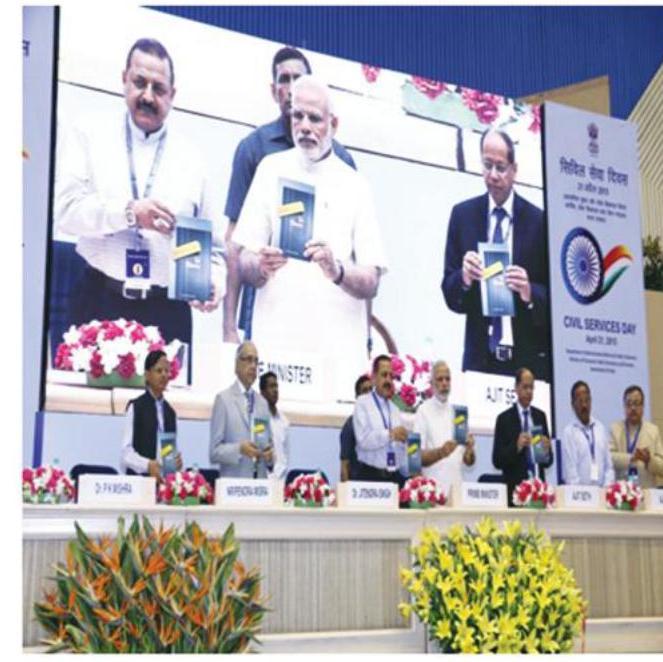
The Prime Minister, Shri Narendra Modi releasing the book “Tomorrow is Here”, a book about the best practices in Governance, at the Civil Services Day function, in New Delhi on April 21, 2015.
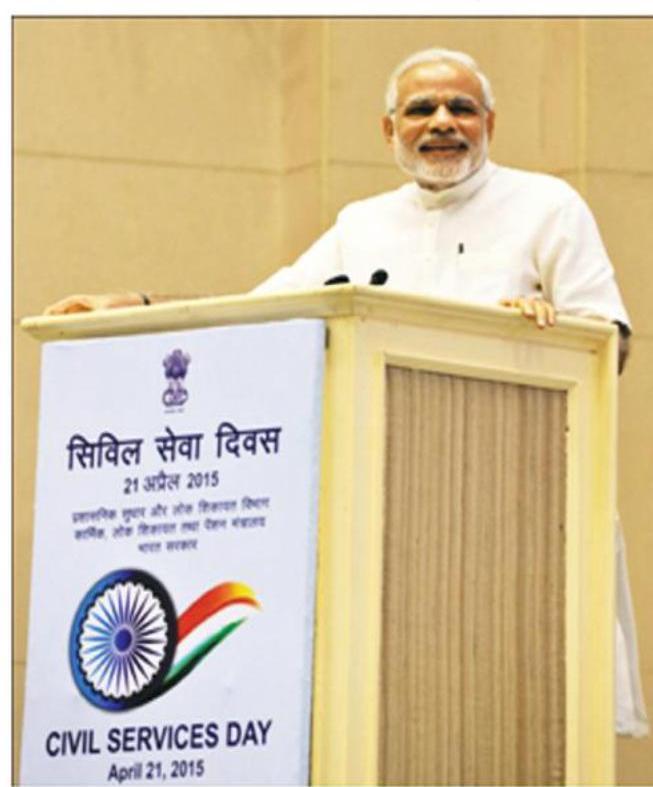
The Prime Minister, Shri Narendra Modi addressing the gathering, at the Civil Services Day function, in New Delhi on April 21, 2015.
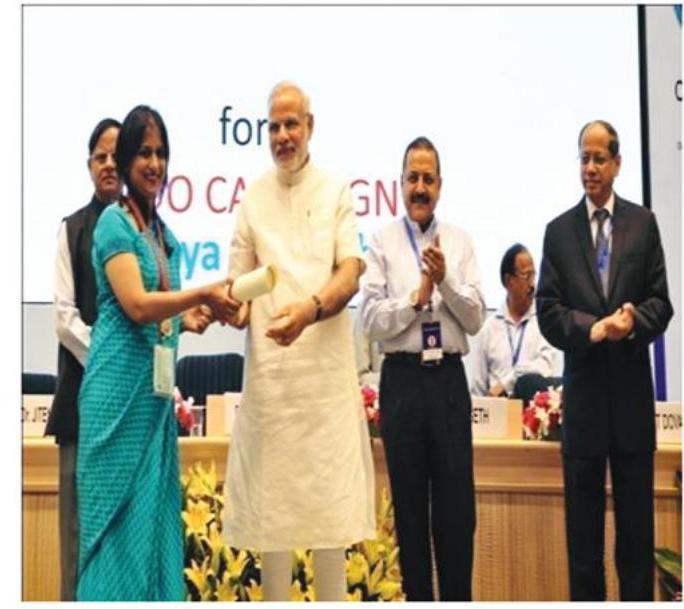
The Prime Minister, Shri Narendra Modi conferring the awards for Excellence in Public Administration on the Civil Services Day function, in New Delhi on April 21, 2015.
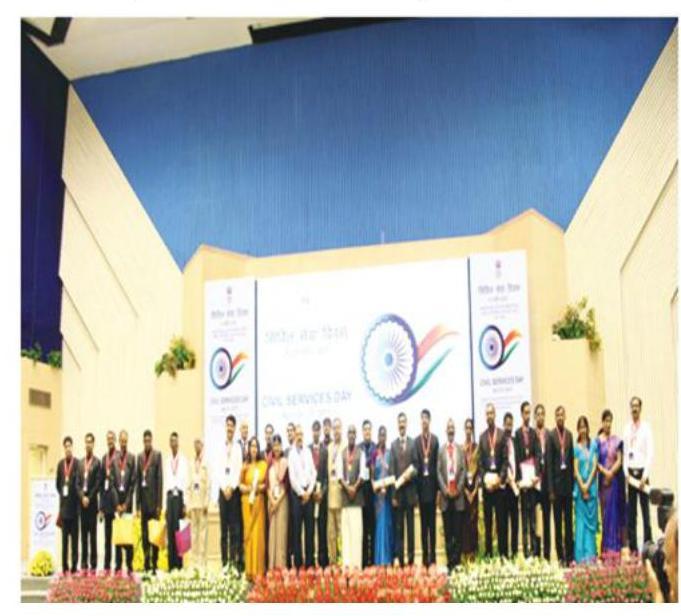
Prime Minister’s Award for Excellence in Public Administration:
20.3 The Government of India has instituted ‘Prime Minister’s Awards for excellence in Public Administration’ to acknowledge, recognize and reward the extraordinary and innovative work done by officers of the Central and State Governments. The Scheme rewards
the outstanding and exemplary performance of civil servants. Discharge of routine duties and responsibilities and/or implementation of programmes/projects in the normal course; do not qualify for the Award. Initiatives and projects whose qualitative and quantitative outcomes/ results are of a very high order, and benefit a large number of citizens/stakeholders could be considered. All serving officers of the Central and the State Governments(including elected local bodies), either individually or as a team, or as organizations are eligible for the Awards. Under the team nomination, all the members of the team should have been actively and directly involved in the initiative nominated.
20.4 There are a maximum of 15 Awards, given under individual, team and organization categories. The Award carries with it:
i) A medal
ii) A scroll, and
iii) A Cash Award
In the individual category, the Award amount is Rs. 1 lakh. In case of a team, the total Award amount for the team is Rs. 5 lakh subject to a maximum of Rs. 1 lakh per member. The Award amount for an organization is Rs. 5 lakh. Nomination of an individual or a team of officers or an organization may be made by Central Government Departments/Ministries/ State Governments/Non-Governmental Organizations and other stake-holders. The Expert Committee chaired by Secretary, Department of Administrative Reforms & Public Grievances examines nominations. This Committee can also take up noteworthy initiative(s) suo-moto. On-the-spot studies are done for the nominations shortlisted by this Committee. The Committee takes into account the study Reports and
make its recommendations to the Empowered Committee chaired by the Cabinet Secretary. The Empowered Committee then makes its recommendations for the consideration of the Prime Minister after assessing the vigilance status and overall performance of officers recommended for the Awards. The members in both the Expert Committee and the Empowered Committee are nominated with the approval of the Prime Minister. The existing scheme is under revision. Once it is finalized, it will be published prior to inviting nomination for the Prime Minister’s Awards.
A list of Awardees of 2012-13 and 2013-14 for Prime Minister’s Award for Excellence in Public Administration is at Annexure.
20.5 Replication of PM Award Initiatives in the States and UTs:
The Hon’ble Prime Minister during his speech on CSD 2015 had desired that the Award winning initiatives should be replicated in other parts of the country according to suitability of the States/UTs, so that advantages of best practices in good governance should reach to the every citizen of this country. In order to pursue this objective, Department of Administrative Reforms and Public Grievances has been in touch with the States / UTs by convening meetings with Administrative Reform Secretaries and written communications to the Chief Secretaries of the States/UTs. With the result till date 23 States and one UT have identified the initiatives and have taken further necessary steps to study those initiatives for replicating and adopting in their respective States/UT. The expected impact of adopting/replicating the best practices in various part of the country would be to percolate the
benefits out of them to every common citizen in a time bound manner. This would also to avoid additional expenditure in re-doing the ground work. The concerned Ministries/Departments of Government of India have also been taken on board so that the existing programme / schemes of the various Ministries/ Departments of Government of India could also be dovetailed in the process of replication by states.
20.6 State Collaboration Initiative:
The guidelines for State Government for proposing initiative under State Collaboration Initiative has been revised to support replication of initiative/ best practices specially those that have been awarded PM Award for Excellence in Public Administration and National e-Governance Award.
2012-13
| Sr. No. | Category | Initiative | Awardees |
|---|---|---|---|
| 1. | Individual | “Save the Girl Child”-to prevent foeticide | Dr. Darez Ahamed, Dist. Collector/Dist. Magistrate, Perambalur Dist. Govt. of Tamil Nadu. |
| 2. | Team | “Hum Chhuyenge Aasman”, Madhya Pradesh | 1. Shri Vikar Khararkar, Dist. Sports & Youth Welfare Officer. 2. Shri Jameel Ahmad, Astt. Administrator States Sports Academy, Gwalior. |
| 3. | Organisation | SAKALA-“No more delaysWe Deliver on Time” | Department of Personnel \& Administrative Reforms, Govt. of Karnataka. |
| 4. | Organisation | Crop Pest Surveillance and Advisory Project- for pest management on major crops in Maharashtra. | Commissionerate of Agriculture, Govt. of Maharashtra. |
| 5. | Organisation | IT Consolidation Project of CBEC | Directorate of Systems, Central Board of Excise and Customs (CBEC), Dept. of Revenue, Ministry of Finance. |
| 6. | Organisation | Easy Tax compilation through Quality Services | Central Board of Direct Taxes, Dept. of Revenue, Ministry of Finance. |
| 7. | Organisation | Rationalization of Affidavits for reforming public Service delivery system | Dept. of Governance Reforms, Govt. of Punjab. |
2013-14
| Sr. No. | Category | Initiative | Awardees |
|---|---|---|---|
| 1. | Individual | “Saving the Womb” An initiative to address and redress malpractices in the implementation of RSBY in Samastipur, Bihar. | Shri Kundan Kumar, IAS Dist. Magistrate, Samastipur Bihar. |
| 2. | Individual | “Emotional Dirve Campaign” Valsad and Vapi Gujarat | Dr. Vikrant Pandey, IAS Dist. Magistrate, Valsad, Gujarat. |
| 3. | Individual | “Jashn-e-Jamhuriat”: ReasiCelebrating Democracy (Election Project for combating alienation and increasing inclusive electoral literacy \& participation. | Dr. Shahid Iqbal Choudhary, IAS, Dist. Collector/Dist. Magistrate/Dist. Development Commissioner Reasi, J\&K |
| Sr. No. | Category | Initiative | Awardees |
|---|---|---|---|
| 4. | Individual | “Sarguja Fulwari Initiative”. Chhatisgarh | Shri R. Prasana, Collector & Dist. Magistrate, Dist. Surguja, Chhatisgarh. |
| 5. | Team | Revival of Sasur Khaderi-2 Rivulet and its Origin Thithora Lake in Dist. Fateshpur, UP | 1. Ms. Kanchan Verma, Special Secretary, Govt. of UP 2. Mr. Harish Chandra, Dist. Development Officer 3. Mr. Kaptan Singh, Executive Engineer 4. Mr. Arvind Kumar, Executive Engineer. |
| 6. | Team | Achieving-‘Total Financial Inclusion’ in West Tripura Dist. Through e-ROR (e-Record of Ordinary Residence) \& Common Services Centers piloted at Mandawi Block. | 1. Abhishek Singh, IAS Dist. Magistrate \& Collector, Tripura 2. Shri Gitte Kiran Kumar Dinkarrao 3. Shri Pramod Kumar Pal 4. Shri Manohar Bishwas 5. Shri Pradip Roy. |
| 7. | Team | LADO (An innovative initiative for eradicating child marriage) | 1. Shri J. N. Kansotia, IAS Principal Secretary, Govt. of MP 2. Smt. Kalpana Srivastava 3. Smt. Rekha Sharma 4. Smt. Harish Khare 5. Shri Arvind Singh Bhal 6. Smt. Tini Pandey 7. Shri Sushil Kumar Verma |
| 8. | Team | Skill Development Programme to impart vocational training to the tribal youth, Gadchiroli Maharashtra | 1. Shri Ranjit Kumar, IAS Dist. Collector, Gadchiroli Maharashtra 2. Shri Abhishek Krishna 3. Shri T. S. K. Reddy 4. Shri P. V. Deshmane 5. Shri Y. S. Shende |
| 9. | Organisation | Eraviperoor Grama Panchayat-Sucess Story of Local Self Governance | Eraviperoor Grama Panchayat, Kozhimala P.O. Thiruvalla, Pathanamthitta (Dist.) Kerala State. |
| 10. | Organisation | Canal Top Solar Power Plant-A New Direction to Green and Clean Energy | Gujarat State Electricity Corporation Ltd. (GSECL) |
Chapter 21
PUBLIC GRIEVANCES
MANDATE
The Public Grievances Division is responsible for issuing policy guidelines and coordinating & monitoring of issues regarding redress of public grievances and staff grievances for the Central Government. In accordance with federal principle of governance, the grievances relating to States are forwarded to concerned State Government for appropriate action. The PG Division also coordinates the implementation of Sevottam which is a part of citizen centric quality management framework for better service delivery.
21.1 The Allocation of Business Rules, 1961, allocate to the DARPG inter alia, the responsibility for Policy, Coordination and Monitoring of issues relating to (a) Redress of Public Grievances in general and (b) Grievances pertaining to Central Government Agencies, in particular. The Public Grievance Division is responsible for this activity since December 1987. From 1997, the Division has also been made responsible for several Citizen Centric Initiatives under the platform of ‘Responsive Government’. These include Citizen’s Charter, Information Facilitation Counters, and Quality Management System (QMS) framework called Sevottam, for bringing improvement in public service delivery on a continuous basis that may result in Certification under Indian Standard 15700: 2005 by Bureau of Indian Standards. With the objective of bringing quality based improvements in public service delivery, the QMS Sevottam framework has been introduced through Workshops, in various Ministries/ Departments of Government of India, and in the State Governments/UT Administrations through Workshops and implemented in 10 Ministries /
Departments and 4 different sectors in 4 State Governments through pilots of 12 month duration. The 14 pilots of QMS Sevottam have confirmed that the framework can work successfully in various pro-poor sectors for bringing continuous improvements in public service delivery.
21.2. From its beginning through issue of Policy Guidelines on Public Grievances, the scope of Public Grievances today envisages reduction in arising of grievances, by bringing continuous improvement in Public Service Delivery through the extension of Quality Management System ‘Sevottam’ at the Centre as well as in the States. Statutory backing for improvements in service delivery was sought to be given through the ‘Right of Citizens For Time Bound Delivery of Goods and Services and Redressal of Their Grievances Bill, 2011’ that had been introduced in the Lok Sabha on 20.12.2011. It lapsed with the dissolution of $15^{\text {th }}$ Lok Sabha. It is now proposed to be initially implemented as a Scheme for Delivery of Services and Redress of Public Grievances. Thus, over the years the functions
and responsibilities of Public Grievances Division have enlarged in scope and complexity since the creation of the Division in 1987.
21.3 The Public Grievances Division has undertaken the following activities during the year and before:-
21.3.1 GRIEVANCE REDRESS:
Activity 1: In the responsibility area of ‘Application of ICT for technological upgrading’ the online system for grievance redress, called the ‘Centralized Public Grievance Redress And
Monitoring System’ (CPGRAMS) has evolved since 2007. At present its upgraded version 5.0 is accessible at http://pgportal.gov.in and also through www.darpg.gov.in The CPGRAMS interlinks 94 Central Ministries / Departments / Organizations. There are around 12492 subordinate users listed on it which includes subordinate and field offices also. The number of field offices / organizations linked to CPGRAMS has increased from about 1500 in 2010-11 to over 12000 in 2015-16. CPGRAMS in Hindi has also been made available.
Grievance Receipts/disposal in CPGRAMS for Central Govt. as on $31^{\text {st }}$ December, 2015
Receipts/Disposal graph as on 31/12/2015
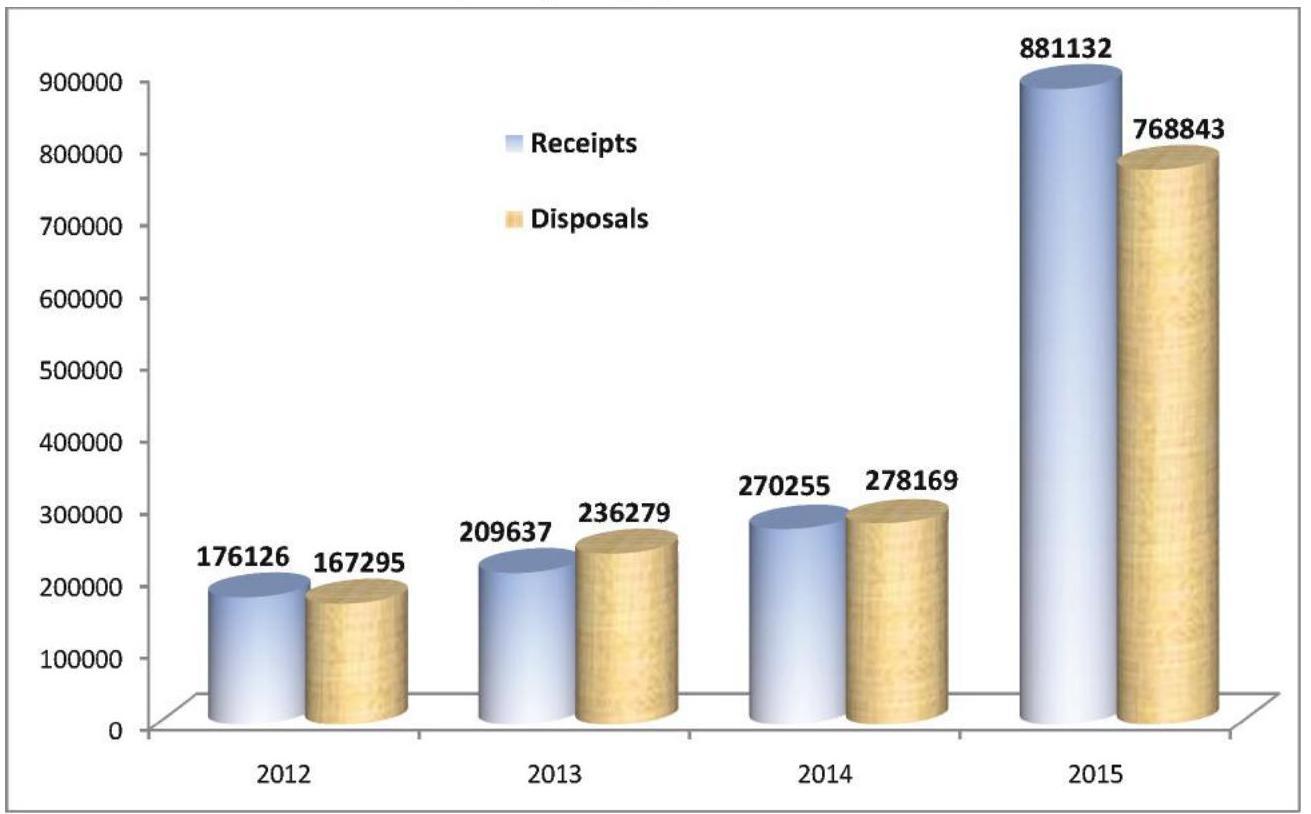
Figure Snapshot of PG Portal version 5.0 in English.
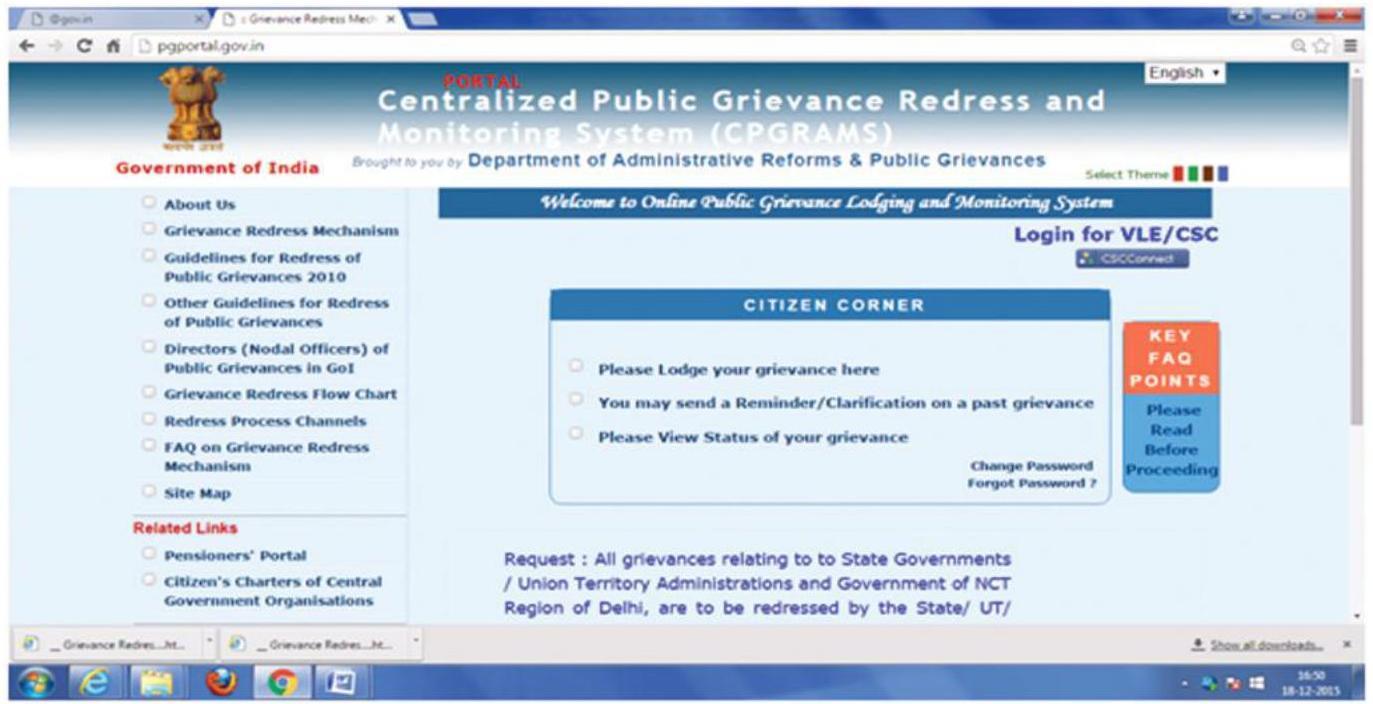
Figure Snapshot of PG Portal version 5.0 in Hindi.
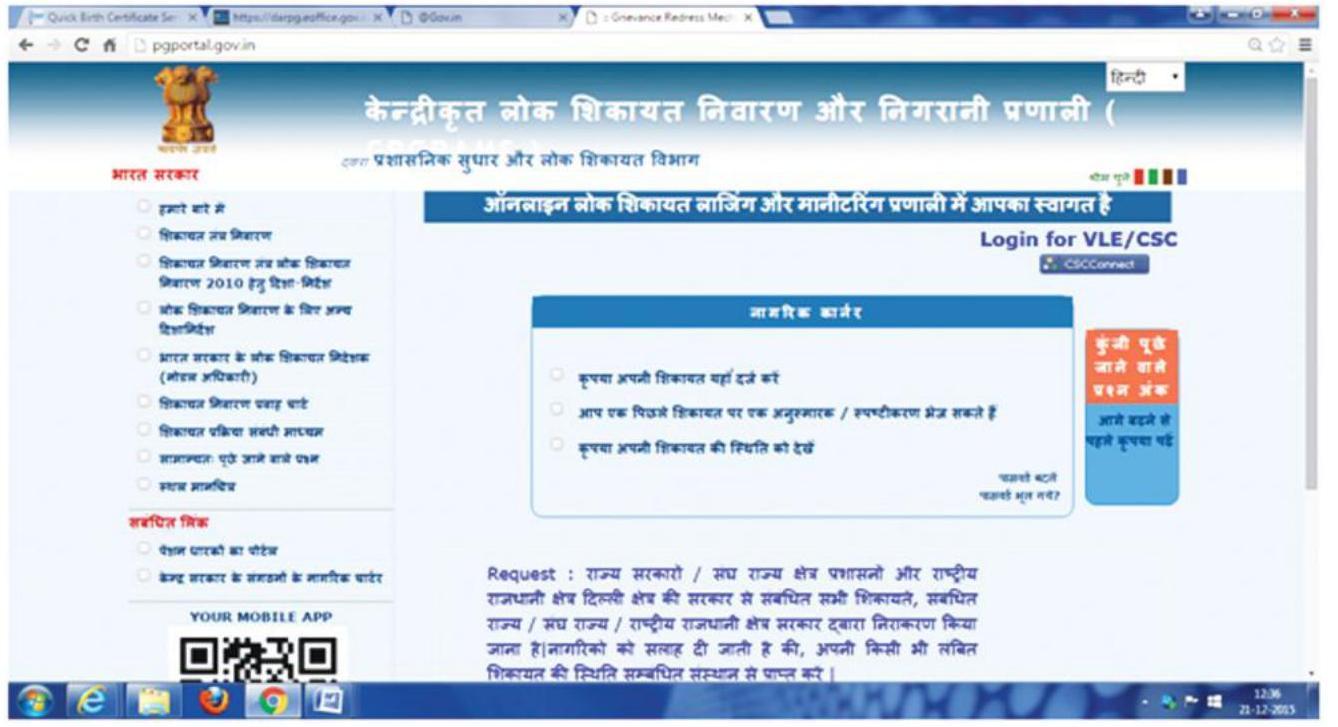
Activity 2: During the year action was taken for integrating the public grievance mechanism of PMO available on website www.pmoindia.gov.in with the pgportal.gov.in. Now, the grievances
lodged to the PMO is being transferred to the Central Ministries/Departments and State Governments and monitored through the online CPGRAMS which is part of the pg portal.
Activity 3: The public interface of pg portal has been duly integrated with the pensioners’ portal and now an option has been provided to the users to lodge pension related grievances to the pensioners’ portal by clicking the relevant option on the pg portal. This prevents the lodging of same grievance on pgportal and pensioner’s portal thus avoiding duplication.
Activity 4: For providing grass root access to the pg portal, the Common Service Centre has been
duly integrated with it on trial basis so that a person can lodge a grievance on the pg portal through the Common Service Centre located in his area by paying a nominal fee.
Activity 5: A Mobile App has been launched on 21.10.2015 by the Hon’ble MoS (PP) which allows lodging of public grievances on android based mobiles by downloading the App from pg portal. The Action Status can also be viewed on the mobile itself.
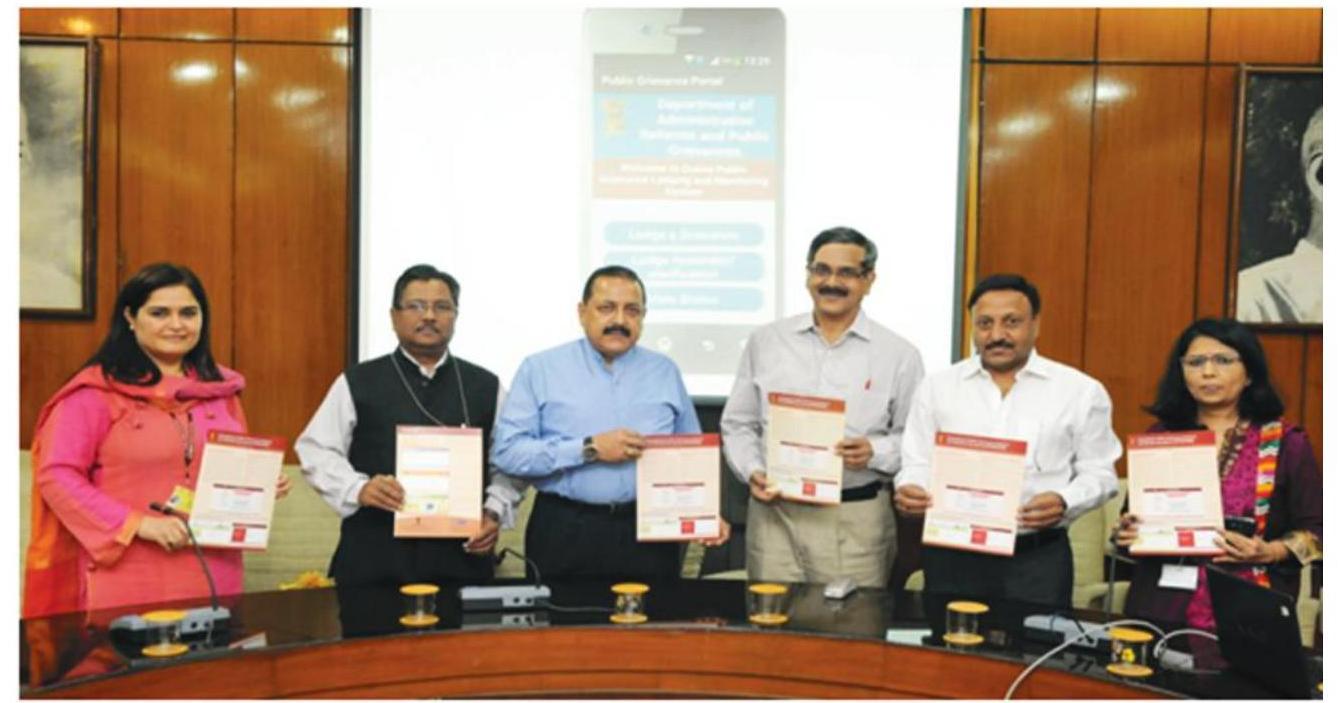
Hon’ble MoS (PP), Dr Jitendra Singh with the senior officers of DARPG and DoPT during launch of Mobile app.
Steps to lodge grievance on the MOBILE APP
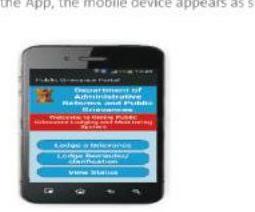
Lodge a Grievance or Lodge Reminder/Clarification or View status as per your requirement.
Activity 6: For proper monitoring, the classification of grievances has been reviewed and fresh categorization done in consultation with PMO dividing the grievances into 20 main categories which can be further mapped to specific categories by the Ministries/Departments concerned as per the subject matter being handled by them.
Activity 7: Dashboard have been created for all the heads of the Ministries/Departments for accessing the relevant information pertaining
to pendency of grievances in the respective Ministries/Departments and sub-ordinate organizations affiliated to them on CPGRAMS.
User-ids and passwords have been duly provided to all concerned.
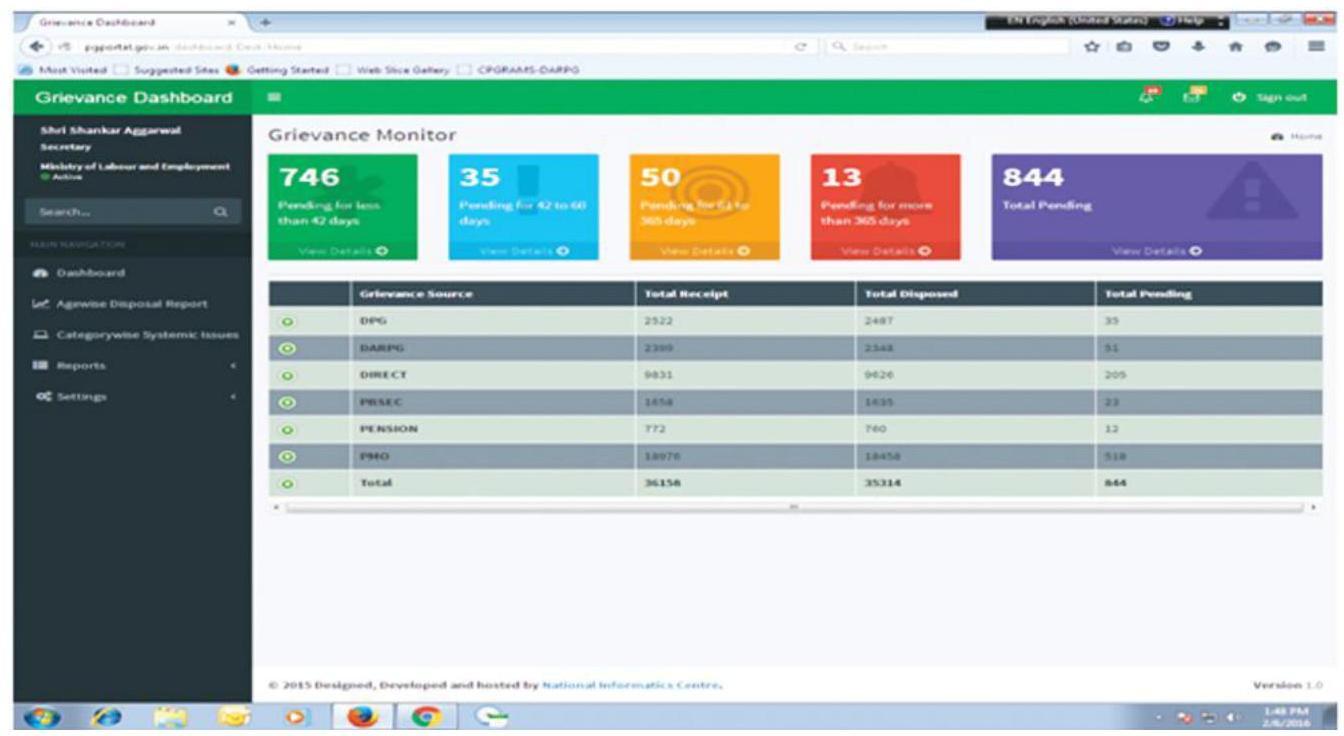
The Grievances lodged by citizens against Central Govt. Organization increased almost three times during the year. As per Dr. Jitendra Singh, Hon’ble MOS (PP) quoted by Economic Times:-
“This only shows that our Govt. is more accessible to the public. Our Citizen Centricity is much more – One can simply log on to the CPGRMAS portal to lodge a complaint or do so even on the go with a CPGRAMS mobile application launched by us lately”.
Activity 8: Draft Scheme for Delivery of Services and Grievance Redress has been formulated and has been submitted to Cabinet Secretariat for consideration of Committee of Secretaries.
Activity 9: For better monitoring, the format of analytical reports generated online through CPGRAMS has been duly modified and additional reports created for the purpose. The colour coding of the Ministries/Departments have been done as per their performance on CPGRAMS. The format now includes receipts, disposals and % disposals with reference to cases pending for 2-6 months, $6-12$ months and more than one year.
Activity 10: A Grievance Analysis Study has been entrusted to Quality Council of India for identifying grievance prone areas, root cause analysis and systemic reforms in r/o top 20 grievance receiving Ministries/Departments/ Organizations listed on pg portal.
Activity 11: During the year 2015, 8 review meetings were held for reviewing the status of pending public grievances in Ministries/ Departments and expediting action on them. It was attended by 90 Ministries/Departments/ Organizations.
Activity 12: During the year 2015, 12 operational trainings on CPGRAMS have been held which were attended by 432 participants. Every Tuesday has been now declared as Open House for trainings on CPGRAMS.
Activity 13: An Award Scheme has been launched for recognising performance on CPGRAMS through issue of Certificate of Appreciation.
Activity 14: Extending CPGRAMS to State Governments / Union Territories. The codes for using the CPGRAMS, through the Internet, have been provided to all State Governments. During the year, the Division has extensively used the System to forward public grievances to the State Governments concerned. From $1^{\text {st }}$ January 2015 to 31.12 .2015 a total of 5752 grievances have been sent to State Governments by D/o ARPG. Out of these 3649 were received electronically, and 2103 were received by post or given in person by the complainant. The inflow of State related grievances is in two forms (i) Through the CPGRAMS and (ii) through post. The grievances received by post are digitized and sent both through the System as well as by post to the State Government concerned. Redress response as received is sent by post, to the complainant.
Activity 15: Extending CPGRAMS with local language interface to State Governments / Union Territories. CPGRAMS with local language interface, has so far been launched in all departments of the Governments in the 9 States of Haryana (http:// harsamdhan.gov. in), Orissa (www.cmgcorissa.gov.in), Rajasthan (sugamrpg.raj.nic.in), Mizoram (http://mipuiaw. nic.in), Meghalaya (http://megpgrams.gov. in), Union Territory of Puducherry (http:// puduvaikural.puducherry.gov.in), Uttrakhand (samadhan.uk.gov.in), Jharkhand (http:// jharkahandsamadhan.nic.in) and Punjab (http:// shikayatnivaran.gov.in.
21.3.2 PUBLIC SERVICE DELIVERY
Introductory:
Quality Management System (QMS) Sevottam framework for bringing excellence in service delivery by Government organizations: A Quality Management System (QMS) ‘Sevottam’ framework has been developed for bringing improvements in the quality of public service delivery. This is a citizen centric initiative for institutionalizing an assessment-improvement framework for improving the quality of service delivery on a continuous basis through the involvement of Ministries / Departments and citizens. Sevottam includes three dimensions of a public service organization as follows: (a) Citizen’s / Client’s Charter that specifies the service delivery standards (b) Grievance Redress Mechanism that gets activated if the service delivery is not as per standards in the charter (c) Service Delivery Capability of the organization to delivery service as per standards in the charter. A ‘nine point quality of compliance’ criterion based on published standards has been developed.
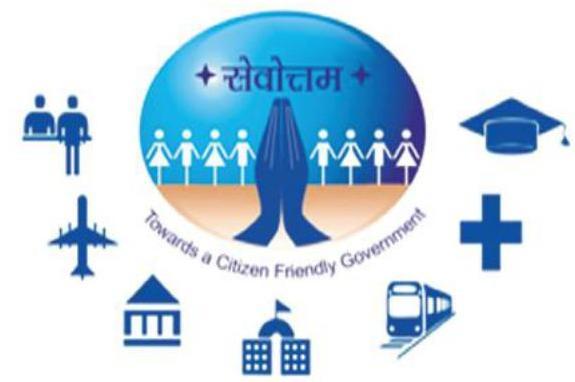
Figure 18.4: The logo adopted for Sevottam
Activity 16: Sevottam Pilot Projects in 10 Central Ministries/Departments and 4 States from 200708 to 2010-11 have resulted in the certification under Indian Standard 15700:2005 for 17 offices under D/o Posts, 39 offices of CBDT/CBEC under
D/o Revenue, as well as one office each under D/o Financial Services, Govt. of Uttar Pradesh, Kerala and Goa.
Activity 17: Besides the offices mentioned above, the Public Grievance Division of the Department has also been awarded IS 15700:2005 by the Bureau of Indian Standards after the completion of final audit of the processes being followed in the PG Division. A surveillance audit of PG Division was conducted during the year and the working was reported ‘Satisfactory’.
Activity 18: Strengthening of State Administrative Training Institutions and Central Training Institutions as part of capability building for time bound delivery of public services in the States. Under the Sevottam (Plan) pilot projects, a new Scheme for Strengthening of the State ATIs and CTIs, has been started from October 2012, for building capacity of the ATI to become consultants for implementing Quality Management System ‘Sevottam’ in all departments of the State Government, including replication of best practices from other States / UTs. For Sevottam Training Cells in the ATIs hardware has been purchased. 27 Faculty Members/Consultants were trained in the first 2-day Training of Trainers (ToT), on $18^{\text {th }}$ and $19^{\text {th }}$ September, 2013. Seven of these ATIs viz. Himachal Pradesh, Uttar Pradesh, Punjab, Rajasthan, Haryana, Delhi and Tamil Nadu have been visited by the officers of PG Division for ground report on the working of Sevottam Cell in these States. A number of on-campus and off-campus training have been held by the ATIs for sensitising the officers of the State Government in implementation of Citizens’ Charter and Grievance Redress Mechanism. The ATIs have been told to achieve specific targets for implementation of Citizens’ Charter in the State Government and also facilitate certification of some specific departments under IS 15700:2005.
Activity 19 : Based on the utilization certificate received and performance, the third instalment of grant under the above scheme have been released to the 6 State ATIs viz. Himachal Pradesh, Uttar Pradesh, Delhi, Haryana, Jharkhand and Punjab.
Activity 20: Senior Officers of Public Grievance Division visited Bhopal for studying the working of the Chief Minister HELPLINE of Government of Madhya Pradesh for considering similar measures for implementation by the Central Government. The officials met Secretary, IT, Pr. Secretary, GA&AR and PS to Chief Minister for discussing the challenges and achievements. The officials also visited The Lok Sewa Kendra of the State Government that has been set up in PPP mode for delivery of public services.
21.3.3 CITIZEN’S / CLIENT’S CHARTERS
Activity 21: The Citizen’s/Client’s Charters (CCC) was first introduced simultaneously in Central Departments and in all State governments in May, 1997. In 2005, the CCC has been included as a module in QMS Sevottam Framework.
The Citizen/Client charter of DARPG for 201516 has been prepared and duly uploaded on the web site of the Department.
The Department related Parliamentary Standing Committee on Personnel, Public Grievance, Law \& Justice visited Madurai, Rameshvaram, Chennai, Bengaluru and Kochi on 27.1.2015 to 31.1.2015 for reviewing the status of grievance redress mechanism for the fishermen \& refugees in Tamil Nadu and for inter-alia reviewing the status of implementation of Citizens’ Charter and Public Grievance Redress Mechanism in Indian Overseas Bank, Tuticorin Port Trust, Indian Bank, Canara Bank, ISRO, Coffee Board and some other offices of Government of India located in the region. The Committee directed
that action may be taken for strengthening of Grievance Redress Mechanism and for creation of Citizens’ Charter.
Main Initiatives of PG Division in 2015.
- Grievance Analysis Study by Quality Council of India in r/o top 20 grievance receiving Ministries/Departments/Organizations listed on CPGRAMS.
- Integration of PMO Public Grievances System with pg portal of D/o ARPG and
revised categorization of grievances for proper monitoring. - Launch of Mobile App for lodging of public grievances.
- Creation of Dashboards for monitoring of pendency on pg portal by Secretaries of Ministries/Departments.
- Intensive review meetings and frequent trainings on CPGRAMS were held during the year 2015.
Chapter 22
ORGANISATION AND METHODS DIVISION
MANDATE
- Formulation and simplification of common office procedures.
- Publication and updating of the paper based Central Secretariat Manual of Office Procedures (CSMOP), electronic based Central Secretariat Manual of e-Office Procedure (CSMeOP) and Record Retention Schedule (RRS).
- Aiding and advising the Central Ministries/Departments and States/UTs Governments on O&M aspects.
- Implementation of the Plan Scheme of Modernization of Central Government offices located in the city of Delhi.
The Central Secretariat Manual of Office Procedure (CSMOP)
22.1 In order to create awareness about office processes and practices especially at the cutting edge level and to sensitize new entrants inducted at various levels in the Central Secretariat, the Department of Administrative Reforms \& Public Grievances, as a nodal agency in the field of ‘Organization \& Methods’, has laid down various procedures for performance of secretariat work by the functionaries in various Ministries/ Departments of the Government of India in the form of Central Secretariat Manual of Office Procedure (CSMOP). During the current financial year the Department had brought out the $14^{\text {th }}$ Edition of the Central Secretariat Manual of Office Procedure (CSMOP) which removed a lot of redundant and repeated entries contained in the earlier Edition of CSMOP.
The Central Secretariat Manual of e-Office Procedure (CSMeOP)
22.2 The first Edition of Central Secretariat Manual of e-Office Procedure (CSMeOP) was brought out in the year 2012 which was almost $80 %$ replica of the paper based CSMOP. In order to bring in more elements of e-procedure, the Department has embarked on the task of bringing out the $2^{\text {nd }}$ Edition of CSMeOP in cooperation with the Institute of Secretariat Training Management (ISTM), National Informatics Centre (NIC) and some experts. The revised $2^{\text {nd }}$ Edition of CSMeOP will be brought out in the later part of the current Financial Year.
The Record Retention Schedule
22.3 The Record Retention Schedule (RRS) was last updated and issued in December, 2012. A need has been felt to fix RRS for digitized
records also. Accordingly, an Inter-Ministerial Committee under the Chairmanship of Additional Secretary (ARPG) was set up. The committee has already done its deliberations and made its recommendations. The recommendations are under consideration of the Department and necessary guidelines will be issued with the approval of the competent authority shortly.
The Modernisation of Government Offices Scheme
22.4 In order to give catalytic effect to modernisation of offices as an overall process of Administrative Reforms, the DAR&PG is
implementing a Plan Scheme for Modernisation of Government offices located in the city of Delhi since the year 1987-88. Under the Scheme the Department provides $75 %$ financial assistance of the total cost of the project which is recommended by an Inter-Ministerial Screening Committee and the beneficiary has to chip in with $25 \%$ of the cost. Since the year 1987-88 to till date the DAR\&PG has extended a financial assistance of Rs. 69.40 crores approximately for financing 448 modernisation proposals. During the current Financial Year, DAR\&PG proposes to release Rs. 3.00 crores for financing 5 modernisation proposals.
Chapter 23
E-GOVERNANCE
National Conference on e-Governance
23.1 Department of Administrative Reforms and Public Grievances and Department of Electronics & Information Technology in association with one of the State Governments have been organizing the National Conference on e-Governance every year since 1997. This Conference provides a platform to the senior officers of the Government including IT Secretaries of State Governments, IT Managers of the Central Government, and Resource Persons, Experts, Intellectuals from the industry and academic institutions etc. to discuss, exchange views and experiences relating to various e-governance initiatives.
23.2 The 18th National Conference on e-Governance was organized in Gandhinagar, Gujarat during 30-31 January, 2015 jointly by Department of Administrative Reforms and Public Grievances, Government of India, Department of Electronics and Information Technology, Government of India and Department of Information Technology, Government of Gujarat. NASSCOM was the knowledge partner of the Conference. The theme of the Conference was “Digital Governance-New Frontier” and focus sector was “Skill Development \& Employability”. During the conference, 22 e-Governance initiatives were awarded. DARPG has developed case studies for 7 awarded initiatives for adoption /adoptation by States/UTs.
23.3 19 th National Conference on e-Governance was held at Nagpur, Maharashtra on $21^{\text {st }} \&$
$22^{\text {nd }}$ January 2016. DARPG has received more than 200 nominations for different categories of awards. During the Conference, 18 e-governance initiatives were awarded. The Focus Sector for this conference was “Financial Inclusion” and Theme was “GATI- Governance with Accountability, Technology and Innovation”.
During the Conference, this Department released four books, as follows:-
(i) Report on “Decade of e-Governance in India”
(ii) Uncommon Excellence.
(iii) Background paper
(iv) Compendium of selected papers.
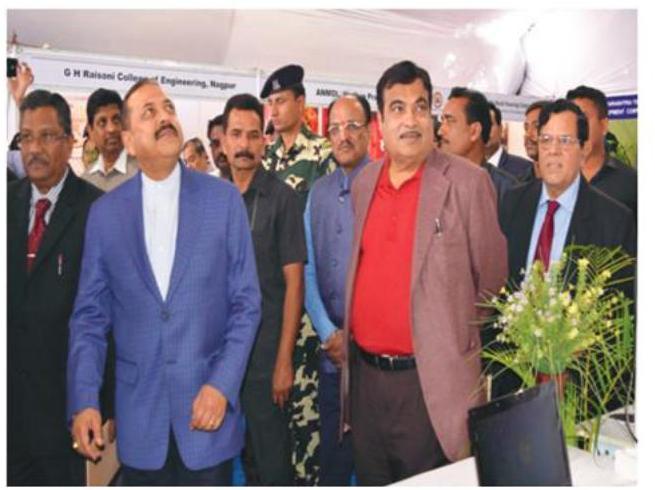
The Union Minister for Road Transport \& Highways and Shipping, Shri Nitin Gadkari and the Minister of State for Development of North Eastern Region (I/C), Prime Minister’s Office, Personnel, Public Grievances \& Pensions,
Department of Atomic Energy, Department of Space, Dr. Jitendra Singh visiting an exhibition, during the 19th National E-Governance Conference, at Nagpur on January 21, 2016.
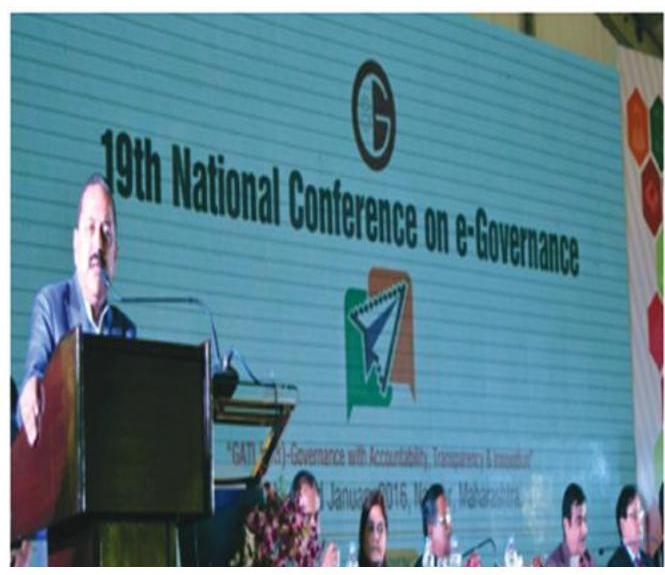
The Minister of State for Development of North Eastern Region (I/C), Prime Minister’s Office, Personnel, Public Grievances & Pensions, Department of Atomic Energy, Department of Space, Dr. Jitendra Singh addressing at the inauguration of the 19th National E-Governance Conference, at Nagpur on January 21, 2016. The Union Minister for Road Transport \& Highways and Shipping, Shri Nitin Gadkari also graced the occasion.
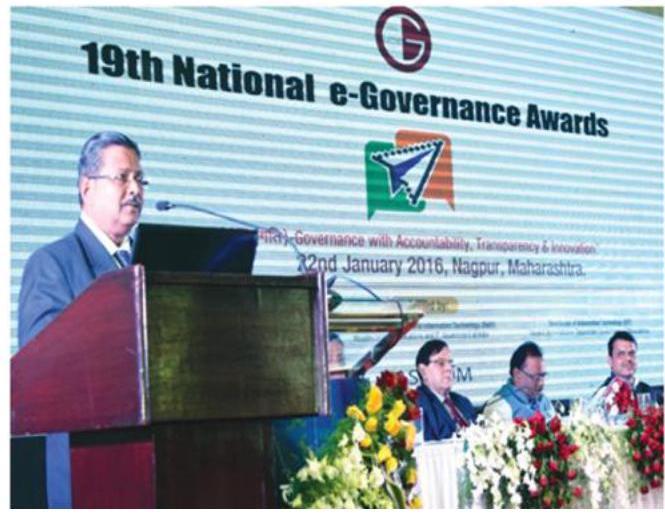
The Secretary of Department of Administrative Reforms, Public Grievances (DARPG), Shri
Devendra Chaudhry addressing at the valedictory session of the 19th National E-governance Conference, at Nagpur on January 22, 2016. The Chief Minister of Maharashtra, Shri Devendra Fadnavis and other dignitaries graced the occasion.
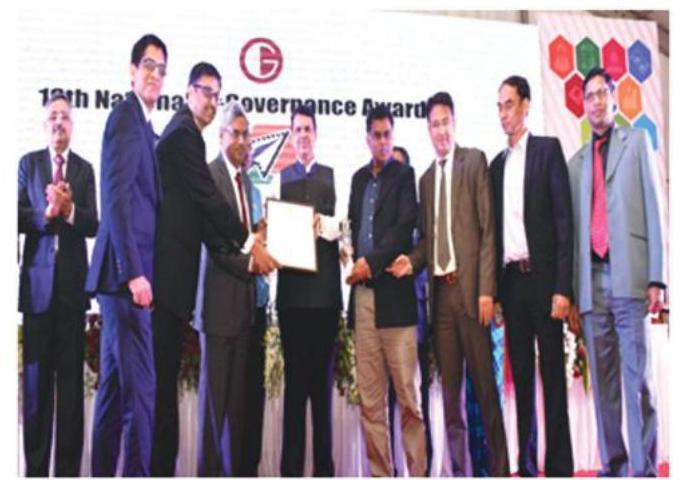
The Chief Minister of Maharashtra, Shri Devendra Fadnavis presented the National Awards for e-Governance for the Year 2015-16, at the valedictory session of the 19th National E-governance Conference, at Nagpur on January 22, 2016.
Message by the Hon’ble Prime Minister of India on the 19th National E-governance Conference,
23.4 Good Governance is the key to a Nation’s progress. Our government is committed to providing a transparent and accountable administration which works for the betterment and welfare of the common citizen.
“Citizen-First” is our mantra, our motto and our guiding principle. It has been my dream to bring government closer to our citizens, so that they become active participants in the governance process.
Quotes by Dr. Jitendra Singh, Hon’ble MoS (PP) during 19th National E-governance Conference
23.5 The core of Good Governance is based on reducing internal complexities in the functioning of the government, expediting procedures through electronic and digital means, reducing/eliminating unnecessary rules and creating an enabling environment. The changes if implemented can bring a paradigm shift in the way the government functions and it will increase the involvement of citizens.
Quotes by Dr. Shri Devendra Chaudhary, Secretarary, Department of Administrative Reforms & Public Grievances during 19th National E-governance Conference
23.6 The vision of the Hon’ble PM for Transformational Governance cannot be realized only with innovative deployment of Technology and Transformational Thinking.
The next wave of Governance Reforms will be driven by Technology and Innovation which would provide GATI (गति) – Governance with Accountability, Transparency and Innovation to the process of Governance and Administration.
With e-Commerce expected to log 100 billion US dollars worth transactions by 2020, the enterprise of the private startups would be crucial to realizing the goal of providing end-to-end full transaction enabled government services the e-Commerce way.
The Trinity of Jandhan, Aadhar and Mobile JAM, along with SMAC would drive the delivery of government public services in the next 5 years to enable a Certificate less government to the common man.
Developing “Standard Process \& Related Operating Technical Platform alongwith Procedures/Guidelines” for selected awarded
e-Governance initiatives for replication by States/UTs
23.7 A meeting was held in DARPG on $27^{\text {th }}$ August 2015 \& $28^{\text {th }}$ August, 2015 with Line Ministries of Central \& State Governments to discuss/deliberate/ examine the 12 Case Studies which have been developed by Price Waterhouse Coopers (PWC) from the e-Governance initiatives awarded during $17^{\text {th }} \& 18^{\text {th }} \mathrm{NCeG}$. After deliberations, it has been decided to develop “Standard Process \& Related Operating Technical Platform alongwith Procedures/Guidelines for the following five selected cases studies to facilitate dissemination/replication of these case studies across the States/UTs. :
(i) MEE Seva of IT Department of Govt of Andhra Pradesh
(ii) Dynamic Integration of Property Registration, Land Records \& Cadastral Maps, Deaprtment of Revenue \& Disaster Management, Haryana
(iii) AGRISNET- Farm Crop Management System, Agriculture Department, Government of Tamil Nadu
(iv) Effective Vehicles database Management, Office of Supdt of Police, Mandya, Karnataka
(v) Chattisgarh Geographic Information System- Chhatisgarh Infotech \& Biotech Promotion Society.
23.8 In order to develop the “Standard Process \& Related Operating Technical Platform alongwith Procedures/Guidelines”, Core Committee headed by Additional Secretary, DARPG and Technical Committee headed by CEO, NISG has been constituted. The Technical Committee is currently examining the selected five case studies in consultation with Line Ministries of Central Government and Champions of the initiatives.
23.9 DARPG has also revamped the “e-Governance Portal” of its website. The list of awarded initiatives of last ten years have been put on website alongwith sector-wise, state-wise lists. It has also been decided that “GATI- Governance with Accountability, Technology and Innovation for Citizen-Centric Services” would be guiding principle of DARPG’s e-governance programmes.
23.10 DARPG in association with UNDP and UNDESA has engaged national and International Experts to analyse and study the e-governance methods, processes and technology employed by Government institutions and recommend wayahead to make India one of the top e-Governed nations in the world.
e-OFFICE
23.11 DAR&PG is the nodal Department for implementation of e-office project in Central Ministries/Departments. Nation Informatics Centre (NIC) is the technical partner of DARPG in this project. The e-Office Mission Mode Project (MMP) was launched in 201112 in phased manner and currently phase III is under implementation. DARPG had agreed to provide financial assistance to those Ministries/ Departments who had volunteered to implement the same. NIC, being a technical partner, has been providing cost estimates for particular Ministry/Department in consultation with subject Ministry/Department to DARPG for release of funds.
23.12 So far a total 24 Ministries/Departments have been covered under Phase-I, II \& III of this programme.
PHASE-I -2011-12
| (i) | Ministry of Information \& Broadcasting |
|---|---|
| (ii) | Ministry of Labour and Employment |
| (iii) | Department of Fertilizers |
|---|---|
| (iv) | Department of Land Resources |
| (v) | Ministry of Urban Development |
| (vi) | Department of Chemicals and Petrochemicals |
| (vii) | Department of Financial Services |
| (viii) | Department of Revenue |
| (ix) | Ministry of Mines |
| (x) | Ministry of Panchayati Raj |
| (xi) | Department of Pension and Pensioners’ Welfare |
| (xii) | Ministry of Home Affairs |
PHASE-II – 2012-13
| (i) | Department of heavy Industries |
|---|---|
| (ii) | Department of Science and Technology |
| (iii) | Ministry of Parliamentary Affairs |
| (iv) | Department of Official Language |
| (v) | Department of Personnel and Training |
PHASE-III – 2013-14
| (i) | M/o Small \& Medium Enterprises (MSME) |
|---|---|
| (ii) | Department of Agriculture and Cooperation |
| (iii) | Department of Rural Development |
| (iv) | Ministry of Steel |
| (v) | Office of Controller General of Patents |
| (vi) | Office of Register General of India |
| (vii) | Department of Consumer Affairs |
23.13 During Phase-I and Phase-II of the e-Office MMP, 17 Ministries/Departments have been provided funds by DARPG for implementation of the project. In Phase-III, 7 Ministries/Departments have been included out of which funds will be provided to three Ministries/ Departments for implementation of e-Office project and others will be meeting expenditure from their own resources.
23.14 In order to implement the above project, DARPG has released following funds to NIC:-
| Year | Phase | Amount released to NIC (Rs. in Crores) |
|---|---|---|
| $2011-12$ | I | Rs.1.75 |
| $2012-13$ | II | Rs.0.96 |
| $2013-14$ | I & II | Rs.1.16 |
| Total | Rs.3.87 |
23.15 It may be seen from the above that so far a total 24 Ministries/Departments have been covered under Phase-I, II \& III of this programme. MSME and Ministry of Steel were the two of the Ministries out of the 7 Ministries/Departments identified for implementation of e-Office in the phase-III of the programme.
23.16 To review the status of implementation of e-Office in various Ministries/Departments of the Government of India Secretary, DAR\&PG has started taking review meetings of the various Ministries/Departments of the Government of India. The first meeting in the series was the meeting held on 12.08.2015. In the meeting the apart from the National Informatics Centre (NIC) making a presentation on e-Office the officials of the Departments under the administrative control of the Hon’ble MOS(PP) i.e. DAR\&PG, DOP\&T, DOP\&PW and DONER were also called in order to take stock of the implementation of e-Office in these Departments. Apart from DONER, e-Office is under operation in DAR\&PG, DOP\&T and DOP\&PW. However, application of the system in these Department much less than desired. These Departments were specifically instructed by the Secretary (AR\&PG) to improve the position and present a better picture in the next review meeting.
23.16.1 One more meeting was held on 18.08.2015 under the Chairmanship of Secretary, Department of Administrative Reforms \& Public
Grievances to review the status of implementation of e-Office in the 24 Ministries/Department identified in the Phase-I, Phase-II and Phase-III of the project.
Workshop on e-Office
23.17 A workshop was organized by DAR\&PG on the $24^{\text {th }}$ September, 2015 regarding implementation of e-Office in Central Ministries/ Departments. The Workshop was inaugurated by Dr. Jitendra Singh, Hon’ble Minister of State for Personnel, Public Grievances \& Pensions \& PMO. Shri Devendra Chaudhry, Secretary, Department of Administrative Reforms \& Public Grievances and Shri Bhaskar Khulbe, Additional Secretary, PMO also spoke on the occasion. Smt. Usha Sharma, Additional Secretary, Department of Administrative Reforms \& Public Grievances, senior officials of the Department also participated in the workshop.
23.17.1 The Workshop was organized especially with the intention to sensitize, the Indian Administrative Service Officers of the 2013 Batch, who have been recently deputed to the Central Ministries/Departments as Assistant Secretaries on deputation basis, can play a pivotal role for initiating faster implementation of the e-Office. This would also enable these officers to implement e-Office in States. Officials of all the Ministries/Departments of the Government of India were also invited in the meeting to learn about the process of implementation of e-Office.
23.17.2 In the workshop NIC made a presentation on e-office, Ministry of Panchayati Raj which has achieved $100 %$ e-office made a presentation on their success story. Department of Rural Development which has achieved 75\% to $80 \%$ e-office also made a presentation on their success story.
23.17.3 The Workshop was a success and a lot fruitful interaction took place and suggestion made in the interactive session of the meeting. The IAS probationers and officials of the Central Ministries/Departments were impressed upon the need to implement e-Office in the earliest possible time.
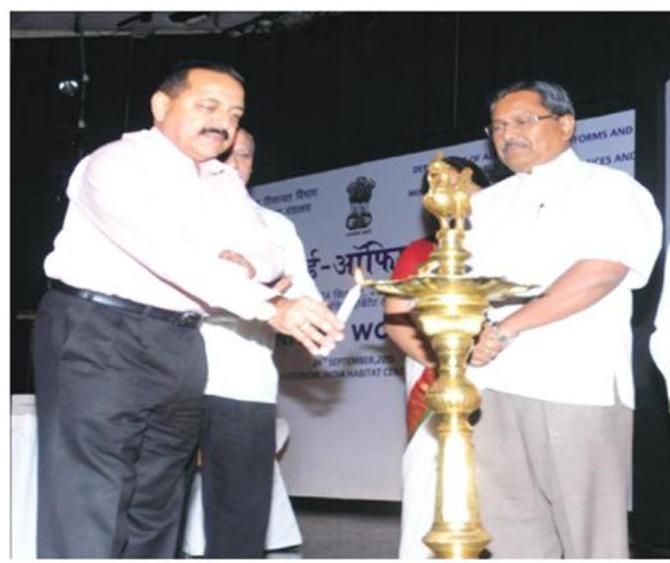
The Minister of State for Ministry of Personnel, Public Grievances & Pensions, Department of Atomic Energy, Department of Space, Dr. Jitendra Singh lighting the lamp to inaugurate the Workshop on Implementation of e-office in Central Ministries/Departments, in New Delhi on September 24, 2015.
Compliance With The Guidelines For Indian Government Websites (GIGW)
23.18 NIC had brought out the Guidelines for Indian Government Websites (GIGW) in the month of February, 2009. The GIGW was prepared based on the recommendations of an Inter-Ministerial Committee headed by the then Additional Secretary, Department of Administrative Reforms \& Public Grievances (DAR\&PG) and approved by the then Minister of State for Personnel, Pubic Grievances \& Pensions’. A copy of the GIGW is hosted both
on the websites of DAR\&PG and Department of Electronics \& Information Technology (DeitY).
23.19 A copy of the printed copy of GIGW was circulated by the DAR\&PG on $13^{\text {th }}$ May, 2009 to all the Ministries/Departments of the Government of India for taking necessary action for implementation of the guidelines and sends an Action Taken Report to DAR\&PG. In spite of reminders issued from the side of DAR\&PG and a letter from Cabinet Secretary, majority of the websites of the government are not GIGW compliant. The agency which provides certification for achieving GIGW compliance is Standard Testing and Quality Certification Directorate (STQC) under DeitY. Recently, STQC had carried out the audit of some 957 Government websites and had found that only 37 were found to be guidelines compliant. Cabinet Secretary, who is the head of the Apex Committee on Digital India, has desired that DAR\&PG should on a regular basis review the matter of getting majority of government websites GIGW compliant.
23.20 It is in this background, a Workshop was organized on 18.11.2015 with a view to sensitize all the Central/Ministries not only to get their own website GIGW compliant but also of the PSUs, Attached/Subordinate Offices and other offices under their administrative jurisdiction. In the Workshop, Smt. Neeta Verma, DDG, NIC made presentation on the salient features of GIGW and Smt. Mitali Chatterjee, Director General, STQC on the method of getting certification for getting GIGW compliance. A week long training programme was also organized by NIC/STQC to assist Central Ministries / Departments to make their respective websites GIGW compliant and to sort out any query regarding website certification.
Efforts for doing away with ‘Affidavits’ and allowing ‘Self- attestation’
23.21 The practice of submitting Notarised Affidavits and Gazetted Officer attested copies of certificates in various Government offices/ institutions was required since pre-independence for ensuring that no false declaration/ submissions / documents are made as any false declaration before a Civil Servant or on oath in case of an Affidavit attracted various penal sections of IPC such as Section 177, 182, 193, 197,198, 199 & 209 notwithstanding the fact that in as far as admissibility of documents under Indian Evidence Act is concerned, there was no weightage of affidavits over self declarations made by the petitioner himself / herself.
23.22 Taking this simple fact into consideration that such a system also causes lack of trust between the Government \& Citizen, some State Governments like that of Punjab have decided since 2009-10 to do away with the practice of submission of Affidavits / Gazetted Officer attestation and permitted selfcertification of documents. This has resulted in an annual saving of more than Rs. 300/- crore and has brought down the applications for such attestations from 14.5 lakhs per annum to mere 1.5 lakhs in the year 2013-14. This has benefitted the citizens immensely besides savings in the monetary costs such as travel cost, freedom from harassment apart from restoring trust and dignity between citizen and the Government. The State Government of Punjab received the Prime Minister’s Civil Services Award on $21^{\text {st }}$ April, 2015 for this initiative. As per estimate there could be a national saving of more than Rs. 8000 crore.
23.23 Therefore, the Department of Administrative Reforms \& Public Grievances, Government of India, has taken this initiative for replication across all Ministries / Departments of
Government of India and across all the States in the country. A number of meetings and video conference meetings have been held with the States \& GoI Ministries / Departments in this connection in the past two months. As a result, a number of State Governments like Odisha, West Bengal etc. have past two months. As a result, a number of State Governments like Odisha, West Bengal etc. have taken very encouraging steps in this regard. Thus in the case of Odisha, over 192 citizen centric facilities have been permitted use of self-attested documents for availing the services. The Government of West Bengal has given this facility across 47 Departments, such as School Education, Urban Development, Sports, Tourism, Housing, etc. Similarly the Ministry of Petroleum and Natural Gas allowed self-attestation in LPG connection and grant of dealership. The Ministry of External affairs has permitted the same facility in application for passports. The Ministry of Labour has also permitted self-attestation in various services concerning EPFO related matters. Other Govt of India entities which have granted similar facilities include I\&B, MoD, Posts, MHA, DoPT etc.
23.24 DARPG is pursing the matter with various other Ministries in the GoI and States to identify more schemes and services having citizen interface for introducing self- attestation. Regular monitoring is being done and the efforts are bearing fruits. The Delhi Government has also announced such self-attestation facility. Other State Governments are also taking the cue and much progress is expected to be achieved in the near future.
Chapter 24
INTERNATIONAL EXCHANGE AND COOPERATION
24.0 The Department of Administrative Reforms & Public Grievances deals with the of matters relating to international exchange and cooperation in the field of Public Administration and Governance, which includes, among other things, organizing programmes and visit of Indian delegations to foreign countries and visit of foreign delegations to India as part of projects / bilateral measures in furtherance of activities included in the Memorandum of Understandings (MOUs) / Agreements signed between India and other countries (bilateral or multilateral).
The aim of international exchange and cooperation component is to share information, best practices and personnel across national governments. Presently MOUs in the areas of Public Administration and Governance have been signed between six countries, viz., China, Singapore, Malaysia, United Kingdom (bilateral), Brazil and South Africa (under IBSA – trilateral). This has enabled exchange of visits and undertaking programmes/projects and activities in the field of Civil Services, Personnel Management, Public Administration and Governance.
Cooperation with International Institute of Administrative Sciences (IIAS)
24.1 The Department is an institutional member of the International Institute of Administrative Sciences (IIAS) since 1998. IIAS with its headquarters at Brussels, Belgium was established for the purpose of promoting the development
of Administrative Sciences, better organization and operation of public administrative agencies, improvement of administrative matters and techniques and for the progress of International Administration. Additional Secretary incharge of the Department has been on the Council of Administration of IIAS in ex-officio capacity. The membership enables the Government of India in getting information on the latest development in the field of public administration through participation in international meetings and seminars organized by the IIAS as well as through various journals, documents and study reports prepared/issued by them.
Special Secretary, Department of Administrative Reforms and Public Grievances, Ministry of Personnel, Public Grievances and Pensions participated in the $117^{\text {th }}$ Session of the IIAS Council of Administration held on $22^{\text {nd }}$ June, 2015 in Rio de Janeiro, Brazil. Efforts are being made for enhancing association of the Department with IIAS in terms of facilitating capacity building and training of Indian Government officers.
Cooperation with Commonwealth Association for Public Administration and Management (CAPAM)
24.2 The Commonwealth Association for Public Administration and Management (CAPAM), with its headquarters at Ottawa, Canada, is a membership organization dedicated to strengthening public management and consolidating democracy and good governance
throughout the Commonwealth. It was formed in 1994 as a result of decisions taken at the Commonwealth Heads of Government meetings in Harare in 1991 and in Cyprus in 1993. Since inception, CAPAM has grown to a network of over 1100 members across the Commonwealth countries. The Department of Administrative Reforms and Public Grievances became an institutional member of CAPAM in 1997. Secretary of the Department is on the Board of Directors of CAPAM.
The membership enables the Government of India to keep pace with the latest developments in the field of public administration, through participation in various programmes of CAPAM viz; International Innovations Awards Programme, International Innovations Cascading Programme, International Meetings, Seminars and Conferences organized by CAPAM, as well as through various publications, journals and study reports issued by CAPAM.
Secretary, Department of Administrative Reforms and Public Grievances, Ministry of Personnel, Public Grievances and Pensions attended the CAPAM Board of Directors Meeting held at Ottawa, Canada from $1^{\text {st }}$ to $2^{\text {nd }}$ May, 2015.
India-Brazil-South Africa (IBSA) Forum
24.3 Recognizing the emergence and consolidation of India – Brazil – South Africa (IBSA) initiatives and collaboration at regional and global level for promoting good governance and wishing to strengthen South-South cooperation, the three countries acknowledged that joint efforts and collaboration will position them as active players in helping to direct public administration and governance towards democratic values and social inclusion.
24.4 The Prime Minister of India, the President of Brazil and the President of South Africa met
in Brasilia (Brazil) on 13th September, 2006 for the 1st Summit meeting of the India-BrazilSouth Africa Dialogue Forum. Pursuant to the IBSA Summit decision as contained in the Joint Declaration issued on the occasion, an IBSA Working Group on Public Administration (WGPA) has been set up by the three countries. It has since held seven meetings and adopted the areas of cooperation – (i) integrated monitoring and evaluation, (ii) e-governance, (iii) human resource development, (iv) citizen oriented service delivery, (v) anti-corruption and ethics, and (vi) accountability and transparency. Collaboration in these areas represents the essence of the MOU which was signed on 17th October, 2007 in South Africa, during the 2nd IBSA Summit.
24.5 India taking the lead under IBSA cooperation programme in the field of public administration launched the IBSA web portal on public administration on 30th November, 2010 with Brazil and South Africa onboard. The web portal, a virtual centre of excellence in public administration, is a wide ranging web-based resource and an interactive platform for the IBSA partners to facilitate among them an exchange of ideas and knowledge on public administration. The web portal has since been shifted to website of Ministry of External Affairs.
24.6 The 7th WGPA meeting was held in New Delhi on $5^{\text {th }}-6^{\text {th }}$ March, 2011, where the Working Group decided a way forward in terms of an Action Plan for implementing the MOU in identified areas of interest.
India – China Cooperation
24.7 An MOU on cooperation in the field of Civil Services, Personnel Management and Public Administration between Department of Administrative Reforms and Public Grievances in the Ministry of Personnel, Public Grievances and
Pensions, Government of India and the Ministry of Human Resources and Social Security of the People’s Republic of China was signed on 27th May, 2010 during the visit of President of India to China from $26^{\text {th }}$ May to $31^{\text {st }}$ May, 2010. Areas of Cooperation under the MOU are – (i) capacity building and skills upgradation, (ii) improved systems of public service delivery, (iii) human resources development – civil services, (iv) human resources management in public sector, and (v) public sector reforms.
24.8 A Ministerial level delegation headed by Shri V. Narayanasamy, Minister of State, Personnel, Public Grievances & Pensions and Prime Minister’s Office visited China from 1417 January, 2013 to attend meetings with the Chinese side for carrying forward exchange and cooperation between two sides in the areas of interest indentified under MOU in the field of Civil Services, Personnel Management and Public Administration. Official level meeting held on 14th January, 2013 with officials of Department of International Cooperation, Ministry of Human Resources and Social Security, People’s Republic of China and Ministerial level meeting held on 15th January, 2013 between Hon’ble V. Narayanasamy MOS (PP) \& PMO, India and Mr. Yin Weimin, Minister of Human Resources and Social Security, PR China.
24.9 It was agreed that both sides will actively pursue the projects and activities for mutual exchange and cooperation as agreed upon in the official level and ministerial level meetings held on 14th and 15th January, 2013 respectively.
24.10 The Fourth India – China bilateral meeting was held on $29^{\text {th }}$ November, 2013. The Chinese side was headed by Mr Yang Shiqiu, Vice Minister of the Ministry of Human Resources and Social Security (MOHRSS) and the Indian side was headed by Mr. Sanjay Kothari, the then
Secretary (AR\&PG). Both sides agreed on a Plan of Action (PoA) for bilateral exchange and cooperation under the MoU.
India – Singapore Cooperation
24.11 As a part of its international collaborative efforts, the Department of Administrative Reforms and Public Grievances (DARPG) explored the possibility of sharing and exchanging administrative experiences with Singapore, particularly in the area of pubic administration and delivery of services, so as to improve upon the current system of governance and instill a greater sense of responsiveness, accountability, transparency, and achieving public service excellence in the context of public service delivery, good governance, public service reform, and capacity building and skills up-gradation.
24.12 Given the fact that high among the priorities of the two countries are public service reforms and good governance, a Memorandum of Understanding (MOU) between the two countries on cooperation in the field of Personnel Management and Pubic Administration was signed on 11th November, 2011. The areas of cooperation are – (i) capacity building and skills upgrading, (ii) improved systems of public service delivery, (iii) human resources management, (iv) public sector reform, and (v) leadership/talent development.
24.13 The first meeting of Joint Working Group on Public Administration of both sides was held in New Delhi on 19th March, 2012. Additional Secretary (DARPG) visited Singapore to share the experiences of the Singapore Model of Public Service Delivery and business processes during 25 – 27 September, 2012
24.14 A six member delegation led by Shri Alok Rawat, former Secretary, Department of Administrative Reforms and Public Grievances
(DARPG) visited Singapore from $19^{\text {th }}$ to $20^{\text {th }}$ January, 2015 to participate in $2^{\text {nd }}$ Joint Working Group Meeting between India and Singapore under the Memorandum of Understanding. Mr. Kwek Mean Luck, Deputy Secretary (Development), Public Service Division and CEO and Dean, Civil Service College, Singapore, led the delegation of Singapore Both sides agreed on a Programme of Action (PoA) with targets and milestones to achieve a concrete outcome in improvement of the systems of governance and service delivery.
24.15 In furtherance of the Programme of Action agreed to in the JWG Meeting, Secretary, DARPG held meetings with High Commissioner of Singapore on 13.07.2015 and 21.08.2015.
24.16 Two Training Programmes for officers of Central and States UTs Government are being organized. Under the Singapore Cooperation Programme (SCP) a training programme for the senior officers of Government of India in Public Governance and Administration, funded by Singapore Government, was organized during 23 – 27 November, 2015 in Civil Services College, Singapore. 14 officers including PM Award and national e-Governance Award winners attended the programme. Organizing a second training programme on e-Governance with special emphasis on online public service delivery in March, 2016 is under active consideration of the Government.
Indo-Malaysia Cooperation
24.17 An MoU on cooperation in the field of Public Administration and Governance was signed on 25.11.2013. Areas of Cooperation under the MoU in the field of Public Administration and Governance are – (i) human resources management, (ii) improved systems of public service delivery, (iii) e-governance, (iv)
accountability and transparency, (v) capacity building and skills up-grading, (vi) quality of outcome, (vii) governance reforms of both countries, and (viii) any other areas of cooperation in the field of Public Administration and Governance to be jointly decided by the Participants. Subsequently, First meeting of Joint Working Group (JWG) for implementation of the MoU was held on $26^{\text {th }}$ November, 2013 in Kuala Lumpur, Malaysia while the second JWG meeting was held during 26-27 August, 2014 in New Delhi.
24.18 The $3^{\text {rd }}$ India-Malaysia Joint Working Group Meeting on Public Administration and Governance was held in Kuala Lumpur, Malaysia from 28-30 September, 2015 to carry forward the implementation of MoU signed between the two countries. Shri Devendra Chaudhry, Secretary, Department of Administrative Reforms and Public Grievances, Ministry of Personnel, Public Grievances and Pensions led the Indian delegation while the Malaysian side was led by H.E.Dato’ Dr.Ahmad Jailani Bin Muhamed Yunus, Deputy Director-General (Operations), Public Service Department (PSD).
24.19 Both sides shared their best practices in the area of Public Service Delivery through exchange of ideas both countries would be able to incorporate best practices in management, technology and service delivery and agreed on a Plan of Action for bilateral exchange and cooperation under the MoU.
24.20 During the deliberations both sides agreed to the proposed establishment of a Joint Technical Group headed by Additional Secretary level officers from both countries to work out the implementation of agreed Programme of Action and a dedicated online platform to share resources on public service administration and governance between both the countries.
India – United Kingdom Cooperation
24.21 In consonance with multi-dimensional changes, Hon’ble Prime Minister has laid great emphasis on the goal of ‘Minimum Government with Maximum Governance’. Keeping this objective in view, Department of Administrative Reforms and Public Grievances is continuously exploring the possibility of having MoU with various foreign countries ranking high in the field of e-Governance especially in delivery of online citizen centric services.
24.22 In furtherance of this aim, Department of Administrative Reforms and Public Grievances, has signed a MoU on $11^{\text {th }}$ November, 2015 with the Cabinet Office, Her Majesty’s Government of the United Kingdom (HMG), for ‘Cooperation in Public Administration and Governance Reforms.
24.23 The main objectives of the MoU are to strengthen and promote bilateral cooperation between the two countries in public administration and governance. The areas of co-operation under this MoU includes (i) sharing good governance practices in public administration, (ii) user led service design, (iii) reducing bureaucracy in service delivery, (iv) government process re-engineering, (v) building and developing staff capability, (vi) public grievance redress mechanism, (vii) local government reforms, (viii) reforms towards strengthening of social security, (ix) collaboration in strategies for promotion of ethics in Government, (x) collaboration between Government and industry on staff management, (xi) mechanisms for public engagement, (xii) crisis and disaster management and (xiii) digital transformation of government.
24.24 As a prelude to signing of this MoU, UK side offered a tailor-made two week course on ‘Legislative Drafting’ for officers of Govt. of India / State Governments during 23rd November – $4^{\text {th }}$
December, 2015. A group of 15 officers from Central / State Governments were deputed for this course organized by ‘Sir William Dale Centre for Legislative Studies’ under Institute of Advanced Legal Studies, University of London. The aim of the course was to empower the participants to apply best international drafting practices to their own legal and regulatory system. The course was fully funded by UK side.
24.25 First meeting of the India-UK Joint Working Group was held in London, UK during 28 – 29 January, 2016.
24.26 Shri Devendra Chaudhry, Secretary, DARPG led the delegation of the Government of India. Both sides shared their best practices in the area of public administration, governance reforms and online delivery of citizen-centric services and explored the possibilities of adopting suitable best practices in these areas. Also Programme of Action (POA) has been agreed to by both the sides to take forward the new initiatives under the overall ambit of the MoU.
Partnership Agreement with Government of France
24.27 The Department of Administrative Reforms and Public Grievances, Ministry of Personnel, Public Grievances & Pensions has signed a Partnership Agreement on $25^{\text {th }}$ January, 2016 with Ministry for Devolution and Civil Service of the Government of France on ‘Public Administration and Administrative Reforms.
24.28 The main objectives of the Partnership Agreement are to strengthen and promote bilateral cooperation between the two countries in public administration and governance. The areas of co-operation under this Partnership Agreement includes, cooperation in the field of civil services, human resource management,
public administration and administrative reforms for mutual benefit of the official and institutional level, in such areas as the Parties agree upon in writing, including, but not limited to sharing good governance practices in Public Administration and Citizen Centric Administration.
GOI-UNDP Project “Strengthening Public Administration and Governance”
24.29 The Department of Economic Affairs on behalf of Government of India and United National Development Programme (UNDP) have signed the Country Programme Action Plan (CPAP) 2013-2017. CPAP 2013-2017 is also aligned with the main aims of the Government’s $12^{\text {th }}$ Five Year Plan and with the 2013-2017 United Nations Development Action Framework (UNDAF).
24.30 Department of Administrative Reforms & Public Grievances (DARPG) is implementing partner for the Project titled “Strengthening of Public Administration and Governance” under Country Programme Action Plan (CPAP) 20132017.
The Project aims to achieve – (a) improved capabilities of institutions and individuals responsible for public administration and governance, deeper understanding of administrators on factors that contribute to success or failure of service delivery under Government programmes, and increased cooperation in the area of public administration globally including the South-South context.
The project is fully funded by UNDP.
24.31 Under DARPG-UNDP Project, UNDESA Expert visited India during August 24-28, 2015. In the latest 2014 UN E-Government Survey, India ranks $118^{\text {th }}$ rank on e-Governance Index globally. During the visit, UN / UNDP
delegation held discussions with various Ministries / Departments of GoI like DARPG, DoT, DeitY etc. The team also met the civil society and executives of Private Sector working in the area of ICT and e-Governance. A Workshop on ‘e-Governance Solutions and Workable Ideas under the Digital India Programme’ was also organised with effective participation of DAR\&PG and DeitY, representatives from State Government, private sector and civil society on e-Governance. Subsequently, Focus Group discussions with some of the executives of Private Sector on e-Governance Development were held so as to understand their perspective, with a focus of developing successful viable business models of e-Governance. UNDP officers also made a field visit to Bengaluru, Karnataka to study the actual implementation of e-Governance initiatives by Government of Karnataka.
24.32 On 28th August, 2015 a team from UN / UNDP met Hon’ble Minister of State for Prime Minister’s Office and Personnel, Public Grievances and Pensions. The team also met Cabinet Secretary and Additional Secretary in PMO. A draft Action Plan to improve India’s e-Governance Index globally was submitted. To take this further, the Hon’ble MOS (PP) approved constitution of a Steering Committee under the chairmanship of Secretary (AR\&PG) and a Core Committee under the chairpersonship of Additional Secretary (AR\&PG). These Committees will meet at regular intervals to take stock, coordinate and supervise the efforts taken by various Central and State level agencies in implementation of the vision and mission of the Government on e-Governance in time bound manner.
24.33 Foreign Training Programme for Senior/Middle Level Management Officers of Government of India and States/UTs as part of
its international collaborative efforts, Department of Administrative Reforms & Public Grievances has been exploring the possibility of learning and sharing the administrative experiences of other countries, particularly in the area of e-Governance and on-line delivery of public services, so as to improve upon the current system of governance and instill a greater sense of responsiveness, accountability and transparency and to bring in fresh insights and new perspectives in these areas.
24.34 During this year, the Department has organized five days Short-term Foreign Training Programmes on the theme ‘Minimum Government with Maximum Governance’ through e-Governance based Citizen Centric On-line Services, in line with the initiatives of ‘Digital India’/e-Gov/m.Gov and other Flagship Programmes launched by the Hon’ble Prime Minister of India, in selected Foreign Training Institutions in the countries listed top in the UN E-Government Survey 2014.
24.35 The Department has deputed two groups, one group comprising 9 officials and the $2^{\text {nd }}$ Group comprising 15 officials from Government of India and the States/UTs, including PM Award winners/National e- Governance winners on five days foreign training programme in The Dutch
Institute for Public Administration (PBLQ), The Hague, Netherlands, during 15 – 19 February, 2016 and 22 – 26 February, 2016 respectively.
24.36 Participation of officers in the training programme will help them to study and understand the system of customer oriented public service delivery in Netherlands with reference to rapidly changing environments in the area of public service management and enable them in adapting, innovating and replicating some of the best practices and processes in India, leading to improved public service delivery in the country.
Visit of Senior Official from Sri Lanka
24.37 Mr. T. Kodikara, Additional Secretary to the President, Presidential Secretariat, Colombo, Sri Lanka visited Department on $21^{\text {st }}$ October, 2015 to understand the good governance and public Administration in Indian context. Secretary (AR\&PG) and Additional Secretary (AR\&PG) and other senior officers held discussions with Mr. Kodikara and shared their experiences on subjects relating to Sevottam, Citizen Charter, Centralised Public Grievance Redress and Monitoring System (CPGRAMS) – an online public grievance lodging and monitoring system.
Chapter 25
DOCUMENTATION AND DISSEMINATION DIVISION
MANDATE
The Documentation and Dissemination Division of the Department primarily carries out the activities of documentation, incubation and dissemination of good governance practices of Centre, State/Union Territory Governments with a view to sharing of experience with each other and replication elsewhere. Besides, the Division also brings out periodic publications and maintains repository of reference material concerning public administration, management, information technology, human resource development in the shape of rich and well equipped library.
25.1 The Documentation and Dissemination Division of the Department primarily carries out the activities of documentation, incubation and dissemination of good governance practices of Centre, State/Union Territory Governments with a view to facilitate sharing of experience with one another and replication elsewhere. Besides, the Division also brings out periodic publications and maintains repository of reference material concerning public administration, management, e-Governance, human resource development in the shape of rich and well equipped library.
25.2 State governments and Union Territory administrations have taken several initiatives in Good Governance from time to time. However, the documentation of the process of conceptualizing and implementing these initiatives/practices is often confined to newspaper reports and official briefs. This is largely due to the fact that the people involved in the process have little time or patience to document it. In the absence of professional documentation, it is not possible to make an evaluation of these initiatives and take steps for their replication in other States/UTs or
elsewhere. The activities dealt by the Division are detailed in the following paragraphs.
Financial Assistance to State Governments/ UT Administrations for professional documentation and dissemination of ‘Good Governance Practices’ –
25.3 The objective of the scheme is to provide financial assistance to support professional documentation and dissemination of good governance initiatives by the State/UT governments with a view to sharing experience with each other and replicate elsewhere. Till date, this Department has granted financial assistance for professional documentation of 72 Good Governance initiatives of 21 different States/UTs.
25.4 The scheme of providing financial assistance to the State governments/UT Administrations has been reduced with effect from the current Financial Year (FY). Till 2014-15, an amount of upto Rs. 3 lakh was granted for paper documentation but it has now been reduced to Rs. 2 lakh this (FY) onwards. Further, the document will be in e-Book form now and not in paper form as it used to be till 2014-15.
Series of Presentations on Best Practices:-
25.5 In order to facilitate replication of the successful good governance initiatives in other States, a novel initiative was taken by the Cabinet Secretary in January 2005 with the introduction of this presentation series on Best Practices. Presentation is being organised before a select group of Secretaries and senior officers of State governments and Central Government Departments. Champions of the Best Practices are called for making the presentation. Already 24 such presentations on diverse topics were made which were well-attended by senior officers from the Central as well as State governments. This year, the Department of AR&PG organised National Workshop on Best Practices in Citizen Centric Governance on September, 10-11 ${ }^{\text {th }} \mathbf{2 0 1 5}$ in Vigyan Bhavan, New Delhi. The event was inaugurated by Dr. Jitendra Singh, Hon’ble MoS (PP), and attended by Officers and Academicians including Secretaries to the Government of India, Chief Secretaries, Secretaries and other officers from the State governments/ UTs, Faculty and trainees from Administrative Training Institutions, Resident Commissioners and Faculty members from renowned academic institutions in Delhi/ NCR. More than 300 delegates participated in the event from all over
the country. The presentations on the following initiatives were followed by panel discussion:-
- Self Attestation and Rationalisation for reforming Public Service Delivery Affidavits (Punjab)
- SAKALA-No More Delays(Karnataka)
- Madhya Pradesh Guarantee of Public Service Delivery Act
- LADO An Innovative Initiative of Eradication of Child Marriages(MP)
- Surguja Fulwari Initiative(Chhattisgarh)
- Skill Development Programme to impart Vocational Training to the Tribal Youth (Maharashtra)
- Revival of Sasur Khaderi and Thithora Lake
- Canal Top Solar Power Plant : Clean and Green Energy(Gujarat)
- Cervical Cancer Screening(Tamil Nadu)
- Presentation On e-Office
- Passport Seva Project (Ministry Of External Affairs)
- Kanyashree Online (West Bengal)
- Suraksha Setu – Safe City Surat (Gujarat)
- Public Grievance – CPGRAMS(DARPG)
- Supporting Government to enhance Best Practices (UNDP)
National Workshop on Best Practices in Citizen Centric Governance on September 10-11, 2015
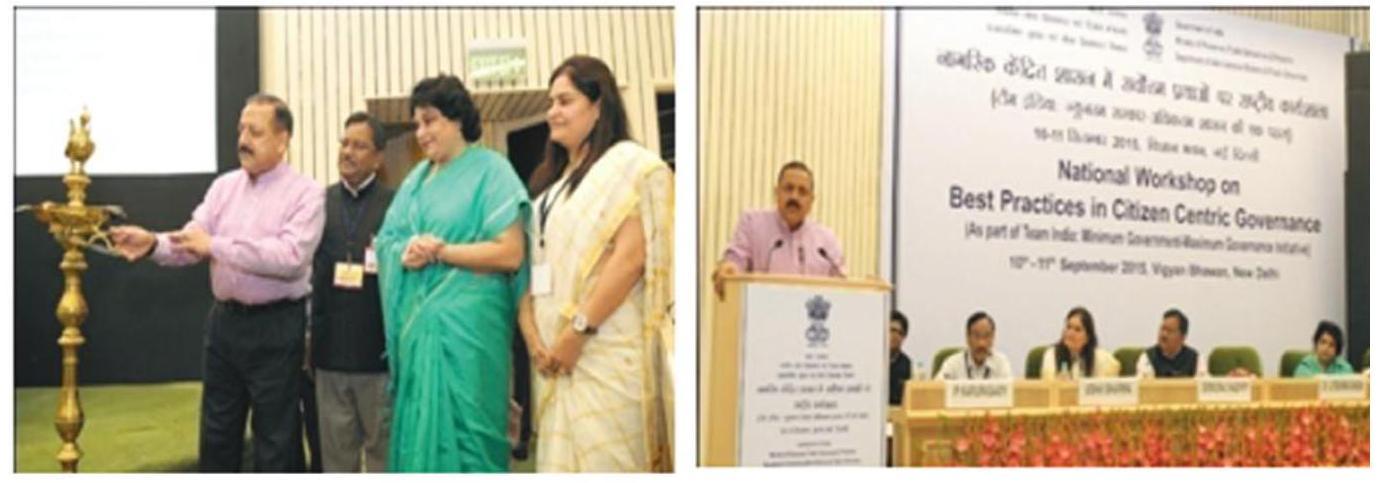
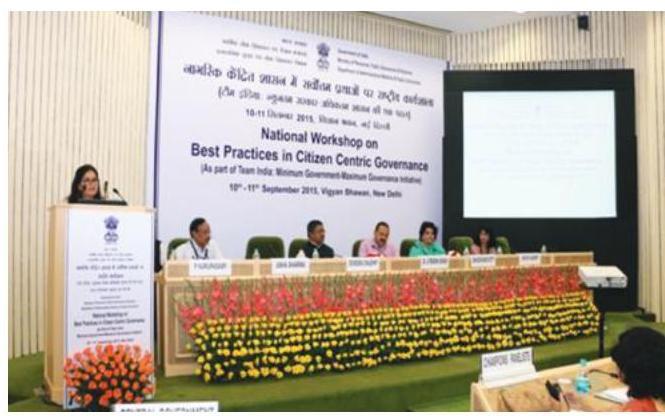
The Additional Principal Secretary, PMO, Dr. P.K. Mishra attended the Valedictory function as Chief Guest.
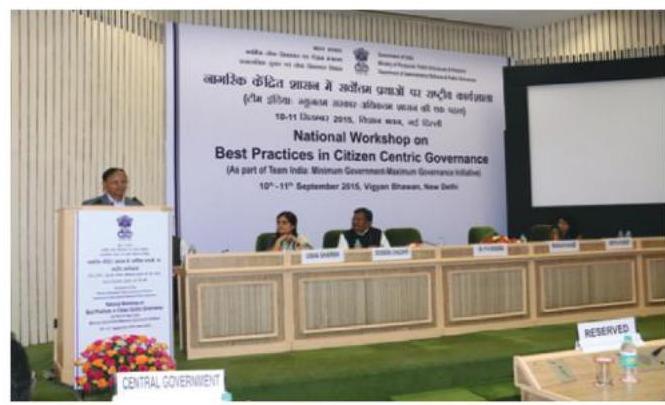
Dr. P.K. Mishra, Additional Principal Secretary, PMO, addressing the Valedictory function during National Workshop on Best Practices in Citizen Centric Governance on September 11, 2015
25.6 Quotes by Dr. Jitendra Singh, Hon’ble MoS (PP) during National Workshop on Best Practices in Citizen Centric Governance on September 11, 2015
- Department of Administrative Reforms and Public Grievances (DARPG) is basically a Research & Development Department for Good Governance. “This Department is a torch bearer of Good Governance and for carrying forward the vision of Minimum Government Maximum Governance”.
- “The present Government has institutionalised the Citizen Centric system with the aim to wipe out the tears of last man in the line”.
- Shri Shyama Prasad Mukherjee and Shri Din Dayal Upadhayaya are the two icons of Good Governance:-
a) Shri Shyama Prasad Mukherjee carried forward his vision of good governance through three Cs; Capability, Courage and Conviction, which is a lesson to be followed by present day Civil Servants to carry forward good governance.
b) Shri Din Dayal Upadhayaya developed the concept of “Antyodaya” which means upliftment of the poorest of poor, which is citizen centric in real sense. - The Minister re-assured “Government’s commitment to create a friendly environment for Civil Servants to work and to realize their potential to carry forward Good Governance”.
25.7 Quotes by Shri Devendra Chaudhry, Secretary (DAR\&PG) during National Workshop on Best Practices in Citizen Centric Governance on September 11, 2015
a) The Secretary concluded his inaugural address with the remark “YOU CANNOT TRAVEL THE PATH UNLESS YOU BECOME THE PATH ITSELF”.
b) National Workshop on Good Governance (10-11 September 2015) is an effort towards implementing the vision of Hon’ble PM to reach the Benefits of Good Governance to the Last Citizen at the Last Mile by deliberation on the
innovative efforts in Public Governance and replicating these practices using tools of e-Governance for bringing efficiency and quality in public service. The workshop aimed at replicating the Best Practices in Citizen Centric Governance including using tools of e-Governance to bring in common efficiencies and sustained high quality of public service.
c) Key Strategy of the Department is to facilitate dovetailing the schemes of the GOI and the States for quick implementation.
Organisation of Regional Conferences on “Learning from successes”: –
25.8 Regional Conferences are organised on specific themes in association with various State/Union Territory Governments with a view to bring National and State level organizations along with other stakeholders including NGOs, intelligentsia, media etc. This year on the same platform to share experiences in the formulation and implementation of good governance practices. This year, a Regional Conference on ‘Minimum Government, Maximum Governance as part of GATI-Governance with Accountability, Transparency and Innovation was organized on 14-15 December, 2015 at Bengaluru, Karnataka.
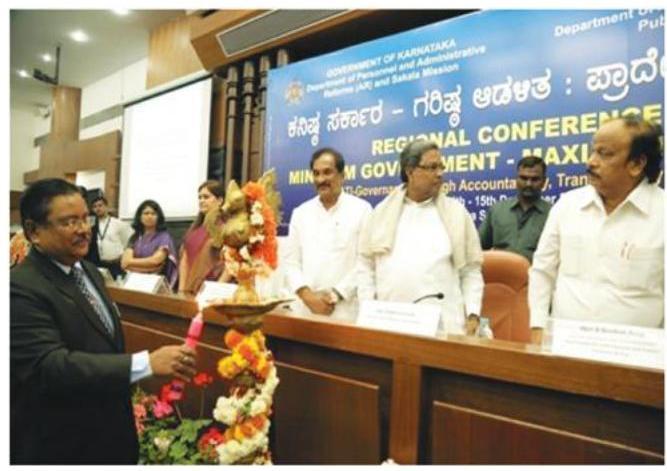
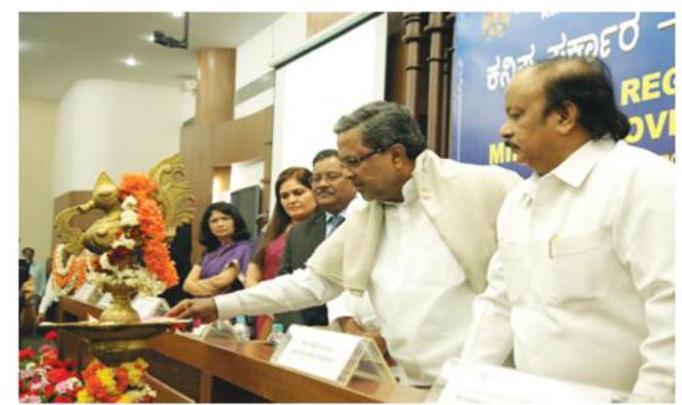
The Chief Minister of Karnataka, Shri K. Siddaramaiah lighting the lamp to inaugurate the two-day Regional Conference on “Minimum Government-Maximum Governance” as part of GATI (Governance with Accountability, Transparency and Innovation), in Bengaluru on December 14, 2015.
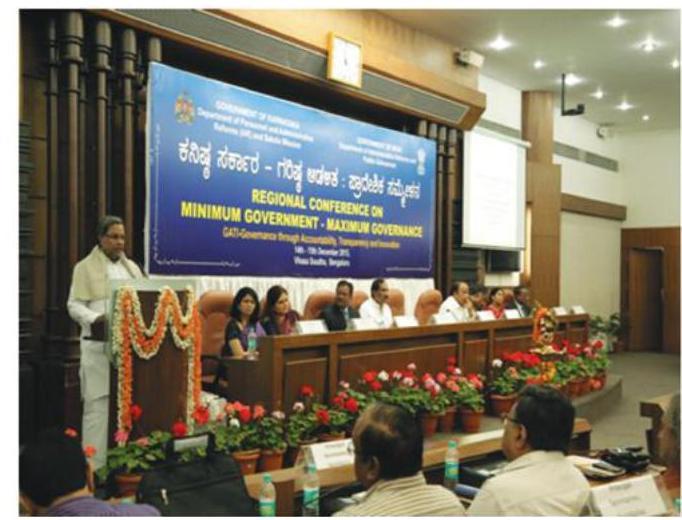
The Chief Minister of Karnataka, Shri K. Siddaramaiah addressing the gathering after inaugurating the two-day Regional Conference on “Minimum Government-Maximum Governance” as part of GATI (Governance with Accountability, Transparency and Innovation), in Bengaluru on December 14, 2015.
Publication of Book:
25.9 This Division publishes a book containing articles on select award winning good governance practices. These articles are on the initiatives
which have been conferred Prime Minister’s Award or National e-Governance Awards. This compilation is immensely useful for the administrators as the dissemination of success stories facilitates replication of the same elsewhere also. The Division has already published a series of books on the subject. These are – Ideas that have Worked, Vichar Jo Kamyab Huye (Hindi version of Ideas that have Worked,) Learn from Them, Inse Seekhe (Hindi version of Learn from
Them), Splendour in the Grass, Roofless Towers, Management by Listening, In Search of Light, People First, Some gems Some Pearls, Thinking Out of the Box and Lighted Windows. A book titled, “Tommorrow is Here” containing articles on 8 National e-Governance Awarded initiates, published by the Department of AR&PG, was released by the Hon’ble PM on April 21, 2015 (Civil Services Day).
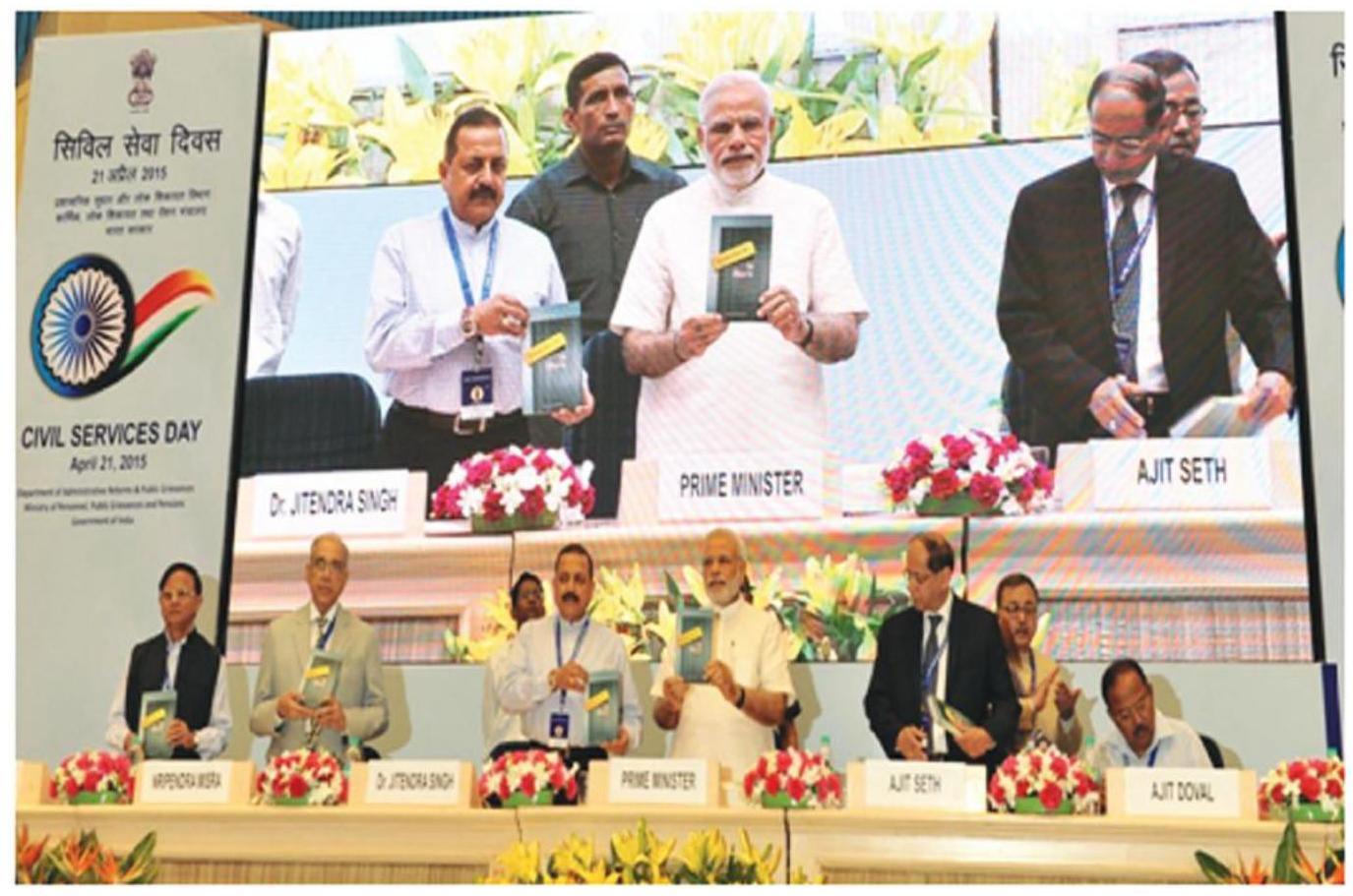
Prime Minister during launching of Book Tommorrow is Here on the Civil Services Day, 2015
Production of Documentary Films on Best Practices:
25.10 One of the objectives of the Department of Administrative Reforms \& Public Grievances is to promote best practices. Many States have achieved excellence in various aspects of administration and service delivery. It would be useful to gain from the experiences of each
other by exchange of ideas. The Department is engaged in producing documentary films on best practices across the country. These films are immensely useful for the administrators and the dissemination of success stories would facilitate replication of the same elsewhere also. Seventy three such documentary films are already produced. The films are available on the website of
the Department and Youtube for public viewing. In the fiscal year 2015-16, six documentary films are being produced.
Research & Evaluation Studies on Good Governance Initiatives: Research and Evaluation Studies
25.11 In the 12th Five Year Plan scheme of the Department of AR \& PG, a new activity, namely ‘Research and Development Studies’ has been introduced. The objective of the activity is to promote research and Development in State Governments. In addition, impact assessment/ review/survey of sustainability of Prime Minister’s Award winning initiatives, sustainability of National e-Governance Award winning initiatives, effectiveness of various schemes of this Department can also be taken up. A Research and Evaluation Study has been conducted by M/s. KPMG Advisory Services Pvt. Ltd. for the year 2013-14. The report was submitted by them in June 2014. It has been circulated to all the State Governments. UT Administrators, Training Institutes, Central Government Ministries/Departments.
In 2015-16, research and evaluation study on 12 select good governance initiatives is being conducted.
Publication of ‘Minimum Government – Maximum Governance’ – A Quarterly Journal:
25.12 Department of Administrative Reforms and Public Grievances was bringing out a quarterly journal “Management in Government” (MIG) since 1969 in order to provide forum for frank exchange of views and opinions among administrators, academicians, scholars and others interested in public administration and public sector management. The focus of journal is on application of management techniques to practical situations of public administration as well as on conceptualisation of principles of good management based upon experience of live situations. The Department of AR\&PG has now renamed and launched first e-Book (Departmental Magazine) with the name of “Minimum Government – Maximum Governance” on 22.10.2015. The first issue of the e-Book is based on the best practices which were conferred PM Award for Excellence in Public Administration.
Chapter 26
HINDI SECTION
- Hindi Section of the Department of Administrative Reforms and Public Grievance is committed to comply with various guidelines issued by the D/o Official Language to promote the usage of Hindi language in the office.
- The main function of the Section is to render Hindi translation of the works given by various sections/officers of the Department and implementation of the official language Policy, which mainly include compilation of quarterly reports received from various sections of the Department and send it in an integrated form to the D/o Official Language in time; organizing quarterly meeting to discuss these reports, organizing
workshop and Hindi fortnight in the month of September every year. In addition, all the officers/sections are made aware of the guidelines issued from time to time by the D/o Official Language in connection with promotion of Hindi and their compliance is also ensured. Hindi fortnight was organized in the Department in September, 2015 wherein various competitions were held i.e. Essay writing competition, Noting drafting competition, Translation and wordphrases and General Knowledge etc. Many officers/employees participated in these competitions and merit certificates and cash prizes were given to the winners of these competitions.
Chapter 27
DEPARTMENT OF PENSION AND PENSIONERS’ WELFARE
MANDATE
27.0 The Department of Pension & Pensioners’ Welfare was set up in 1985 as part of the Ministry of Personnel, Public Grievances and Pensions to formulate policy and coordination of matters relating to retirement benefits of Central Government Employees (Civil, Defence
Vision
Active and dignified life for Pensioners
Mission
- Formulation of Pension Policy.
- Timely and smooth payment of pension and other retirement benefits for Central Government Employees.
- Simplification of rules/guidelines and procedure and their dissemination.
- Facilitating prompt redressal of the pension related grievances.
and Railway Pensioners). The Organisational Chart is at Annexure-IX and Incumbency position of Group ‘A’ Officers is at Annexure-X. As per the Citizen’s Charter of Department of Pension \& Pensioners’ Welfare, the ‘Vision’ and ‘Mission’ are given below: - Promoting the welfare of pensioners.
27.1 The Department administers the following rules:
i. CCS (Pension) Rules, 1972
ii. CCS (Commutation of Pension) Rules, 1981
iii. CCS (Extra-ordinary Pension) Rules – 1939
iv. GPF (CS) Rules, 1960
v. CPF (India) Rules, 1962
27.2 The approximate number of pensioners as on $31^{\text {st }}$ March, 2015 is as follows:
| Category of Pensioners | No. of Pensioners |
|---|---|
| Civil | $13,23,726$ |
| Defence | $24,61,651$ |
| Postal | $3,20,130$ |
| Railways | $13,71,748$ |
| Telecom | $2,81,000$ |
| Total | $57,58,255$ |
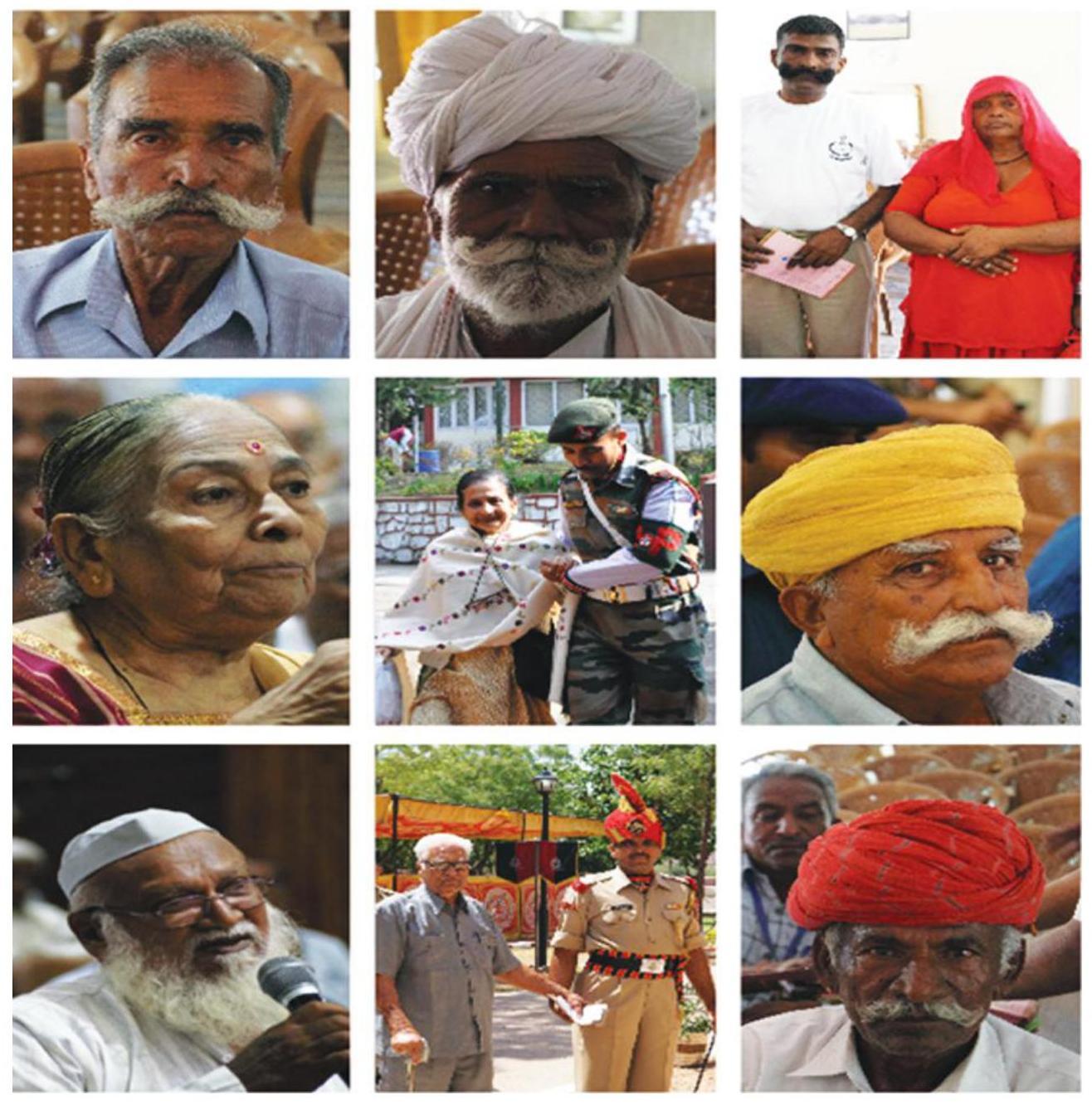
Our family
Pensioners’ Portal:
27.3 The Department of Pension & Pensioners’ Welfare has developed a web-based ‘Pensioners’ Portal’, a Mission Mode Project (MMP) under the National e-Governance Plan of Government of India. The Portal inter-alia provides for dissemination of pension related information as well as registration of pensioners’ grievances online. It has non-interactive and interactive
components. The non-interactive part contains updated information on pension rules and various instructions issued there under etc. The interactive part involves personalized pension road map, online calculators for pension, family pension, etc. and online registration of grievances of pensioners and their redressal. 35, 75,252 hits were received on Pensioners Portal (as on 07.03.2016)
Standing Committee of Voluntary Agencies (SCOVA):
27.4 A Standing Committee of Voluntary Agencies (SCOVA) has been set up under the Chairmanship of MOS (PP) with a view to provide feedback on the implementation of policies/programmes of this Department besides mobilizing voluntary effort to supplement the
Government action. The SCOVA consists of a Standing Group (5 members) and a Rotating Group (10 members). SCOVA was reconstituted in August, 2015. SCOVA meeting for the financial year 2015-16 was held in October, 2015 which was attended by representatives of various Pensioners’ Associations and the Ministries/ Departments.
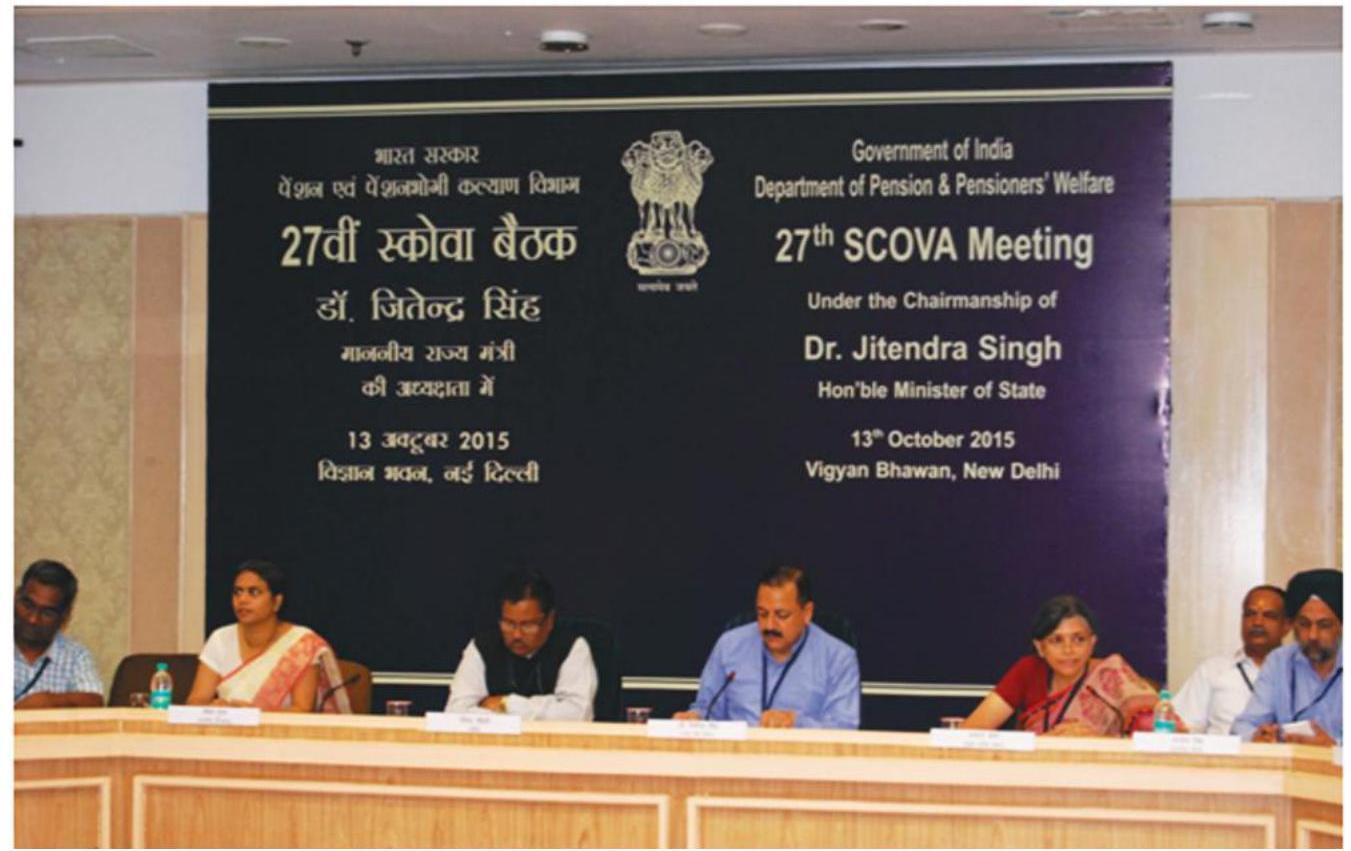
SCOVA Meeting on $13^{\text {th }}$ October, 2015
Dearness Relief to Pensioners/Family Pensioners:
27.5 Rates of Dearness Relief (DR) currently payable to Pensioners/Family Pensioners have been revised from time to time. Currently these are payable at the following rates:
i. With effect from 01.01.2015 113 per cent
ii. With effect from 01.07.2015 119 per cent
For the convenience of all Ministries/Departments and Banks/ Treasuries/Post Offices, orders are hosted on the website of the Department. This facilitates faster payment of enhanced DR by Pension Disbursing Authorities.
The process has been streamlined to ensure that enhanced DR orders are issued with a minimum time lag with reference to the orders for enhancement of D.A.
27.6 New Initiatives of the Department
(i) SANKALP
There are close to 40,000 fresh retirees from the Central Civil category every year. Given that the average life expectancy today is 69.2 years, whereas the age of retirement is 60 , it is apparent that a Government servant will have many years of active life left after retirement which could be fruitfully directed towards contribution to Society.
A number of pensioners feel the loss of a daily routine as well as a feeling of not being wanted. Keeping these factors in mind a new initiative of the Department christened as Sankalp has been taken up to channelize experiences and skill of retired government servants towards meaningful interventions in Society. 19 Pensioners Associations, 1614 pensioners and 16 organisations have already been registered under Sankalp.

Workshop on Sankalp in Delhi
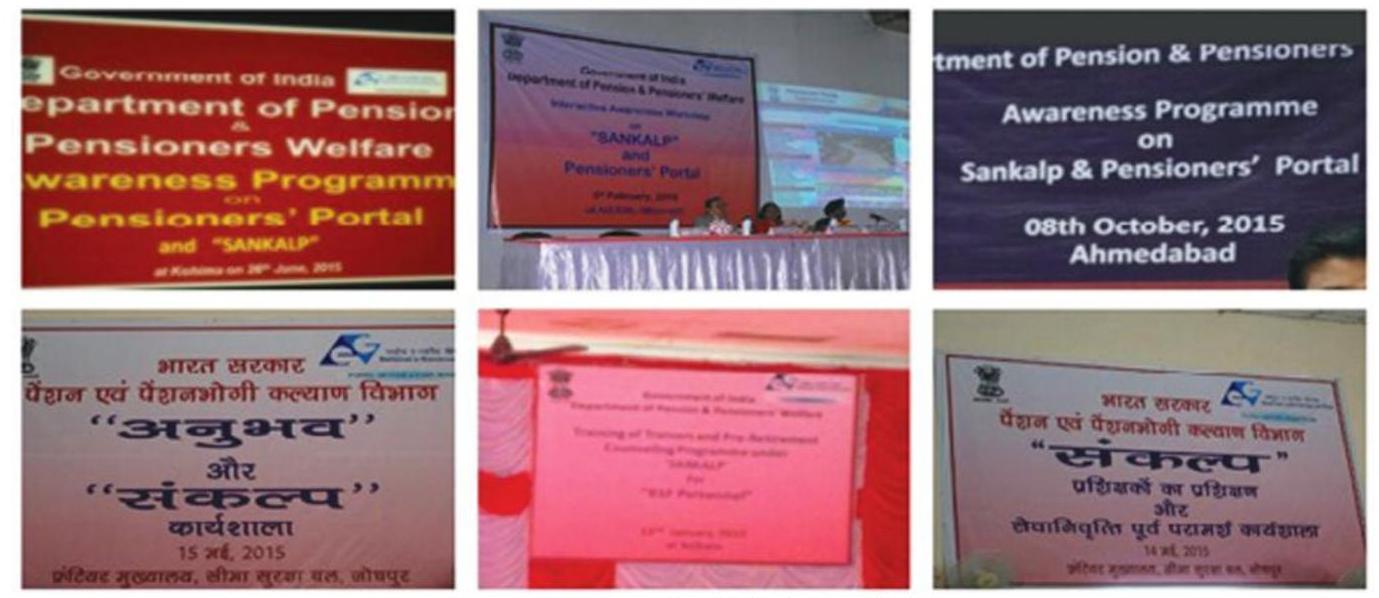
Programmes on Sankalp during 2015
Under this initiative the Department is also conducting Pre Retirement Counseling sessions (PRCs) for employees retiring in near future. 28 PRCs have been conducted till date which
benefited 1688 retiring/retired personnel of various Ministries and Departments of Government of India. PRC covers aspects relating to timely payment of pension and processing
formalities, CGHS benefits available to pensioners, investment options, preparation of Will and post retirement voluntary effort.
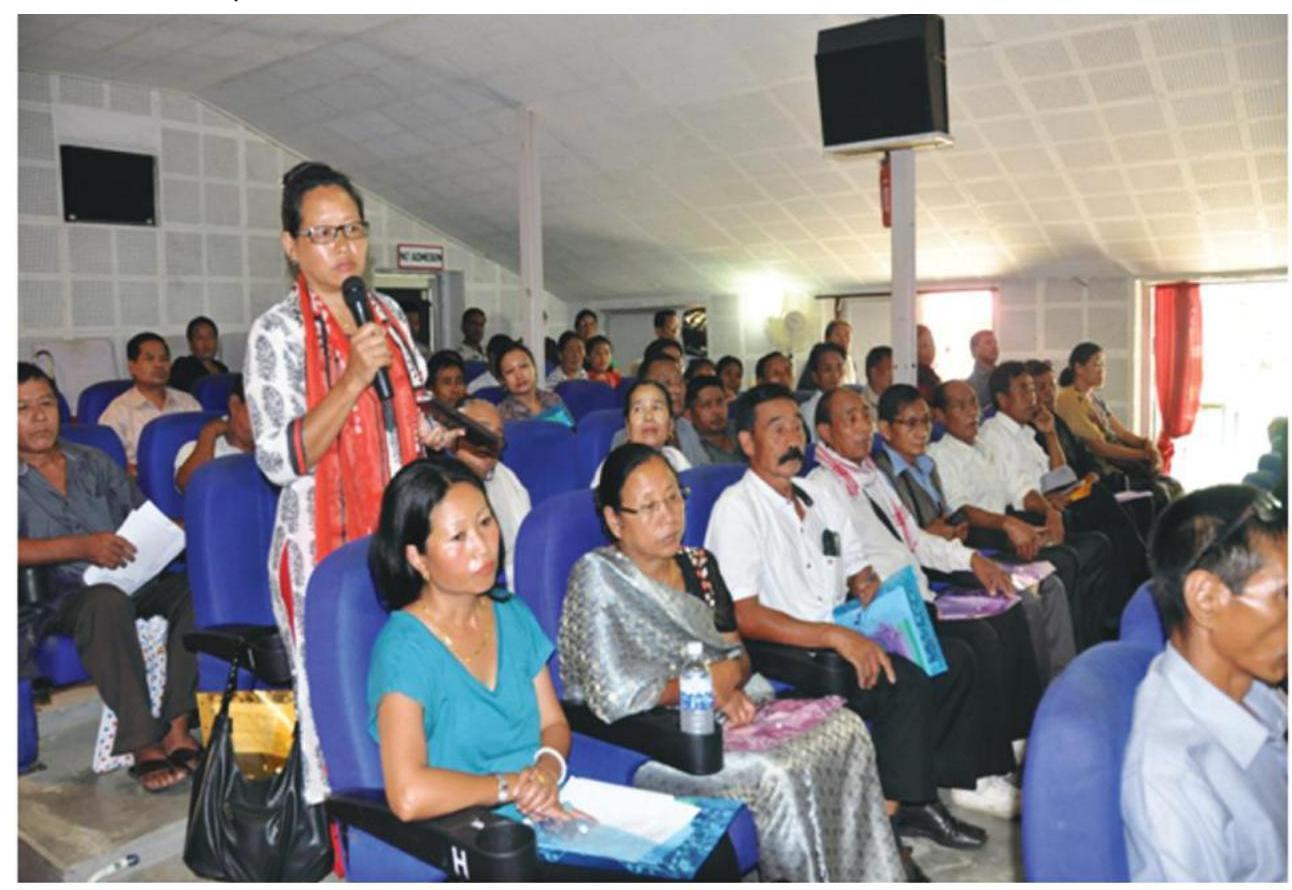
Pre- Retirement Counseling in Kohima, Nagaland on 26.06.2015
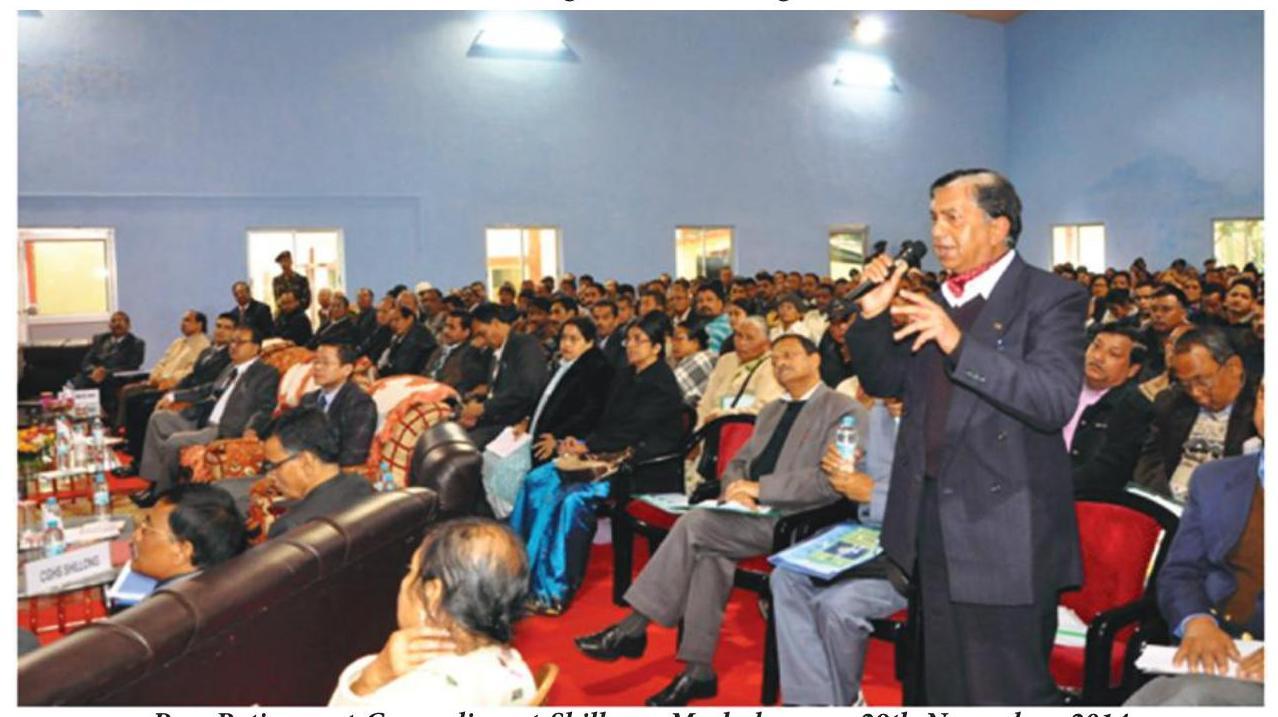
Pre- Retirement Counseling at Shillong, Meghalaya on 29th November, 2014
‘Training of Trainers’ on conduct of PRCs has been initiated to strengthen in house capabilities of Government Ministries/Departments for conduct of Pre-retirement Counseling for
their retiring employees. The Department has conducted 7 ‘Training of Trainers’ workshops till November, 2015 creating a pool of around 502 trainers.
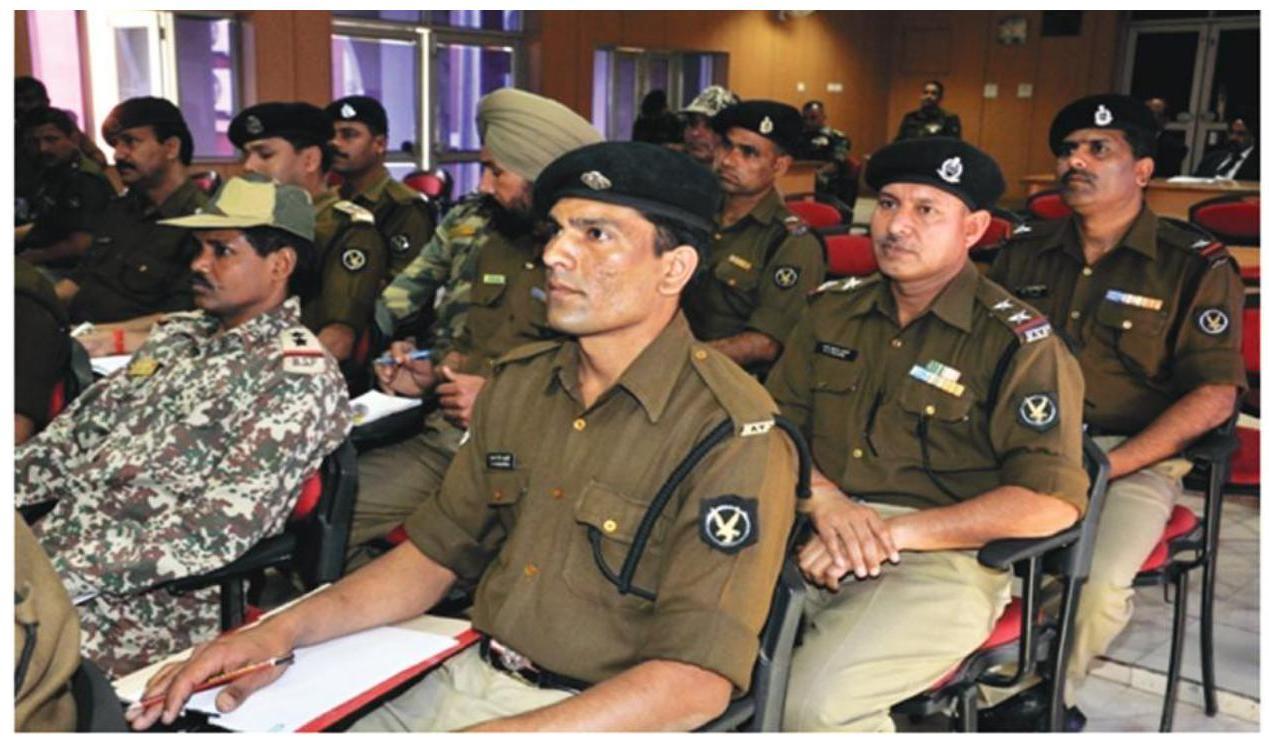
Training of Trainers of BSF, Tekanpur on 20.02.2015
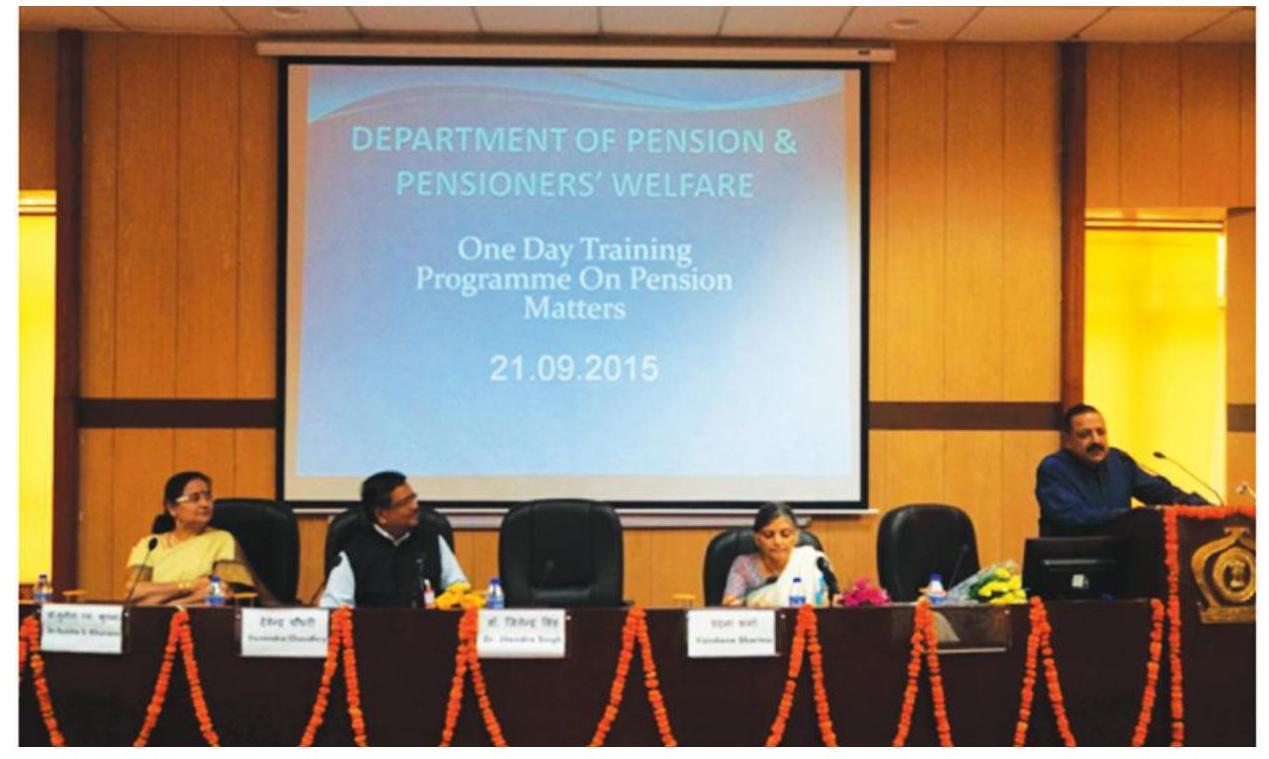
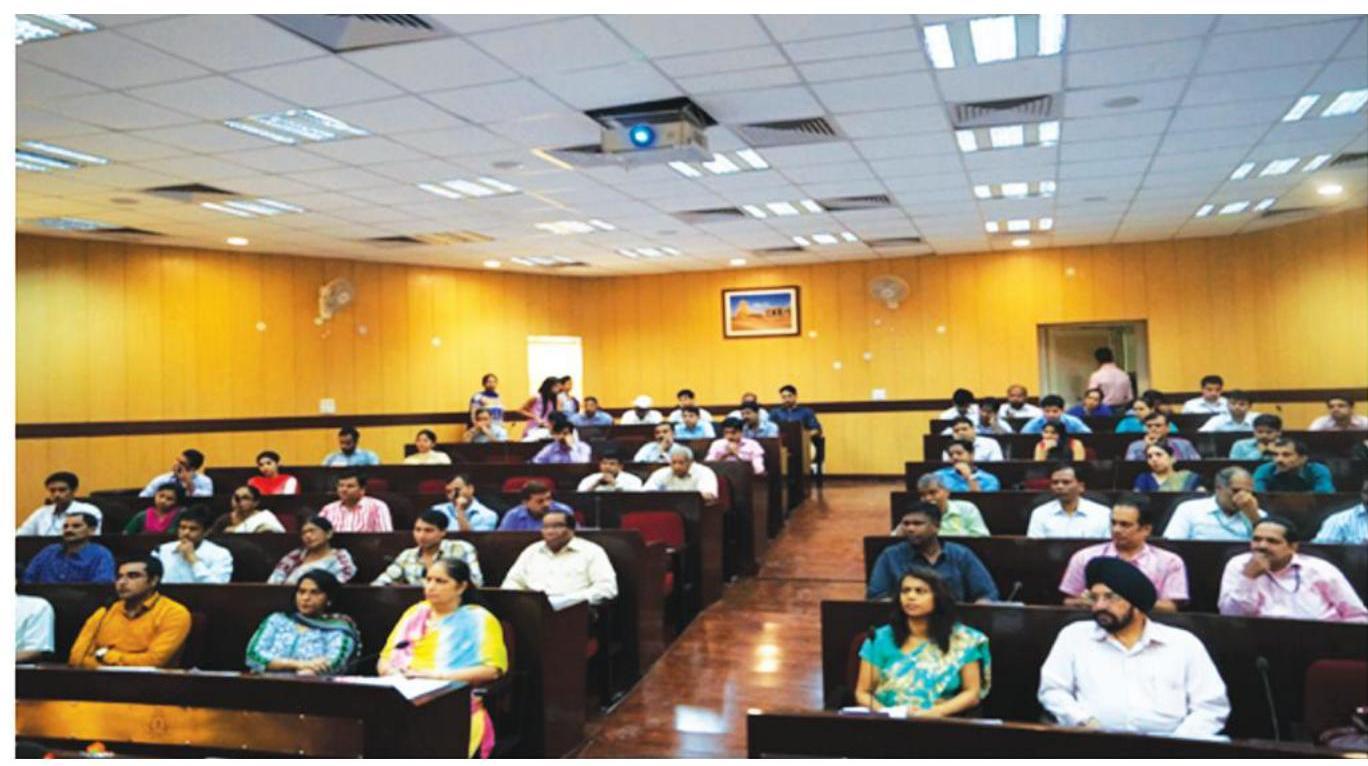
Training of Pension Policies at ISTM, Delhi on $21^{\text {st }}$ September, 2015
(ii) Bhavishya -Online Pension Sanction and Payment Tracking System
The Department is implementing an online Pension Sanction and Payment Tracking System called ‘BHAVISHYA’ Progress of each pension case can be tracked by the individual as well as the administrative authorities for all actions preparatory to grant of pension and other retirement benefits as well as monthly pension paid after retirement. Once implemented in all Ministries/Departments etc., the Department of Pension & Pensioners’ Welfare will know in advance the number of employees retiring from the Government of India in the next 12 months and the status of each of these cases.
This system captures the pensioners personal and service particulars. The forms for processing of pension can be submitted online. The system keeps retiring employees informed of the progress of pension sanction process through SMS/e-mail.
The system will introduce transparency and
establish accountability in the pension sanction and payment process. It will help eliminate delays and bring satisfaction to the retiring employees and pensioners.
The Bhavishya application can also be used for issuing Pensioners’ Identity Cards to the pensioners whose pension case is processed through this application.
“Bhavishya” has various stakeholders – i) Individual (Retiree\& Pensioner), ii) Drawing \& Disbursing Officer, iii) Head of Office (HOO), iv) Directorate of Estate (DOE), v) Pay \& Accounts Offices (PAO) and vi) Central Pension Accounts Office (CPAO).
As on date 08.03.2016, Bhavishya is being implemented in main Secretariat of 87 Ministries/ Departments \& 205 attached offices involving 1570 DDOs which are in various stages of processing pension cases of 6822 retiring employees. The application has so far finally processed and issued PPOs in respect of $\mathbf{1 2 0 5}$ pensioners.
Sensitization on Bhavishya application and its process through training programmes had already been imparted to Head of Offices and Drawing & Disbursing Officers of Main Secretariat of 83 Ministries/Department. In addition, this Department had organized four half day training Sessions on 5th and 6th November, 2015 at Institute of Government Accounts \& Finance (INGAF), Delhi for Pay \& Accounts Offices.
173 officers from 66 Pay \& Accounts Offices located in Delhi had participated in the said training prorgramme.
Department of Pension \& Pensioners Welfare also conducted an Awareness Workshop on
‘Bhavishya’ under the auspices of Hon’ble MOS (PP) on 26th November, 2015 in Plenary Hall, Vigyan Bhavan, New Delhi. This Workshop was specifically designed for Heads of Offices/ Drawing and Disbursing Officers of all Ministries/ Departments, including those of attached and subordinate offices located in Delhi/New Delhi. Around 1200 participants attended this Awareness Workshop. Specially designed user manuals for Pay and Accounts Officers, for DDOs and for retiring employees were distributed. During the same event the Hon’ble MoS (PP) also inaugurated a facility for printing good quality plastic I-Cards to pensioners.
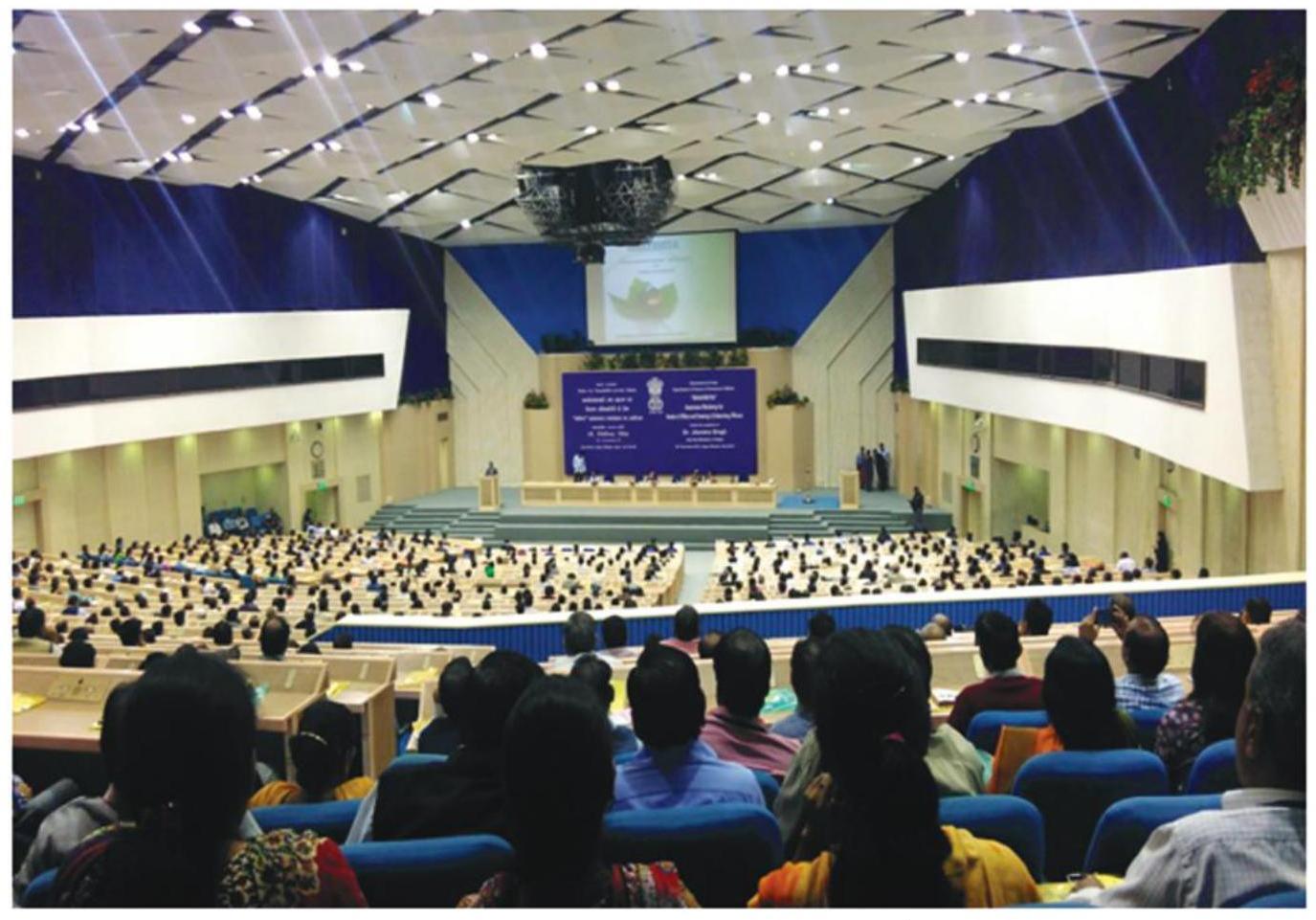
Workshop on Bhavishya in Vigyan Bhawan, Delhi on $26^{\text {th }}$ November, 2015
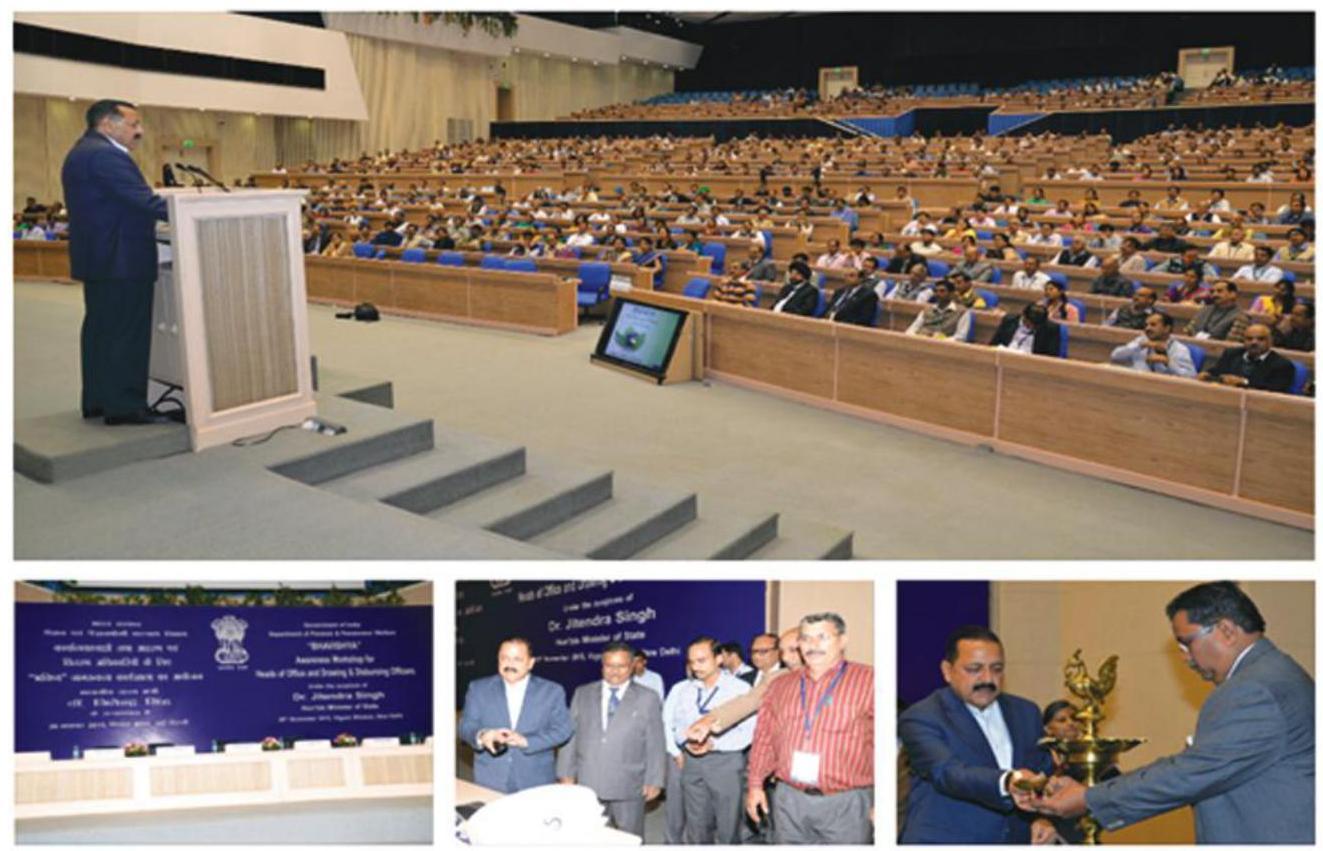
Workshop on Bhavishya at Vigyan Bhawan, Delhi on $26^{\text {th }}$ November, 2015
(iii) Anubhav
On the directions of the Hon’ble Prime Minister of India, Department of Pension & Pensioners’ Welfare has launched an online software, ‘Anubhav’ for showcasing outstanding work by retiring employees and sharing experiences of working with the Government. It is envisaged that over a period of time this will create a wealth of institutional memory with replicable ideas and suggestions. This tool in addition, gives opportunity to the retiring employees to invest his experience, skill and time for growth of social capital of the country.
Instructions for use of this application have been issued vide OMs No. 4/2/2014P\&PW (Coord.) dated 19.02.2015 \& 05.03.2015. Ministries/ Departments are requested to ensure that largest number of employees submit their write-ups.
Facility to upload recorded voice message of 3-4 minutes (3MB) duration by retiring employees has also been added to the Anubhav software. First cut of the software application was demonstrated on 23.02.2015 and tested on the first lot of retirees during the pre-retirement counseling workshop (PRC) on 26.02.2015.
Workshop were organized on 24.03.2015, 24.04.2015 and 25.05.2015 for the Head of Offices, Head of Departments of Ministries/ Departments and retiring employees to introduce the concept and the software application as well as facilitate submission of write-ups be retiring employees. Subsequently, meetings were held on 08.05.2015 and 10.07.2015 with nodal officers of the Departments to review the progress of implementation of ‘Anubhav’.
Ministries/ Departments have been requested to conduct workshops on ‘Anubhav’ for their
retiring employees to facilitate them to upload their write-ups. They have also been requested to send monthly report of details of retiring employees and publishing of their write-ups.
Till date (as on 08.03.2016) 78 organizations have registered, 1255 write-ups have been published and 253 write-ups which have been uploaded are waiting to be published.
(iv) Recent Initiative
Instructions have been issued to all Ministries/Departments to issue printed Plastic Identity Cards to the retiring employees. In the Department of Pension & Pensioners’ Welfare a PVC Thermal printer has been procured for issuing Plastic Identity Cards to the employees retiring from Department of Pension \& Pensioners’ Welfare, Department of Personnel \& Training, DARPG and Department of NorthEastern Region.
Handling of various references and Grievance Redressal System:
27.7 The Department of Pension \& Pensioners’ Welfare, being the nodal Department for pension and pension related matters, receives large number of references from Ministries/Department/ PSUs, etc. The Department renders advice on interpretation of Pension Rules and considers cases referred by Ministries/Departments for relaxation of the provisions of Pension Rules. Regular review meetings to redress the grievances are being conducted by the Department.
Centralised Pension Grievance Registration and Monitoring System (CPENGRAMS)
27.8 The Department of Pension \& Pensioners’ Welfare has implemented the improved version
of CPENGRAMS which integrates with the data base of Centralized Public Grievances Redressal and Monitoring System (CPGRAMS) under the administrative control of Department of Administrative Reforms \& Public Grievances. With this version, Pension related grievances get combined with public grievances and thus the Ministries/ Departments do not have to monitor grievances through different applications.
27.9 During the period under report concerted efforts were made to bring down the pendency of old pension related grievances by holding regular review meetings with the Nodal Officers of various Ministries / Departments as a result of which 14537 grievances were disposed of by 01.01.2016 whereas the corresponding figures for previous year were 12262. More significantly the grievances pending for an year or more as on 1.4.2015 were 540 and the same came down to 128 as on 01.01.2016.
27.10 The Department has been conducting Awareness Programmes for the benefit of pensioners residing outside Delhi. The pensioners are informed about the existing as well as new measures initiated by the Government. These programmes were conducted in Aizwal, Jodhpur, Kohima and Guwahati. Such programmes are always received very well.
27.11 Documentary Film on “Pensioners Portal” in English and 4 regional languages was telecast through Electronic Media to reach out to pensioners across the country.
27.12 Three training sessions were organized for officers of 63 Ministries/Departments to apprise them of latest changes in the Pension Rules. As a result, 114 officials were trained on Pensionary matters.
Compendium
27.13 A compendium on Pension related Orders during the year – 1.4.2014 to 31.03.2015 was published. This is also available on the Department’s website at the www. pensionersportal.gov.in and www.persmin.gov. in/pension.asp.
27.14 The following important policy decisions were also taken during the year 2015:-
(i) Orders were issued vide OM dated 28.01.2013 for stepping up the pension of pre-2006 pensioners w.e.f. 24.09.2012. Orders have also been issued vide OM dated 30.07.2015 for extending the benefit of OM dated 28.01.2013 from 01.01.2006 instead of 24.09.2012.
(ii) Instructions have been issued to all Ministries/Departments vide OM No.4/78/2006-P&PW(D) dated 12.10.2015 to allow deputation of Central Government Employees to the posts in Central Autonomous Bodies without seeking exemption from Rule of Immediate Absorption, if the Recruitment
Rules for the posts specifically provide for the appointment of Central Government Employees on deputation.
27.15 Due compliance of the orders and instructions pertaining to the reservations of vacancies in favour of SC/STs and welfare of minorities issued by the Government from time to time is ensured. A Complaint Committee to enquire into complaints of sexual harassment at work place has been constituted. There has been no complaint of sexual harassment during the period under report.
Hindi Pakhwara
27.16 A Hindi Pakhwara was organized by the Department in the month of September, 2015 to inculcate the spirit of making progressive use of Hindi in official noting drafting and communications. Competition in essay writing and noting and drafting was organized for the staff members and suitable awards were given as incentive. Awards were also given for promoting dictation work by officers in Hindi and Noting/ drafting work by officials in Hindi.

ANNEXURE
Department of Personnel and Training
Incumbency Position of Group ‘A’ Officers in D/o Personnel and Training as on 01.03.2016
| Post | Name of Incumbent |
|---|---|
| Secretary(Personnel) | Shri Sanjay Kothari |
| Additional Secretary | Shri T. Jacob |
| Shri Rajeev Kumar | |
| Joint Secretary | 1. Ms. Archana Varma |
| 2. Shri Jishnu Barua | |
| 3. Shri Devesh Chaturvedi | |
| 4. Shri P. K.Das | |
| 5. Ms. V. Vidyavathi | |
| 6. Ms. Vandana Sharma | |
| 7. Shri. Rajiv Rai | |
| Director | 1. Shri Sudhir Kumar |
| 2. Shri Rakesh Kumar | |
| 3. Shri Subramanya M.S. Rao | |
| 4. Shri Anand Madhukar | |
| 5. Shri Ashish Kumar | |
| 6. Shri Ashok Kumar | |
| 7. Ms. Gayatri Mishra | |
| 8. Smt. G. Jayanthi | |
| 9. Ms. Kimbuong Kipgen | |
| 10. Shri Mukesh Chaturvedi | |
| 11. Ms. Mukta Goel | |
| 12. Shri Mukul Ratra | |
| 13. Shri N. Sri Raman | |
| 14. Ms. Pratima Tyagi | |
| 15. Shri Sandeep Jain | |
| 16. Shri Utkaarsh R.Tiwaari | |
| 17. Shri V. K. Sinha | |
| 18. Shri N. Raja | |
| Principal Staff Officer | 1. Shri C. S. Bist |
| 2. Shri Jawahar Peshwani | |
| 3. Ms. Kusuma Padmanabhan |
| Post | Name of Incumbent |
|---|---|
| Deputy Secretary | 1. Ms. Deepika Lohia Aran |
| 2. Ms. Nandini Paliwal | |
| 3. Ms. Kavitha V. Padmanabhan | |
| 4. Shri J. Srinivasan | |
| 5. Shri A.K.Sinha | |
| 6. Shri D.P.Majhi | |
| 7. Shri C.A.Jacob | |
| 8. Shri A.K.Jain | |
| 9. Shri A.N.Narayanan | |
| 10. Ms. Sumita Singh | |
| 11. Shri Suresh Kumar | |
| 12. Shri G.S. Arora | |
| 13. Shri M.P. Rama Rao | |
| 14. Shri G. Srinivasan | |
| 15. Ms. Meera Mohanty | |
| Senior Principal Private Secretary | 1. Shri S.C.Baweja |
| 2. Shri Satish Kumar Thakur | |
| 3. Smt Harbhajan Kaur Gill | |
| Principal Private Secretary | 1. Shri Shriniwas Ranga |
| 2. Shri N.C. Pandey | |
| 3. Shri Ramesh Chand | |
| 4. Shri V.S. Narsimhan | |
| 5. Shri Yati Raj Sehgal | |
| Under Secretary | 1. Shri Abhay Jain |
| 2. Shri Amit Srivastava | |
| 3. Shri Ajit Kumar | |
| 4. Shri Anil Tripathi | |
| 5. Shri Amit Srivastava | |
| 6. Shri Arvind Thakur | |
| 7. Shri Avinash Chandra | |
| 8. Shri Anand Upadhyay | |
| 9. Shri Biswajit Banerjee | |
| 10. Shri Chattra Mani | |
| 11. Shri Chandra Shekhar |
| Post | Name of Incumbent |
|---|---|
| 12. Shri Chirabrata Sarkar | |
| 13. Shri D.K. Sengupta | |
| 14. Shri Debabrata Das | |
| 15. Ms. Gracy Varghese | |
| 16. Shri J.R. Gaikwad | |
| 17. Shri Kamal Kishore | |
| 18. Shri Kameshwar Mishra | |
| 19. Shri Kulbhushan Malhotra | |
| 20. Shri K.C. Raju | |
| 21. Shri K. Srinivasan | |
| 22. Ms. Majula Juneja | |
| 23. Shri Madan Mohan Maurya | |
| 24. Shri Manoj Gupta | |
| 25. Shri Mukesh Kumar | |
| 26. Ms. Manisha Bhatnagar | |
| 27. Shri Md. Nadeem | |
| 28. Shri Navneet Mishra | |
| 29. Shri Nitin Gupta | |
| 30. Shri O.P.Chawla | |
| 31. Shri P.K. Pattanaik | |
| 32. Shri Pankaj Gangwar | |
| 33. Shri Parminder Singh | |
| 34. Shri Prem Chand | |
| 35. Shri Pushpender Kumar | |
| 36. Shri Rajesh Sarswat | |
| 37. Shri R.K. Girdhar | |
| 38. Shri R. Venketasan | |
| 39. Shri R.S. Sikdar | |
| 40. Shri Rajeshwar Lal | |
| 41. Shri Rajesh Kumar Yadav | |
| 42. Shri Raj Kishan Vatsa | |
| 43. Shri Raju Saraswat | |
| 44. Shri S. Basu | |
| 45. Shri S.G. Mulchandaney | |
| 46. Shri Sunil Kumar Mandi | |
| 47. Shri S. K. Prasad | |
| 48. Shri Sandeep Mukherjee |
| Post | Name of Incumbent |
|---|---|
| 49. Shri Sanjay Mehta | |
| 50. Ms. Sarita Nair | |
| 51. Shri Sher Bahadur | |
| 52. Shri Sukdeo Sah | |
| 53. Shri Susheel Kumar | |
| 54. Shri Uday Bhan Singh | |
| 55. Shri Virender Singh | |
| 56. Shri V. Srinivasa Raghavan | |
| 57. Shri Vijay Kaushik |
ORGANIZATION CHART OF DEPARTMENT OF ADMINISTRATIVE REFORMS AND PUBLIC GRIEVANCESAS ON $31^{\text {st }}$ DECEMBER, 2015
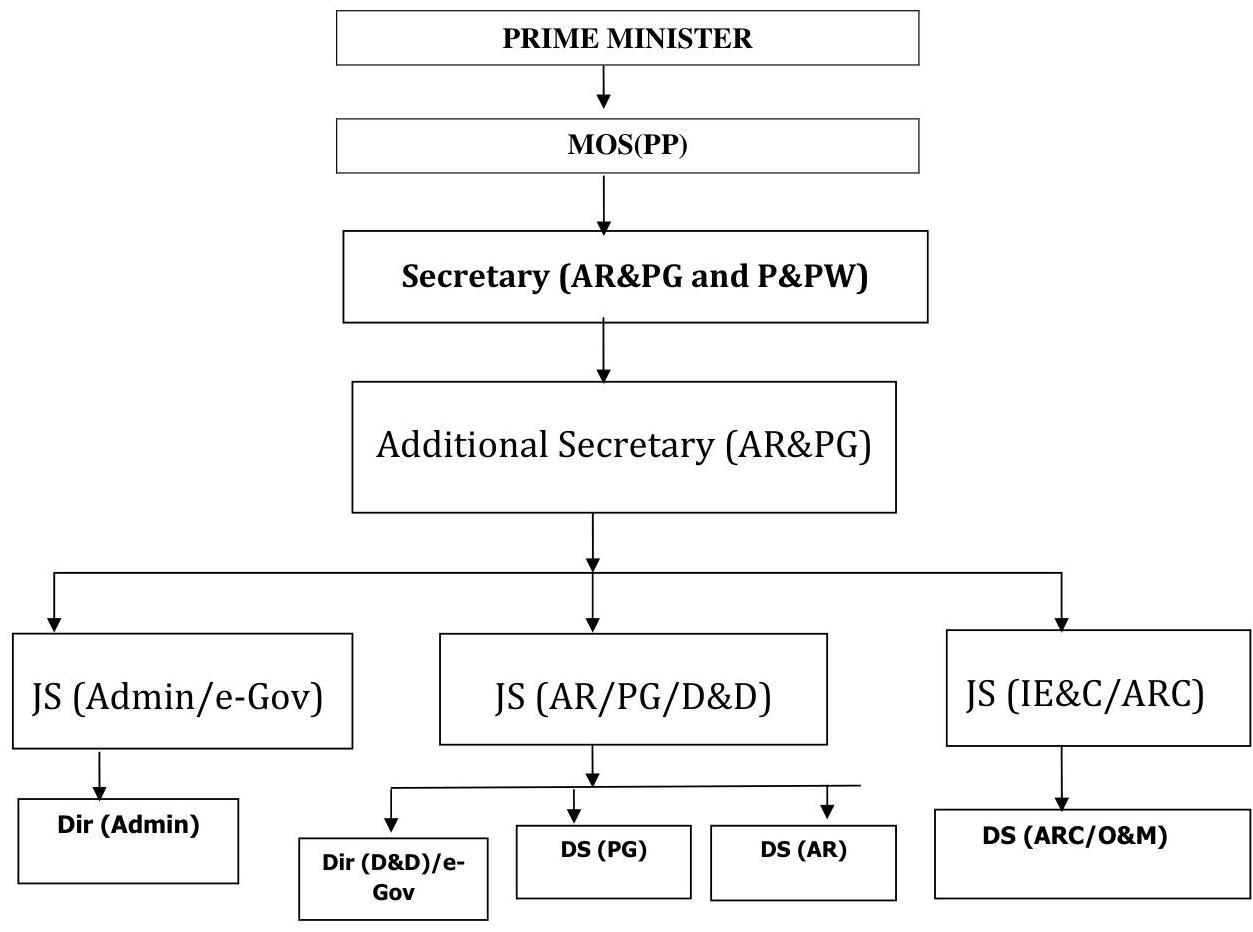
Department of Administrative Reforms and Public Grievances
Incumbency Position of Under Secretary and above level Officers in D/o AR&PG as on January, 31.12.2015
| Post | Name of Incumbent |
|---|---|
| Secretary | Shri Devendra Chaudhry |
| Additional Secretary | Ms. Usha Sharma |
| Joint Secretary | 1. Ms. Smita Kumar 2. Ms. Kiran Puri 3. Shri P. Karupasami |
| Director | 1. Shri Vanraj A. Chavda 2. Smt. Alpana Shukla Rao |
| Deputy Secretary | 1. Shri Anurag Srivastava 2. Smt. Richa Gaharwar 3. Smt. Sumita Dasgupta |
| Under Secretary | 1. Ms. Renu Arora 2. Shri D.K. Rana 3. Ms. Nita Dharmani 4. Shri Harihar Sukla 5. Shri S.Bandyopadhyay 6. Shri Hemant Verma 7. Shri Jitendra Sihwag 8. Shri Din Dayal 9. Shri Jagdish Kumar Ambwani 10. Shri Dhananjay Kumar 11. Shri Pramod Bhardwaj 12. mt. Pratibha Ahuja 13. Shri Khamchin Naulak 14. Shri Arun Kumar Sarkar 15. Shri Ajay Kumar Sawhney 16. Shri Alok Jagbharia |
| PPS | 1. Shri A. Y. Anand Raj 2. Shri Satish Kumar |
Department of Administrative Reforms and Public Grievances
Prevention of sexual harassment of women at work place
An Internal Complaint Committee has been constituted in Department of Administrative Reforms and Public Grievances for prevention of sexual harassment of women at work place comprising of following members
(i) Smt. Smita Kumar Joint Secretary
- Chairperson
(ii) Shri Anurag Srivastava, Deputy Secretary – Member
(iii) Smt. Nita Dharmani, Under Secretary – Member
(iv) Ms. Hazel Siromoni, representative sponsored by YWCA – Member
Women employees are being made aware of existence of said Committee from time to time through circulars, display on notice boards and interactions. No complaint of sexual harassment from any of the women employees has been received during the year. However, to review the overall condition of working environment for women, the Committee met last time on 26.11.2015 and also decided to have regular interaction with women to give them comfort and security.
Department of Administrative Reforms and Public Grievances
Welfare of SC, ST, OBC and Person with Disability (PWD)
As on 08.01.2015 the incumbency position of SC, ST, OBC and Person with Disability (PWD) in the Group A, B and C category of Officials of Department of Administrative Reforms and Public Grievances is as under:
| Category | Total | SC | ST | OBC | PWD |
|---|---|---|---|---|---|
| Group-A | 27 | 3 | 1 | — | — |
| Group-B | 54 | 6 | 2 | 6 | $1(\mathrm{OH})$ |
| $1(\mathrm{HH})$ | |||||
| Group-C | 19 | 14 | — | — | — |
| 100 | 23 | 3 | 6 | 2 |
The Department has appointed a Nodal Officer to look into the complaints/ representations, if any received from SC, ST and OBC officials and as also to watch their welfare. As per instructions of DoPT the Department is submitting annual report regarding SC, ST, OBC and PWD incumbents online through the URL “rrcps.nic. in”. No complaint from SC, ST, OBC and PWD officials is received during the year.
Newspaper clippings of various events of DARPG
PRESS INFORMATION BUREAU
GOVERNMENT OF INDIA
NAGPUR
NAME OF NEWSPAPER: THE HITAVARA DATE 23/1/2016
PLACE: NAGPUR LANGUAGE ENGLISH
Technology should be used to improve Government’s delivery system: CM
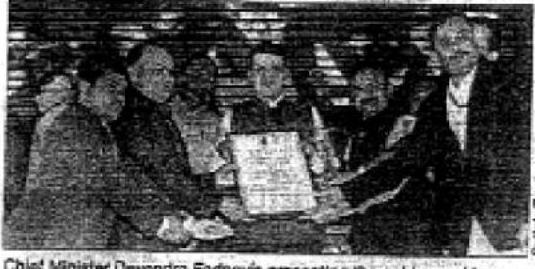
Chief Minister Devendra Fadnavi’s presenting the gold award to Maha-Gavada team for innovative use of GIS technology at the concluding ceremony of National e-Governance Conference.
13 Staff Reporter
TECHNOLOGY is a great levelier and should be used to connect the dots by improving the Government’s delivery system through innovation, stated Chief Minister Devendra Fadnavi.
Addressing the valedictory function of two-day national conference on e-Governance on Friday at MontLaMantel, Chief Minister said challenges faced by Government in performing the e-Governance on Friday can be successfully addressed through Governance with Accountability Innovation and Transparency (GATI) which holds the key.
Energy Minister and Guardian Minister Chandrashekhar Rawatkin, Chief Secretary of Department of Administrative Reforms, Public Grievances (DARPG), Devendra Chaudhary, State’s Chief Secretary Swadhesh Khatriya, were prominent among those present.
Speaking further, Chief Minister said, the importance of people are very few and if we could create a mechanism wherein these small needs can be successfully met then people’s faith in democracy would increase manifold.
The challenge, before Government today of its bridge the disconnect between administration and people and technology needs to be used effectively to address these issues. There is no dearth of resources and the problem is the resources are not reaching the rightful beneficiaries and not that India lacks in talent but we are not utilising the same for country’s benefit. Therefore, innovations within the system, particularly in Government needs identification and patronage at the right time to provide boost-up to the innovators.
Spelling out his idea of e-Governance to barrensters, Fadnavi said, “By running down the number of clearances required for sanctioning a building map, the overall cost would reduce and this in turn would translate into affordable housing. We have started this in Mumbai, wherein a builder required nearly 150 clearances, and reduced this to 50. This will soon be replicated in all Municipal Corporations. Why not use EGGA technology which is a 3D-based technology platform to provide sanctions within a day, so for that matter within 15 days as barrensters need to understand that a person who is investing capital pays the highest cost due to delay in getting sanctions,” Chief Minister further pointed out.
He said the aim of Government is to reduce human interface in Governance as humans tend to be deminutive. Therefore, we have started delivery of services on-line as people need not come to our offices for getting their rights done.
Earlier, Union Secretary, Department of Administrative Reforms and Public Grievances, Devendra Chaudhary, said in next few years there will be concentration on people, process, and technology. On the occasion, Chief Minister presented awards to successful 18 teams for their innovative work in e-Governance.
ANNEXURE-VII
-72-
ANNEXURE-VI 09
PRESS INFORMATION BUREAU
GOVERNMENT OF INDIA
NAGPUR
NAME OF NEWSPAPER: LOKMAT TIME’S DATE 23/01/2015
PLACE …………………………………………………………………………………………………………………………………………………………………………………………………………………………………………………………………………………………………………………………………………………………………………………………………………………………………………………………………………………………………………………………………………………………………………………………………………………………………………………………………………………………………………………………………………………………………………………………………………………………………………………………………………………………………………………………………………………………………………………………………………………………………………………………………………………………………………………………………………………………………………………………………………………………………………………………………………………………………………………………………………………………………………………………………………………………………………………………………………………………………………………………………………………………………………………………………………………………………………………………………………………………………………………………………………………………………………………………………………………………………………………………………………………………………………………………………………………………………………………………………………………………………………………………………………………………………………………………………………………………………………………………………………………………………………………………………………………………………………………………………………………………………………………………………………………………………………………………………………………………………………………………………………………………………………………………………………………………………………………………………………………………………………………………………………………………………………………………………………………………………………………………………………………………………………………………………………………………….
ANNEXURE-VIII
-73-
ANNEXURE-VIII
167
Govt aims at 100%
complaint disposal
New Delhi: The government
on Monday said it is aiming
for a hundred per cent dis-
posal of common man’s
grievances within a given
time frame as over 4.8 lakh
complaints, 87 per cent of
the total complaints
received, have been resol-
ved in the last one year.
While making public the fig-
ures, MoS in PMO Jitendra
Singh said these depart-
ments have also recorded a
near three-fold jump in
receiving complaints during
the last year, as compared
to the previous time,
as e-enabled projects has
made it easier for people to
lodge grievances.
– PTI
ANNUAL REPORT 2015-16
ORGANISATIONAL CHART
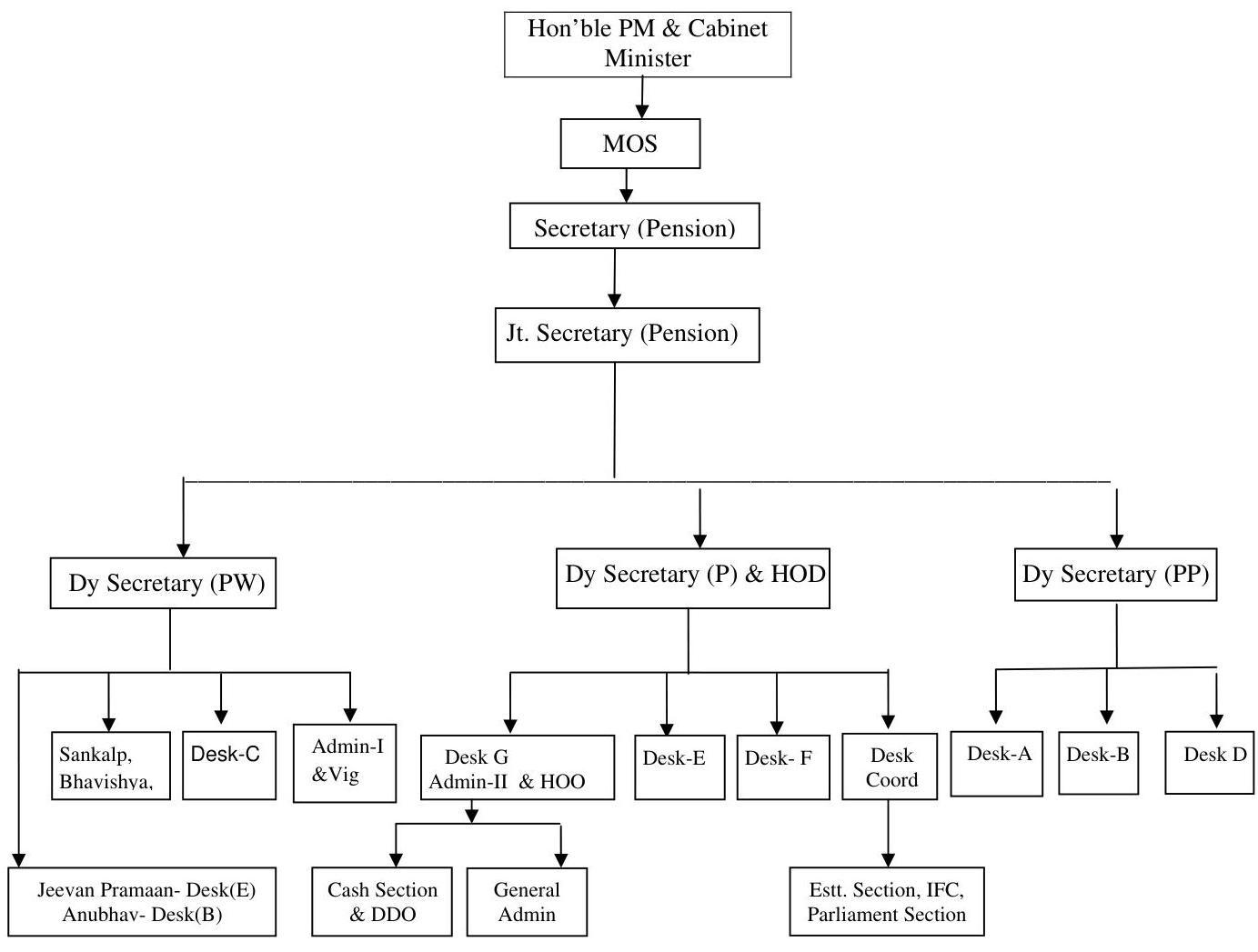
Department of Pensions and Pensioners’ Welfare
| Sl.No. | Name | Designation |
|---|---|---|
| 1. | Shri Devendra Choudhry | Secretary |
| 2. | Smt. Vandana Sharma | Joint Secretary |
| 3. | Smt. Seema Gupta | Deputy Secretary(PW) |
| 4. | Shri Harjit Singh | Deputy Secretary(PP) |
| 5. | Smt. Sujasha Choudhury | Deputy Secretary(P) |
| 6. | Smt. Deepa Anand | Under Secretary |
| 7. | Shri D.K.Solanki | Under Secretary |
| 8. | Shri S.K.Makkar | Under Secretary |
| 9. | Shri Charanjit Taneja | Under Secretary |
| 10. | Smt. Neeru Goel | Under Secretary |
| 11. | Shri Manoj Kumar | Under Secretary |
| 12. | Shri S.Chakrabarti | Under Secretary |
| 13. | Ms. Pushpalata Kumari | Assistant Director(OL) |
Incumbency position of Under Secretary Level Officers & above in Department of Pension \& Pensioners Welfare as on date i.e. 10.02.2016
- ${ }^{a}$ Includes appointment/additional charge of 34 female officers ↩